j o u r na l
S CHOOL OF VISUAL ARTS MAGAZINE SPRING 201 8
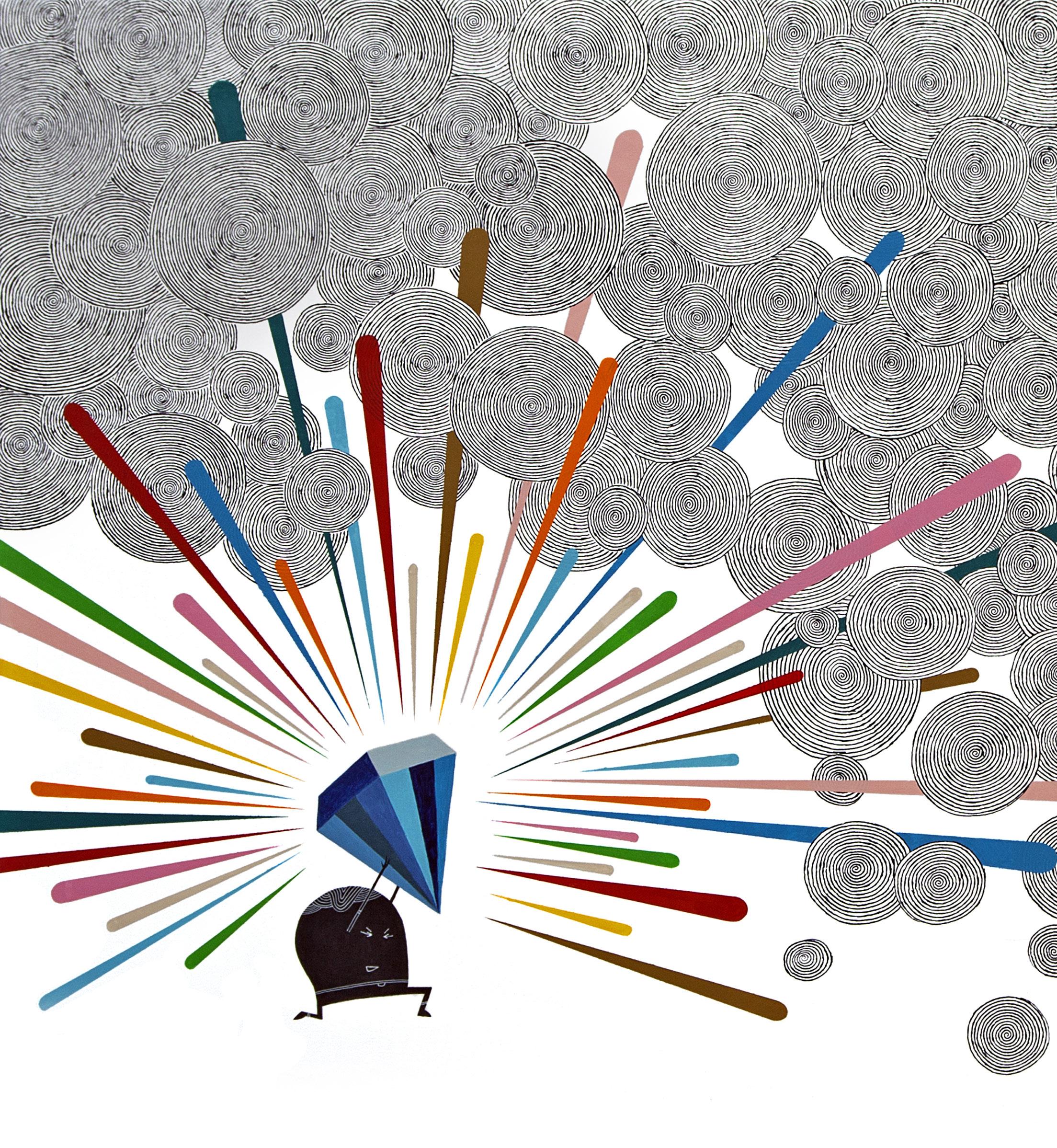
SPRING
2018
FROM THE PRESIDENT | 3
SVA CLOSE UP | 4
News and events from around the College
WHAT’S IN STORE | 10
Products by SVA artists and entrepreneurs
CREATIVE LIFE:
The Fight for Gender Equity | 18
Organizations working to advance women in creative fields
PORTFOLIO: Robert Lazzarini | 22
Disorienting artworks, inspired by the tragic story of Sharon Tate
DON’T GET NERVOUS! | 32
Meet cartoonist Roz Chast, SVA’s next Masters Series honoree
SPOTLIGHT: New England | 36
Six notable alumni in the Northeastern region
MISTER SANDMAN | 46
The beachside sculptures of Calvin Seibert
Q+A: Joe Sinnott | 52
The memories of a comic book legend and early SVA graduate
THE BENEFITS OF SHARING | 58
Talking all things Instagram with four masters of the medium
ALUMNI AFFAIRS | 64
For Your Benefit | Recharging Station Alumni Scholarship Awards | Donors Alumni Notes and Exhibitions In Memoriam
FROM THE ARCHIVES | 80
The Design of Dissent Collection
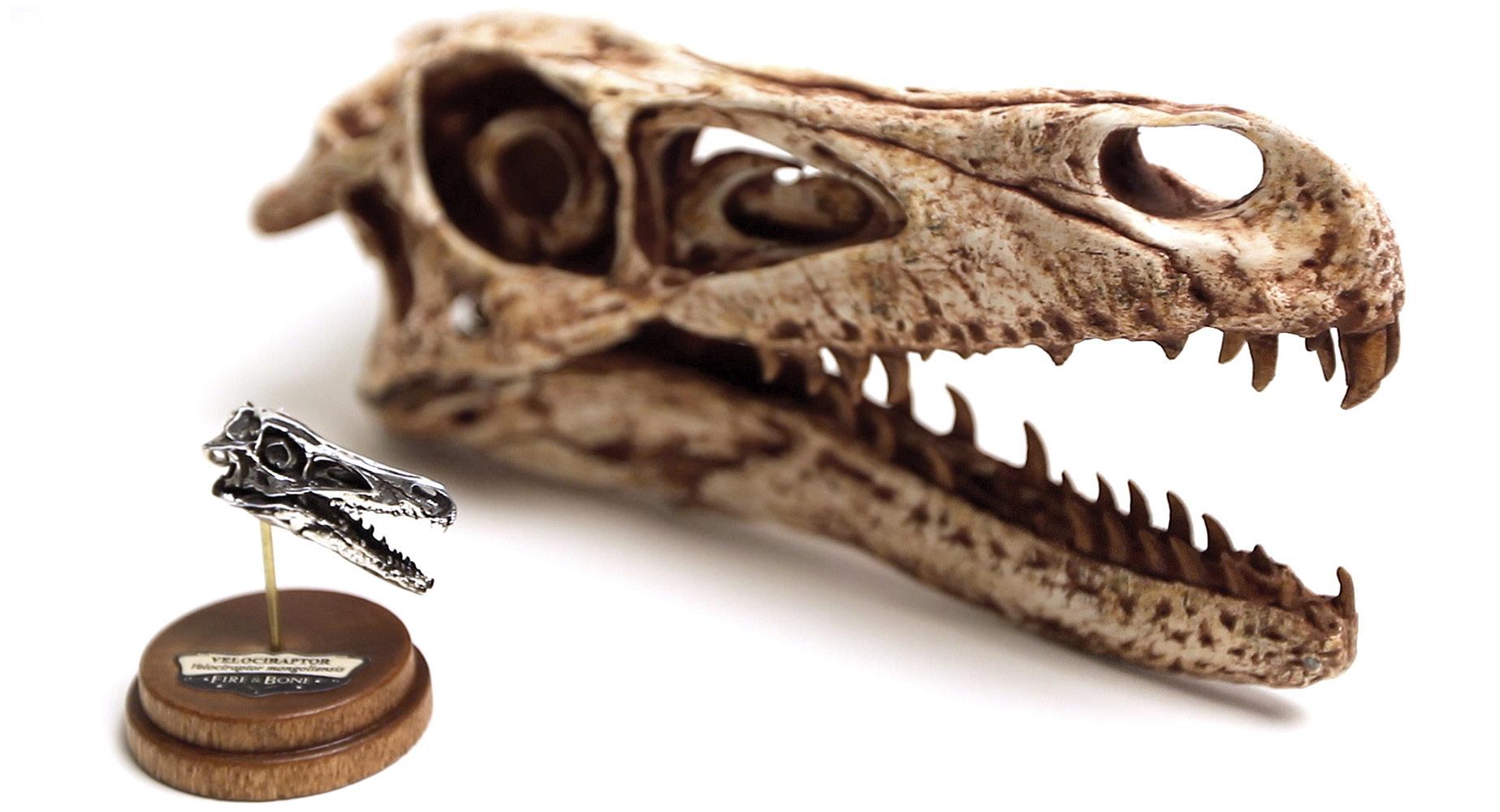
“The featured animals range from the extinct to the common to the somewhere in between.”
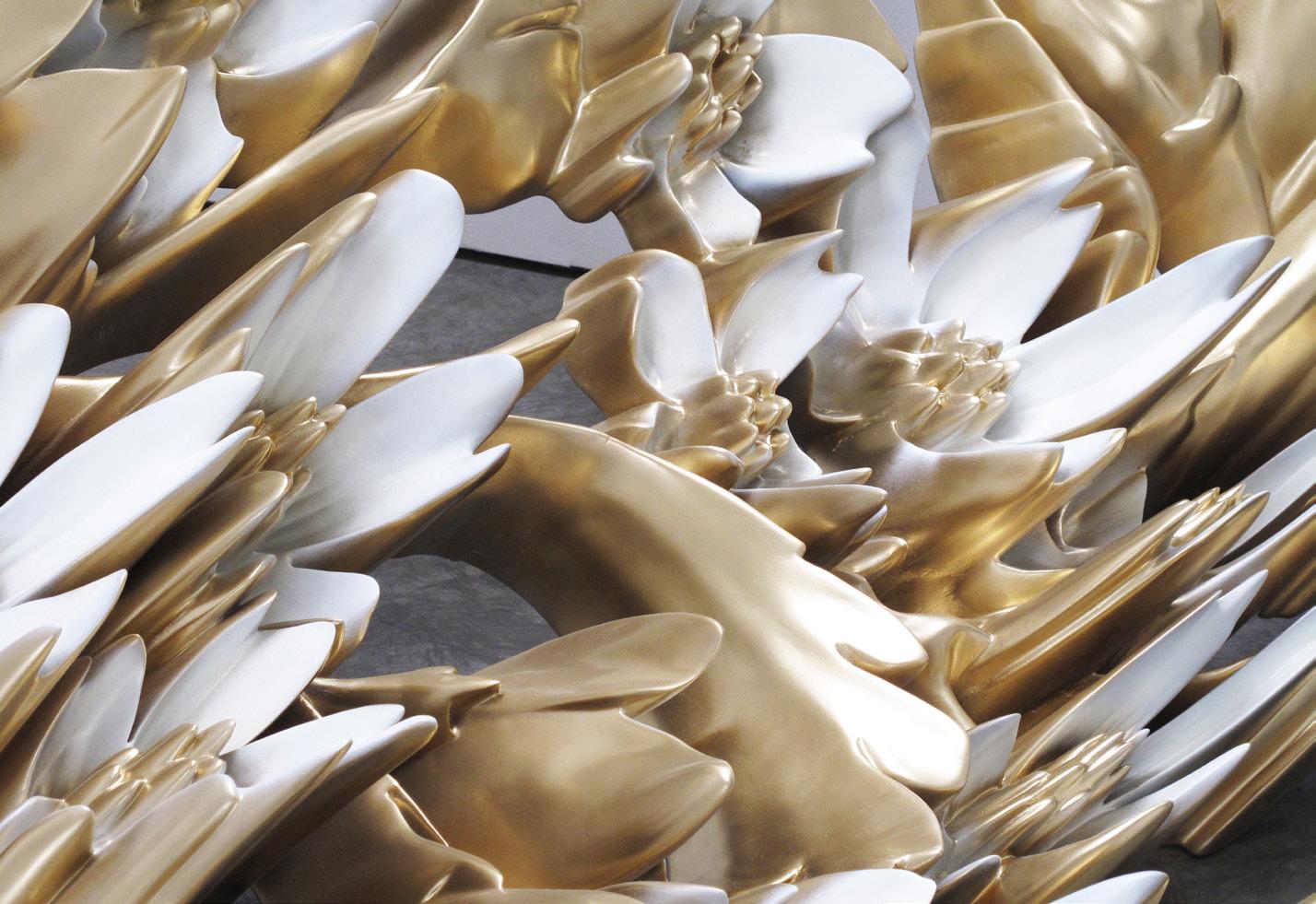
“The challenge is to take something that has a mutually agreed-upon meaning and re-contextualize it.”
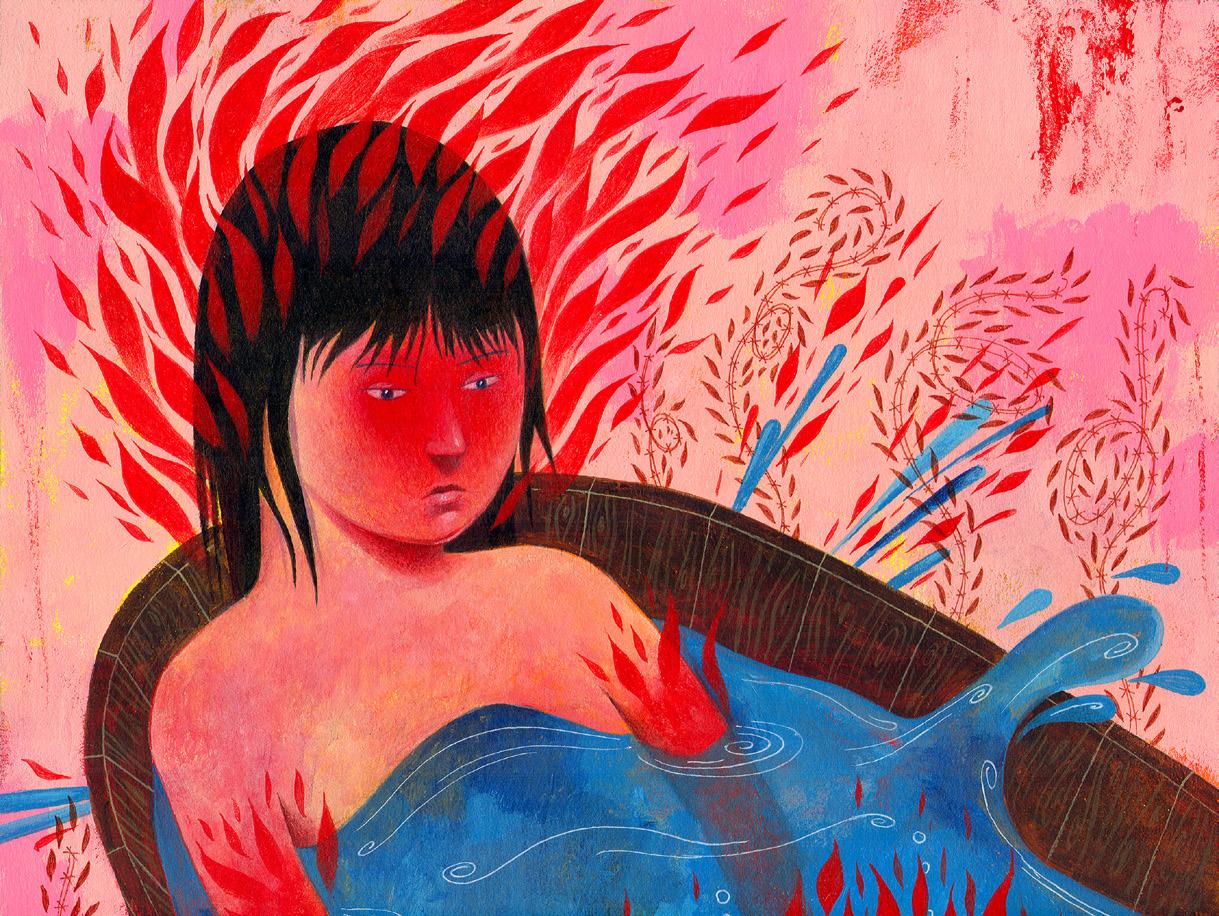
“The great thing about changed dramatically.”
VISUAL ARTS JOURNAL
Spring 2018
Volume 26, Number 1
EDITORIAL STAFF
Joyce Rutter Kaye, senior editor
Greg Herbowy, editor
Tricia Tisak, copy editor
VISUAL ARTS PRESS, LTD.
Anthony P. Rhodes, executive creative director
Gail Anderson, creative director
Brian Smith, art director
Ryan Durinick, senior designer
Carli Malec, designer
COVER
FRONT: Scott Bakal, Diamond Power! (from “Dim Stars: Pollution”), 2011, acrylic and ink on canvas.
BACK: Sandcastle artist Calvin Seibert, photographed by Jeremy Cohen.
ADVERTISING SALES
212.592.2207
CONTRIBUTORS
Jeremy Cohen
Emma Drew
Alexander Gelfand
Dan Halm
Madison Malone Kircher
David Leutert
Michelle Mackin
Jane Nuzzo
Folake Ologunja
Jennifer Phillips
Miranda Pierce
Charles Snyder
Kate Styer
Kristin L. Wolfe
In memory of longtime copy editor James Harrison (1933 – 2018).
© 2018, Visual Arts Press, Ltd. Visual Arts Journal is published twice a year by SVA External Relations.
School of Visual Arts 209 East 23rd Street New York, NY 10010-3994
Milton Glaser ACTING CHAIRMAN
David Rhodes PRESIDENT
Anthony P. Rhodes EXECUTIVE VICE PRESIDENT
facebook.com/schoolofvisualarts instagram.com/svanyc schoolofvisualarts.tumblr.com twitter.com/sva_news youtube.com/user/svanewyorkcity
TO READ THE VISUAL ARTS JOURNAL ONLINE, VISIT: ISSUU.COM/SVAVISUALARTSJOURNAL
An alumnus re-imagines the SVA
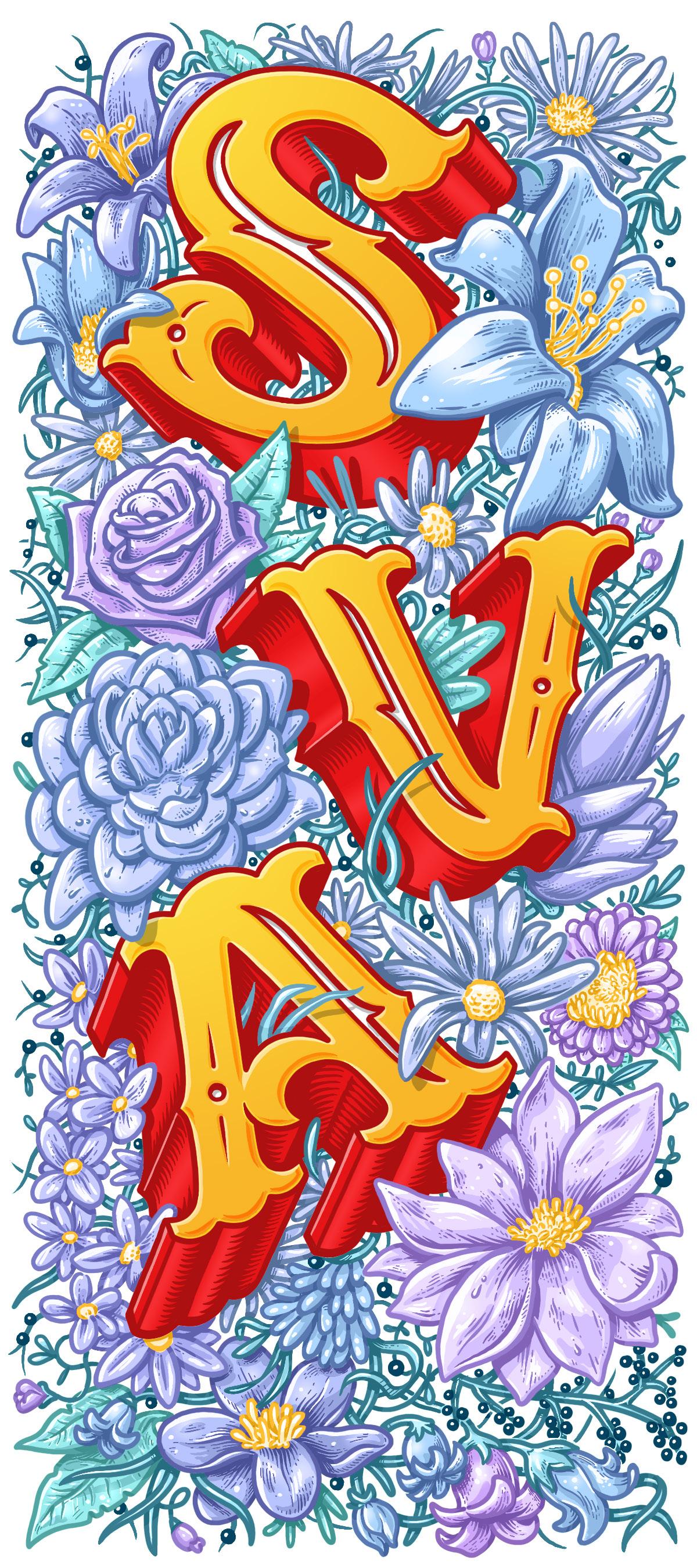
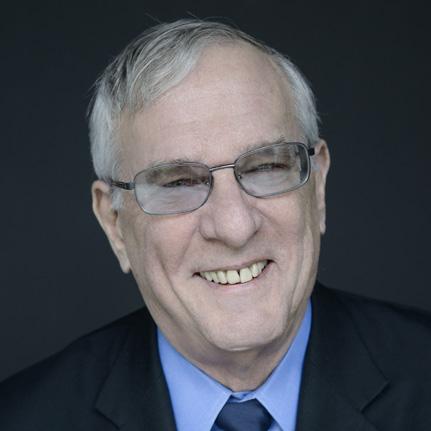
It’s always exciting to hear and read about the professional success of SVA alumni and faculty, and never more so than when those successes engage with the wider world, advocating or e ecting change for the greater good. We are all citizens of our local, national and global communities. As such, we all carry a responsibility to stay informed and involved, to the best of our ability.
Of course, we all have di erent skills, and we all have the causes that move us most. To best make a di erence, we must consider the ways in which our talents and interests can most e ectively be merged. Consider the admirable example set by alumnus, faculty member and SVA Alumni Society board member Tim Rollins (BFA 1977 Fine Arts), who died late last year (page 79). Through his decades of work with Kids of Survival (KOS), the collective he founded with a group of young students he taught in the South Bronx, Rollins and his collaborators became not only acclaimed artists, but powerful evangelists for the importance of the arts in public education.
Throughout this issue, you will encounter artists who have incorporated their humanitarian aims into their practices. There is the BFA Film faculty member whose latest feature is also a timely contribution to the #MeToo movement (page 4), the women animators and designers dedicated to achieving gender equity in the workplace (page 18), the photojournalist documenting the devastation wrought by Ukraine’s ongoing civil unrest (page 42) and the many graphic designers creating protest art for mass movements all over the world (page 80). I hope you will find their examples as inspiring as I do, and I look forward to celebrating many like successes in our community in the years to come.
I hope you enjoy this issue of the Visual Arts Journal. president school of visual arts
PHOTO BY NIR ARIELI
To best make a difference, we must consider the ways in which our talents and interests can most effectively be merged.
CLOSE UP News and events from around the College
SVA Shines at Sundance
The SVA community has always been well represented at the prestigious Sundance Film Festival, held each January in Park City, Utah, but this year’s lineup teemed with work by alumni and faculty. Ten movies directed, shot, edited or produced by those with SVA ties screened at the festival; as of publication, two are nearing wide release and one is already streaming online.
Perhaps this year’s biggest Sundance premiere was The Tale, the first dramatic feature by documentary filmmaker and BFA Film faculty member Jennifer Fox. (Fox’s Beirut: The Last Home Movie won the festival’s top documentary prize in 1988.) Based on Fox’s own life, The Tale stars Laura Dern as a filmmaker who reexamines her long-buried memories of an early sexual relationship with an older man. After a rapturous reception, HBO acquired the film; it will air on the network later this spring.
Another Documentary Grand Jury Prize winner making her narrative debut at the festival: Crystal Moselle (BFA 2002 Film and Video), whose Skate Kitchen, based on and starring a real-life all-girl skateboard crew, will be distributed in theaters this summer by Magnolia Pictures—the same outfit that picked up her first film, The Wolfpack, in 2015.
Elsewhere at Sundance, David Osit (MFA 2011 Social Documentary Film) was consulting editor for Crime + Punishment, which follows a group of NYPD o cers trying to expose discriminatory policing, and fellow program alumnus Sandra Itäinen (2017) was associate producer for Dark Money, which investigates corporate influence in politics. On the faculty side, Lori Cheatle produced Matangi/Maya/M.I.A., about pop star M.I.A.; Bob Richman was director of photography for The Price of Everything, about the contemporary art market; Jerry Risius was a cinematographer for Generation Wealth, a look at capitalist excess, and Netflix’s Seeing
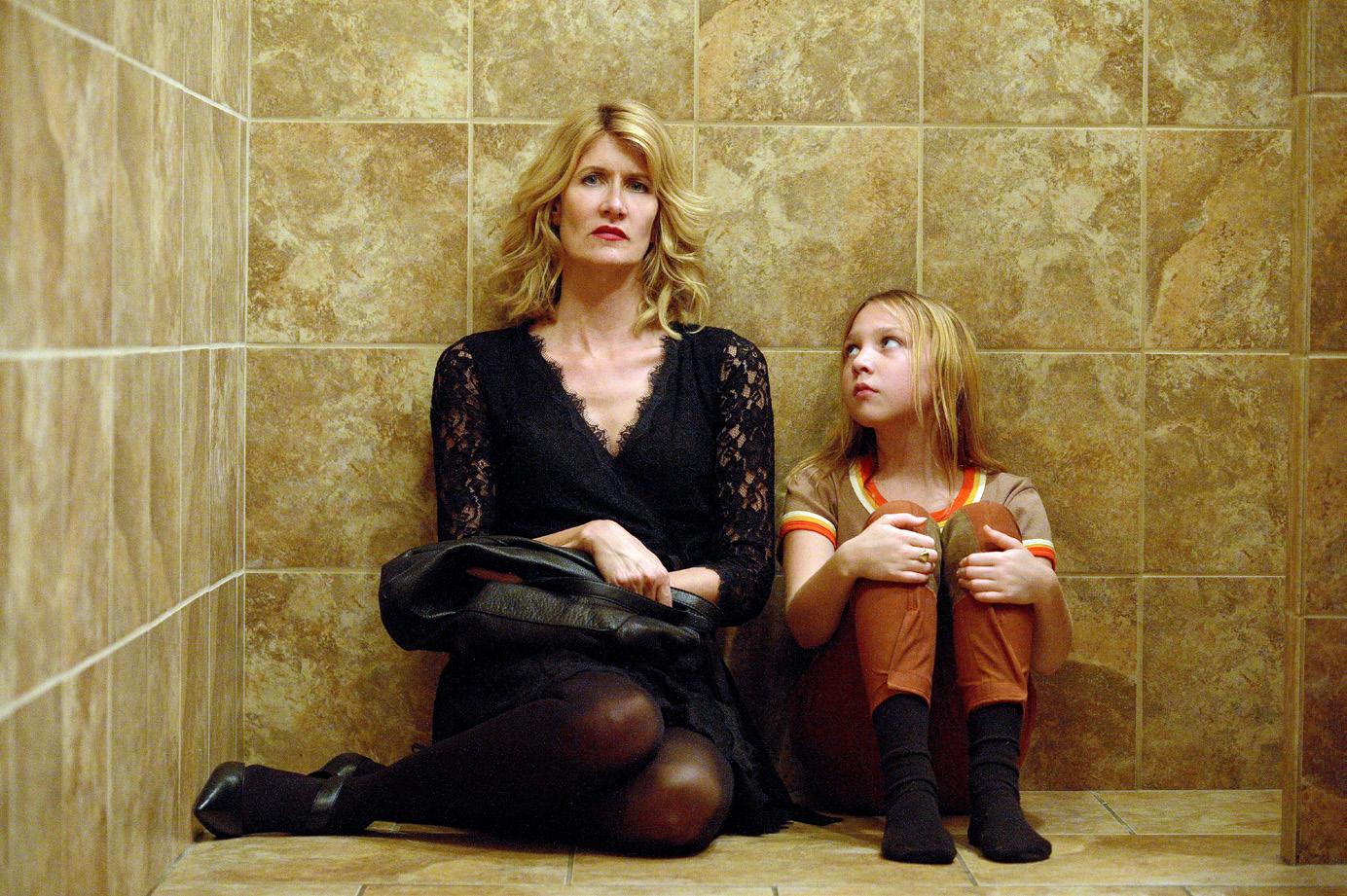
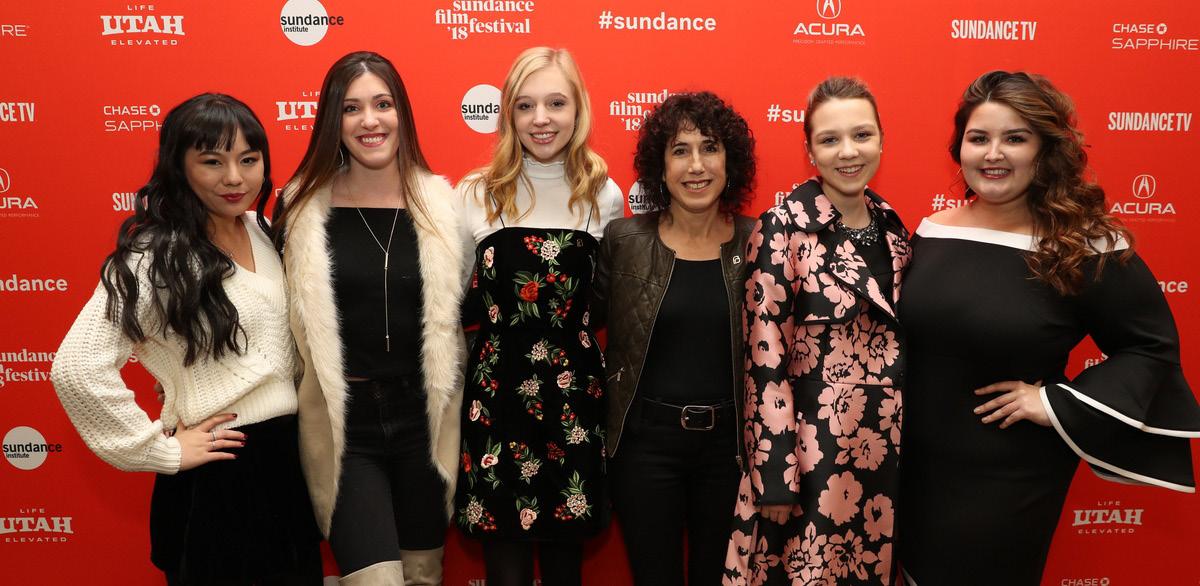
Allred, about famed attorney Gloria Allred; and Toby Shimin edited This Is Home, which trails four Syrian families resettling in Maryland.
Also in the documentary category, BFA 2010 Film and Video classmates Bennett Elliott and Robert Kolodny produced and provided cinematography, respectively, for Bisbee ’17, which follows an Arizona mining town’s residents as they mark the centenary of a local deportation in which 1,200 people were taken from their homes. [Emma Drew and Greg Herbowy]
Still from
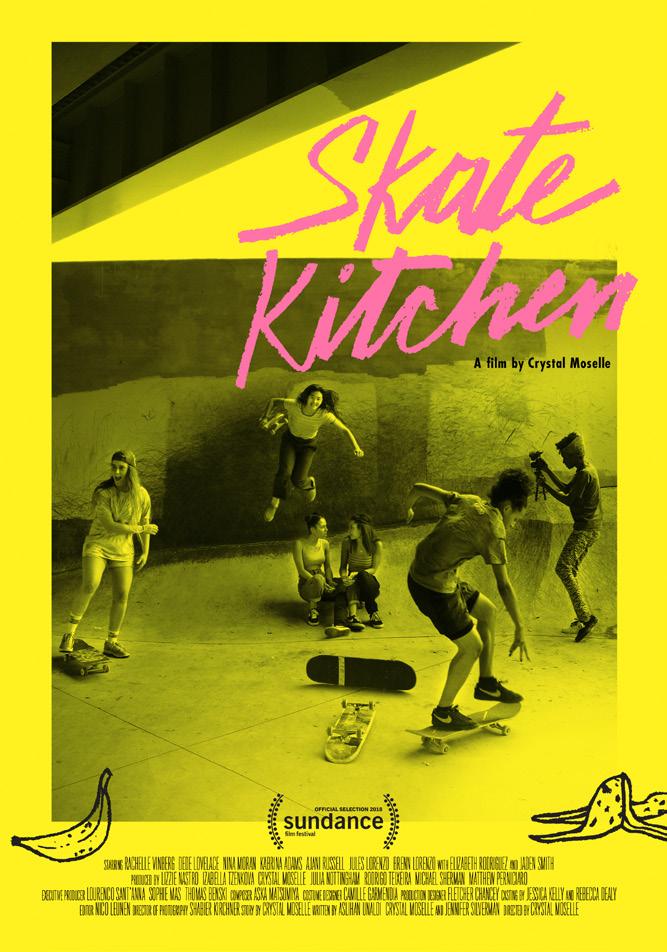
Staying the Course
✬Last year, SVA forged a partnership with Kadenze, a massive open online course (MOOC) platform with a focus on art and creative technology education. Kadenze brings together educators from more than 30 renowned colleges and universities worldwide, providing free access to most of its course content while offering premium membership for $20 per month that allows students to submit assignments and get feedback on their work. Users may also choose to enroll in certificate programs, developed in consultation with faculty from Kadenze’s partner institutions, for an additional fee.
In the fall, Kadenze launched two online certificate programs developed through SVA. The first, The Complete Typographer, a comprehensive introduction to the
theory, practice and business of type design, is the brainchild of Steven Heller, co-chair of MFA Design, and Angela Riechers (MFA 2010 Design Criticism), coordinator for SVA’s TypeLab summer residency program. The second, Photographer to Video in Today’s Gig Economy, which introduces working photographers to the fundamentals of video production and editing, was put together with input from Katrin Eismann (MFA 2002 Design), chair of MPS Digital Photography. Both programs aim to present professional-development education that keeps pace with creative industries’ evolving trends and skill sets. Each comprises five courses, with the first two open to all users and the remainder accessible for a program fee of $900.
The course content includes
✶
HEARD AT SVA ✶
“I’m a translator at work. I can speak weirdo to people who don’t speak weirdo.”
—PHIL RYNDA (BFA 2003 Animation), vice president of artist development, Nickelodeon. From Creating a Career in Animation, a panel discussion hosted by SVA Career Development at New York Comic Con 2017.
video-based lectures and demonstrations by leading professionals in their fields. The Complete Typographer includes instruction from Heller and Riechers, as well as from type designers Yomar Augusto, Victoria Rushton, Tobias Frere-Jones, Claudia de Almeida (BFA 2005 Graphic Design) and Richard Kegler. It also includes guest contributions from Gail Anderson (BFA 1984 Media Arts), creative director of SVA’s Visual Arts

Press, art director Ina Saltz, and others. Photographer to Video in Today’s Gig Economy is taught by photographer/filmmakers Alex Garcia, Gail Mooney, Manuel Tejeda and Eduardo Angel, with guest contributions from artists such as Michael Kaminski and Keren Plowden.
For more information, visit kadenze.com. [Jennifer Phillips]
A Light Wind
Whiteout, a site-specific artwork by Erwin Redl (MFA 1995 Computer Art), was on view in Madison Square Park in Manhattan from November through March as part of the park’s ongoing public art program. Redl’s work, which he described as a “kinetic light installation,” consisted of 900 illuminated spheres suspended from a square grid of steel poles and cabling, which allowed the lights to sway with the wind as they emitted large-scale wave patterns. [ED]
CLOSE UP
Wonders Down Under
As most of SVA’s student gathering spaces are located on the eastern side of the campus, students whose schedules keep them in other buildings have had few options for non-program-specific places to study, collaborate and spend downtime. That changed at the start of this semester, however, when after about two years of planning and months of renovations, the lower level of the College’s 133/141 West 21st Street building reopened as a “public square where students can unwind, rewind and recharge,” says Larry Jones, the architect for the project.
Jones worked with SVA Facilities Executive Director Rick Riccio—as well as former and current SVA Library Directors Robert Lobe and Caitlin Kilgallen, respectively, SVA’s Chief Information Officer Cosmin Tomescu, Information Technology Director Brian Nakahara and Resource Management Director Chris Gutierrez—to create the new space. Perhaps the most noteworthy addition is the expanded SVA Library annex, SVA Library West, which originally opened its doors at the address in fall 2016, though in a more limited capacity. The new, larger annex has
✶ HEARD AT SVA ✶
“There’s always going to be new tech, and you either jump on the train or you get left behind.”
–JUN ZEE MYERS (BFA 2004 Computer Art), animation studio lead, BuzzFeed Los Angeles.
From On a Tangent, SVA’s 3D Animation Club podcast (soundcloud.com/tangent-podcast).
now taken over what used to be the Writing Resource Center’s location (now sited across the street, at 132 West 21st Street) and boasts the SVA Library’s video game collection, along with a large selection of graphic novels, magazines, and cartooning, illustration, architecture and interior design books—all subjects and genres that correspond with the academic programs headquartered on the west side of campus. There are also more computer and printing and scanning stations, bookable study rooms and a presentation space where the SVA Library hosts scheduled programming, such as lectures by writers and even interactive game nights. And as with the main library, this satellite is open for SVA alumni use.
Further improvements include a remodeled Moe’s Café, featuring an expanded menu with health-conscious offerings and an entirely new kitchen, a modernized jewelry-making studio, an open lounge and a gaming room with consoles and virtual reality headsets. [Michelle Mackin]

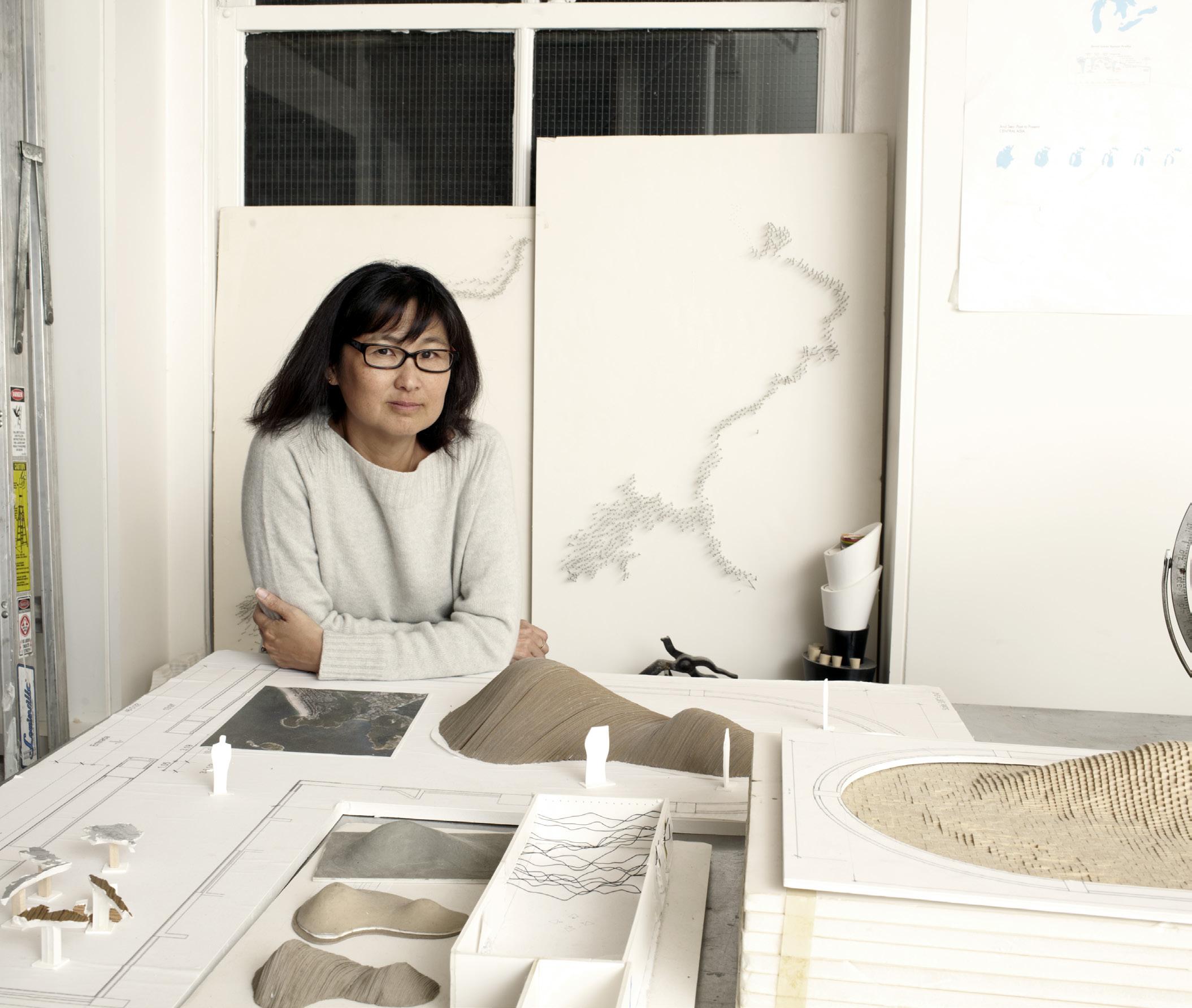
Speak, Memory
Artist, designer and environmentalist Maya Lin will be the keynote speaker at SVA’s 42nd annual commencement exercises, to be held Monday, May 7, 1:00pm, at Radio City Music Hall, the landmark art deco theater in midtown Manhattan.
Lin’s career began with her acclaimed design for the Vietnam Veterans Memorial in Washington, D.C. (1981), which she submitted to an open competition while she was an undergraduate student at Yale University. Since then, her art, architectural and earthwork projects have helped to shape America’s culture, memorialize its past and even alter its landscapes. Her other notable works include her land art “wave fields” for the Storm King Art Center, in Cornwall, New York (2009), the Wilkie D. Ferguson Jr. federal courthouse in Miami, Florida (2005), and the University of Michigan in Ann Arbor (1995); her Civil Rights Memorial in Montgomery, Alabama (1989); and her design for the Museum of Chinese in America, in New York City (2009).
Among Lin’s several current projects is What Is Missing?, a multimedia endeavor that the artist has called her last memorial. Decades in the making, What Is Missing? incorporates video, photography, audio recordings, sculptures, data visualizations and a website, whatismissing.net, all dedicated
to documenting—and provoking action to fight—the ongoing species extinction crisis brought on by climate change. In a recent interview with Art21 Magazine about the project, Lin said, “I feel like we have very little time. Our generation and our kids’ generation—they’re going to su er the real brunt of it. We have to move now and we have to do what we can.”
Lin’s work is in the permanent collections of a number of museums and institutions, including The Metropolitan Museum of Art, New York; The Museum of Modern Art, New York; the National Gallery of Art; and the Smithsonian Institution. She is a member of the American Academy of Arts and Letters and the American Academy of Arts and Sciences, and her many honors include a 2009 National Medal of Arts and a 2016 Presidential Medal of Freedom—America’s highest civilian honor.
The 2018 SVA commencement exercises will celebrate the achievements of some 1,180 bachelor’s and master’s degree candidates enrolled in the College’s 32 degree programs. For those unable to attend, the event will stream live online, and be archived thereafter, at sva.edu/commencement. [GH]
To submit an item to Close Up, send information to


Product Placement
In an e ort to promote the entrepreneurial and creative e orts of the SVA community, the SVA Campus Store has launched an in-store and online retail e ort, Makers@SVA, featuring a rotating selection of products created by College alumni.
SVA Campus Store Director Kade Scha er and Operations Director Jennifer Sturtz worked with Dan Halm (MFA 2001 Illustration as Visual Essay, BFA
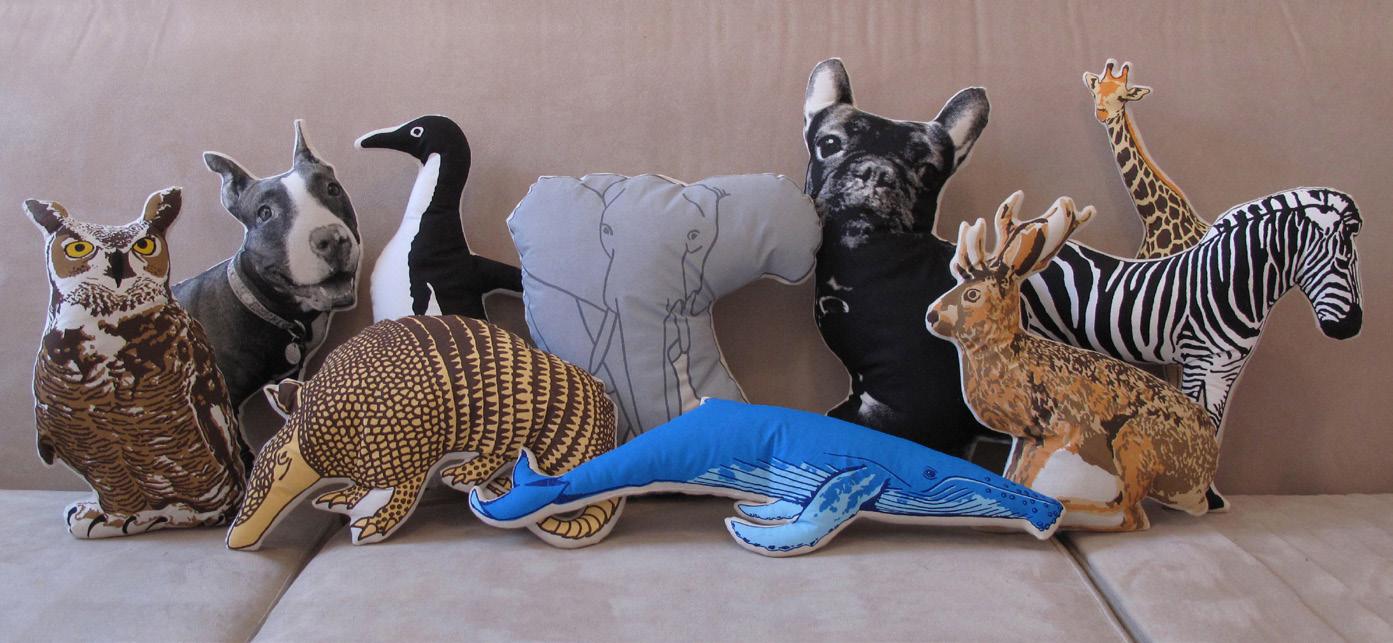
1994 Illustration), project manager in SVA External Relations and founding director of the SVA Makers Market event, to select the first round of participants: artist and printmaker Shannon Broder (MFA 2016 Fine Arts, BFA 2011 Visual & Critical Studies), lighting and furniture designer Richard Clarkson (MFA 2014 Products of Design) and product designer Chris Dimino (BFA 2002 Graphic Design). Since last November, Broder’s Broderpress silk-screened animal pillows, Clarkson’s Cloud lamps and Fiddle balls and Dimino’s Keyboard Wa e Iron have been on sale both at the store’s 207 East 23rd Street location and through its website. In addition, some one-of-a-kind items, like crocheted stu ed animals made by Kaori Sakai (BFA 2009 Graphic Design) and sold under her Studio Llama Llama brand, are available in store only. Be on the lookout for the next rotation of featured alumni products, which will be available in June. For more information about the SVA Campus Store and Makers@SVA, visit svacampusstore.com. [MM]
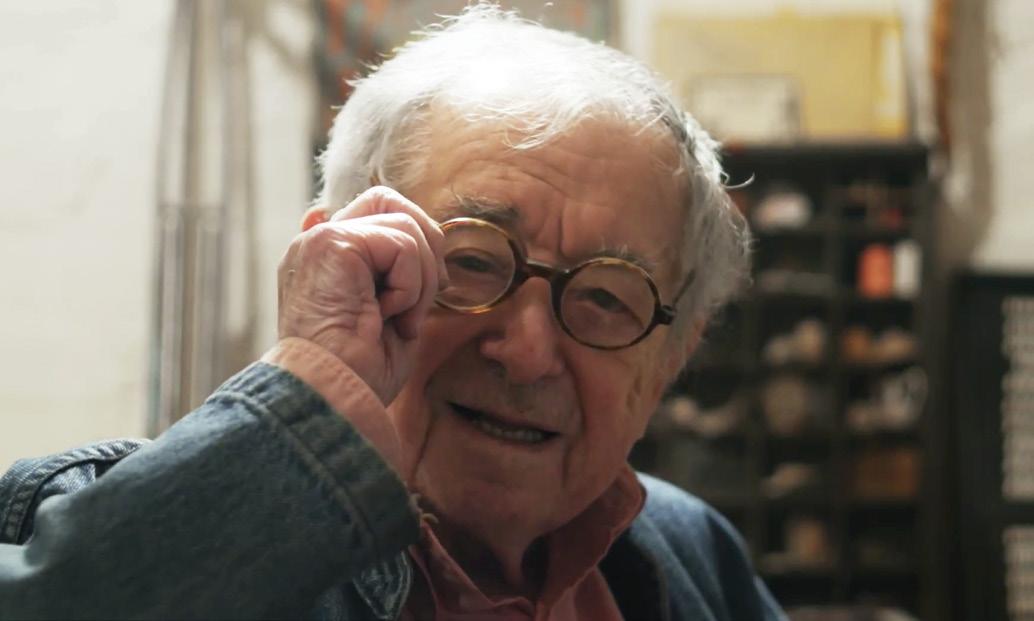
✶ HEARD AT SVA ✶
“The fact of the matter is, we’re not allowed to delete any images. . . . Every photograph that I took is now at the National Archive.”
—PETE
SOUZA , chief official White House photographer for the Obama Administration. From a talk hosted by MPS Digital Photography and B&H Event Space.
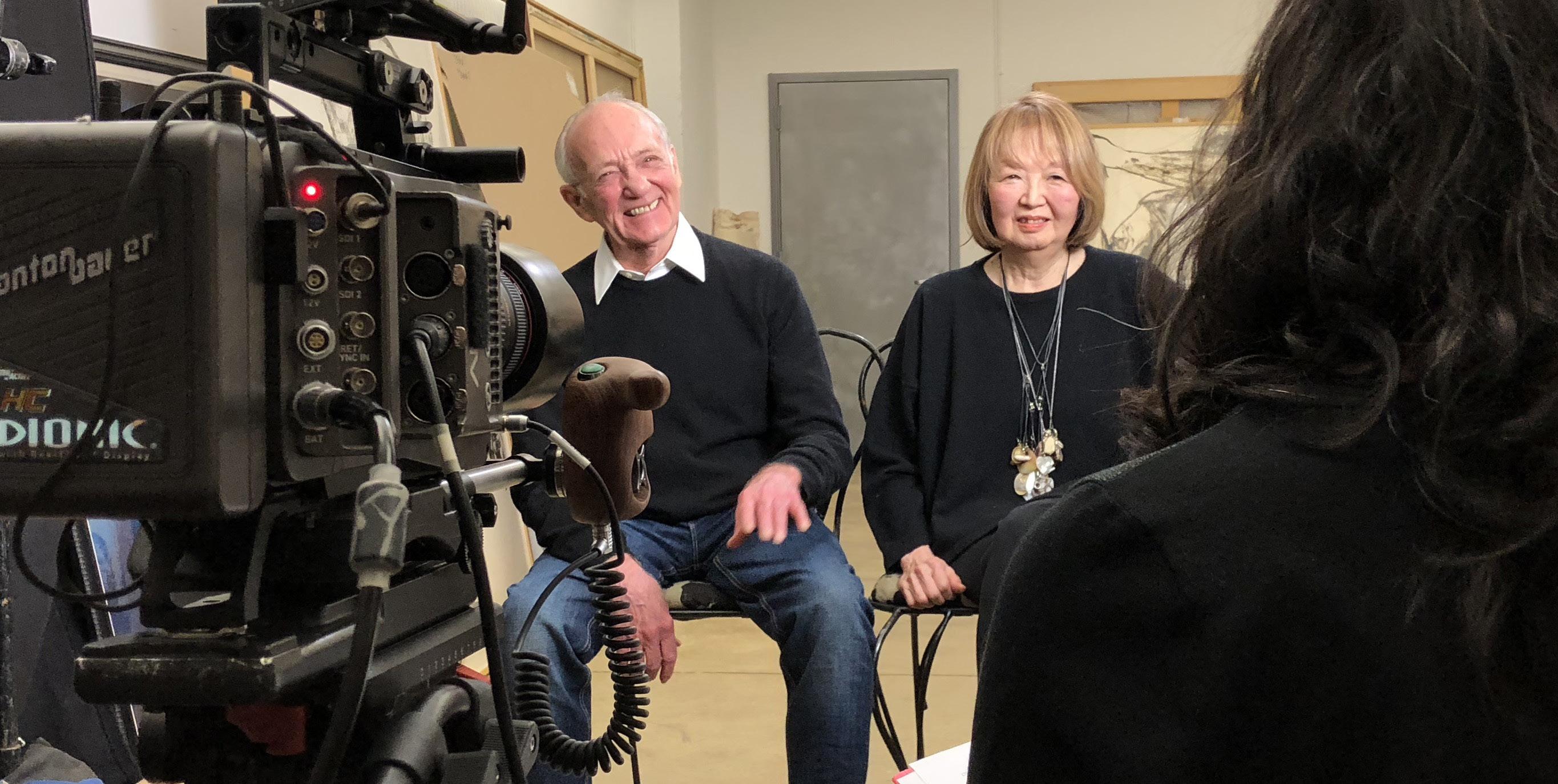
For the Record
Last fall, SVA introduced the Subway Series Hall of Fame, a video series dedicated to preserving the history behind the College’s long-running campaign of advertisements designed for display in New York City’s subway stations, begun by SVA founder Silas H. Rhodes in the institution’s earliest years. Produced by SVA’s Visual Arts Press design studio, SVA Communication and the SVA Archives, the videos feature some of the College’s most notable faculty reflecting on their careers, their time at SVA and, of course, their favorite poster designs. SVA Executive Vice President Anthony P. Rhodes, creative director of SVA’s sub-
way posters since 2007, first suggested the series, keen on sharing the stories of the talented artists who helped build SVA’s reputation as an art and design college.
George Tscherny was profiled first—fittingly, as he designed what is arguably the inaugural SVA poster in 1956, taught the first course in graphic design at the College in the mid-1950s and created the current SVA logo, known informally as “the flower,” in 1996. SVA Acting Chairman Milton Glaser’s video accompanied the release of his latest poster series, his 24th for the College, last December. And footage of Ivan Chermayeff at work—complemented by
interviews with his daughter Maro Chermayeff, MFA Social Documentary Film chair, and colleague Steven Heller, MFA Design co-chair—was released shortly after his passing late last year.
“The series is part of a general and positive trend to reexamine and highlight the history of SVA as a participant in the cultural life of the city,” says Beth Kleber, head archivist for SVA and the Milton Glaser Design Study Center and Archives, who conducts the interviews and provides historical material for the clips. The project is also, Rhodes notes, an opportunity to gain insight from some of the most influential designers and illustrators of the past half-century. “This is the first time that I’m really hearing about the creative process that
went into these campaigns,” he says. “For a person who’s not a practitioner, it’s important to hear that process.”
The video team plans to produce its next three Hall of Fame installments this spring, going behind the posters with graphic artist Paul Davis, MFA Illustration as Visual Essay Chair Marshall Arisman and writer Dee Ito, and illustrator Jim McMullan. To watch the Subway Series Hall of Fame and other SVA videos, visit sva.edu/videos. [ED]
ABOVE SVA’s Subway Series Hall of Fame videos profile some of the infl uential artists who have created posters for the College. Subjects include designer George Tscherny (top), MFA Illustration as Visual Essay Chair Marshall Arisman and writer Dee Ito (above).
WHAT’S IN STORE
The latest from SVA entrepreneurs: books, movies, products and more
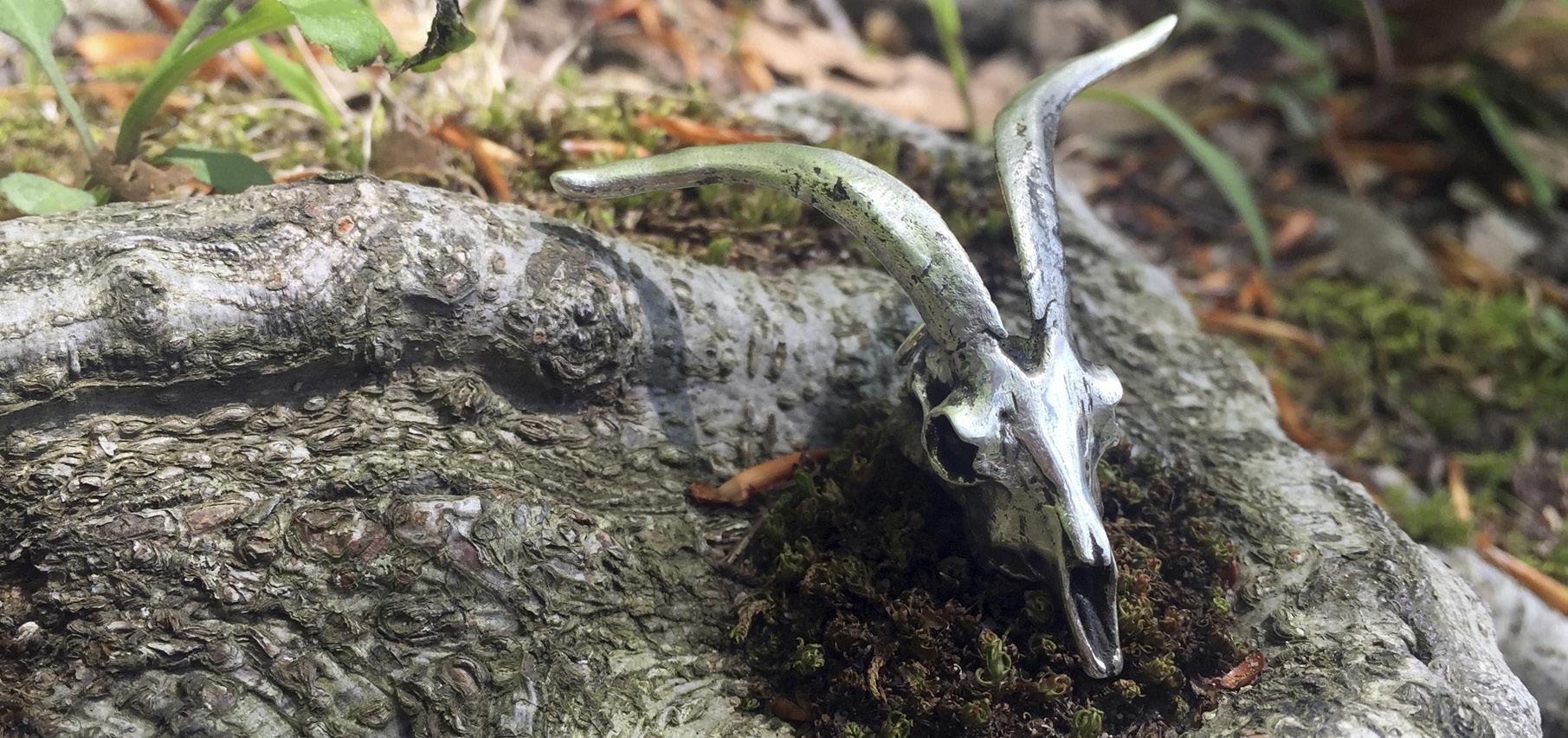
Fire & Bone
JASON BAKUTIS, CHRIS BOYNTON and MATT KRONER fireandbone.com
Bronze and silver jewelry and collectibles, $35 – $150
Co-founded by SVA alumnus Jason Bakutis (BFA 2011 Computer Art, Computer Animation and Visual E ects), Fire & Bone o ers skull cu inks, earrings, pendants, rings and collectibles. Each skull is based on a 3D scan of the genuine article and made with the traditional lost-wax casting process. The featured animals range from the extinct (velociraptors and dire wolves) to the common (brown rats and modern humans) to the somewhere in between (bison and gira es). [Greg Herbowy]
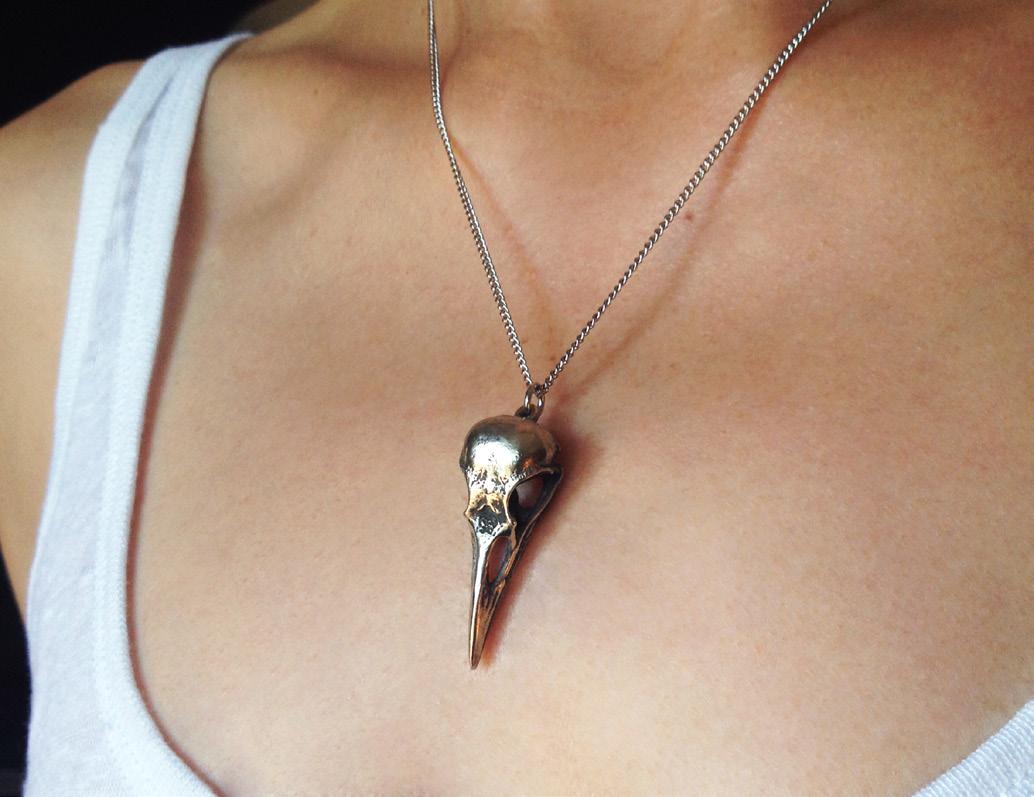
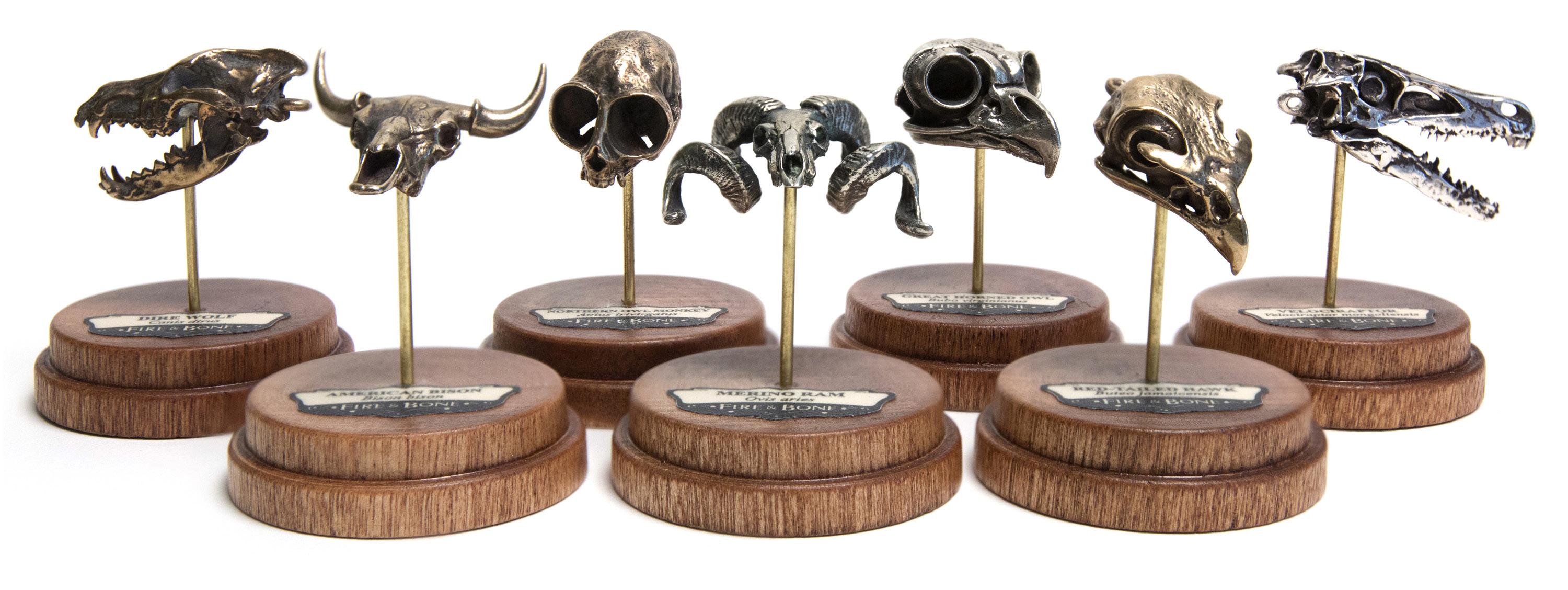
To submit a product for What’s in Store, send information to
Coif City
NADIA D E LANE
nadiadelane.com
Prints, $20 each; softcover book, 62 pages, $12
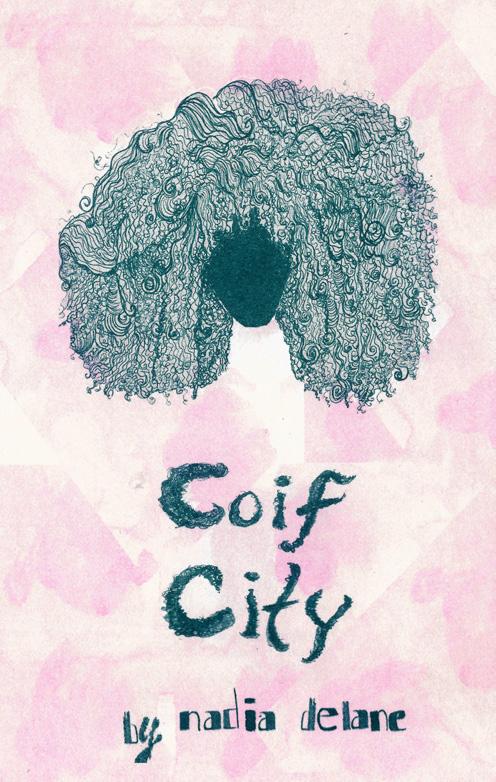
After more than 200 interviews with women and some 15 years of immersing herself in the cultures, customs and care of women’s hair, artist, author and creative consultant Nadia DeLane (MFA 2015 Visual Narrative) introduced her Coif City project. Comprising a book featuring drawings of hairstyles paired with quotes from the women who wore them and a series of limited-edition, 11-by-17inch prints in various colors, Coif City aims to capture the variety of experiences and “everyday hair dramas” of women today. Coif City, Volume I is available at DeLane’s website as well as bookstores in Chicago; New York City; Portland, Oregon; and London. Prints are sold exclusively online. [GH]



Mokuni Games
KURT YOUNG mokuni.com
Video games, free download on iTunes/Google Play/Amazon
✳Shortly after graduating from SVA, Kurt Young (MFA 2013 Computer Art) co-founded Mokuni Games, an independent video game company with a staff of eight working from its New York City office. Mokuni has developed and released nine games to date, including its latest, Kitty in the Box AR, in which players “raise” a virtual cat—petting it, feeding it and playing with it in a box-hunting adventure.
Mokuni is currently working on an interactive storytelling app, which assesses kids’ emotional intelligence, as well as a VR version of Kitty in the Box, which places the story in an outer-space setting. [GH]
WHAT’S IN STORE

HQ Trivia
RUS YUSUPOV and COLIN KROLL Game show app, free download on iTunes/Google Play

Rus Yusupov (BFA 2006 Graphic Design) knows a thing or two about building a hot app. In 2012 he co-founded Vine, a beloved six-second video platform that was ultimately shuttered after being purchased by Twitter. Five years later, Yusupov co-founded HQ Trivia, an app-based game show. Now every day, hundreds of thousands of HQ’s loyal fans, “HQties,” pick up their phones and play.
“If you look at the basic, structural pieces of HQ Trivia, it’s all things that have been successful at engaging people before. We blended a new formula from tried-and-true pieces,” Yusupov says. “The game play really grabs people.”
He also credits the show’s hosts— most often comedian Scott Rogowsky, whom players call “Quiz Daddy”—with engaging users. The cash winnings don’t
hurt, either. Each game’s prize is split by however many people correctly answer all 12 questions. HQ Trivia’s highest earner to date has won $6,000.
“I still consider myself very much a designer,” Yusupov says. “I’m in Photoshop most of the day. . . . I still approach a lot of thinking from the perspective of art and how artists of various disciplines solve problems.”
Yusupov says that the app’s design “leverages the flat, bright, Pop-y look of ’60s, ’70s TV game shows with a bit of a modern twist.”
“It comes alive during game play with 3D animations,” he says. “These elements are blurred together, where you can’t really tell if you’re interacting with an app or with TV Land.”
HQ Trivia’s rise has been documented from New York magazine to The New York Times, and Yusupov has no intention of

slowing down. “You wait for these moments of engagement, or milestones of some kind, and it’s definitely rewarding to hit them, but I don’t stop dreaming there. I think there’s always something bigger, something grander we can do.”
[Madison Malone Kircher]
Germusu
VANESSA GERMOSEN germusu.com
Plush toy pouches, $6; apparel, posters, prints and other products, $15.99 – $150.99
Growing up, Vanessa Germosen (BFA 2003 Illustration) heard her fair share of germ-related jokes about her last name. This, along with a keen interest in biology, led her to launch her germ-based toy line, Germusu. Germosen, who worked in product development for licensed characters for many years after graduating from SVA, was motivated to impart a lesson that most children—and adults—don’t always consider: Germs don’t just make us sick; many of them serve important functions. “I really wanted the germ-based characters to be useful as a product and unexpected in terms of germ characteristics,” she says. Each brightly colored Germusu plush toy—designed not for strict biological accuracy, but rather to function as a zippered pouch, as useful as it is cute—comes with its own text about the characteristics of that particular germ, whether it’s lactobacillus (responsible for turning milk into yogurt) or brevibacterium (one cause for stinky feet). Germosen o ers many other items—including a germy ABCs poster, mugs, pillows, phone cases and tongue-in-cheek greeting cards—and the line, much like real germs, continues to multiply, with new pouches currently in the works. [Dan Halm]



HAPPY SOCKS X KEITH HARING COLLECTION
Keith Haring (1979 Fine Arts) happysocks.com
Socks and men’s/women’s underwear, $12 – $52

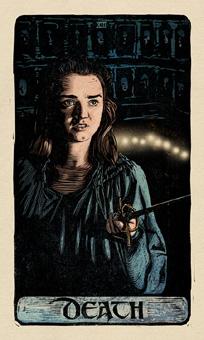
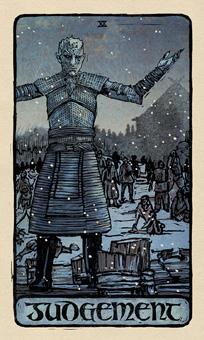


SHORTS
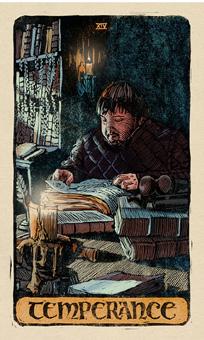
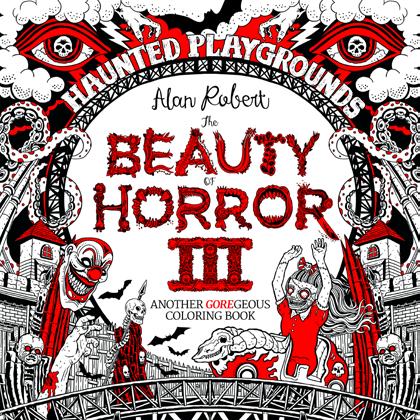
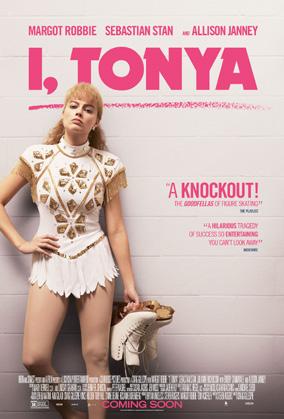
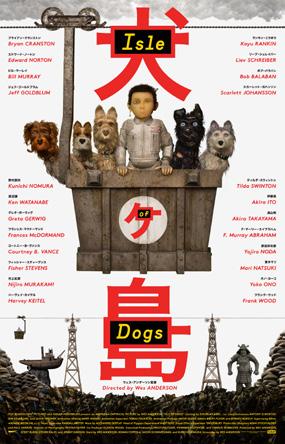
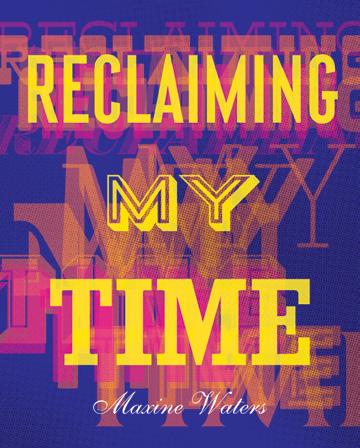

WHAT’S IN STORE
Various Projects, Inc.
ELIZABETH BEER and BRIAN JANUSIAK various-projects.com / projectno8.com / variouskeytags.com Accessories, books, clothing, furniture, souvenirs, etc., various prices
Elizabeth Beer (MFA 2005 Fine Arts) and her husband, Brian Janusiak, have always shared many interests, so it’s fitting that when they decided to start a company dedicated to multidisciplinary creative collaborations they named it something all-encompassing: Various Projects, Inc.
Thirteen years later, the couple has embarked on so many projects together and with other artists that they have stopped keeping count
(they think they’re at 531); a partial list includes hand-knit alpaca wool dolls of state and regional birds, angora-covered rocks, and leather goods. Maybe their most visible endeavor to date has been their Project No. 8 retail stores in New York City, which have provided Beer and Janusiak an outlet to sell their “digressions,” as they call them, as well as the work of underrepresented artists and designers. Two of the stores have since closed, but

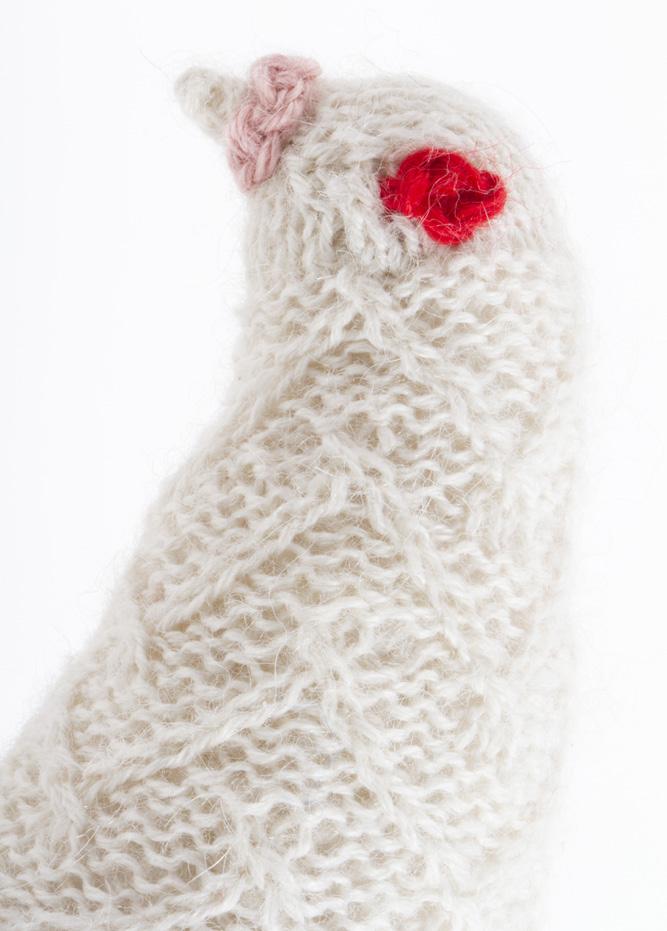
the location at the Ace Hotel on Broadway and 29th Street remains, selling stationery, magazines, candy, toiletries, souvenirs and clothing, all curated “through a very personal filter,” Beer says.
Another notable endeavor is Various Keytags, the couple’s series of small, colorful plastic fobs bearing short, often jokey words or phrases (“Amazeballs,” “Because I said so,” “I can’t quit you”). First created to sell at Project No. 8, the project has grown into a business of its own, with a dedicated
e-commerce site boasting hundreds of options, including custom tags and a new cast sterling silver version. Recently, Various Projects released a formal clothing collection through Print All Over Me, as well as a sock collection with N/A, and they continue to make products for their store and sell wholesale to hundreds of stores around the world. What started as Beer and Janusiak’s digression has blossomed into an ever-varied and full-time career.
[Michelle Mackin]
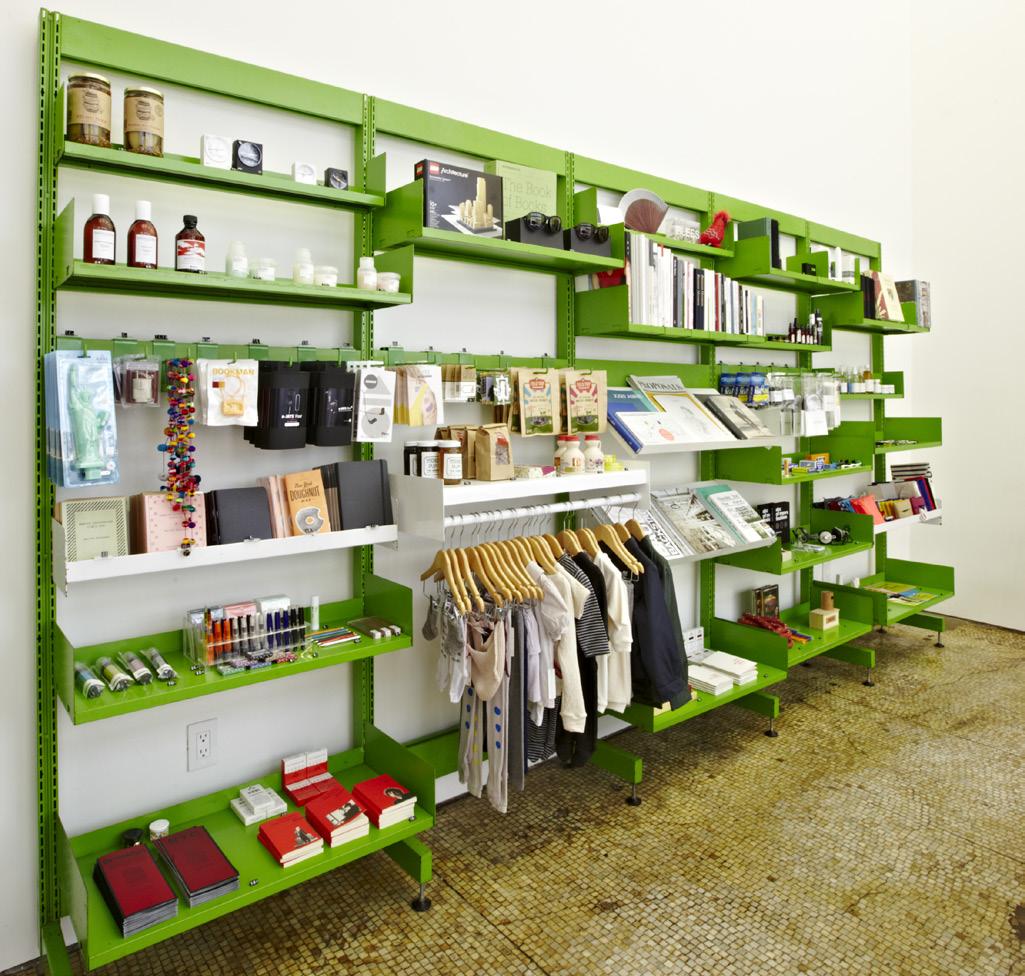


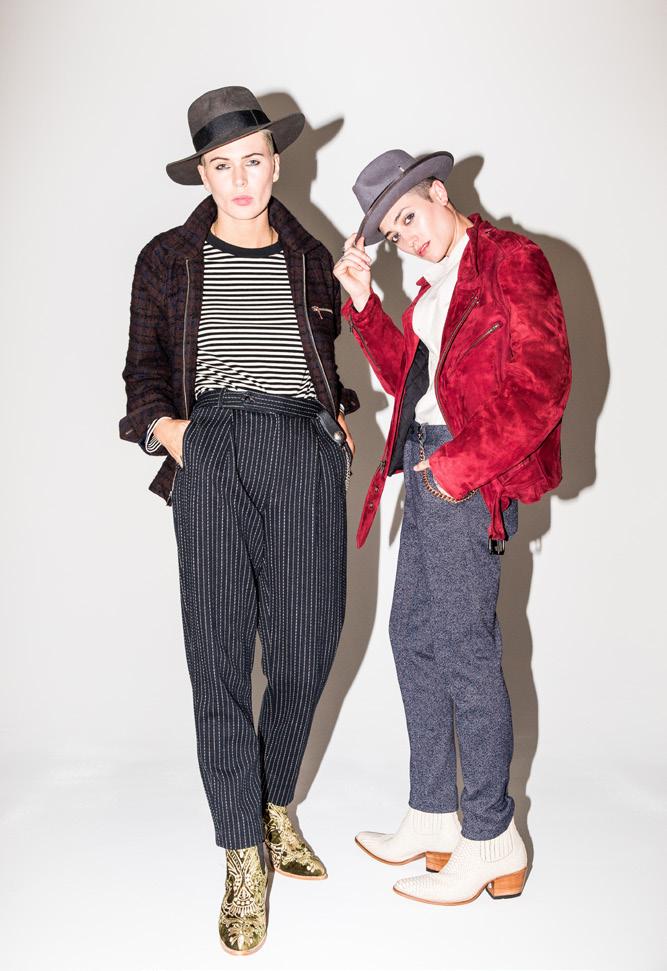
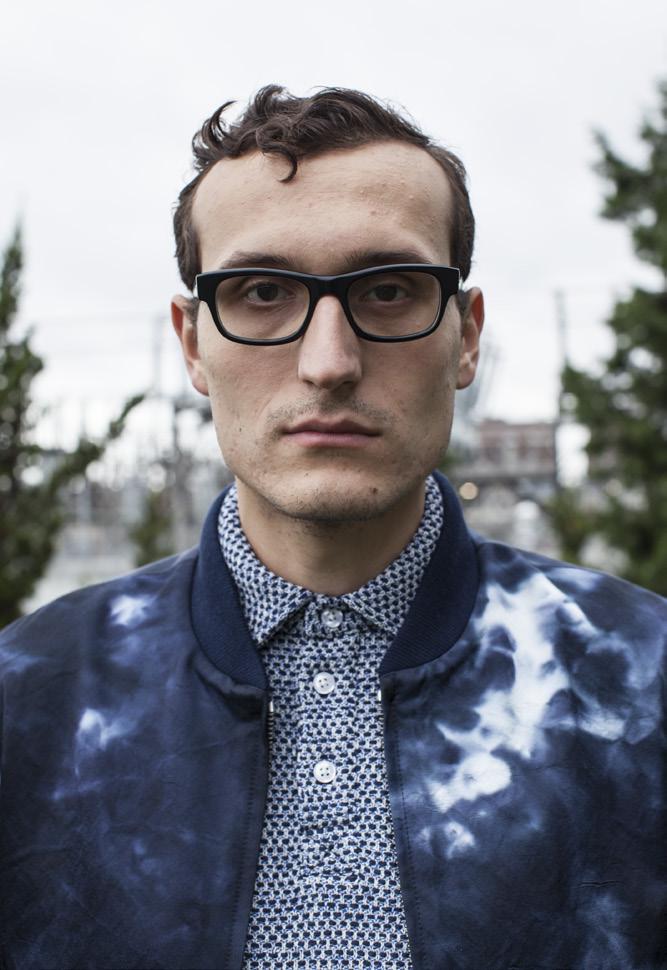
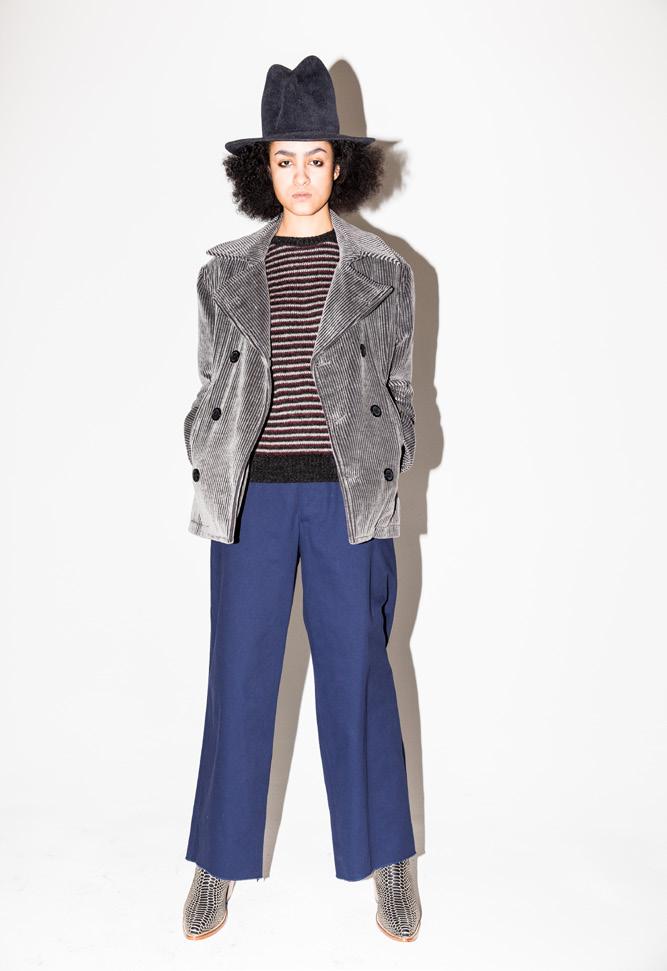
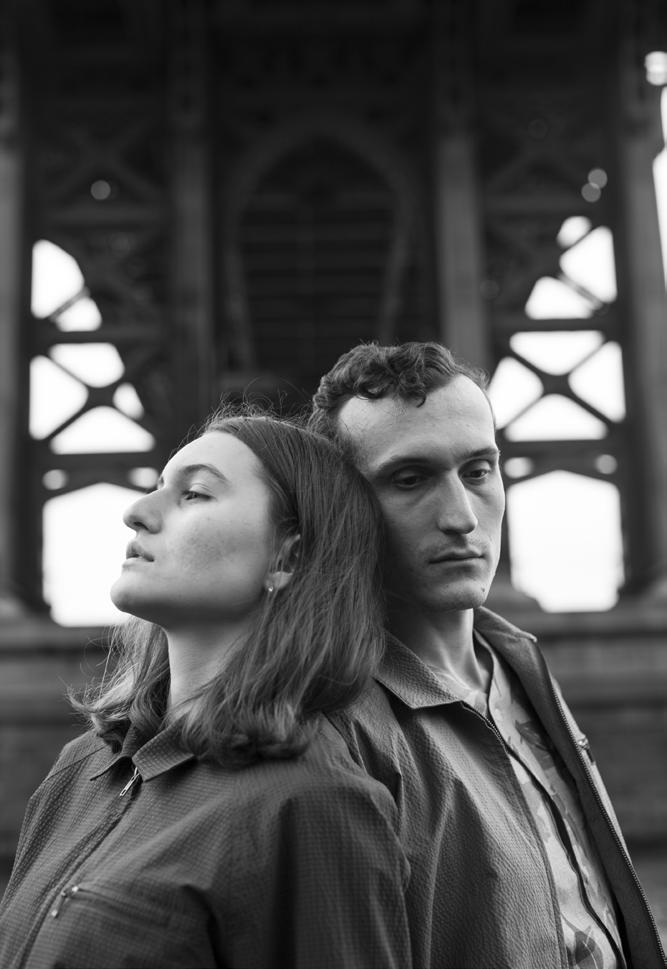
Krammer & Stoudt
COURTENAY NEARBURG and MICHAEL RUBIN
krammer-stoudt.com
Apparel and accessories, $125 – $750
❋Krammer & Stoudt, the six-year-old fashion label of husband-and-wife duo Courtenay Nearburg (MPS 2013 Fashion Photography) and Michael Rubin, makes menswear, but not just for men. Their jackets, shirts, tank tops, tees and pants all aim for a timeless, distinctly American style and are tailored to flatter anyone who wears them, regardless of gender. To emphasize this inclusivity, Krammer & Stoudt’s presentation at this past New York Men’s Fashion Week featured mainly nonbinary models, including Instagram stars Rain Dove (@raindovemodel), Mads Paige (@madspaige) and TJ (@renegades_).
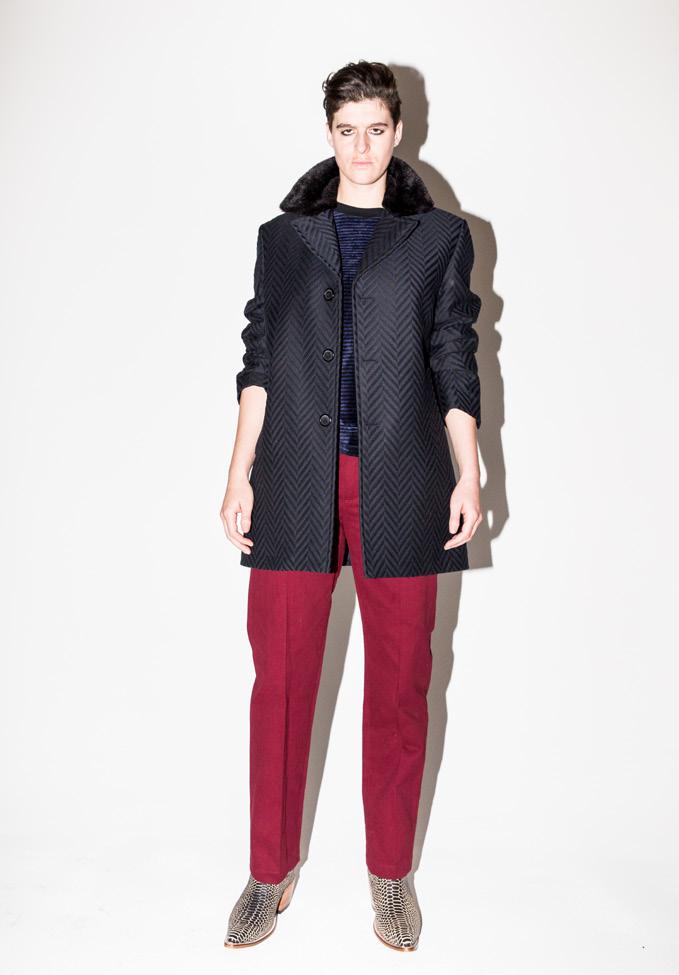
In keeping with this embrace of nonconformity, the couple takes their design inspiration from the rebellious skateboarding, surf and punk cultures of their youths and from durably cool iconoclasts like Rolling Thunder Revue-era Bob Dylan, playwright Sam Shepard and writer and musician Patti Smith. All Krammer & Stoudt clothes are made in the U.S., with much of the manufacture happening in Manhattan’s own Garment District. Nearburg and Rubin, who recently relocated from the West Coast, work and live in Brooklyn’s DUMBO neighborhood. [GH]
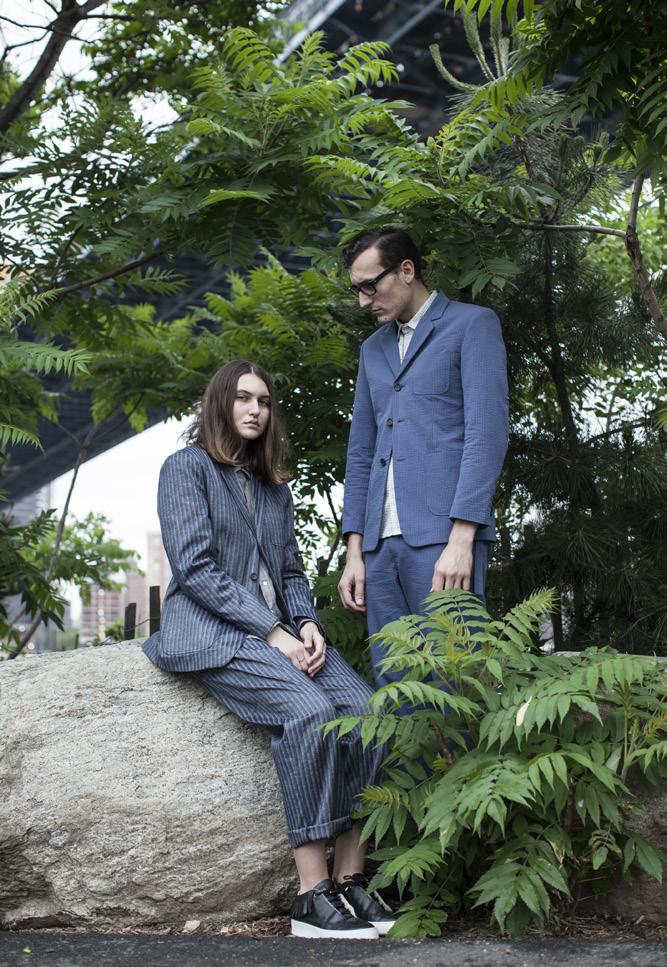
WHAT’S IN STORE
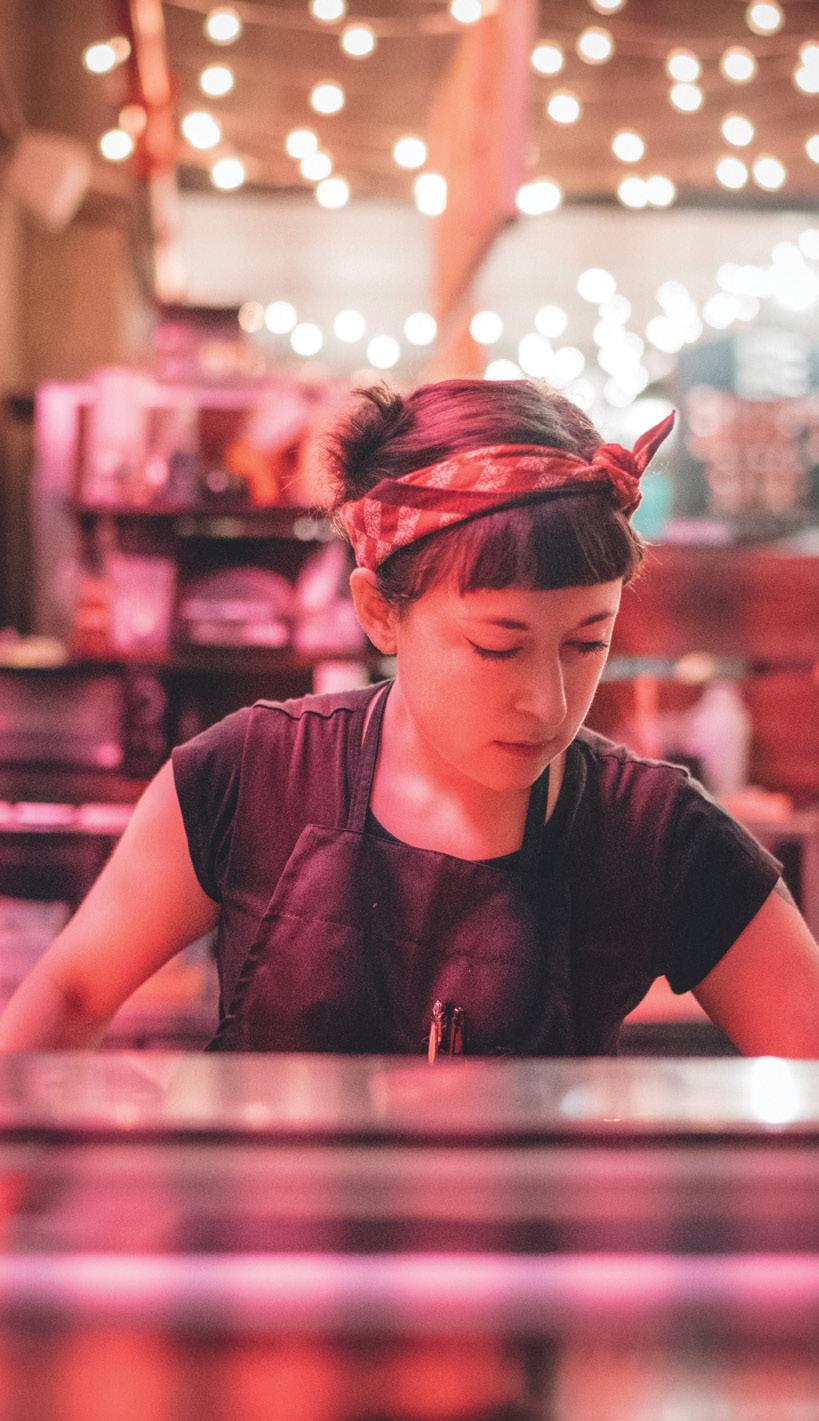

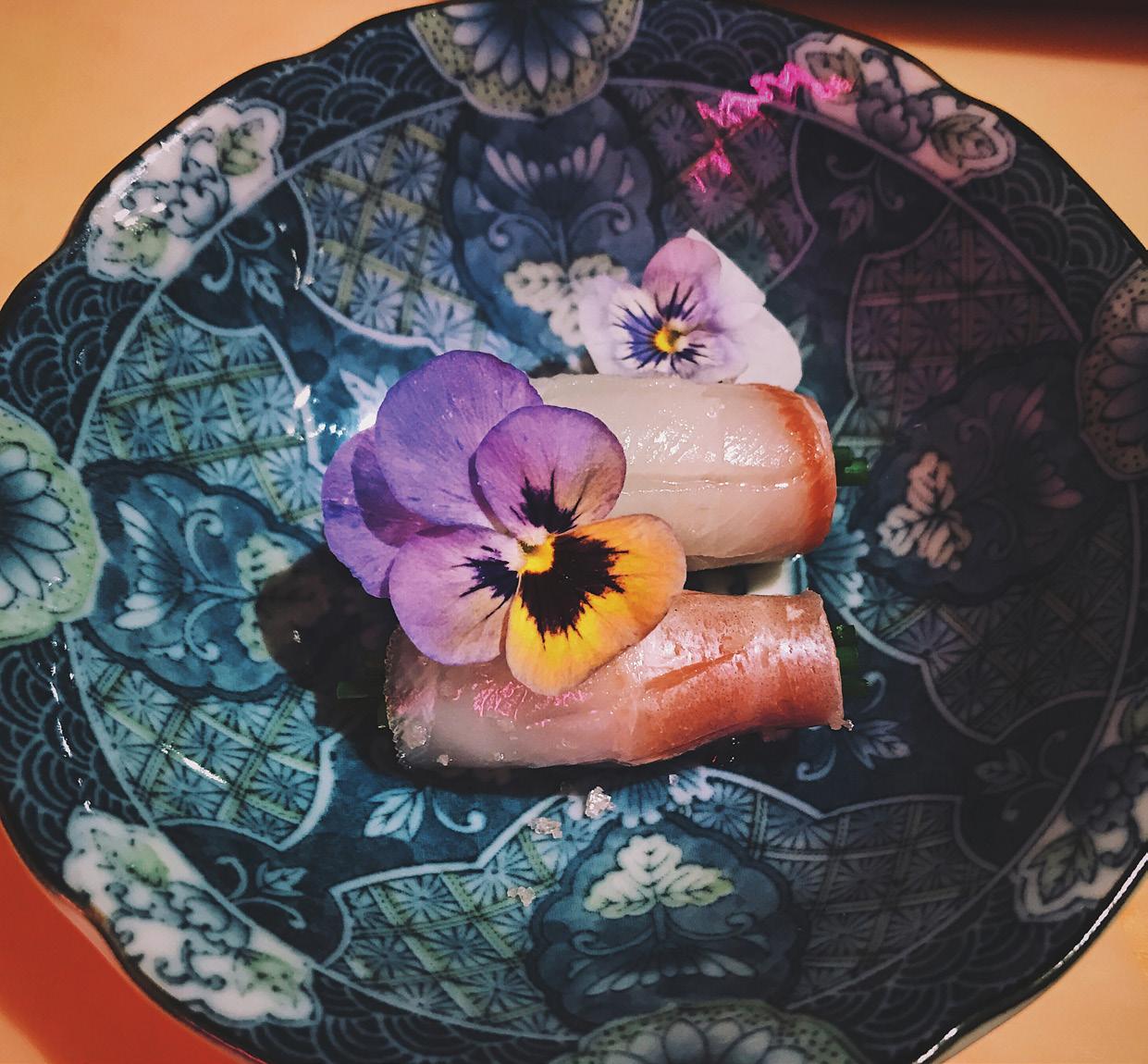
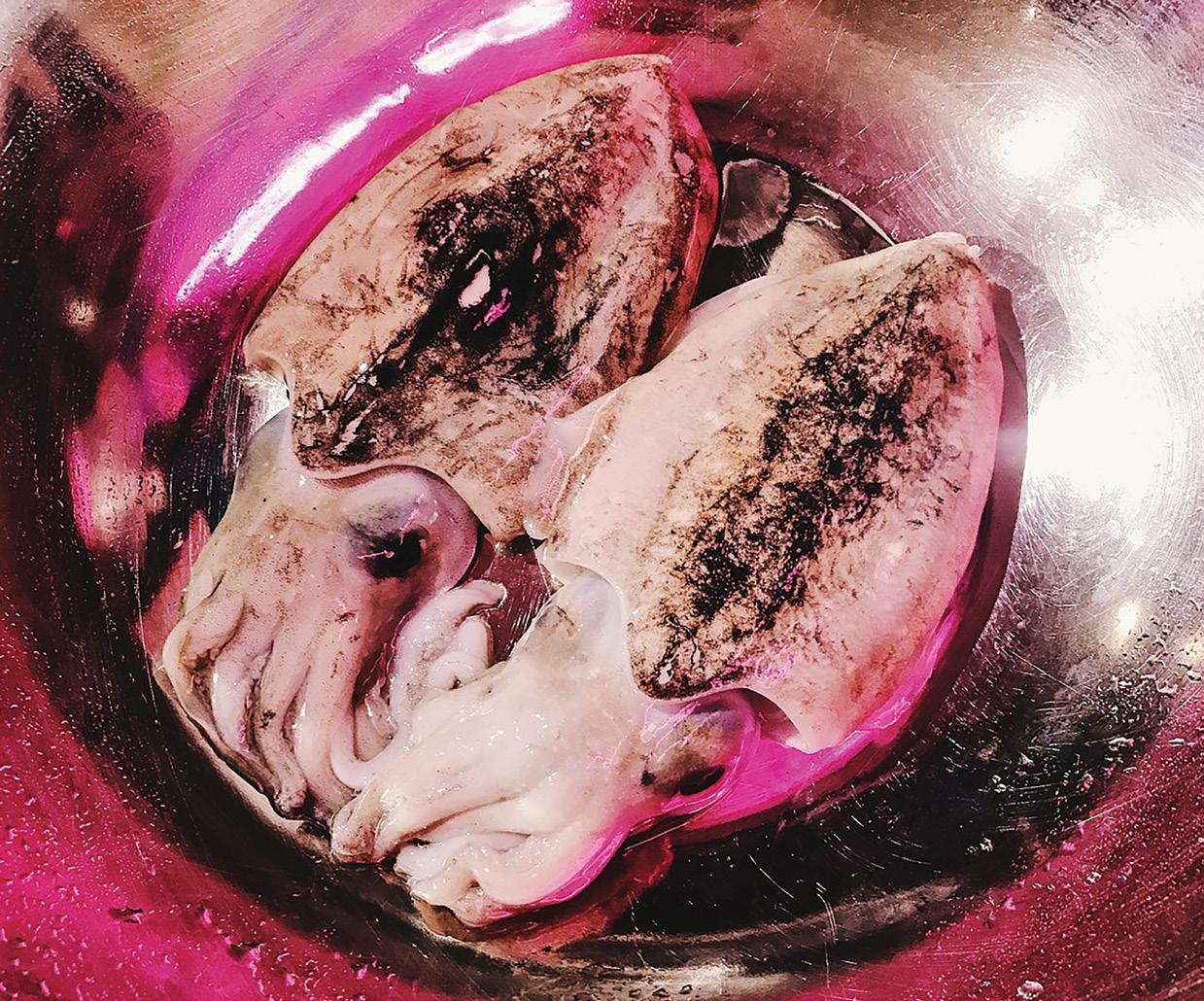
Sushi
by Bae
OONA TEMPEST sushibybae.com
Jue Lan Club, 49 West 20th Street, Manhattan Omakase sushi dinners, $100
✬Like many college students, Oona Tempest (BFA 2014 Visual & Critical Studies) earned her living while in school by waiting tables. But she is likely alone among her peers in parlaying that experience into a noted career as one of New York City’s few female sushi chefs. Tempest was working at Tanoshi Sushi, a small restaurant on the Upper East Side acclaimed for its omakase, or chef’s choice, meals, where her interest in the food, lifelong love of fish and Japanese culture, and artist’s dexterity with a knife caught the notice of chef Toshio Oguma. Oguma took her on as an apprentice on the condition that she devote her life to the craft, and after three years of training—during which Zagat named her one of New York’s “30 Under 30”— she has opened a place of her own, Sushi by Bae. The operation, which runs out of a space in the Jue Lan Club restaurant five nights a week, is reservation only, omakase only and Tempest only: The busy chef sources all ingredients, prepares and serves each course, keeps the books and brews her own soy sauces and vinegars. [GH]
Shelf Liners
Books by SVA alumni and faculty
ART EDUCATION/THERAPY
Color, Draw, Collage:
Create Your Way to a Less Stressful Life!
Jill Howell (BFA 1990 Media Arts)
Skyhorse Publishing Softcover, 128 pages, $14.99
The Open Art Room
Melissa Purtee and Ian Sands (BFA 1989 Media Arts)
Davis Art Softcover, 217 pages, $34.95
CARTOONS/COMICS
How to Read Nancy: The Elements of Comics in Three Easy Panels
Paul Karasik and Mark Newgarden (BFA 1982 Media Arts) Fantagraphics
Softcover/e-book, 276 pages, $29.99/$19.99
#LoveMUTTS: A MUTTS Treasury
Patrick McDonnell (BFA 1978 Media Arts)
Andrews McMeel Softcover/e-book, 208 pages, $19.99/$9.99
CHILDREN’S/YOUNG ADULT
The Dam Keeper (Volume I)
Robert Kondo and Dice Tsutsumi (BFA 1998 Illustration)
First Second Hardcover/e-book, 160 pages, $19.99/$9.99
In a Small Kingdom
Tomi dePaola and Doug Salati (MFA 2014 Illustration as Visual Essay)
Simon & Schuster Hardcover/e-book, 48 pages, $17.99/$10.99
Mary Had a Little Lizard
Kayla Harren (BFA 2011 Illustration) Sky Pony Press Hardcover/e-book, 40 pages, $16.99 both formats
DESIGN/DESIGN HISTORY
Cocktails Across America:
A Postcard View of Cocktail Culture in the 1930s, ’40s and ’50s
Diane Lapis and Anne Peck-Davis (1973) Countryman Press Hardcover, 224 pages, $24.95
The Moderns: Midcentury American Graphic Design
Steven Heller (co-chair, MFA Design) and Greg D’Onofrio Abrams Books Hardcover, 336 pages, $55
Winning Ugly: A Visual History of the Most Bizarre Baseball Uniforms Ever Worn
Todd Radom (BFA 1986 Media Arts)
Sports Publishing Hardcover/e-book, 176 pages, $24.99 both formats
Available May 1
FINE ART
The All-Over
Amy Sillman (BFA 1979 Fine Arts)
Dancing Foxes Press Hardcover, 164 pages, $40
Elizabeth Peyton: Dark Incandescence
Elizabeth Peyton (BFA 1987 Fine Arts)
Rizzoli Hardcover, 248 pages, $75
Katherine Bernhardt
Katherine Bernhardt (MFA 2000 Fine Arts)
Canada Hardcover, 176 pages, $40
Lorna Simpson: Collages
Lorna Simpson (BFA 1982 Photography)
Chronicle Books
Hardcover/e-book, 192 pages, $29.95/$20.99
Available June 5
PHOTOGRAPHY
Almost True
Steven Bollman (BFA 1983 Photography) F8 Books
Hardcover, 192 pages, $55
Amusement Park
David Brandon Geeting (BFA 2011 Photography)
Lodret Vandret
Softcover, 124 pages, $49.85
The Disappearance of Joseph Plummer
Amani Willett (MFA 2012 Photography, Video and Related Media)
Overlapse
Hardcover, 136 pages, $50
Them
Sean Hemmerle (MFA 1997 Photography and Related Media)
Kehrer Verlag Softcover, 120 pages, $38.76
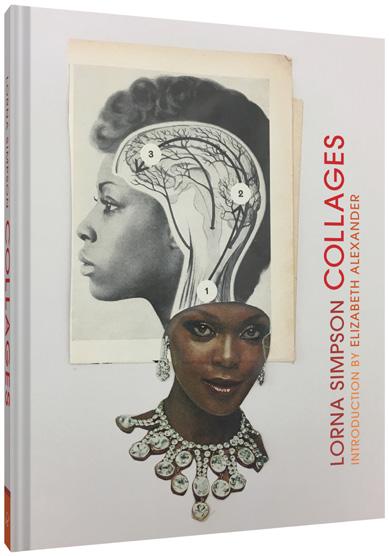
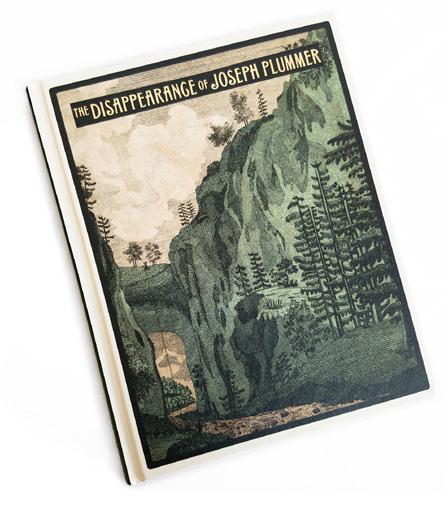
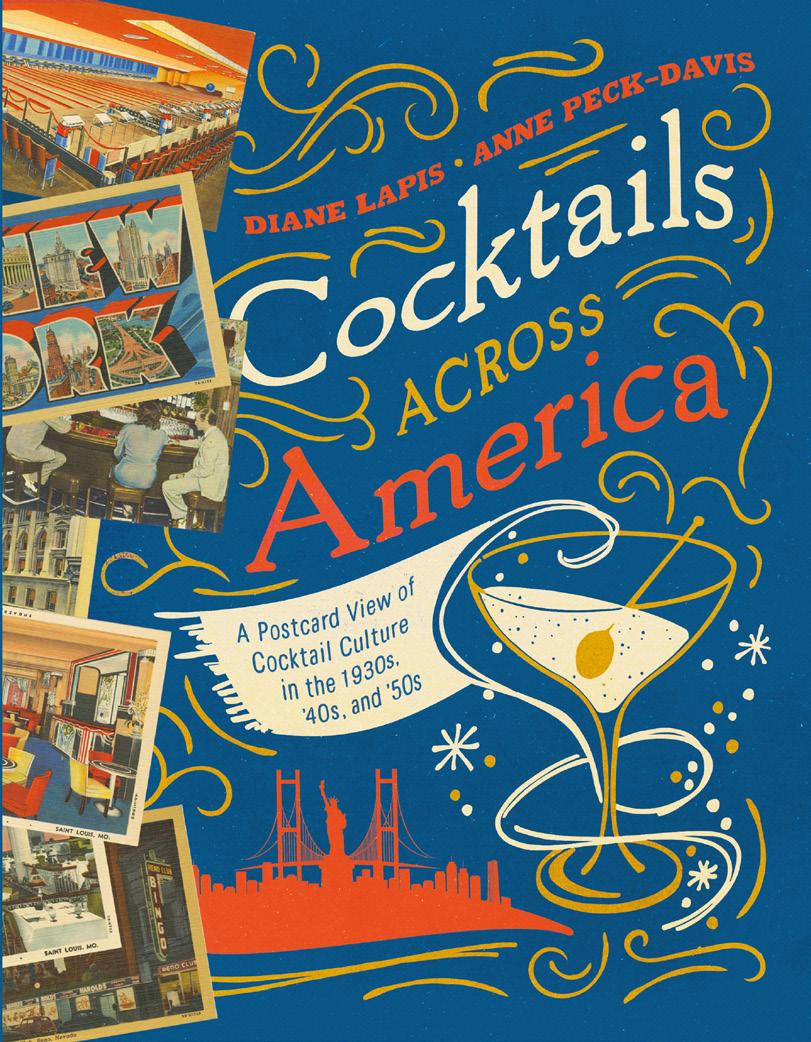
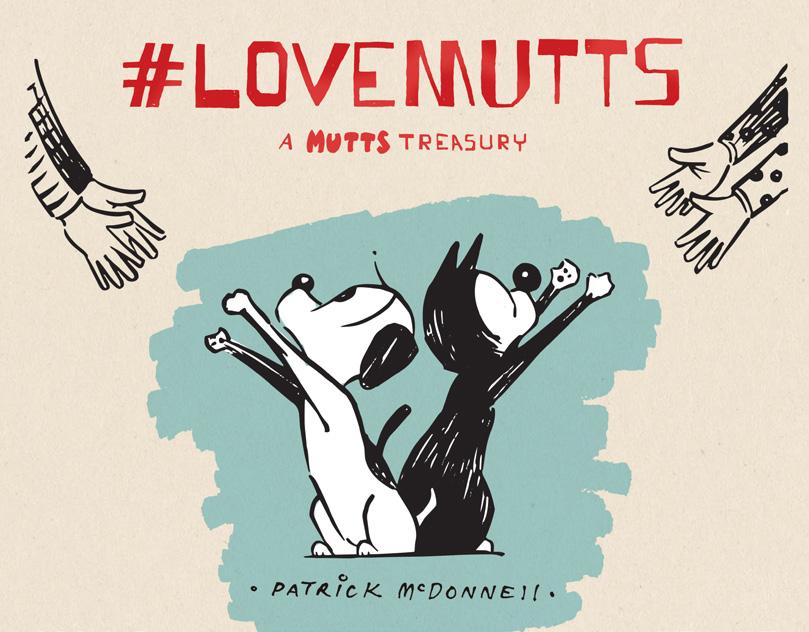
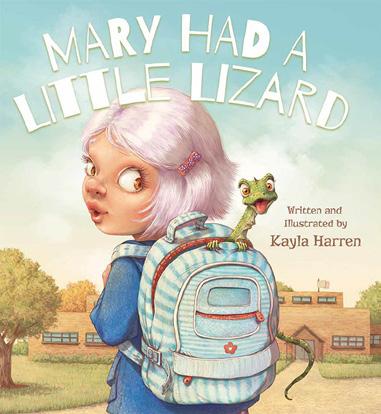

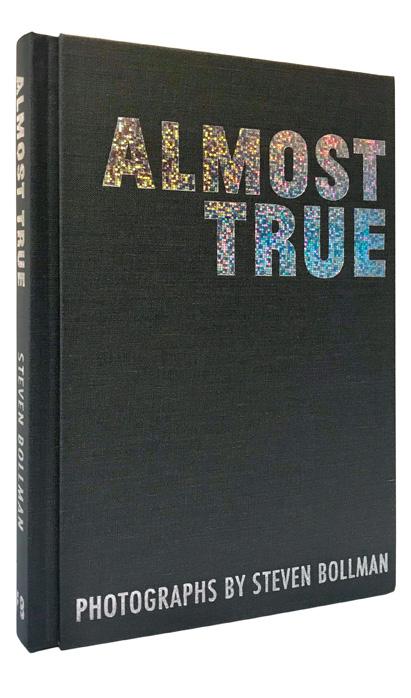
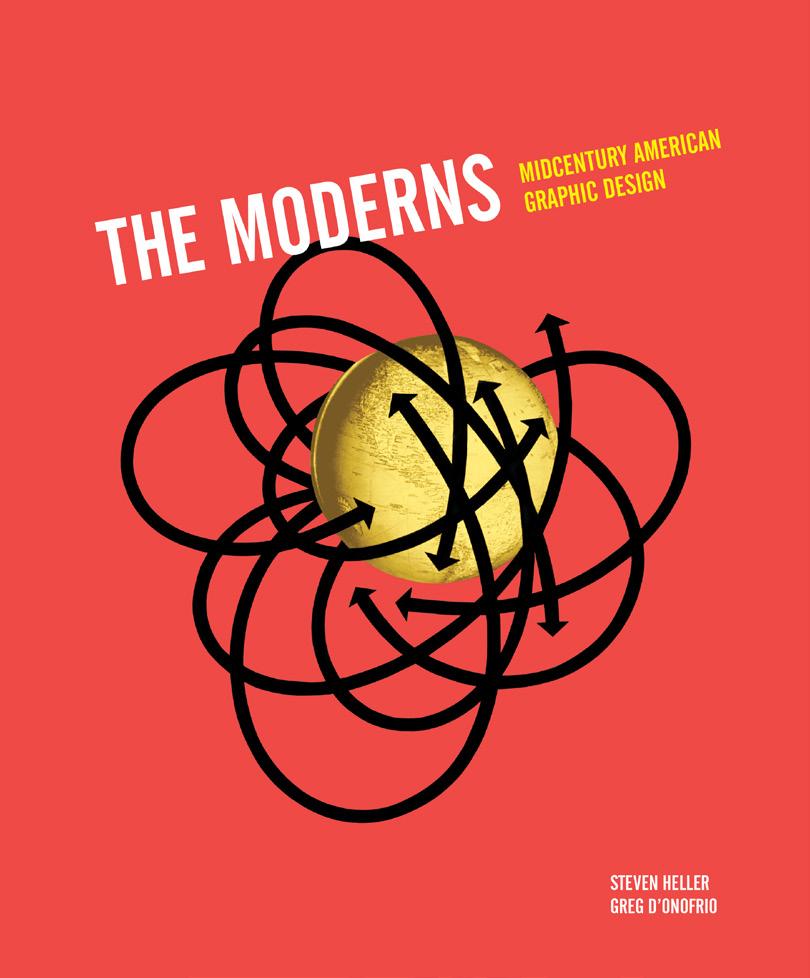
CREATIVE LIFE
Navigating the great wide world of work
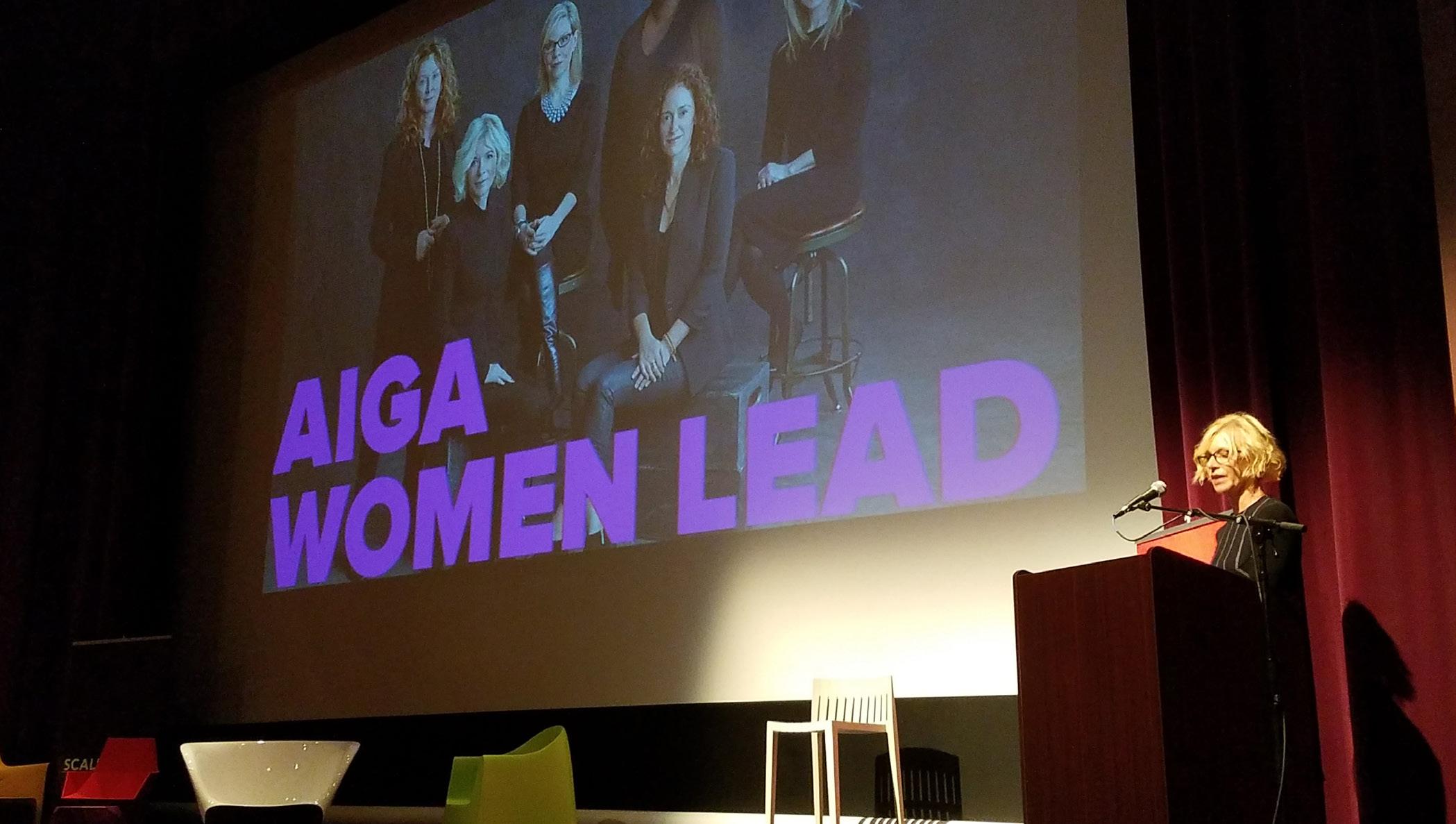
The Fight for Gender Equity
by alexander gelfand
In the wake of last year’s bombshell reports on sexual abuse and harassment by powerful men in the art, entertainment and media industries, women’s advocacy groups and professional organizations across the creative fields have been more visible, vocal and, arguably, influential than they have ever been. But even as they seek to address the most blatant forms of misconduct, representatives from these groups point out that women in fact face a slew of interrelated challenges in the workplace.
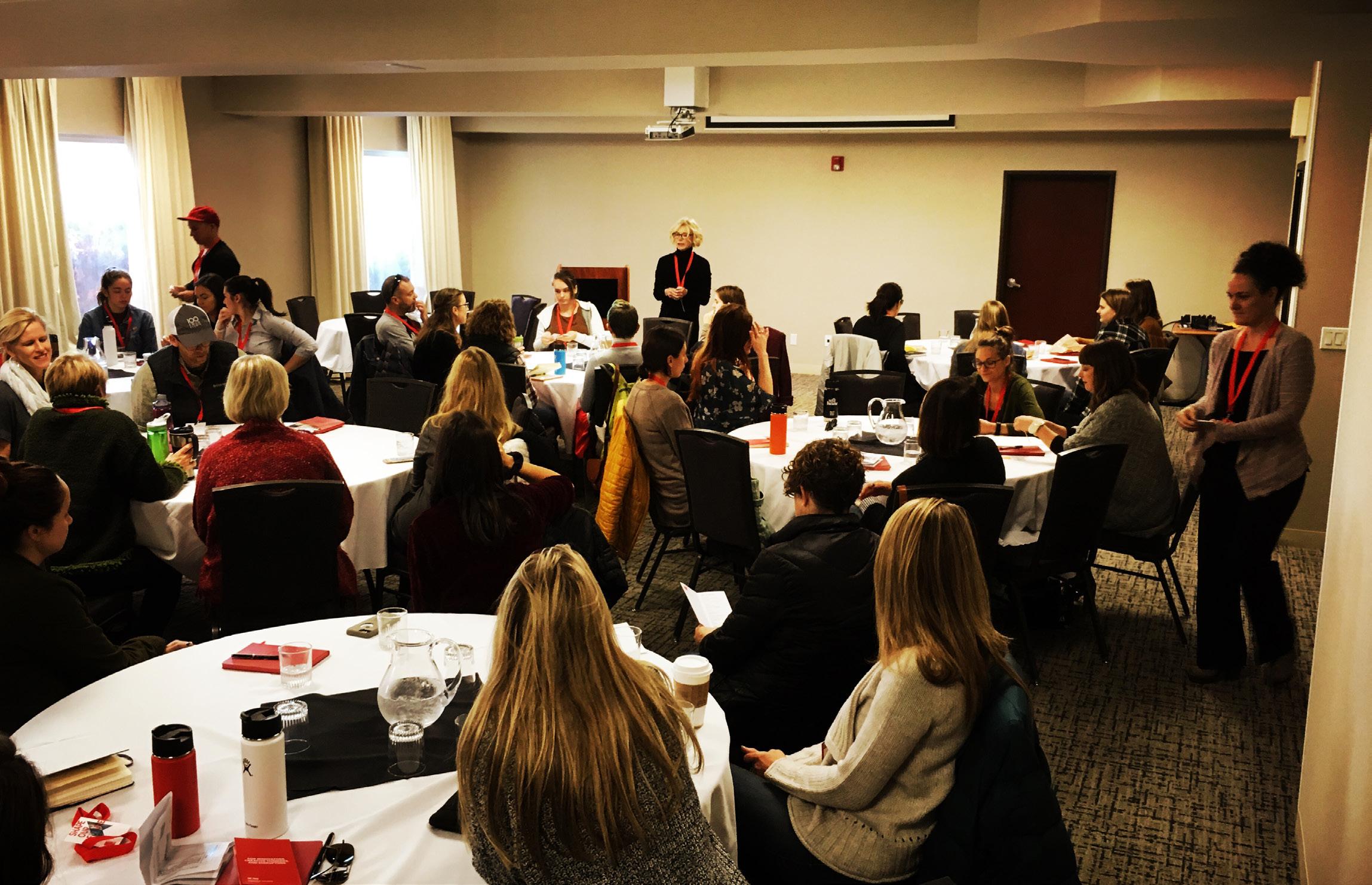
Studies show that working women of all professions typically earn 20 percent less than the men in their field, and in the creative industries the gap may be even wider: Last fall, Fast Company reported on a study that showed self-employed women make about 32% less than their male counterparts. What’s more, women on sta s rarely occupy key leadership roles. According to Deborah Adler (MFA 2002 Design), principal of Adler Design and co-founder of the Women Lead Initiative (WLI) at the design industry organization AIGA (aiga.org/women-lead-initiative), women make up more than 60% of design students, yet they hold only 11% of leadership positions in the field. And those statistics are by no means unusual.
“The numbers across all the creative industries are really terrible,” says Lynda Decker (MFA 2014 Design Criticism), president and creative director of Decker Design and WLI co-chair. In part, she says, this is a retention problem. As they climb the corporate ladder, many women “start running into gender bias issues, get fed up and leave.” Those issues include not only outright harassment, but also the kind of unconscious or implicit bias that a ects how women are compensated and promoted.
“It’s there, but you can’t see it,” says Adler, who notes that WLI developed a gender-equity tool kit, available to all AIGA members, to help people identify
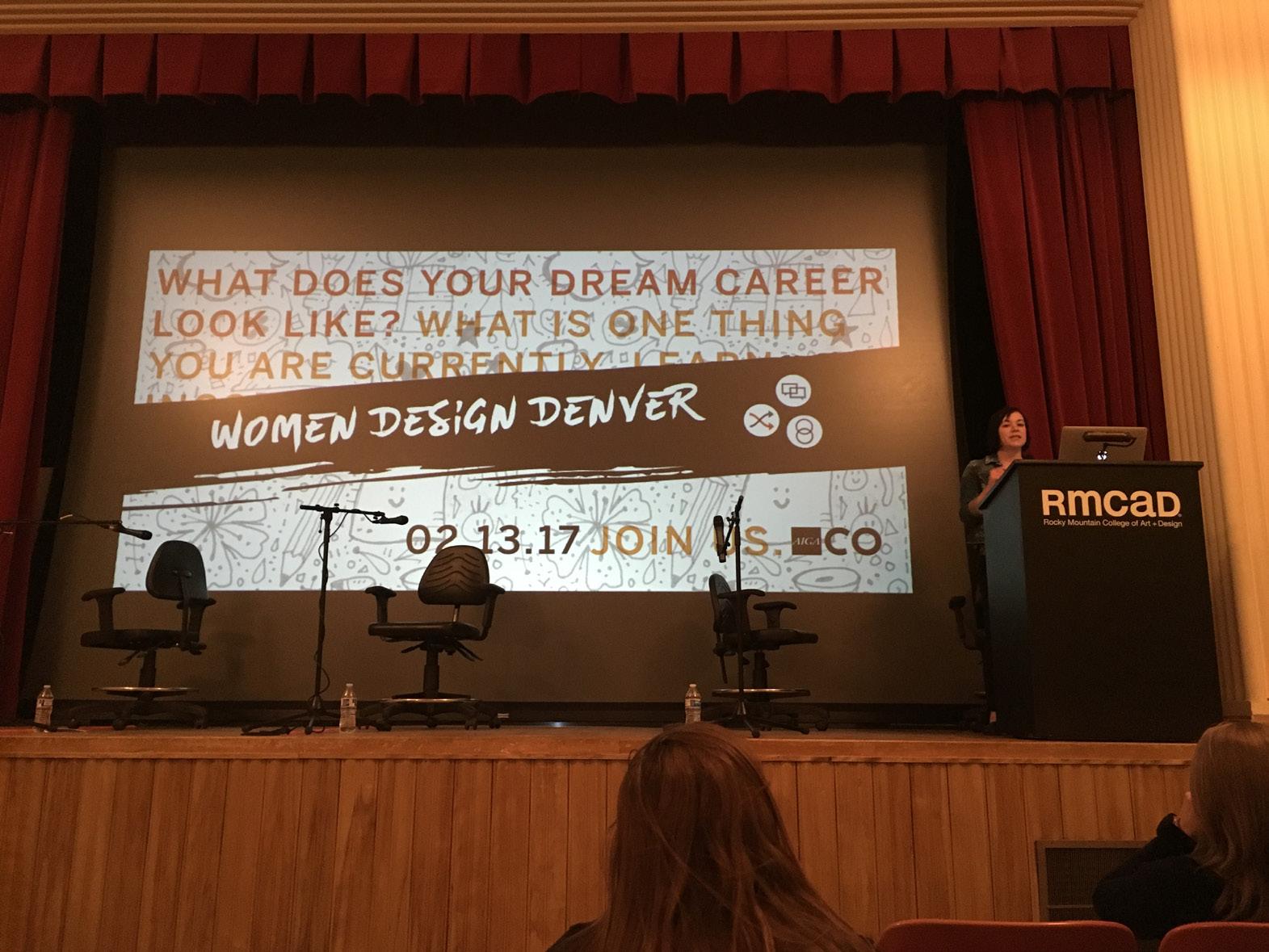
their implicit biases, raise awareness of the gender disparities around them and o er guidance about negotiating for better pay or benefits.
Parenthood brings additional complications, as a lack of flexible working hours and a ordable childcare options, coupled with deeply ingrained preconceptions about the mother’s role,
present further career obstacles to women with kids. “There’s not enough support within organizations for women who are mothers, and that’s really when
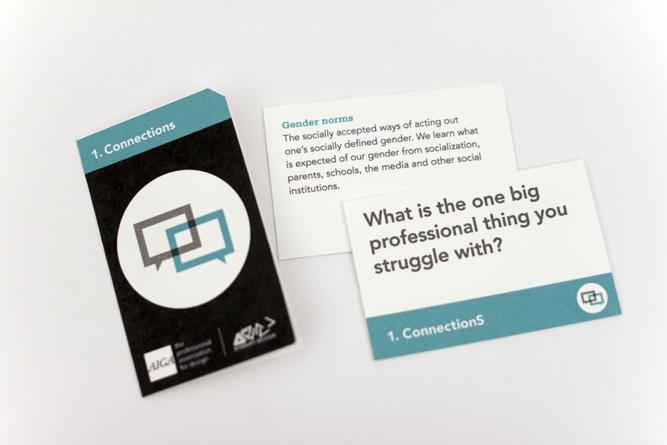

we start losing people,” Decker says.
All of these factors contribute to a workplace where the leadership skews male. That, in turn, means that there are relatively few women mentors available to help guide and inspire young female creative professionals, further hampering their career prospects.
“You need to be able to see that there are women directors to even think that’s an option for you,” says Margaret Dean, president of the nonprofit organization Women in Animation (WIA; womeninanimation.org) and general manager of Stoopid Buddy Stoodios, a Southern California production company that specializes in stop-motion films. Dean spoke at SVA last October about gender bias and the di culties of pursuing a career as an animation director at an event jointly hosted by the WIA New York Chapter and SVA’s WIA Student Chapter.
This vicious circle—gender bias prevents women from rising to the top, and a lack of women at the top reinforces gender bias—contributes to sexual harassment. A recent article in Harvard Business Review cites voluminous research demonstrating that harassment flourishes in workplaces where men dominate management and women have little power, but is less likely in industries where women are well represented in core jobs.
“Assault is not really separate from all of these other issues,” Decker says. “What it boils down to is that there are serious issues of dignity and respect for women in the workplace, from feeling
To help its members identify implicit biases and raise awareness of gender disparities, AIGA worked with Disrupt Design to develop its Gender Equity Toolkit. Photos courtesy AIGA.
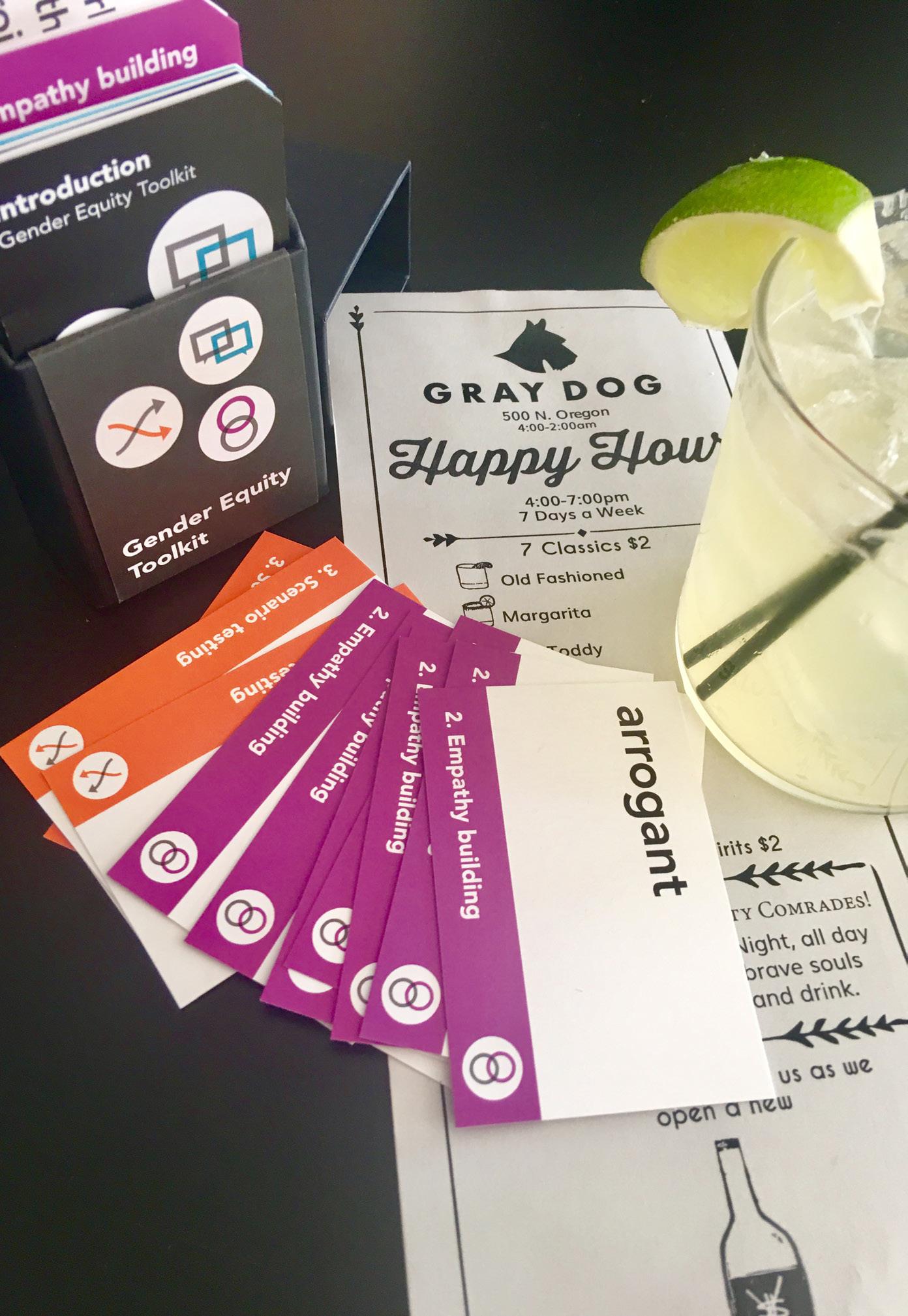


that women aren’t deserving of equal pay to the rest of it.”
The bottom line: Moving more women into leadership roles is essential to combating sexual misconduct. For their part, WLI recently launched a new initiative to double the number of female designers in leadership positions to 22% over the next two years, and will soon unveil a new digital platform devoted to women’s issues. WIA, meanwhile, maintains a members-only job board and is calling on independent animation studios to increase the number of women in creative roles to 50% by 2025. And both organizations’ local chapters organize workshops, mentoring programs and networking opportunities for their members.
Neither group expects harassment or inequity in their industry to disappear anytime soon. But both hope that the current focus on sexual misconduct and abuse will raise awareness of the less overt gender bias that makes hostile work environments possible, ultimately transforming the way women are regarded in the workplace—a shift that is already well under way, Dean says.
“I don’t believe we’ll ever go back to the way things were. There’s been too much cultural change already.” ✱
ALEXANDER GELFAND has written for The Economist, The New York Times and Wired, among other publications.

TMORE RESOURCES
he demand for gender parity and the end of sexual harassment in the arts is a central tenet of a growing number of professional women’s organizations as well as more community-based alliances. From co-working spaces to nationwide networks, the following resources champion the advancement of women in the art world and beyond. [Emma Drew]
Women in Photography, founded by Amy Elkins (BFA 2007 Photography) and Cara Phillips, showcases and supports the work of female lens-based artists. An internet-based project, Women in Photography maintains a grant and mentorship program, a list of resources pointing to other women-focused opportunities and publications, and a running tally of women’s solo exhibitions at major arts institutions.
* wipnyc.org
POWarts, the Professional Organization for Women in the Arts, organizes events and cultivates mentoring opportunities that support the professional lives of women in the art world; last season’s roster included a talk by legal professionals on confronting sexual harassment and a series addressing representation, diversity and feminism in the arts. POWarts is geared toward museum, auction house, and nonprofit professionals, gallerists, academics and educators, art advisers and owners of art-related businesses. Most events are not member-exclusive.
* powarts.org
New Women Space is a community event space in Brooklyn whose programming is led by self-identified women and femme, queer, transgender and gender-nonconforming individuals. They offer rental rates on a sliding scale
and host art exhibitions and support groups as well as evenings of financial vision-boarding, zine making and workshops on self care.
* newwomenspace.com
The Wing is a women’s social club that offers dedicated spaces in New York City (and soon, Washington, D.C.) for co-working and connecting. Membership ($215 – $250 per month) is required but the amenities are top-notch—illustrator Joana Avillez (MFA 2012 Illustration as Visual Essay) designed the wallpaper at the inaugural location, in Manhattan’s Flatiron District—and programming thus far has included events like Negotiating 101 and an exclusive conversation with U.S. Senator Kirsten Gillibrand.
* the-wing.com
Modern Alliance, founded in 2017 by Emmy Award-winning writer Kater Gordon, aims to unite people and organizations across industries to put an end to sexual abuse and harassment. A growing coalition of organizations and creatives working together to fund research, produce original content and champion platforms that empower and educate, it acts as a resource as well as a way for creators, designers and technologists to join the movement.
* modernalliance.com
Robert Lazzarini
by dan halm
Artist Robert Lazzarini (BFA 1990 Fine Arts) is no stranger to confronting violence in his work. His muse for “Inflorescence,”
his recent exhibition of work at the De Buck Gallery in Manhattan, was famous in life, but is now best known for her infamously grisly death: Sharon Tate, the pregnant actress who, along with four others, was murdered in her Southern California home in 1969 by followers of Charles Manson.
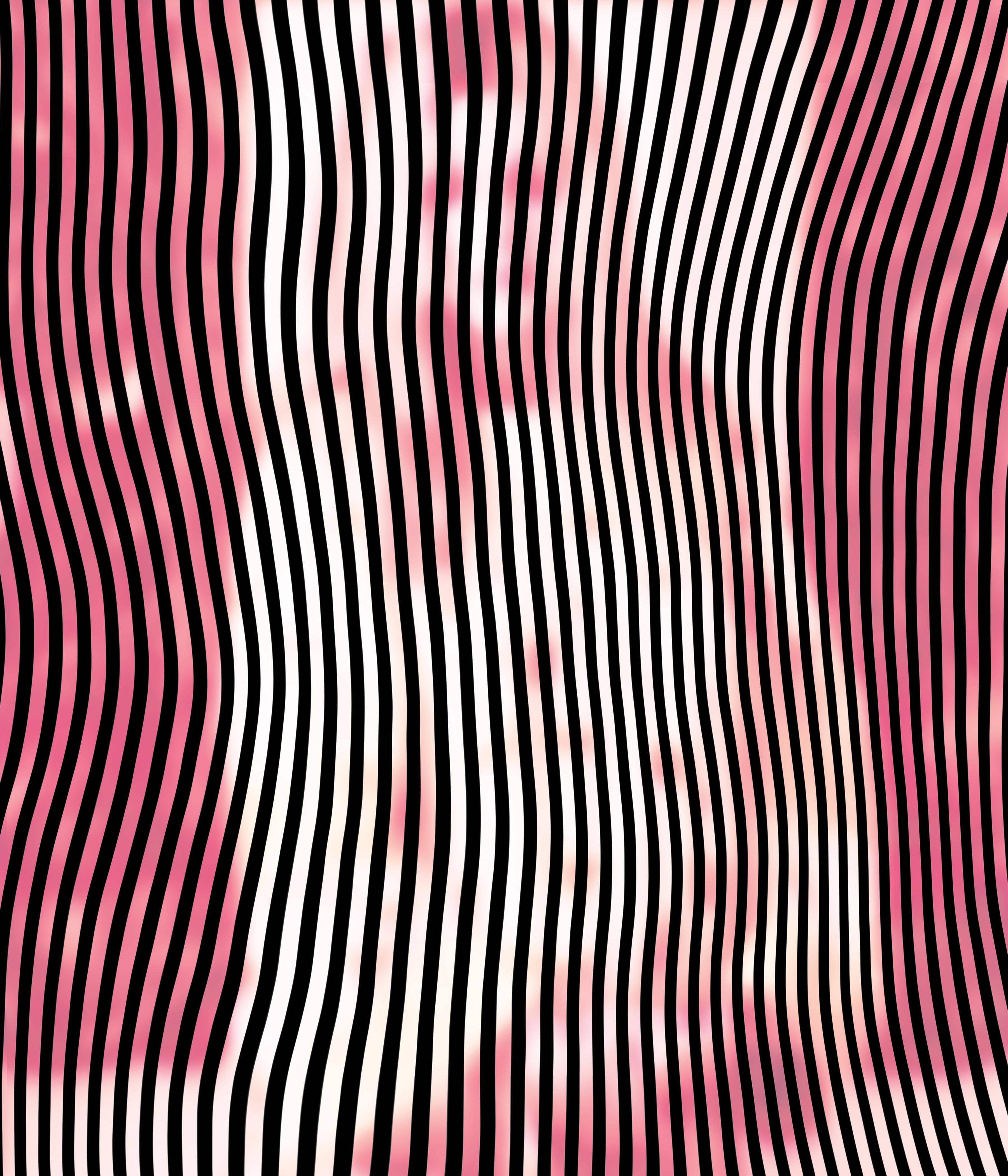
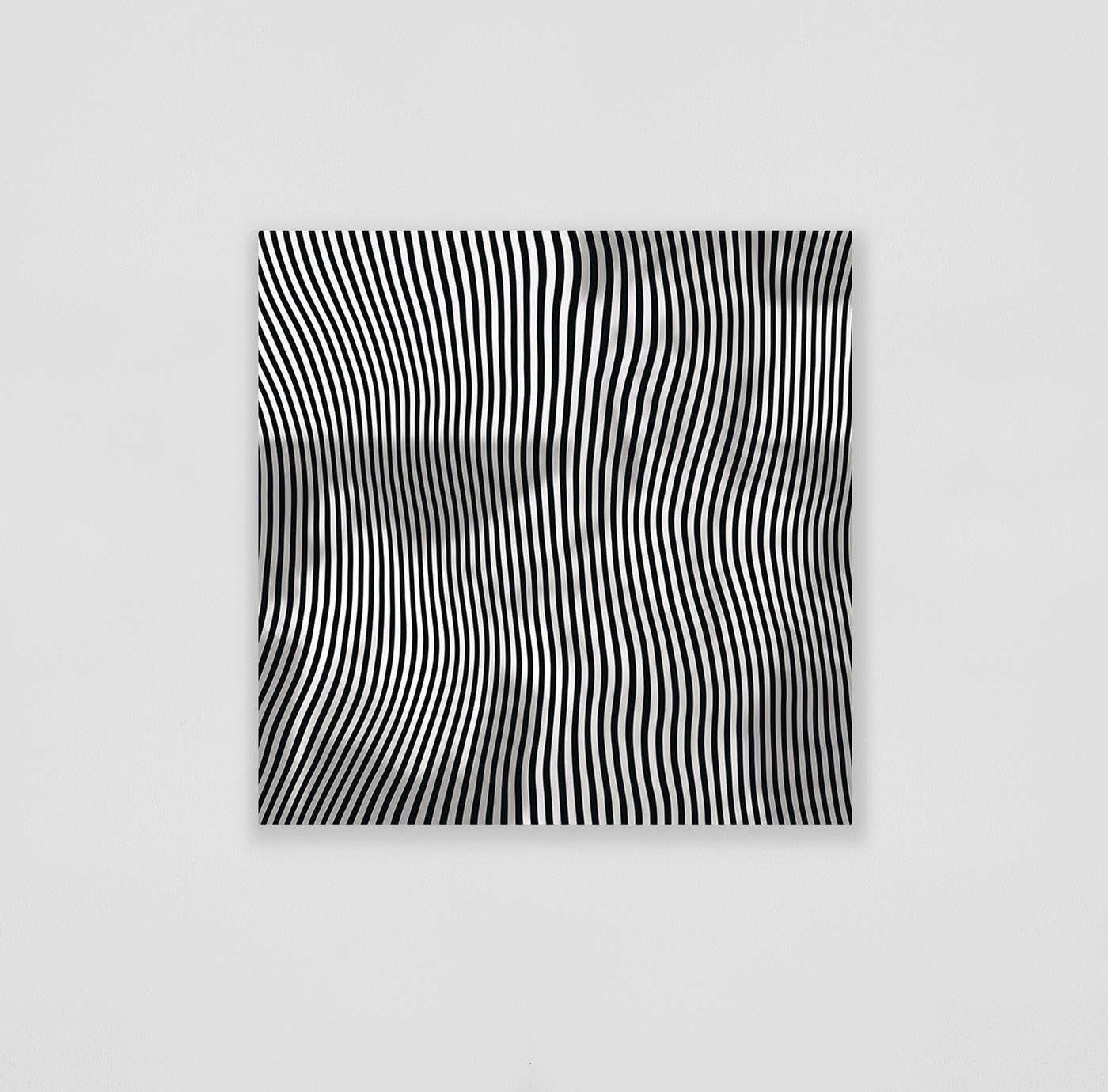
For Lazzarini, Tate was a central and tragic figure in a quintessential American story and transformative moment in our history. “The late ’60s mark the end of an innocence in this country,” he says, calling the brutality and senselessness—the “overkill”—of the Manson murders “a chilling punctuation” that concluded and called into question the entire free-love era. “Plus, there’s something completely random and irrational about her death. She was simply in the wrong place at the wrong time, which means that horror is potentially waiting for any of us.”
“Inflorescence” was so named as a nod to the process of flowering, meant to stand in stark contrast with the subject matter of Tate’s premature end. Appropriating images has long been part of Lazzarini’s process, even in his sculptures, so using archival photographs of Tate—from her pregnancy leading up to her demise—was paramount to creating the work. “I’ve always been interested in the idea that something could be itself and something else at the same time,” he says. “The challenge is to take something that has a mutually agreed-upon meaning and re-contextualize it anew.”
Through working with the images of Tate pregnant and happy, looking forward to the arrival of what would have been
her first child, Lazzarini confronted his own fears as well. He and his wife were expecting their firstborn at the time, facing the worries and uncertainties that come with being new parents. “As an older parent, I think I was bracing myself for a potential miscarriage,” he says. “It was definitely the thing I feared the most. Thankfully there were no problems, but I had a lot of anxiety about it. Being immersed in the events surrounding Tate and her baby’s murder didn’t help.”
Visually, “Inflorescence” explored the interplay between images and patterns and used op art methods to foil the stasis of two-dimensional works. The exhibition consisted primarily of multiple silk-screened paintings that presented photorealistic portraits of Tate overlaid with waving graphic lines. Lazzarini used this image–pattern conflict as a way to emphasize the limitations of vision. As the viewer approached the works, the figurative elements retreated and the patterning came to the fore, producing an optical grating e ect. Similarly, when the viewer’s vantage to the works changed, the lines of the paintings would appear to oscillate.
Suspended throughout the gallery space were ¾-inch, threestrand white nylon ropes—the type used to tie up Tate during her murder—adding another, more physically interactive layer
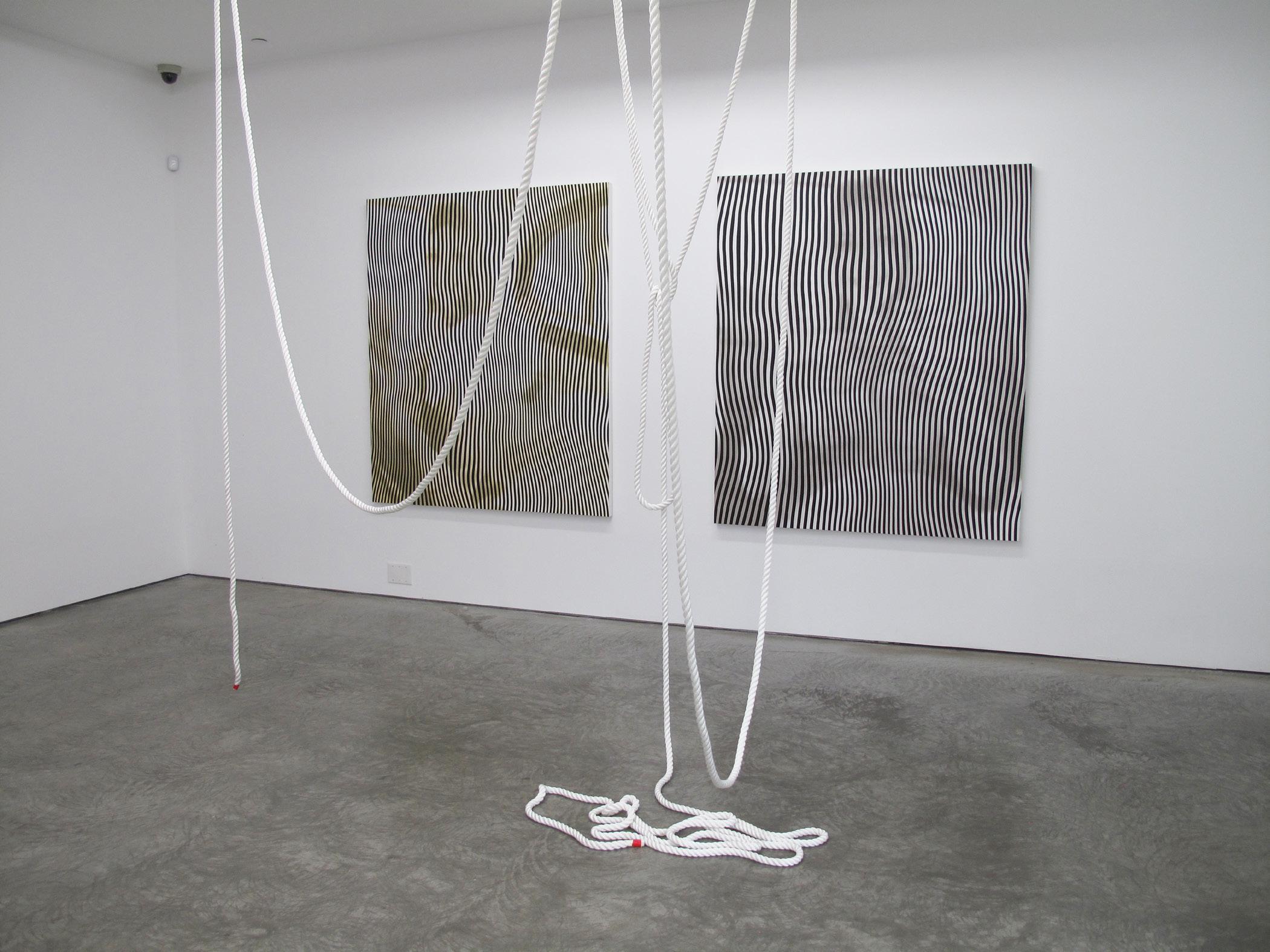
to the viewer’s experience, a grounding element to counter the disorienting and illusory e ects of Lazzarini’s paintings.
In addition to the paintings and ropes, the exhibition also included a sculpture, based on a circa-1960s Hollywood Regency gold-toned wall decoration of dogwood branches in bloom— the show’s lone true inflorescence, albeit a disturbingly altered one. “The sculpture is enlarged, out of scale and distorted to create a tangled oddity,” he says. “The idea was to conjure something from a home in that era.” Entitled creepy crawl, the work takes its name from the ritualized acts performed by the Manson family before the murders, wherein they would enter homes at night and rearrange their objects, and addresses the ragtag cult’s infringement upon the rarefied spaces belonging to the Hollywood elite.
When he first started work on “Inflorescence,” Lazzarini was attracted to the themes of violence and lost innocence in Tate’s story, but as he dug deeper, his feelings shifted—a change he partly attributes to the birth of his daughter. “Something strange happened,” he says. “It was never a problem before, but all of a sudden it became more di cult for me to see graphic violence. It was like a switch went o , a switch that attached me to things in a di erent way.”
Lazzarini’s work has been featured in numerous solo and group exhibitions domestically and internationally and is included in the permanent collections of the Whitney Museum of American Art, New York; Walker Art Center, Minneapolis; and the Carnegie Museum of Art, Pittsburgh; among others. For more information, visit robertlazzarini.com. ✣
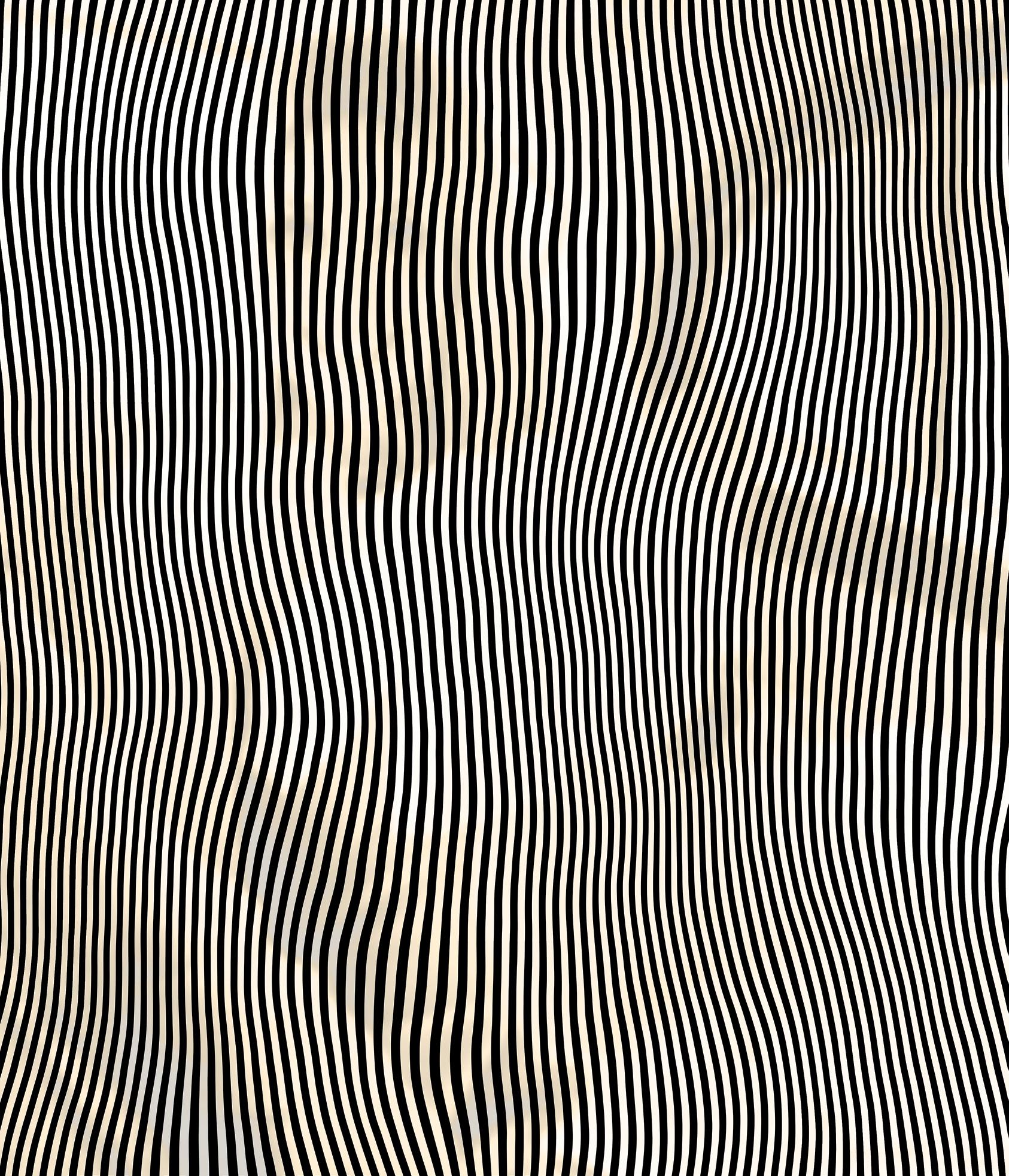
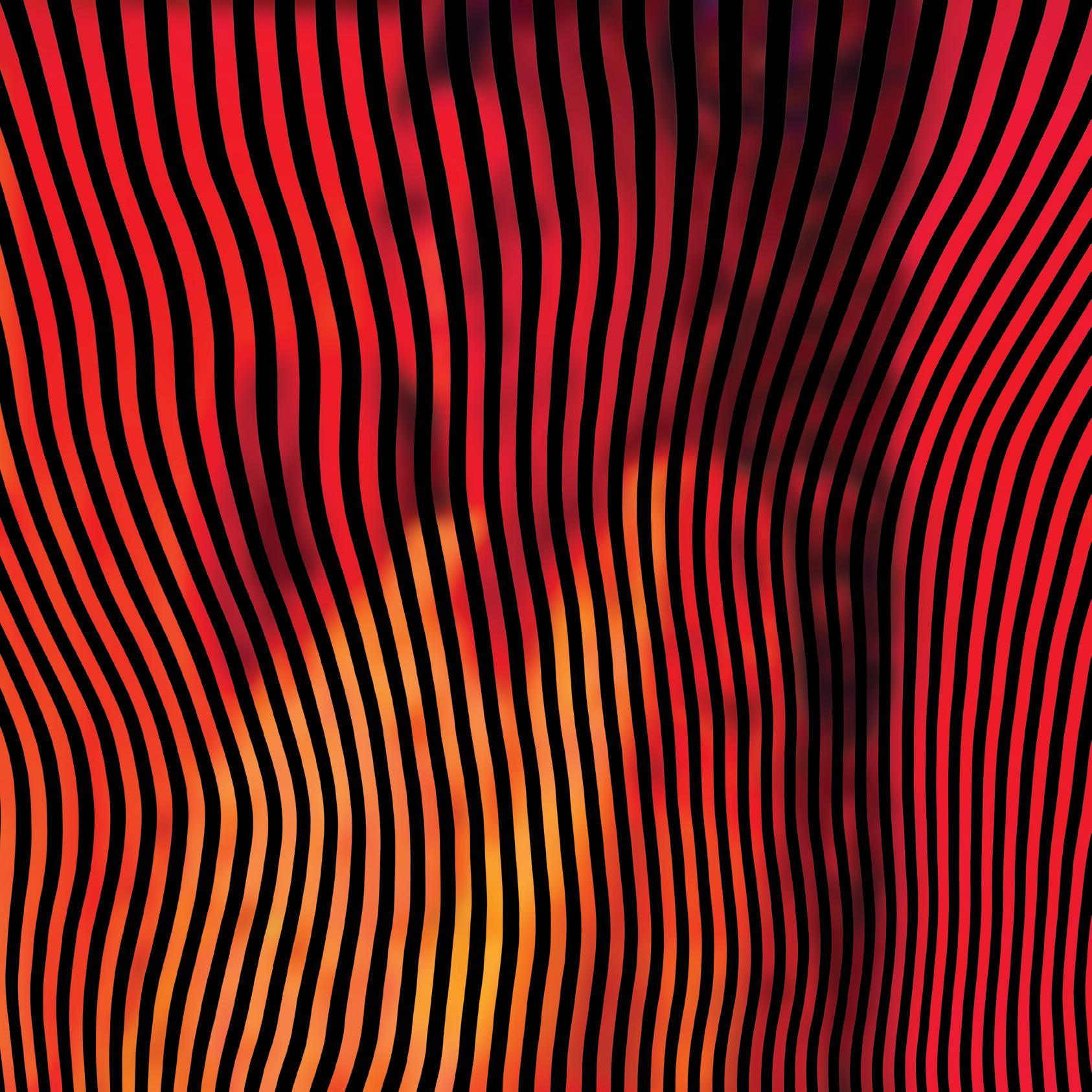
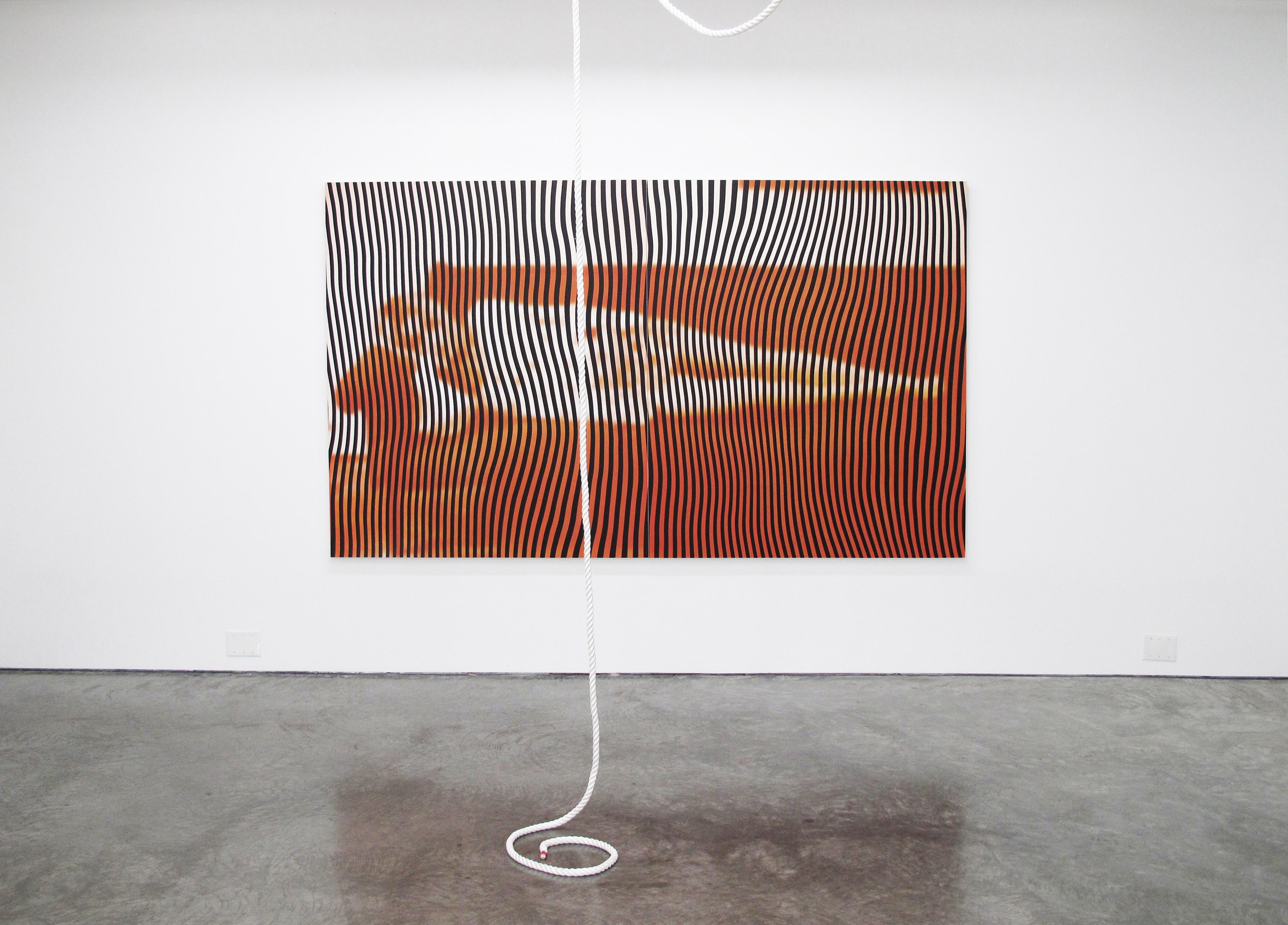

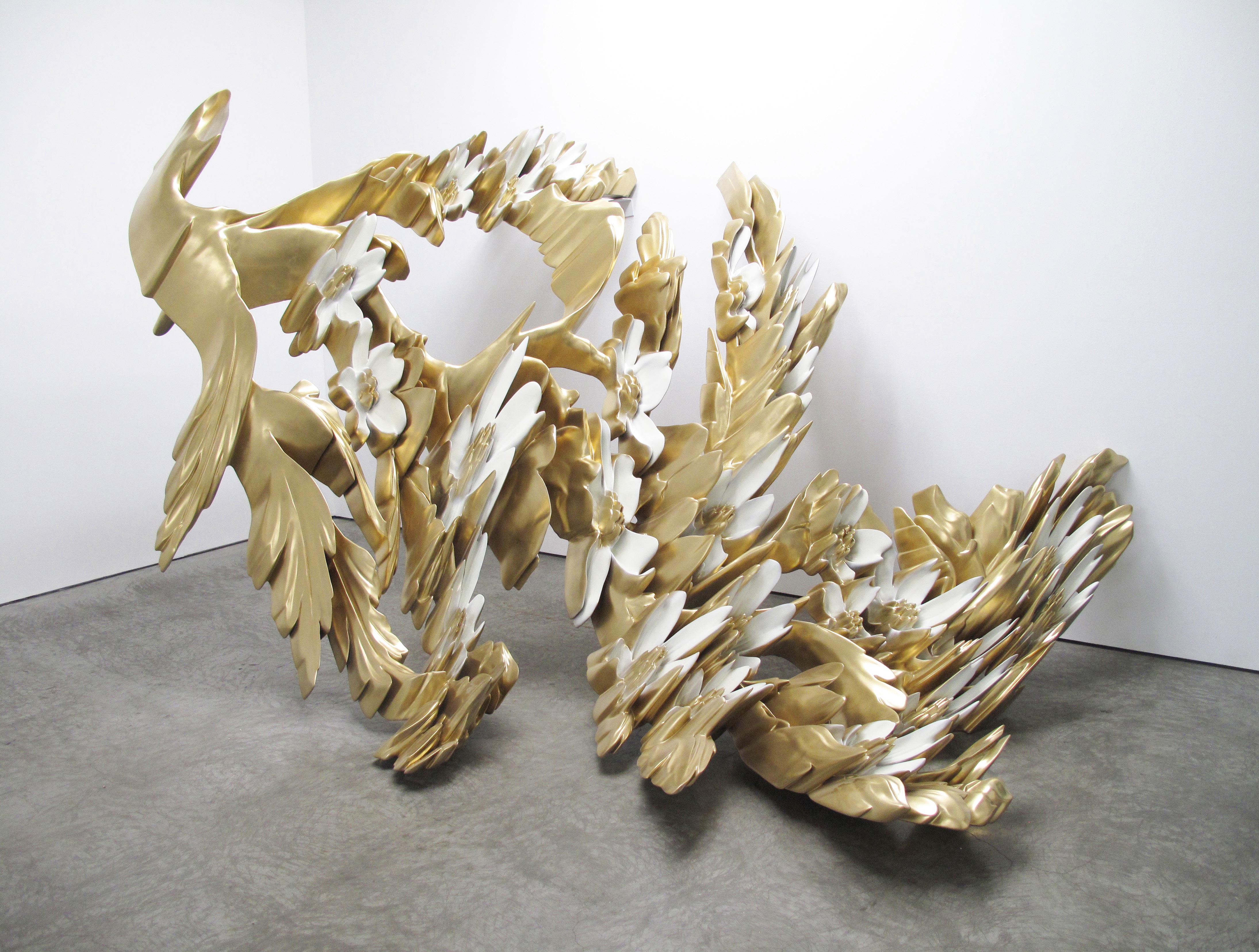

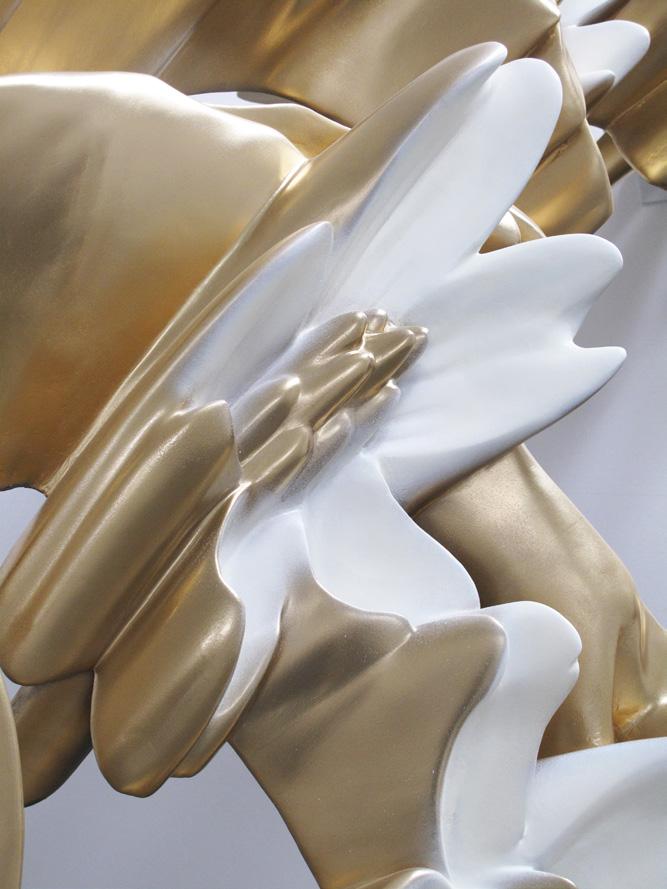
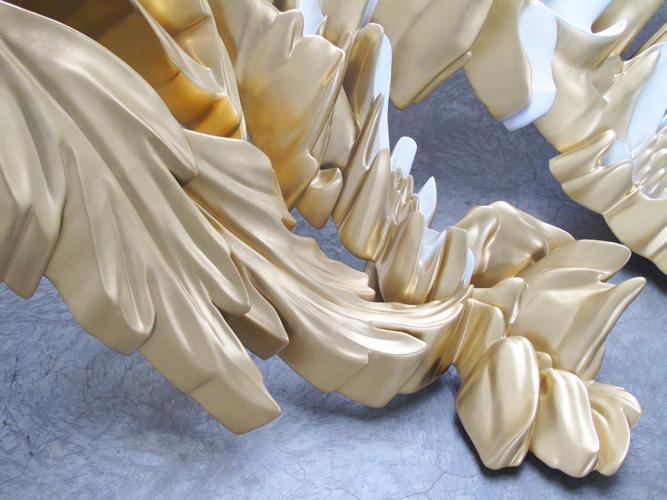
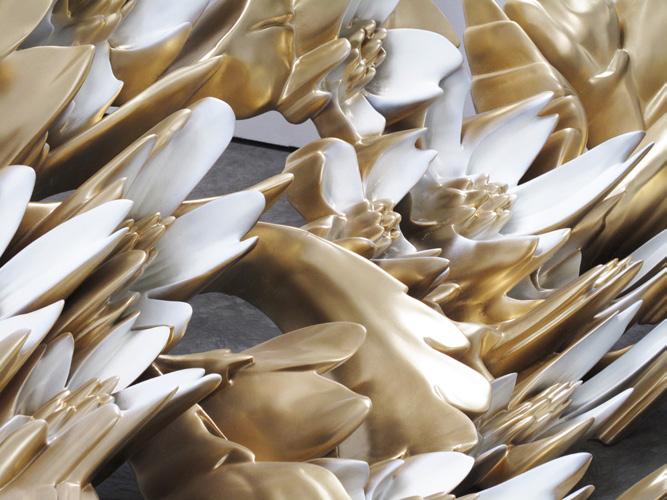
NERV NER
Meet
DON’T GET OUS! OU
E ROZ CHAST
the 2018 MASTERS SERIES Honoree
E OU
by Folake Ologunja and Greg Herbowy
mma Allen, the cartoon editor of The New Yorker, has a second- or thirdhand story about Roz Chast, one of the magazine’s most prolific and best known contributors. In 1978 Chast sold her fi rst work to The New Yorker, a surreal bit of humor called “Little Things.” Arrayed throughout the hand-drawn panel
are a series of nonsensical shapes, each labeled with an equally nonsensical name—a “redge,” a “sood,” a “spak.” It’s hard to imagine a gentler gag—and there was some precedent for this sort of absurdist, punchline-free humor in the magazine—but not everyone associated with The New Yorker was exactly won over right away.
NERV V OUS! S!

Not long after, Allen says, “an older cartoonist asked [then] art director Lee Lorenz if he owed Chast’s family money—so big was the scandal caused by such small things. By now, of course, it’s abundantly clear that the debt is all on our end.”
This fall, SVA will honor Chast with its 30th annual Masters Series award
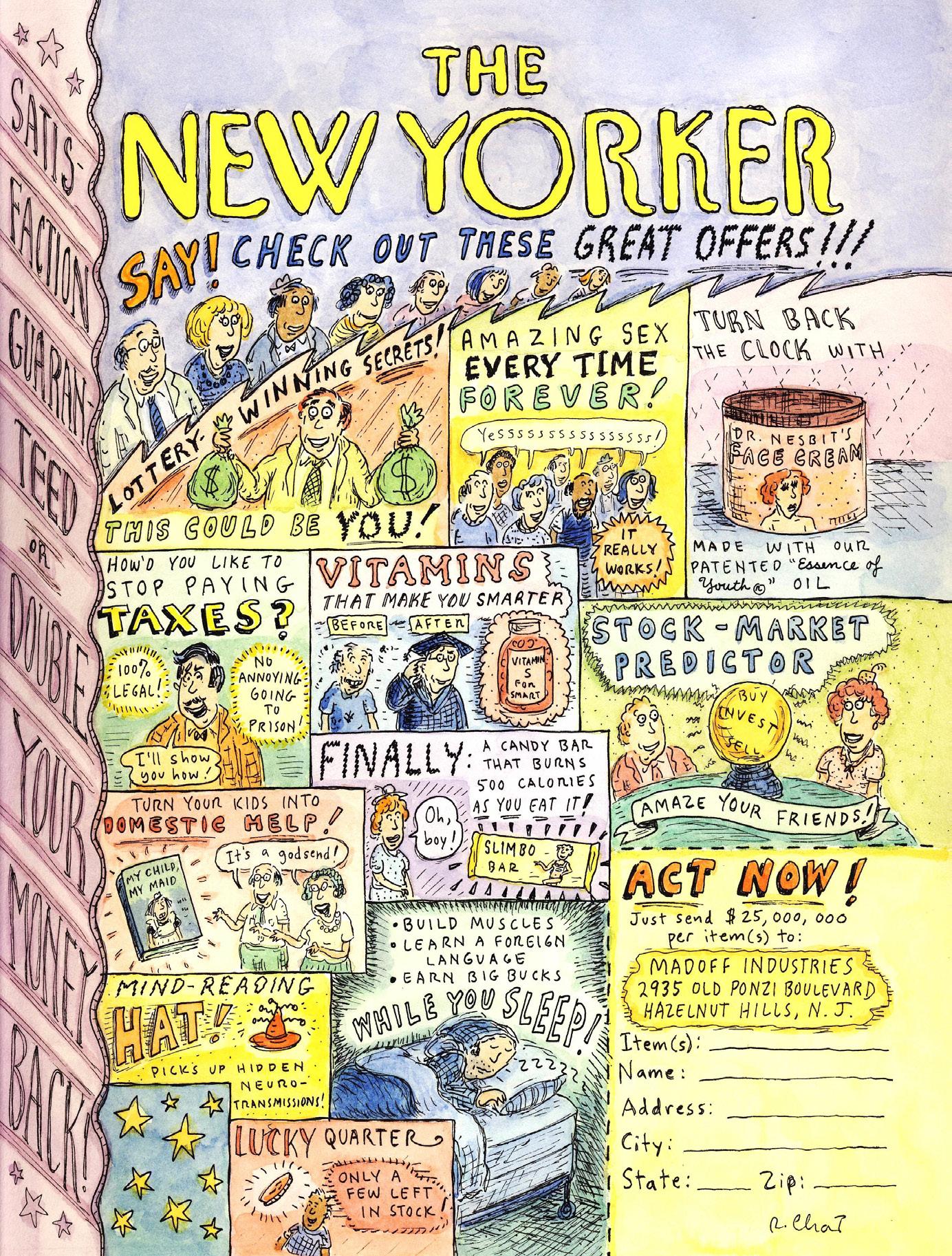
and exhibition. Created by SVA founder Silas H. Rhodes in 1988, the Masters Series celebrates the great, and often unheralded, visual communicators of our time. “The Masters Series: Roz Chast” will be a comprehensive retrospective of Chast's celebrated career and include her cartooning and illustration work, selections from her more than 20 books and a hand-drawn mural, as well as examples of her personal work, including notebooks Chast kept in high school, embroideries, hooked rugs and hand-dyed pysanky, or Ukrainian-style Easter eggs.
Chast’s work has appeared in numerous magazines through the years, including The Village Voice and National Lampoon, but she is most closely associated with The New Yorker. In addition
to her many cartoons and illustrated essays, she has created some 10 covers for the publication, and her nervous sense of humor and energetic style have become intrinsic to its identity. “Roz seems to have always been enamored of the hilariously jarring: the revolting food label, the o ensive get-well card, the nihilistic needlepoint pillow,” Allen says. “She has provided The New Yorker with an incredible trove of odd details and objects, as well as a cast of neurotic characters whose anxiety vibrates through the very lines with which they’re drawn.”
This anxiety is not a put-on. Chast once told an interviewer, “On every level I feel like anything horrible can happen at any moment”—this for an article to ostensibly promote Going Into Town: A
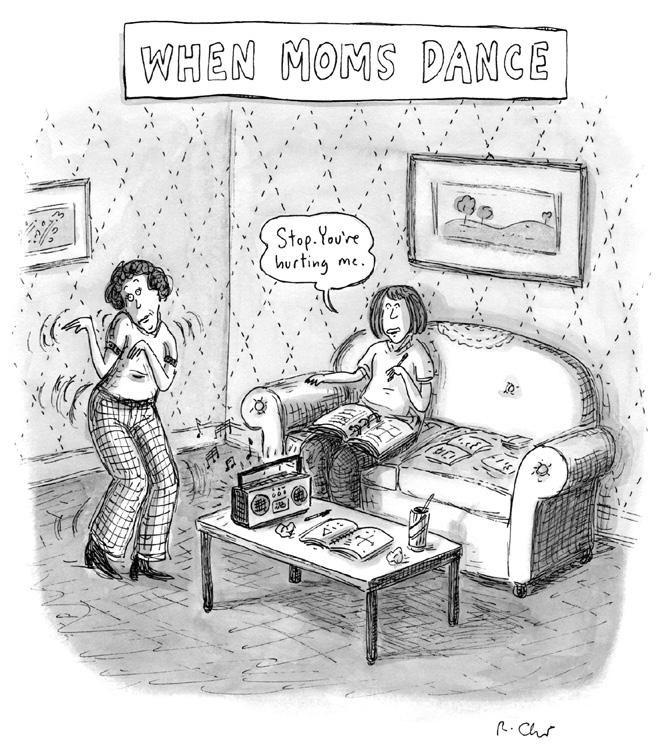
Love Letter to New York (2017), her personalized travel guide to New York City. Early in her career, this nervousness even found expression in the scale she worked in. “I used to work really tiny,” she says. “I thought if I worked small, nobody would mind me that much. If I take up as little space as possible, then everything will be okay, nobody will get mad at me.”
In addition to collections of her New Yorker work, Chast has written and illustrated a range of books, including the alphabetized inventory What I Hate: From A to Z (2011); children’s books like Around the Clock! (2015) and Too Busy Marco (2010); and collaborations with fellow New Yorker contributor Calvin Trillin (2016’s No Fair! No Fair! And Other Jolly Poems of Childhood) and songwriter Stephin Merritt (2014’s 101 Two-Letter Words). Her first memoir, Can’t We Talk About Something More Pleasant?, was published in 2014. An account of her relationship with her elderly parents in their final years, it went on to become a best seller and win a National Book Critics Circle Award (it was also shortlisted for a National Book Award).
Going Into Town, Chast’s latest, is lighter in tone and subject but still characteristically wry, taking detours to note
such odd, arguably unpleasant details of city life as slow buses and smears of gum on the sidewalk. It also has an SVA connection: It began its life several years ago as a going-away gift for her youngest child, who was leaving the family’s home in Connecticut to attend the College.
Chast is working on another New York–centric book, this one focused on the overlooked neighborhoods of her hometown of Brooklyn—places like Gravesend, Canarsie and Mill Basin. Though her past work evinces a complicated relationship with the borough—“I hated Brooklyn,” she writes in Can’t We Talk About Something More Pleasant?—she admits to a certain possessiveness regarding its lesser-hyped areas. “It bothers me when people talk about Brooklyn as if it’s synonymous with Williamsburg or Park Slope or Carroll Gardens,” she says. “It’s so much more diverse, so much bigger and more complex and interesting.”
After a self-described “unhappy” childhood in Flatbush—much of it spent alone making art and reading Mad magazine, the cartoons of Charles Addams and Ernie Bushmiller’s Nancy strip— Chast attended the Rhode Island School of Design, where she studied painting. After graduating in 1977 she returned to New York City, where she quickly
LEFT AND PREVIOUS PAGE Cartoons and a cover by Roz Chast for The New Yorker. Chast has been contributing to the magazine since 1978.
BELOW Going Into Town (2017), Chast's latest book, had its origins in a hand-drawn guide Chast made for her youngest child, who was moving to the city to attend SVA.
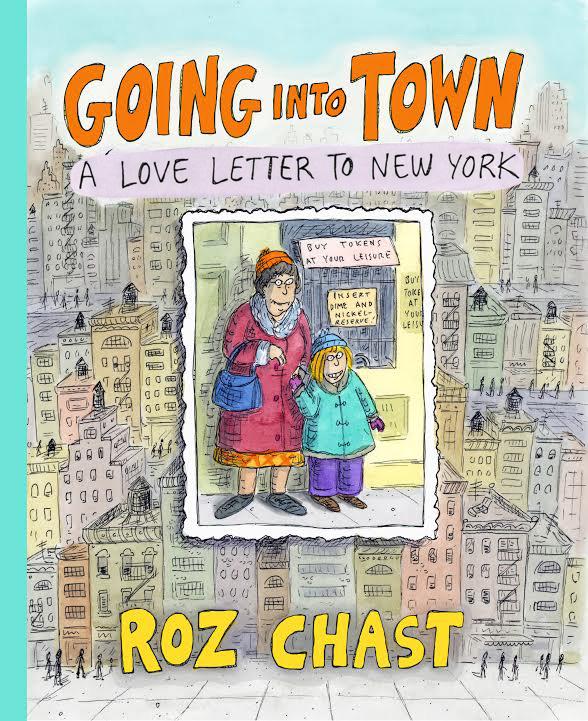
established her cartooning career. (She was first published in Christopher Street, a gay men’s magazine she discovered when she came across a left-behind copy on the subway.) Her distinctions include the Heinz Award for Arts and Humanities as well as honorary doctorates from Dartmouth College, Pratt Institute and Lesley University (formerly the Art Institute of Boston). In 2015 the Norman Rockwell Museum presented “Roz Chast: Cartoon Memoirs,” curated by the museum’s deputy director and chief curator Stephanie Plunkett (MFA 1990 Illustration as Visual Essay). The exhibition has since traveled to the Museum of the City of New York and the Contemporary Jewish Museum, in San Francisco. Plunkett and the Norman Rockwell Museum are partnering with SVA to present Chast’s Masters Series show; the Danese/Corey Gallery, which represents Chast, may also loan works.
“The Masters Series: Roz Chast” will be on view at the SVA Chelsea Gallery from Saturday, November 17, through Saturday, December 15, with a reception on Thursday, November 29, 6:00 –8:00pm. Chast will also give a talk on her work at the SVA Theatre on Wednesday, November 28, 7:00 – 9:00pm. All events are open to the public. ✰
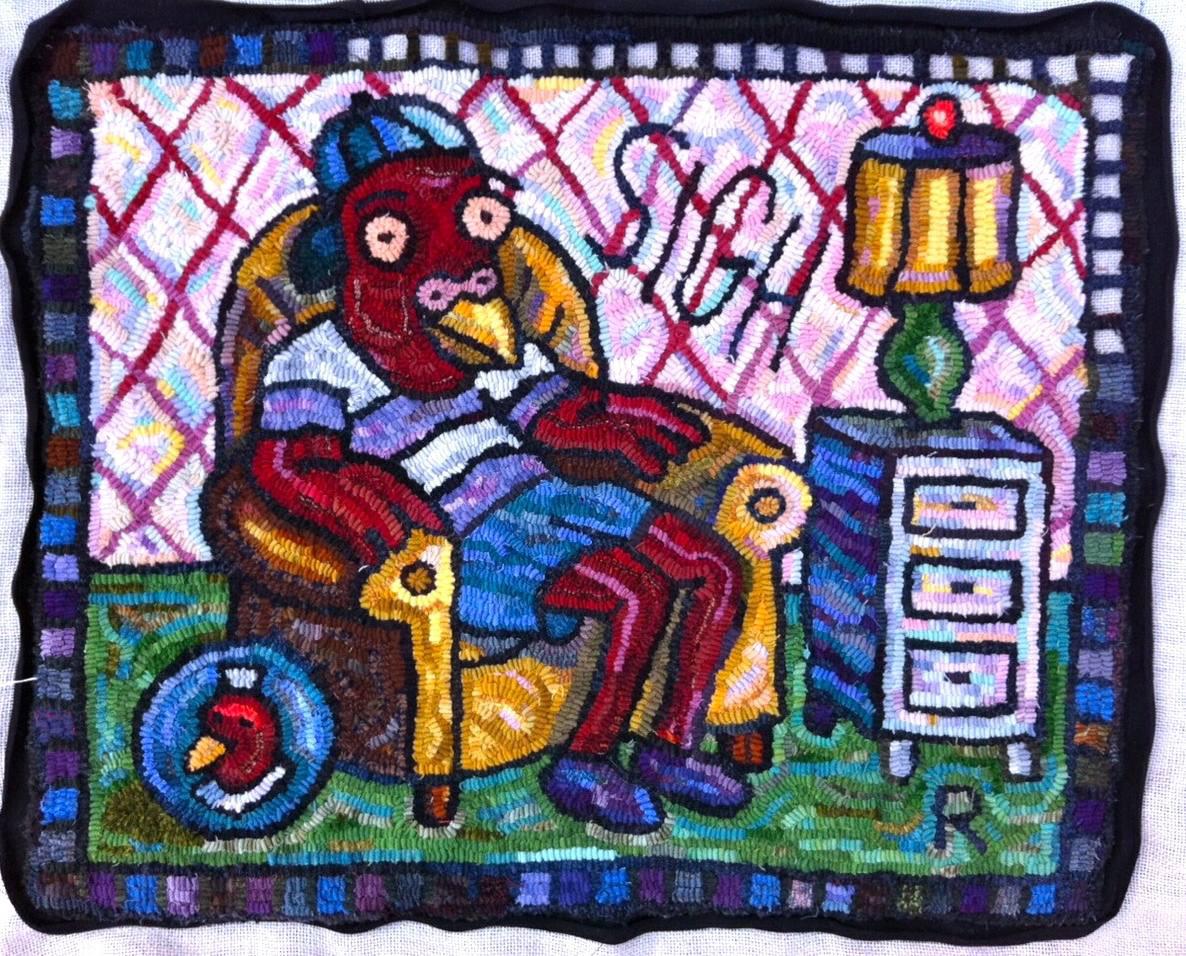
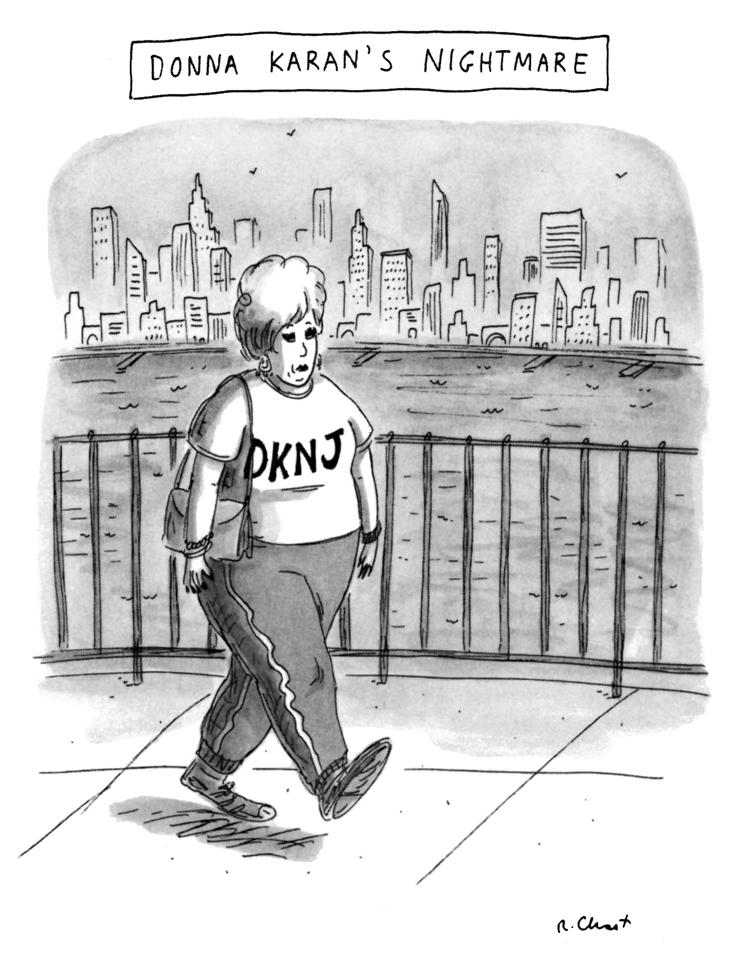
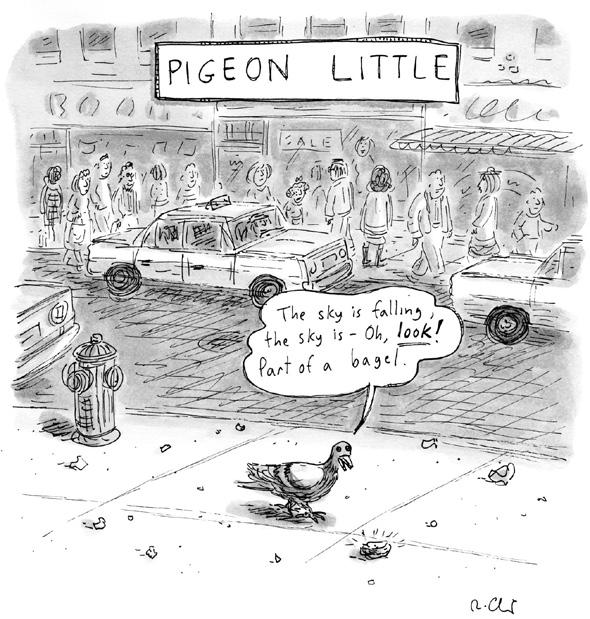
SPO T L I GHT
NEW ENGLAND
With Spotlight, Visual Arts Journal takes a closer look at the places where SVA alumni live, work and contribute to the local creative community. In this issue, we focus on the New England area, home to many SVA graduates, including the following six.
by Kristin L. Wolfe
SCOTT
BAKAL
BFA 1993
Illustration
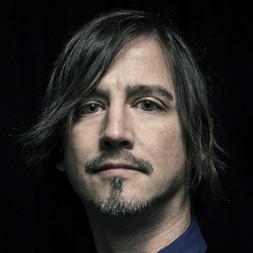
Both a job o er and a need to be closer to family brought Scott Bakal to Boston. Since 2009, after several years in New York City, the longtime illustrator has made his home in Boston, where in addition to his professional practice he teaches as an associate professor at Massachusetts College of Art and Design. “The great thing about living up here is my quality of life has changed dramatically,” he says. “In
terms of tangibles, I am able to a ord a larger living situation, and a bigger studio space to work in.”
Bakal’s résumé is stu ed with accomplishments: His clients include The Wall Street Journal and The New York Times; his work is in the permanent collection of the Norman Rockwell Museum and other institutions; and he counts among his honors multiple Society of Illustrators medals and awards. But he claims not to have really figured out what he wanted to do with his life until he arrived at SVA.
“I think the turning point of really understanding what it
meant to be an illustrator and the initial bang! that turned into my career was in Patti Bellantoni’s media course,” he says. “We had a guest, Lisa Desimini [BFA 1986 Media Arts], a children’s book author and illustrator. Through Lisa’s and Patti’s demos and instruction, I really fell in love with the discipline.”
Among the benefits of living in Boston, Bakal says, is the community of fellow artists he has met, who support and nurture one another’s work. “It’s a lovefest,” he says. “The art scene is vibrant and full. There’s no shortage of shows of all types to go and see, from art to
theater to music.”
But Bakal has plenty of his own activities keeping him busy, including frequent travel for client meetings and talks at schools, universities and professional gatherings. He has also begun pursuing a new medium, putting together a photography portfolio and submitting work to competitions. “I don’t know what I’m doing with it yet,” he says, “but I have the need to constantly explore di erent ways of creating.”
OPPOSITE
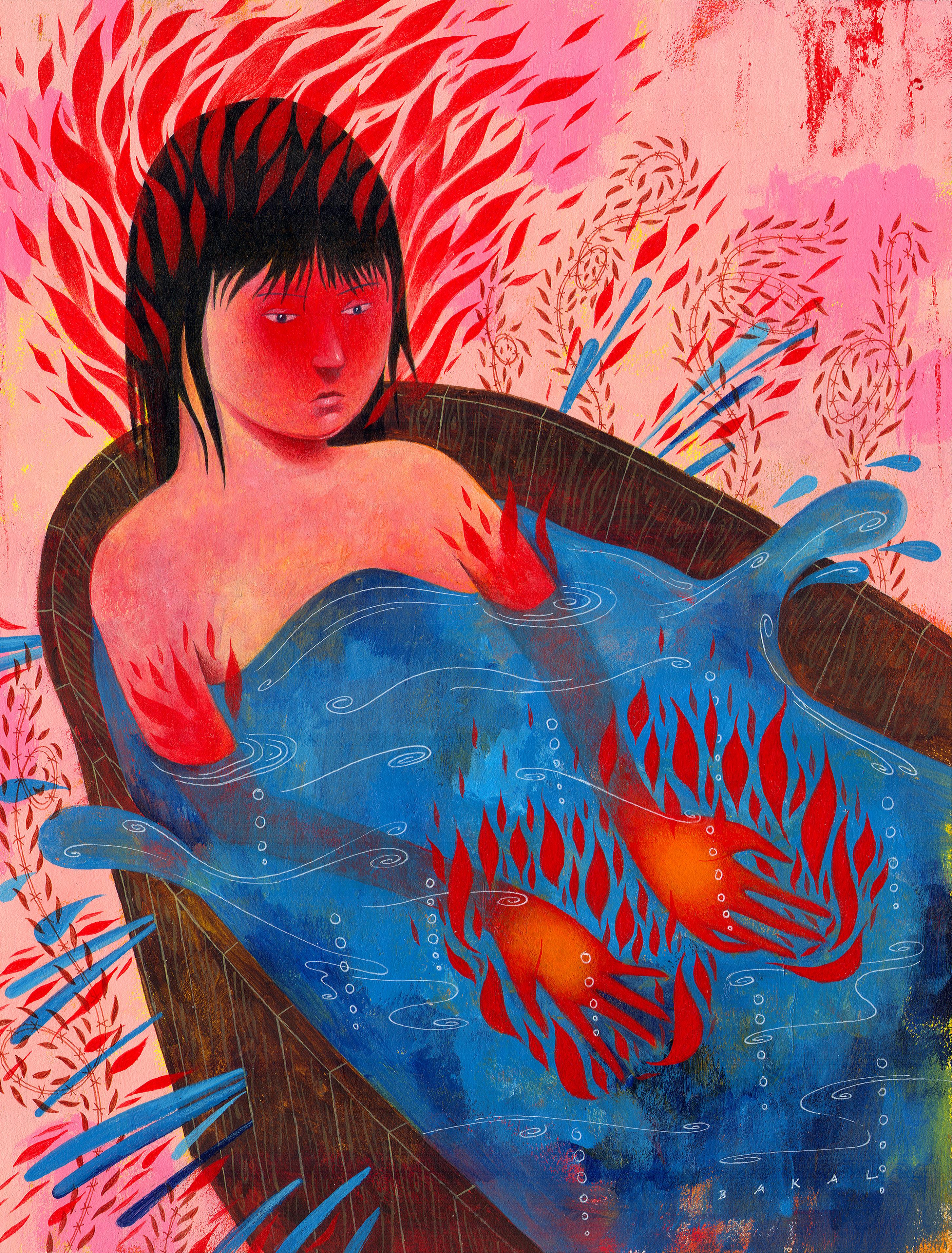
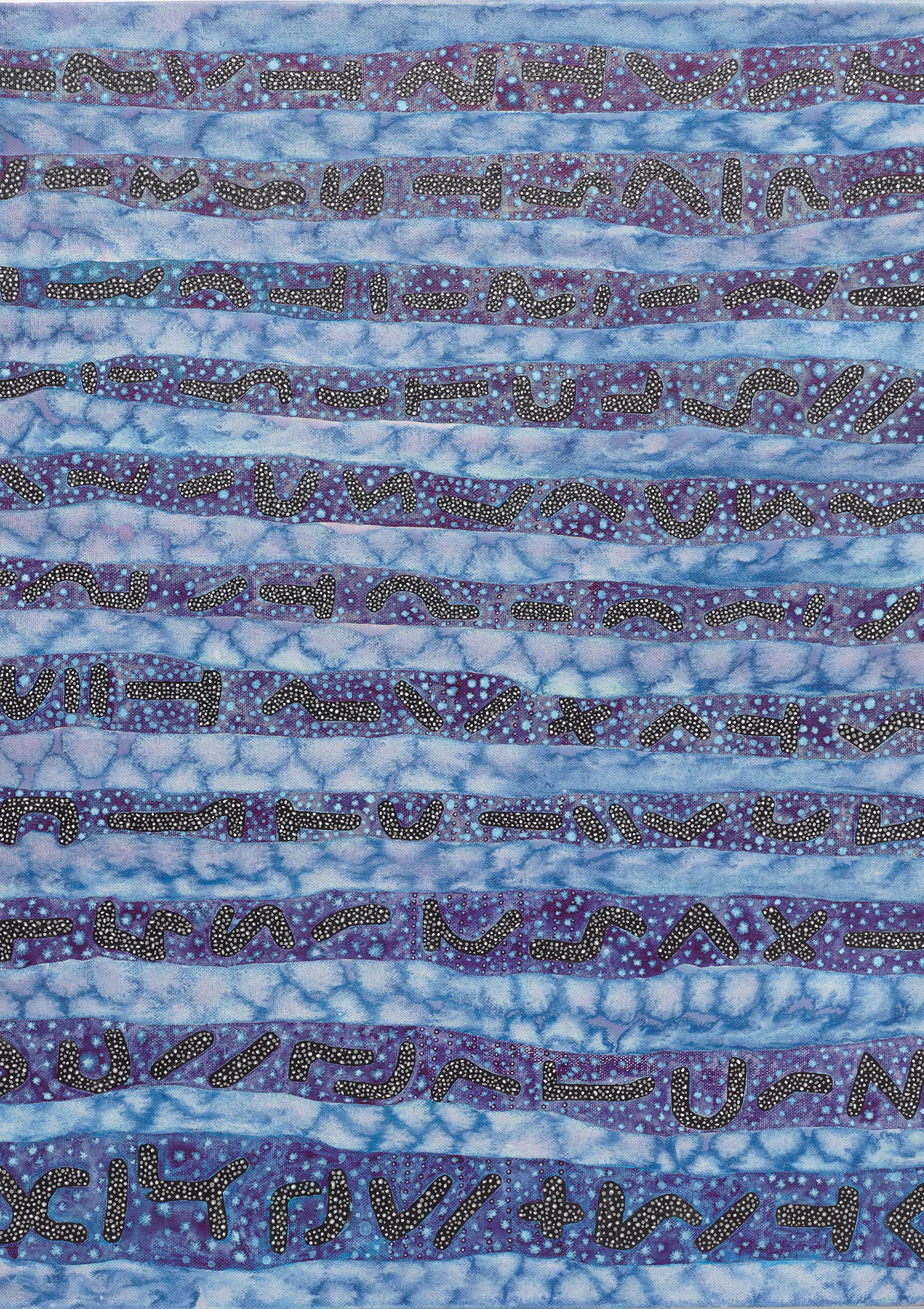
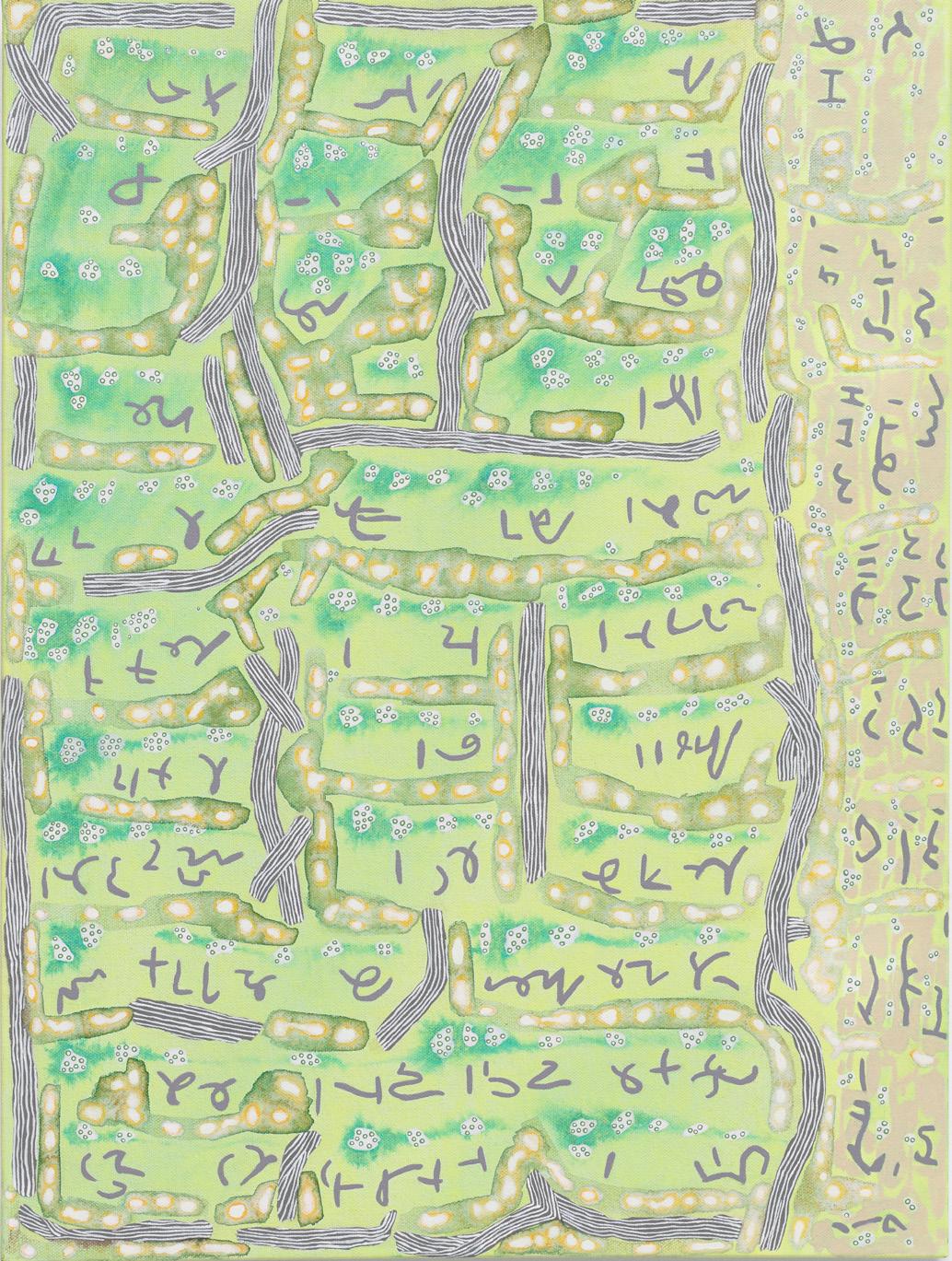
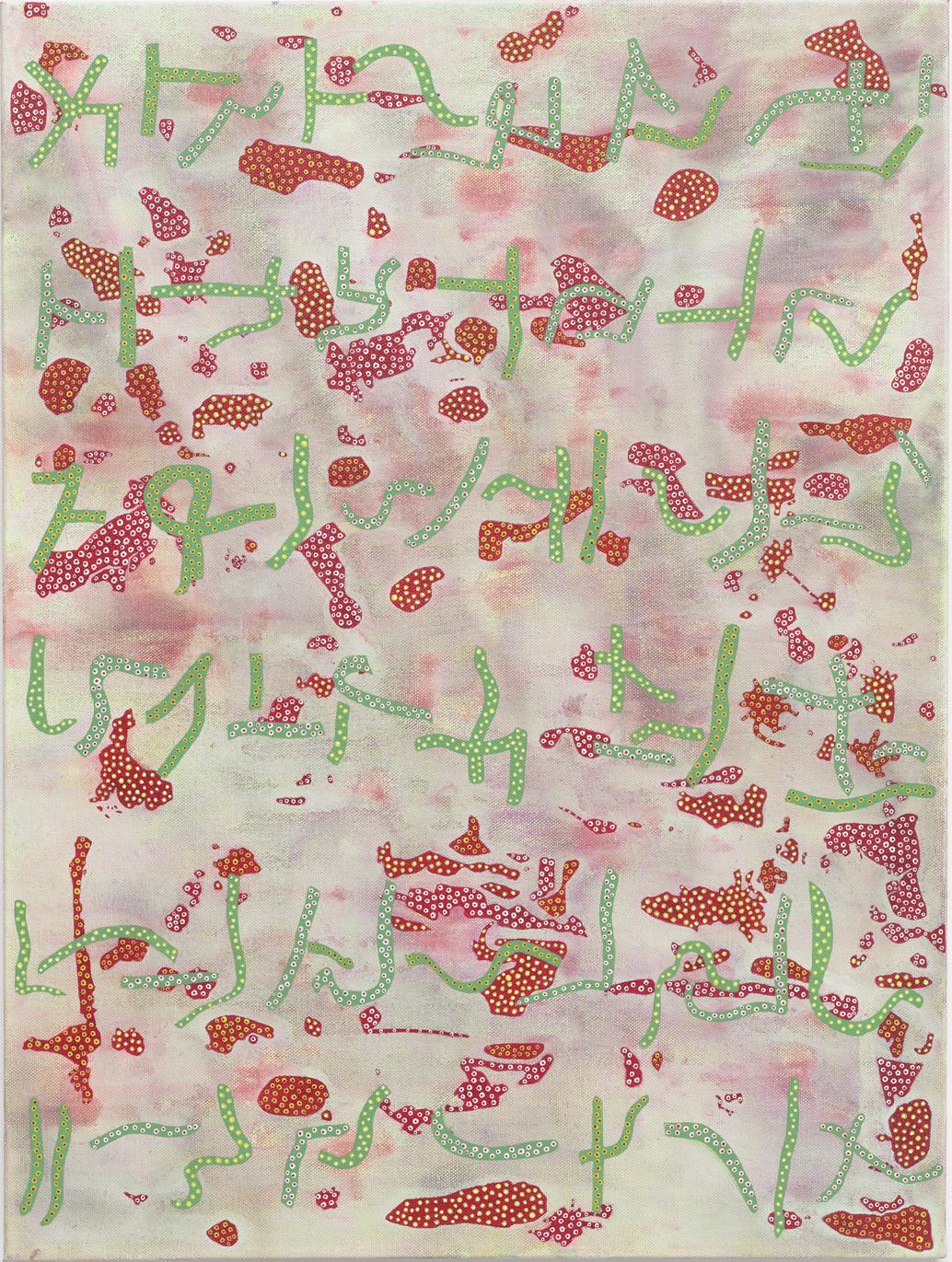
NADIA HAJI OMAR
MFA 2014
Fine Arts

Artist Nadia Haji Omar’s canvases are bright and complex, and enhanced by her experimentation with dyes, inks and acrylics.
Looking at the works for her second solo show at Kristen Lorello Gallery in Manhattan, on view through May 25, one cannot help but try to decipher their patterns or visual language, not to mention their inspiration.
Omar currently lives and works in Warren, a small town in Rhode Island not far from Providence’s thriving arts scene. She moved there from New York City in 2016 with her boyfriend, who is also an artist and now an instructor at the Rhode Island School of Design. The relocation was, in part, inspired by a desire to be away from the city’s grind and closer to nature. But, she
admits, “I’m still not fully committed to not being in New York. It’s as if I’m treating my time in Rhode Island like a residency.”
As with a residency, Omar has made the most of her time in Warren thus far.
“There is less of the frantic energy and pace here as in New York. And a special combination of a slower pace, space and time to create, thus, the possibility to engage on a deeper level.”
Freed from New York City’s ever-climbing cost of living, she has dedicated herself to painting full time.
Lately, in addition to finishing the works for her current show, she created a large-scale work for Providence College’s annual mural commission, “On the Wall.” Inspired in part by the art and poetry accumulated over many centuries on the walls of Sigiriya, an ancient fortress in central Sri Lanka, Omar’s multi-panel piece is on view through July in the campus’s Reilly Gallery.
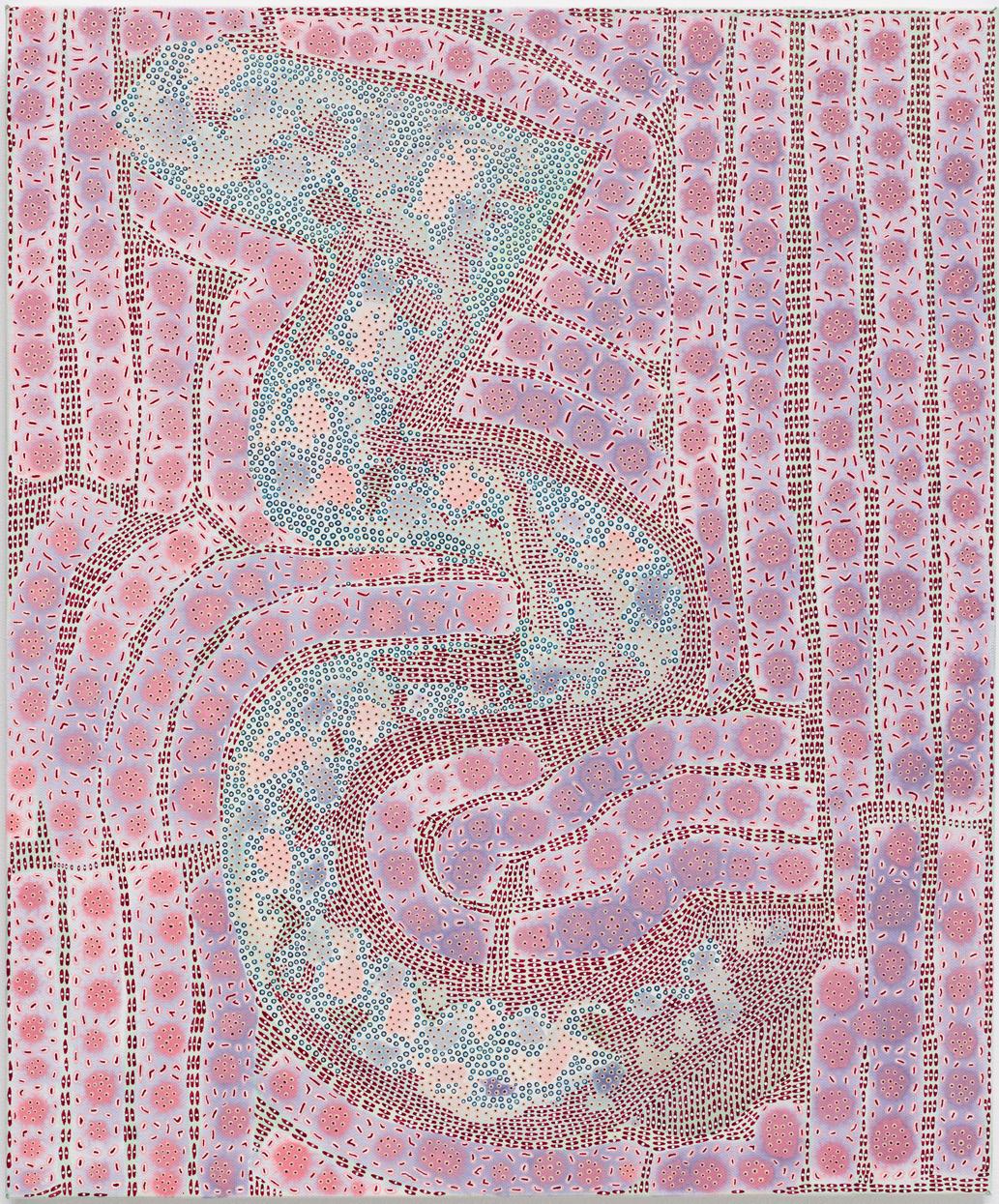
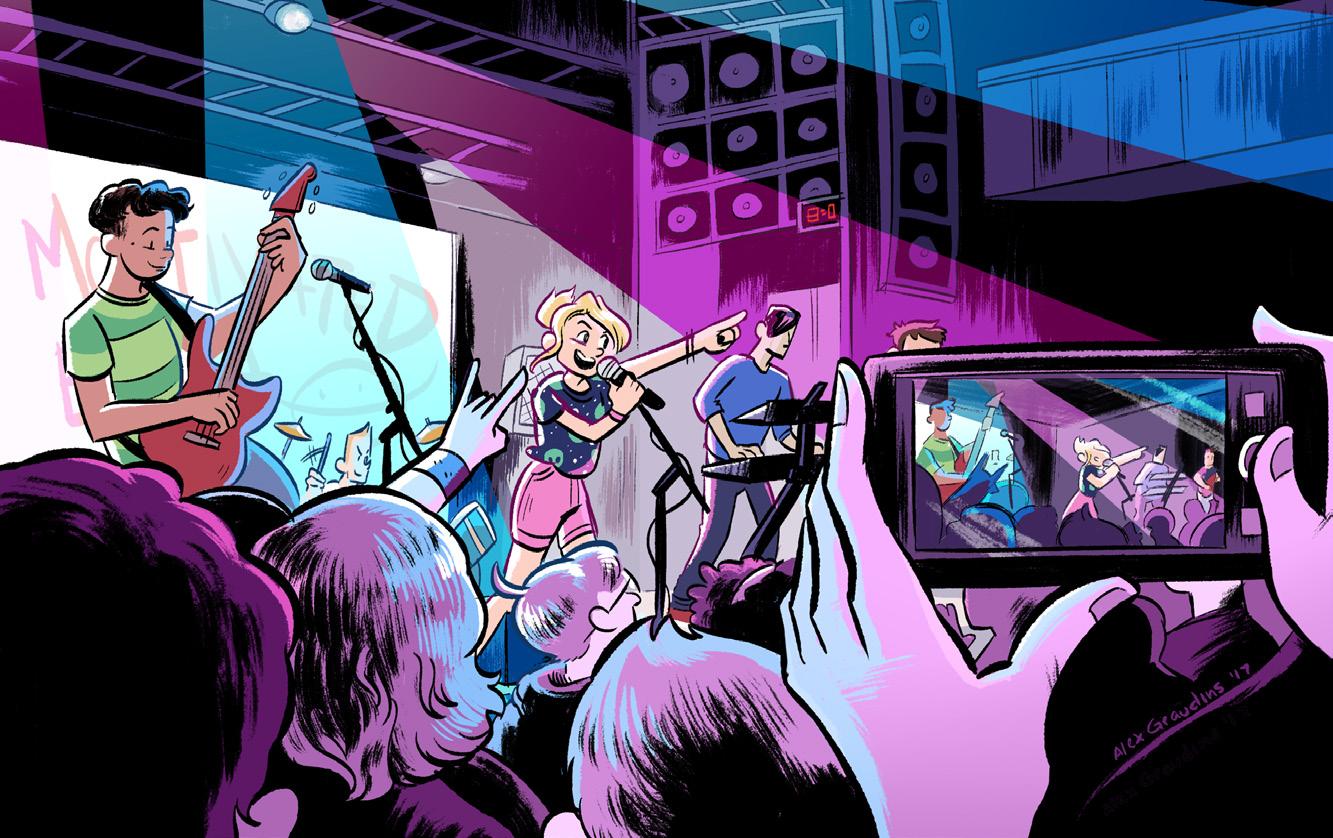
ALEX
GRAUDINS
BFA 2016
Cartooning
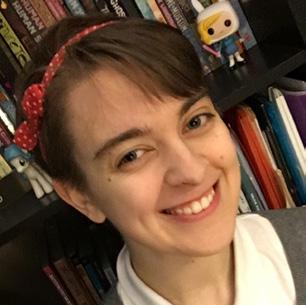
Cartoonist Alex Graudins knows how to write a thank-you letter. Moved by her experience at the acclaimed Broadway production of Dear Evan Hansen, which she saw while she was an SVA student, she made an eight-page comic about why the play was so special to her, then waited around the theater until a guard agreed to pass it on to someone backstage. Whoever got it knew that it was no ordinary fan letter: One of the illustrations from the work can be seen in Dear Evan Hansen: Through the Window, a co ee-table book about the play that was published last fall.
Just two years out of school, Graudins—who now lives with her family in South Kingstown, Rhode Island, a popular summer beach town—has a number of projects on the shelves and in the works. She’s contributed stories to the three latest volumes of Dirty Diamonds, a serialized anthology of work by women cartoonists edited and published by artists Claire Folkman and Kelly Phillips, as well as the second volume of Sweaty Palms, an anthology of autobiographical comics about anxiety produced by SVA alumnus
Liz Enright (MFA 2017 Visual Narrative). Most recently, she has illustrated her first book, Science Comics: The Brain, the latest installment in Macmillan’s educational series aimed at readers ages 9 to 13. Written by another SVA alumnus, Tory Woollcott (BFA 2016 Cartooning), it will be released under the publisher’s First Second imprint in October.
A Massachusetts native, Graudin says she “was already pretty comfortable with the New England lifestyle,” she says, where things are quieter and more laid back than in New York City. In addition to taking advantage of the abundance of outdoor recreation areas like bike paths and beaches, she has challenged herself to do amateur improv at a local theater, a di erent version of storytelling that has helped fuel her work.
With so much of her life and career ahead of her, Graudins can’t say whether she’ll be a New Englander for keeps. But for now she’s making the most of her home, the stories she finds in her midst and, she says, “being able to see more than one tree.”
ON THIS SPREAD, CLOCKWISE FROM TOP Alex Graudins, personal illustration, 2017; cover for TV Head: Dancing Around the Subject, 2017, zine; illustration for The Adventure Zine, 2016, zine; illustration for Leslie Toff's graphic novel When the Rules Aren't Right (Bardo, 2016); illustration for Practice Makes Perfect, 2017, zine.
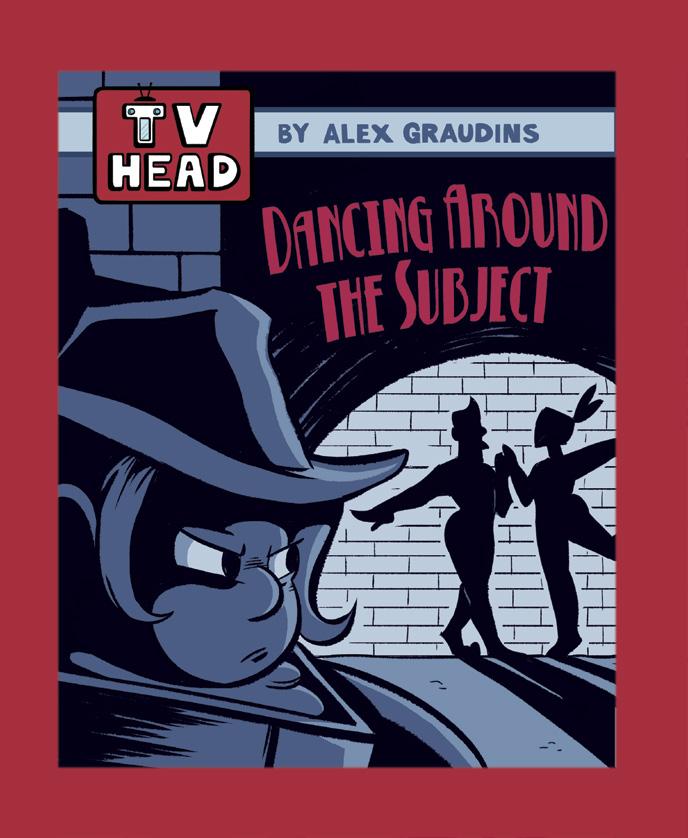
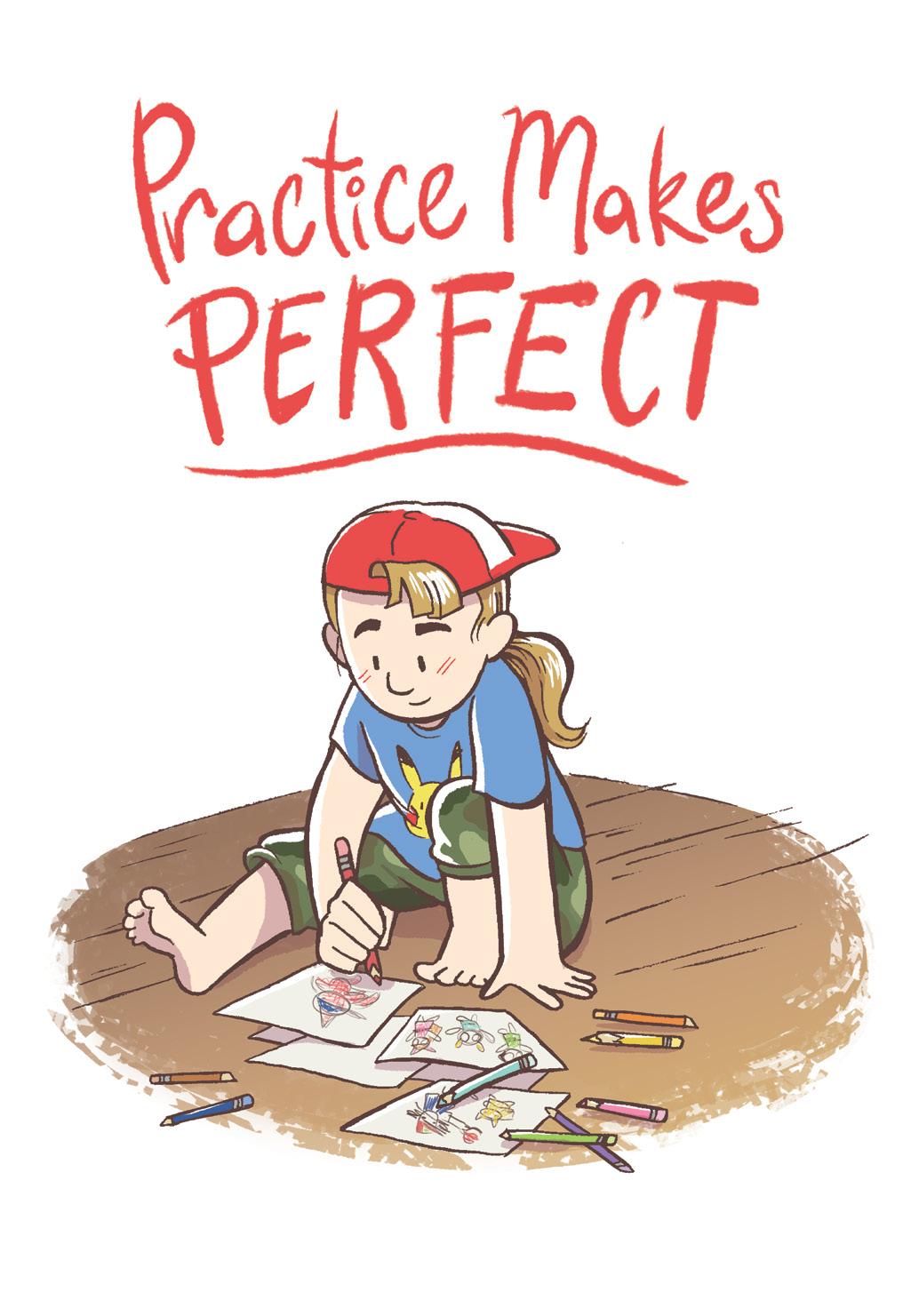

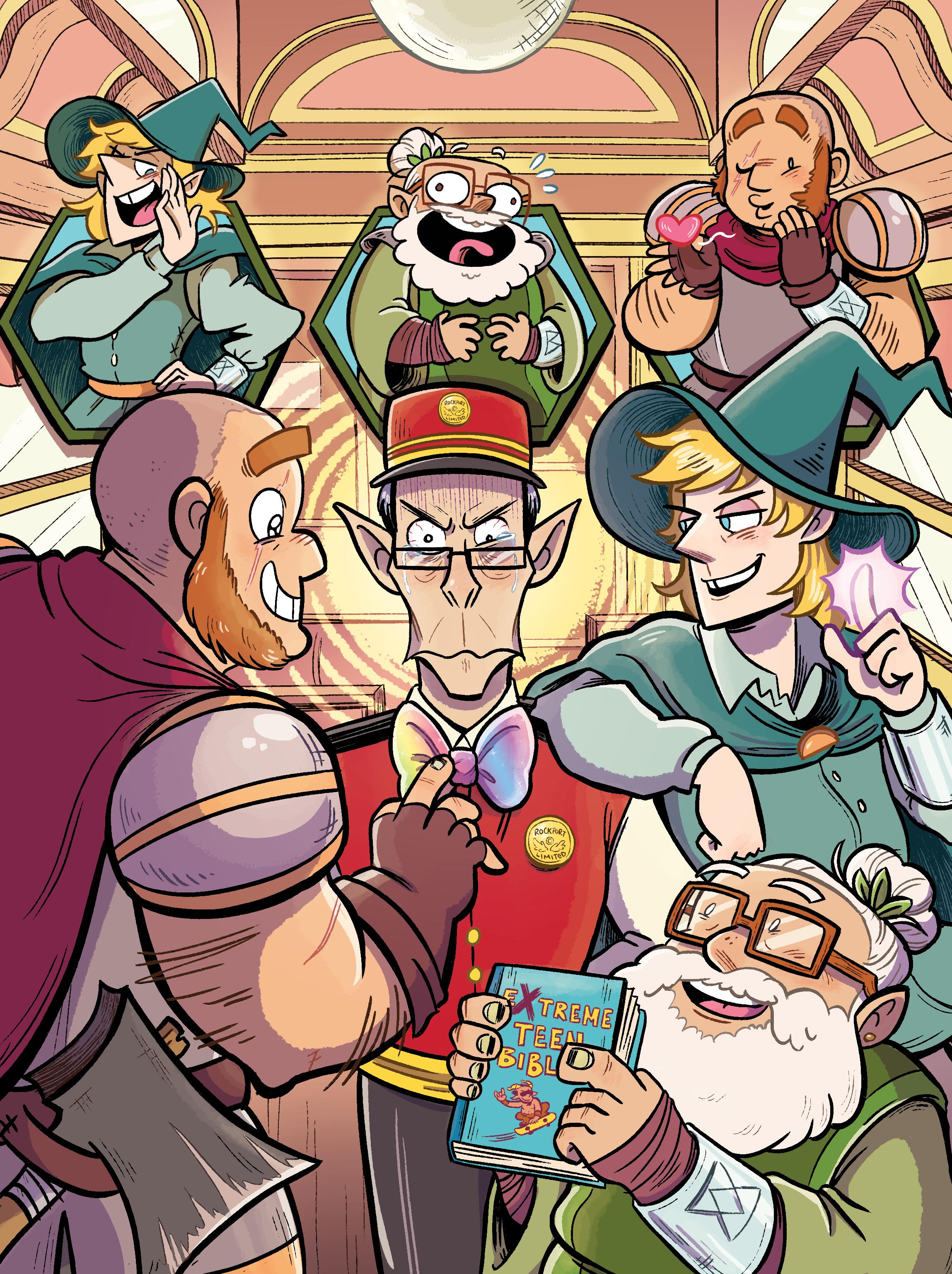
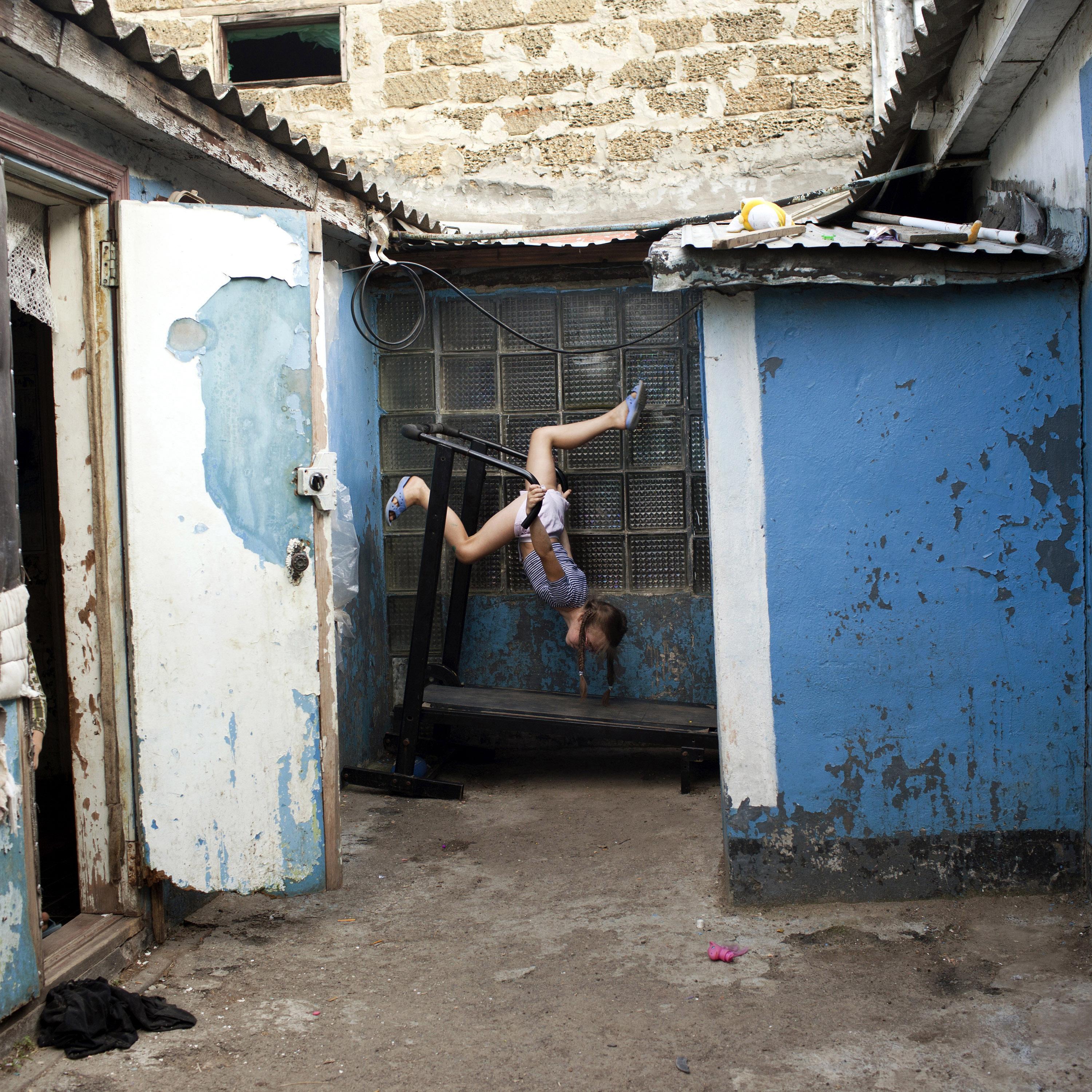

JOSEPH SYWENKYJ
BFA 2002 Photography
Striking” is an understatement when describing the prolific work of roving photojournalist Joseph Sywenkyj. Though he calls rural central New Hampshire home, in reality Sywenkyj spends the bulk of his year traveling throughout Central and East-
ern Europe, Asia and Africa, working for publications like National Geographic and The New Yorker or pursuing his own personal projects, supported in part by grants like the W. Eugene Smith Grant in Humanistic Photography, which he received in 2014.
As a Fulbright scholar to Ukraine from 2014 to 2016, Sywenkyj spent his time researching and documenting his family’s roots, as well as photographing soldiers and activists badly wounded from the ongoing—and underreported—conflicts in the
region. His work for the latter project, called “Wounds,” has been featured in two solo exhibitions in Ukraine to date. Since then he has considered the country a second home; for much of the year, he is based in Kiev.
Swenkyj grew up in Connecticut, and his family relocated to New Hampshire while he was a student at SVA. Despite his demanding travel schedule, he returns to the state whenever he can to spend time with his young children and recharge. His work's often-grim subject
matter can be taxing, physically and emotionally: “It can wear away at you after a while,” he says. “Spending time in the White Mountains surrounded by nature and family is important to keep things balanced.”
ABOVE Masha, an 11-year-old girl, plays in the small courtyard of her home in Odessa, Ukraine, 2012. Photograph by Joseph Sywenkyj as part of his “Verses: Family” project. Sywenkyj splits his time between New Hampshire and Ukraine.
JAMES STURM
MFA 1991
Illustration as Visual Essay

With a CV as long and varied as it is distinguished, James Sturm is a force in all things cartooning. Since graduating from SVA, he’s made his mark from coast to coast, from co-founding the influential Seattle alt-weekly The Stranger in 1991 to co-founding the
Center for Cartoon Studies, a school in White River Junction, Vermont, that o ers workshops, certificate programs and a two-year MFA degree, in 2005. Today, in addition to his active cartooning career—his next graphic novel, O Season, will be published by Drawn and Quarterly this fall—Sturm serves as the center’s director and is an active faculty member.
Why did he settle in Vermont? “You can hear yourself think,” Sturm says. “Vermont
has a surprisingly large number of artists—many who have made a deliberate lifestyle decision to move here. Like a lot of artists, I live inside my head for long periods of time and can lose perspective. Vermont restores that perspective with its intense seasons, tight community and natural beauty.”
Having now spent over a decade in and around White River Junction, Sturm has no plans to leave the area any time soon. “Living in
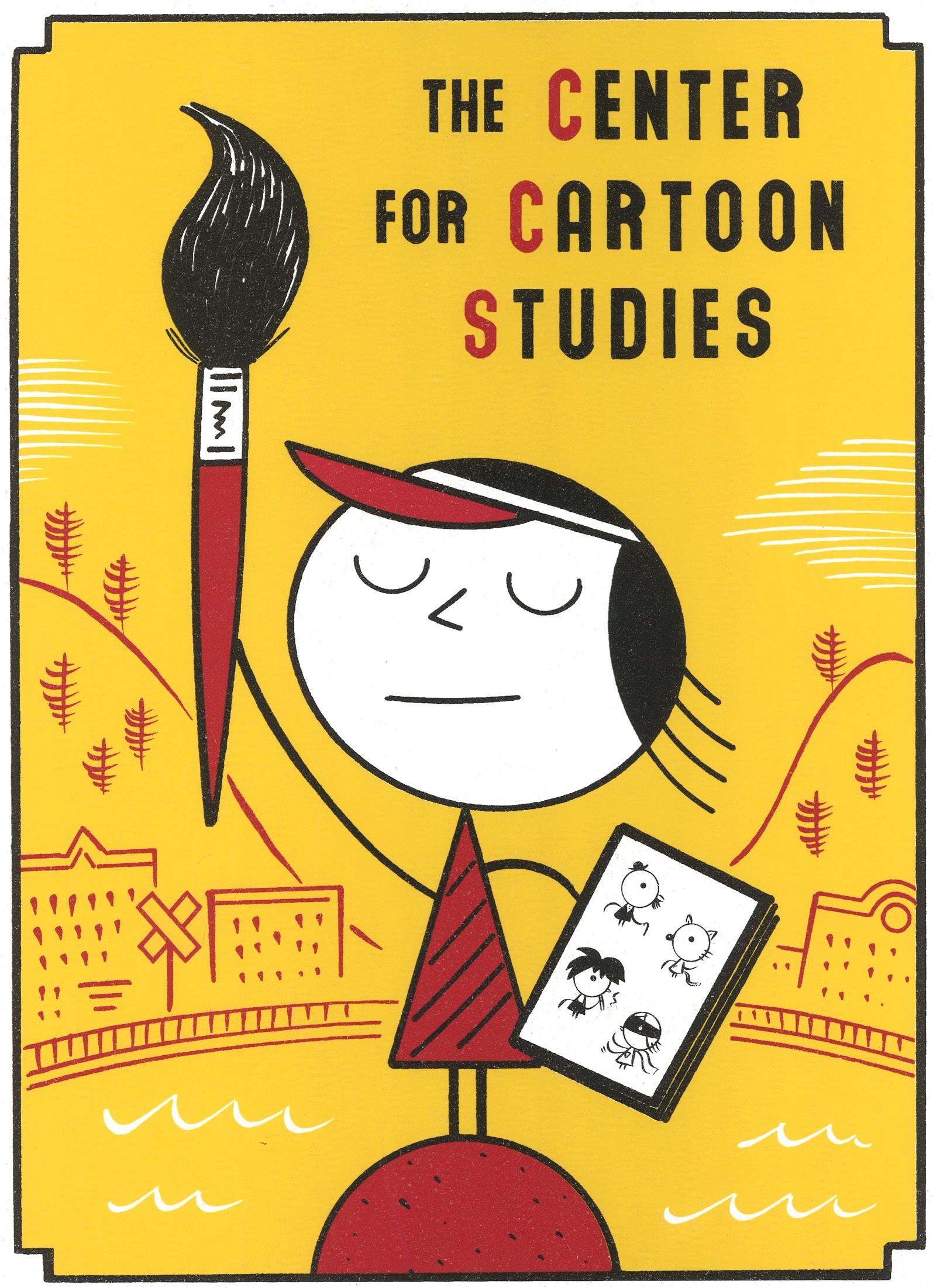
such a small town, you can really foster and deepen a sense of community,” he says. “In a place like New York, combating distraction is a huge concern. Here, you can focus and take your work to another level.”
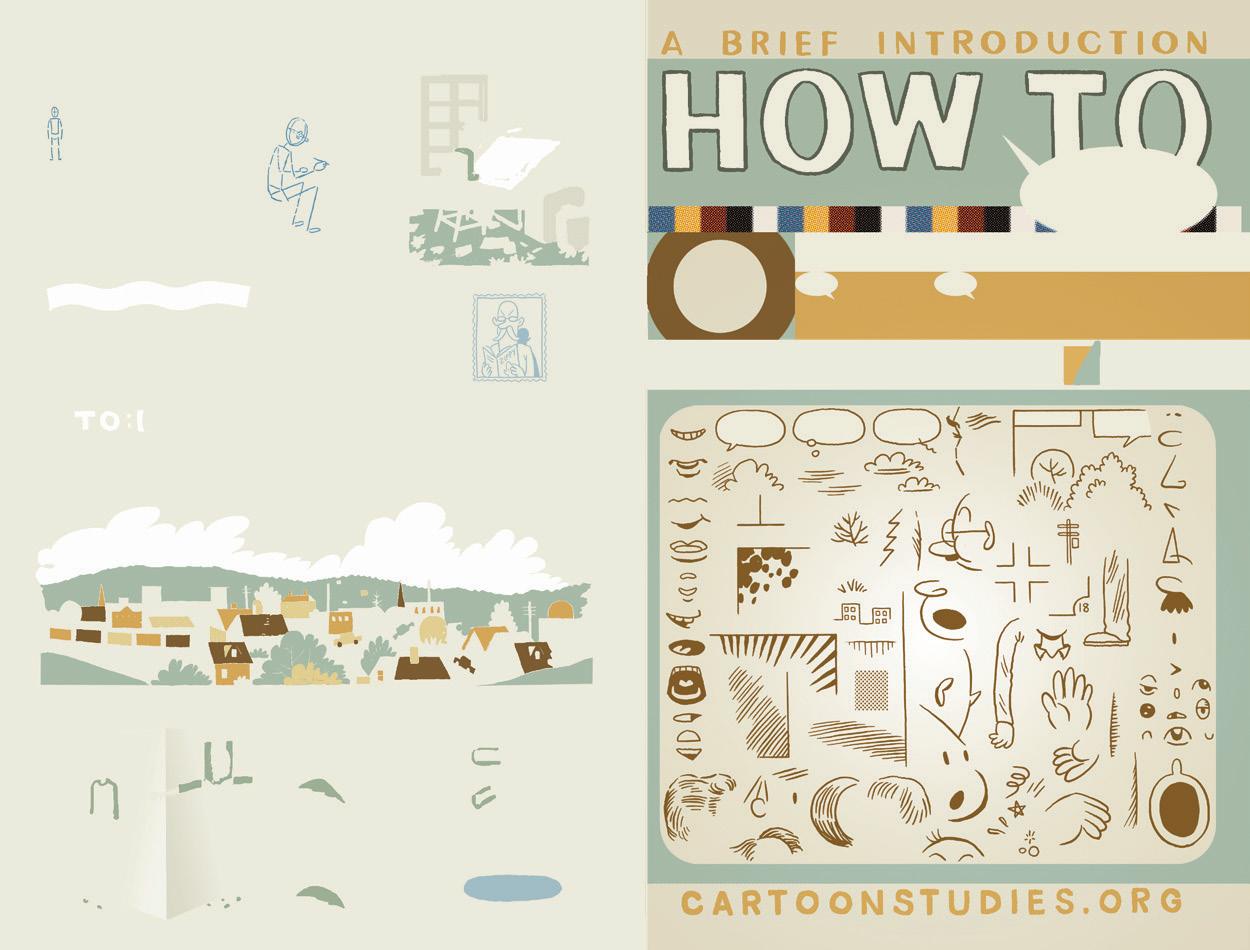
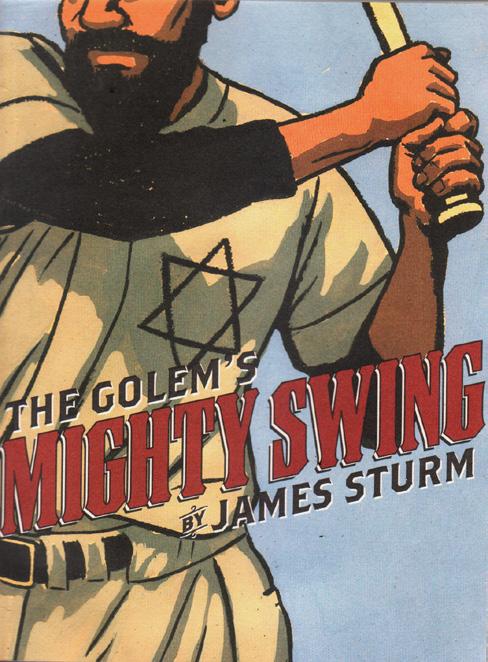
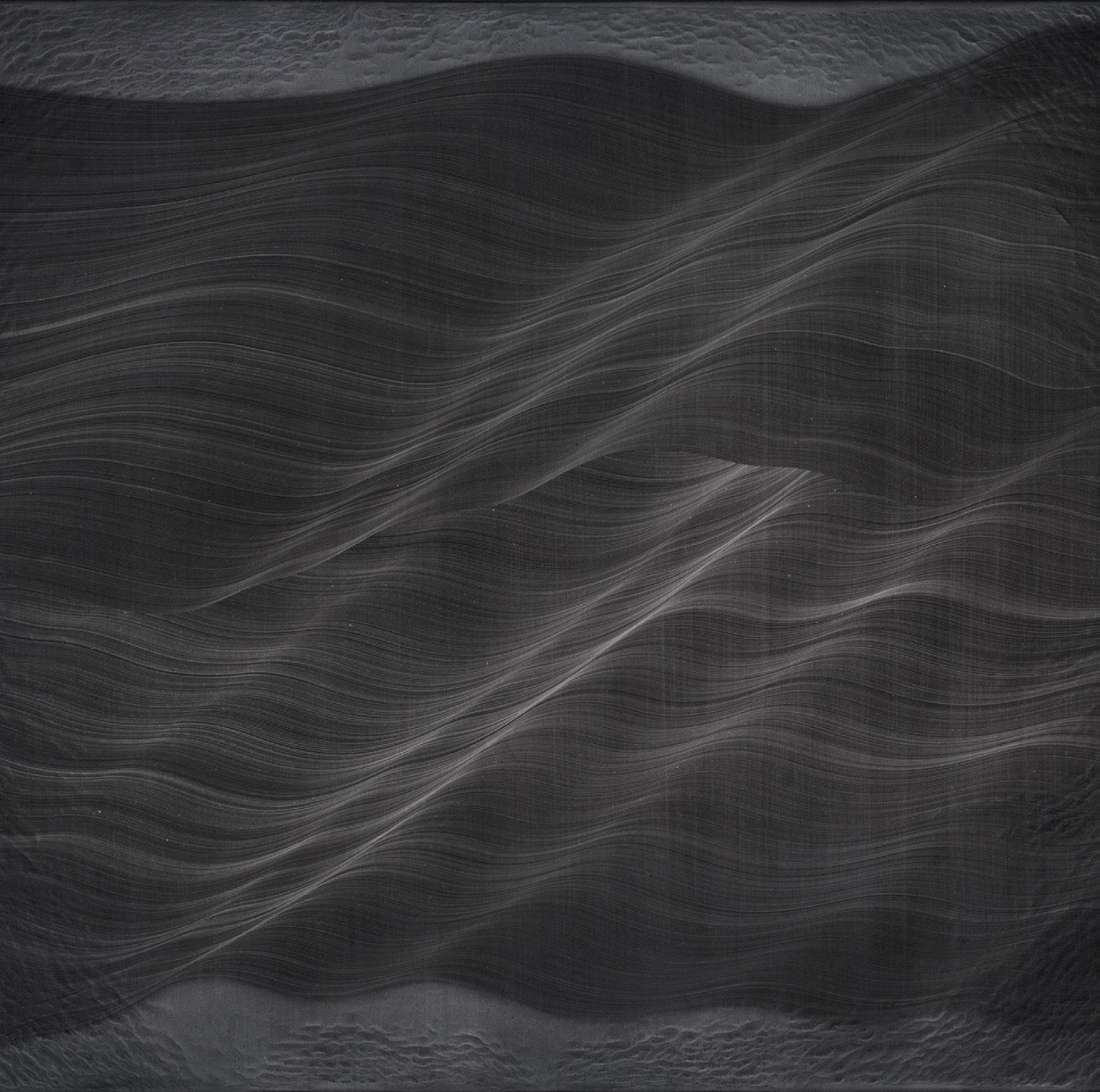

M. BENJAMIN HERNDON
BFA 2012 Fine Art
Benjamin Herndon’s experience as an artist was forever changed when one of his instructors at SVA, Steve DeFrank (MFA 1990 Fine Arts), asked his class to create a drawing that was essentially invisible. The concept stuck with Herndon, and much of the work he has created since aims to enact a quiet conversation between the materials and the viewer’s experience. From silk-screening transparent paint on steel, then inducing oxidation to form images in rust, to finding new ways to keep the commitment to subtlety in his work, Hern-
don’s process “has become intensely more complex than opening a tube of oil paint,” he says.
The resulting art, which Herndon makes in his Providence, Rhode Island, studio when not teaching lithography at the Rhode Island School of Design, is quiet, subdued and softly infiltrating galleries everywhere. On the heels of 2017 exhibitions in Beijing, Boston, New York and Tokyo, Herndon has four shows planned for 2018, including a solo exhibition at A R E A Gallery in Boston. Raised in rural Northern California, Herndon has lived for four years in Providence, where he shares a house with his wife and two fellow SVA graduates, graphic designer and illustrator Jason Arias (BFA 2011 Graphic Design) and photographer and librarian Erin Perfect (BFA 2011 Photography).
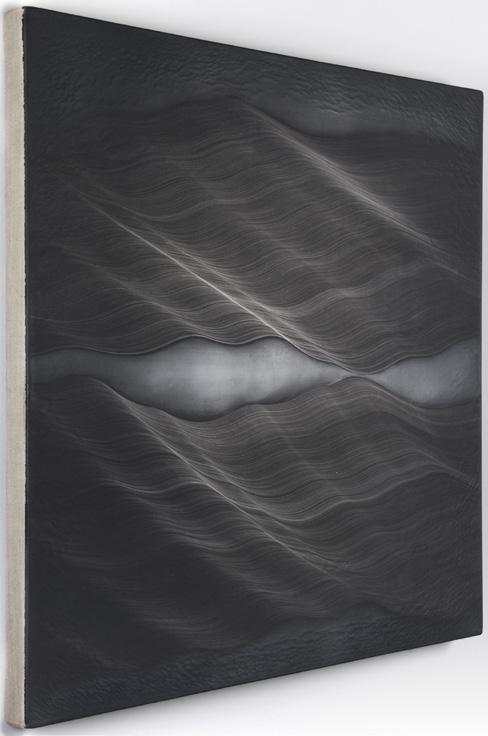
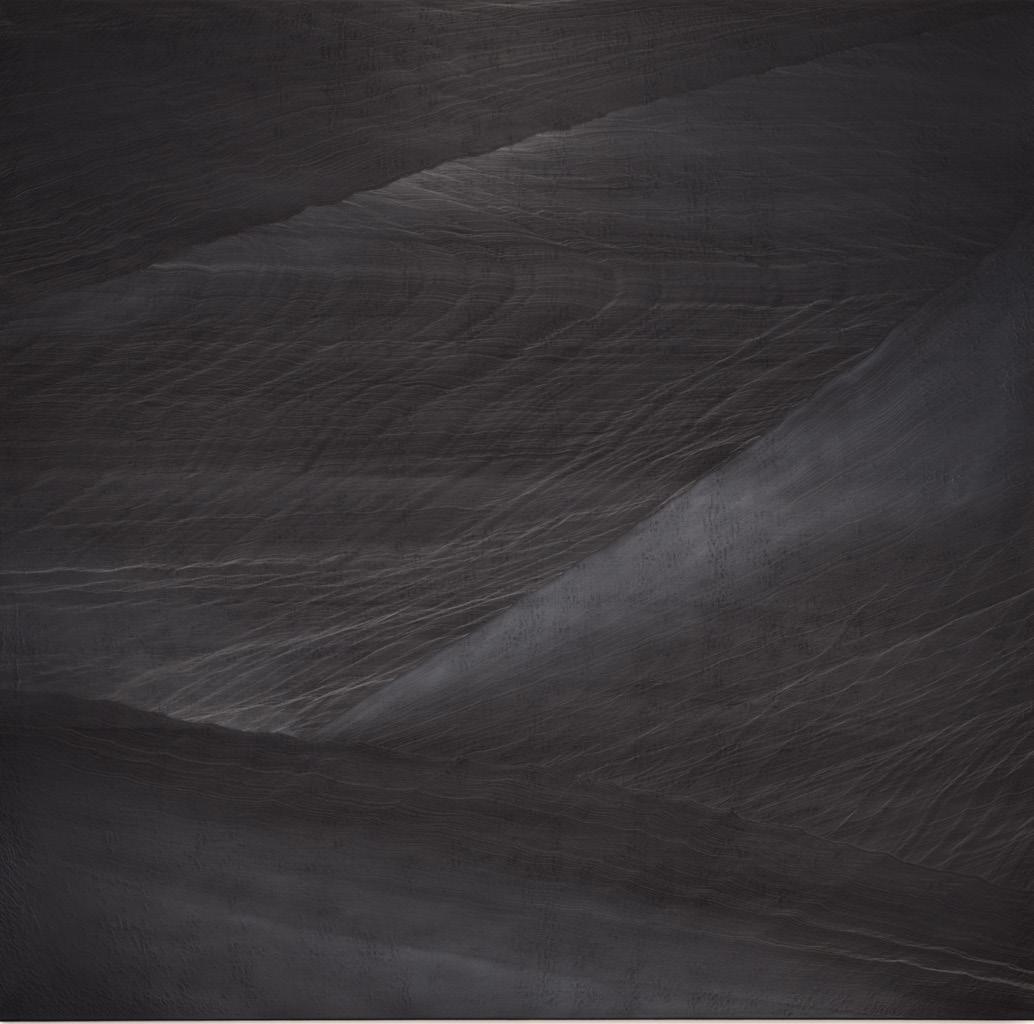
The group lives communally, “splitting our expenses evenly and cooking all our meals together,” he says. “We were all happy to have a change of pace after paying our NYC dues.” ✸
KRISTIN L. WOLFE is a freelance writer. She teaches English composition and literature in SVA’s Humanities and Sciences Department.
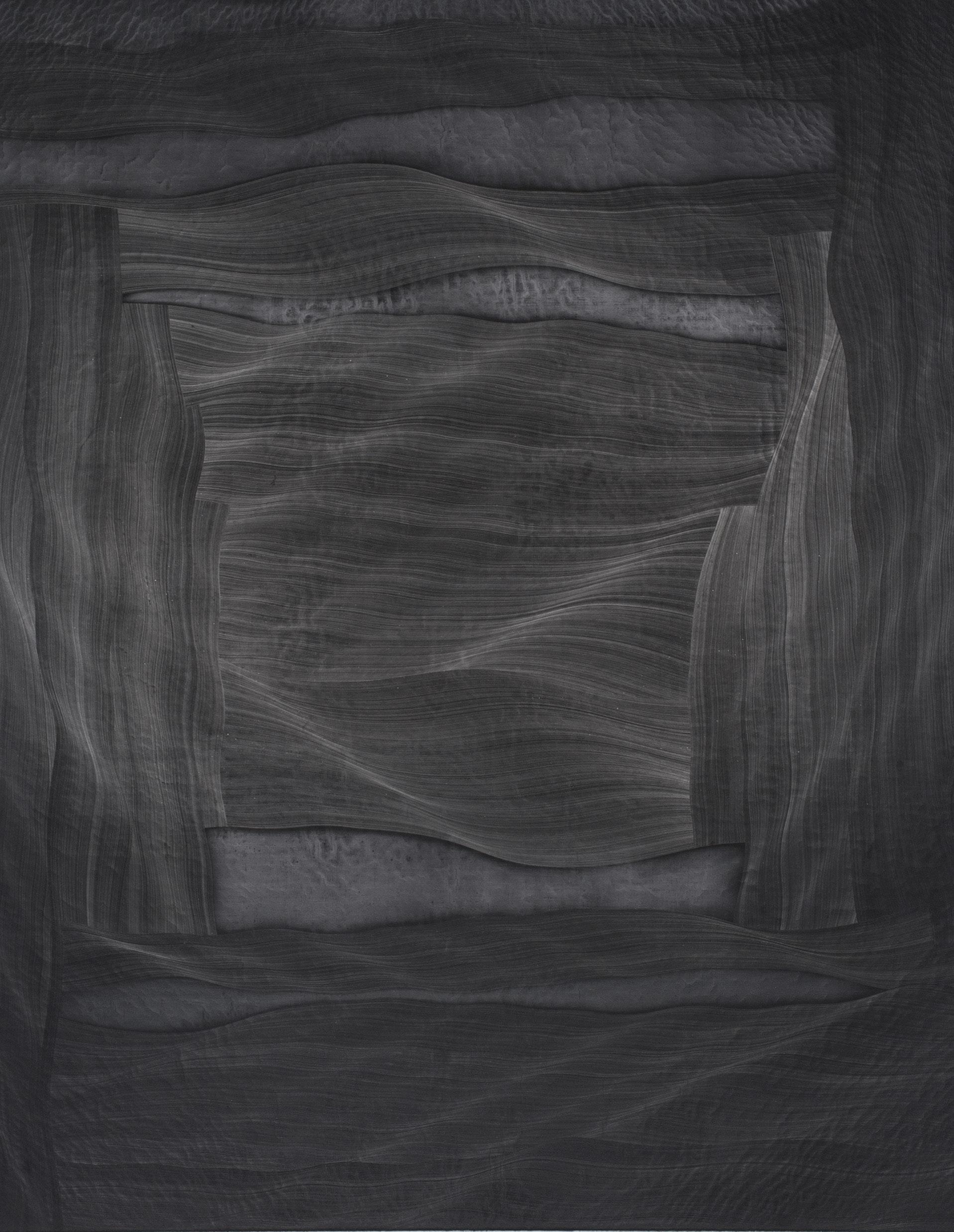
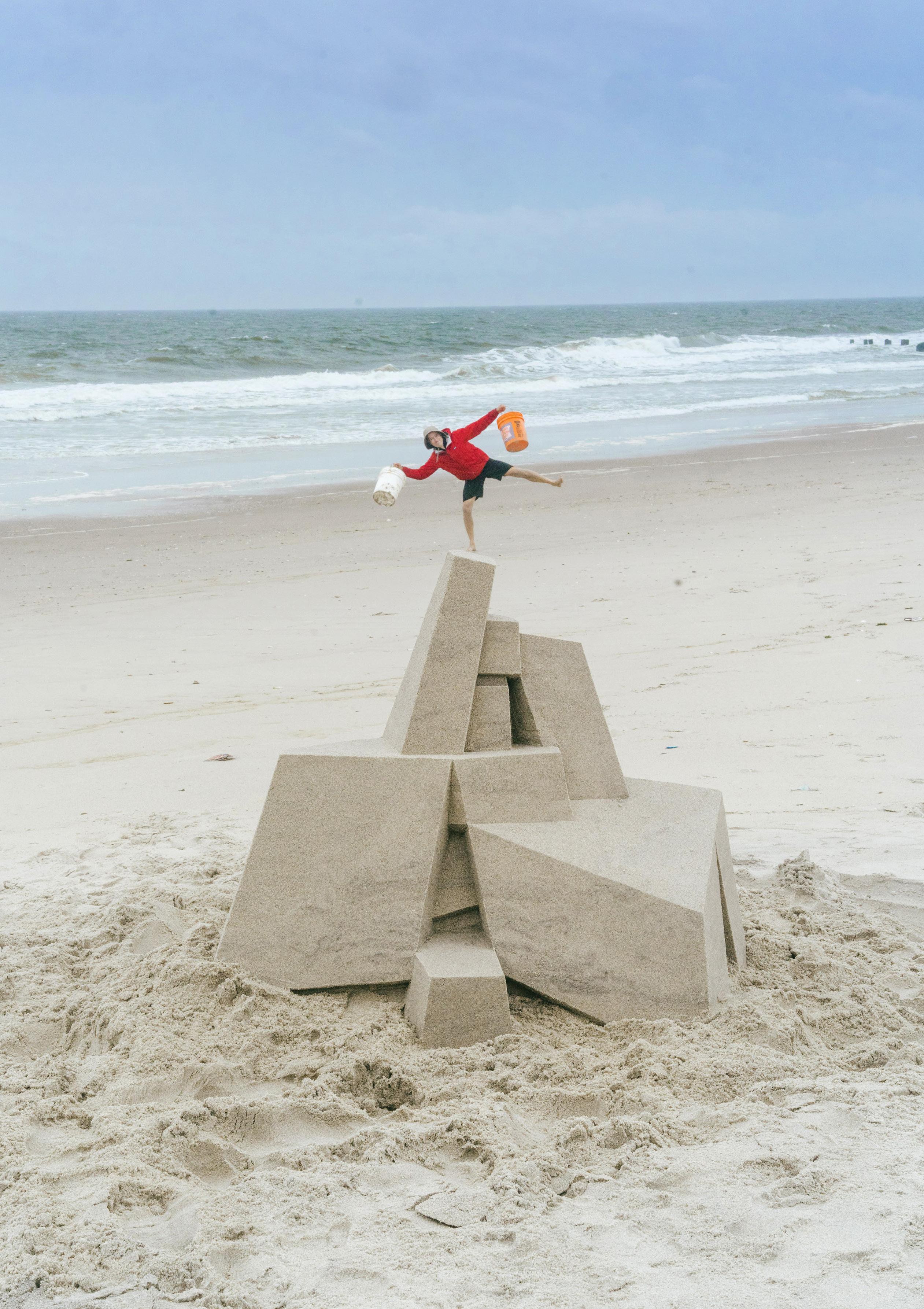
Calvin Seibert (BFA 1983 Fine Arts) has been building sandcastles for as long as he can remember, but it was only about three years ago that he started building them on Rockaway Beach, in Queens. After 10 years of working as a sculptor’s assistant, he was recently unemployed—or at least underemployed, as he remains, intentionally, to date—and the roundtrip bus fare from his rent-controlled Manhattan apartment to Jones Beach State Park, on Long Island, where he had built sandcastles since the mid-1980s, was now too expensive. Particularly if he was going to build sandcastles every day that wasn’t too cold or rainy, which was and still is his plan.
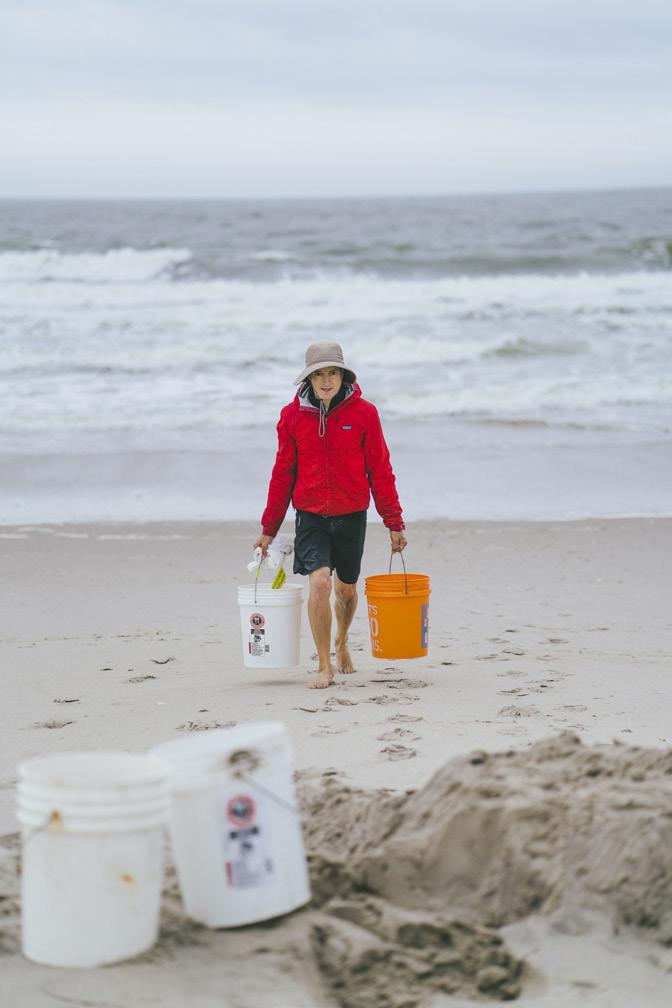
“It’s my primary activity,” he said over co ee on a rainy day late last year. “Everything else I do is waiting and keeping myself afloat.” Though summer was long over by then, it was still more or less warm enough for him to be at the beach, but he had a few o -season jobs waiting—mostly handyman or house painting work for people he knows. A friend who works in real estate had been trying to persuade him to move to San Francisco to manage one of his apartment buildings. The year-round California beaches were tempting, Seibert said, but the building “is filled with young techies having parties all the time, so I’m not sure I want to do that. . . . I wish it were quieter, you know?”
Seibert’s sandcastles are big, fantastical, cubist-looking things, alternately blocky and curvy, striated and smooth. They are most obviously influenced by architecture, primarily brutalism and modernism, but filled with details and inspirations from elsewhere and everywhere, be it earthworks, fine art or geology. They can sprawl for several feet or consist of heaps of haphazardly arranged, odd-angled shapes, or do both. He has built, by his count, “hundreds and hundreds and hundreds and hundreds” of them.
They are, he says, never finished, only abandoned. He carves and packs their improvised designs out of huge wet piles of sand, using trowels and tampers that he made with leftover Plexiglas from his former employer’s studio. (Metal tools, he notes, would rust.) He works nearby the Beach 68th Street pedestrian entrance, at a spot that is close enough to the water for him to quickly run back



Seibert’s sandcastles are big, fantastical things, alternately blocky and curvy, striated and smooth.
and forth with his five-gallon buckets, but far enough away to avoid high tide. He usually makes one castle a day, not too far from the ruins of the previous day’s. On breaks he eats mu ns, fruit, trail mix, peanut butter and honey sandwiches, or chocolate. He buries the chocolate so that it stays cold, keeping it in a plastic box along with his phone and his camera.
Sometime around 2006, Seibert began posting his sandcastles to Flickr, an online image-sharing platform. But it
wasn’t until around 2012, for reasons he can’t name, that the wider world began to take notice, and the notice since then has been considerable. Artsy, CityLab, Curbed, The New York Times, Smithsonian, CBS News (and, separately, its local a liate, WCBS2),
PREVIOUS


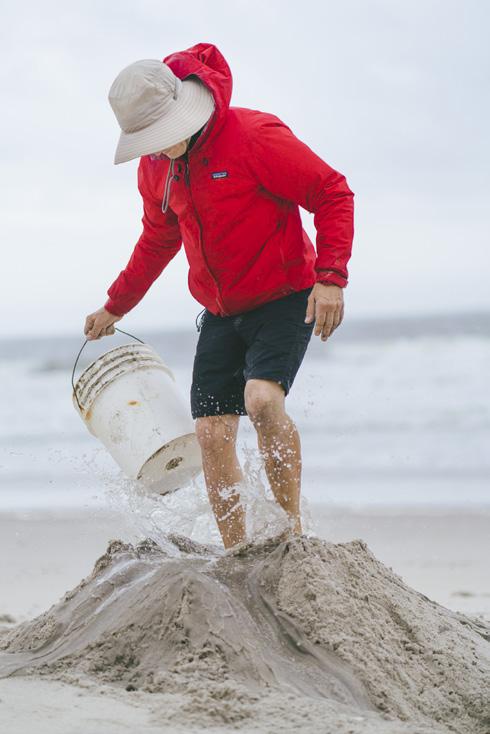
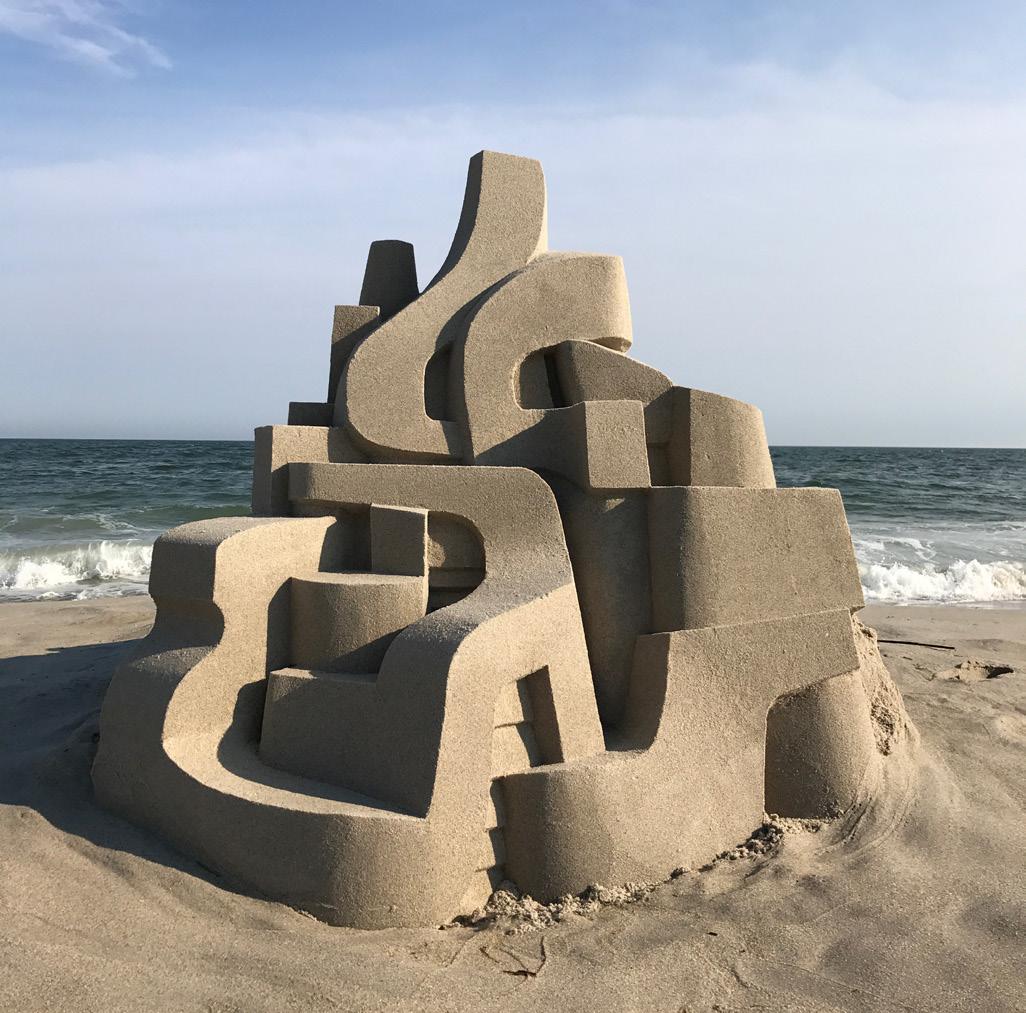



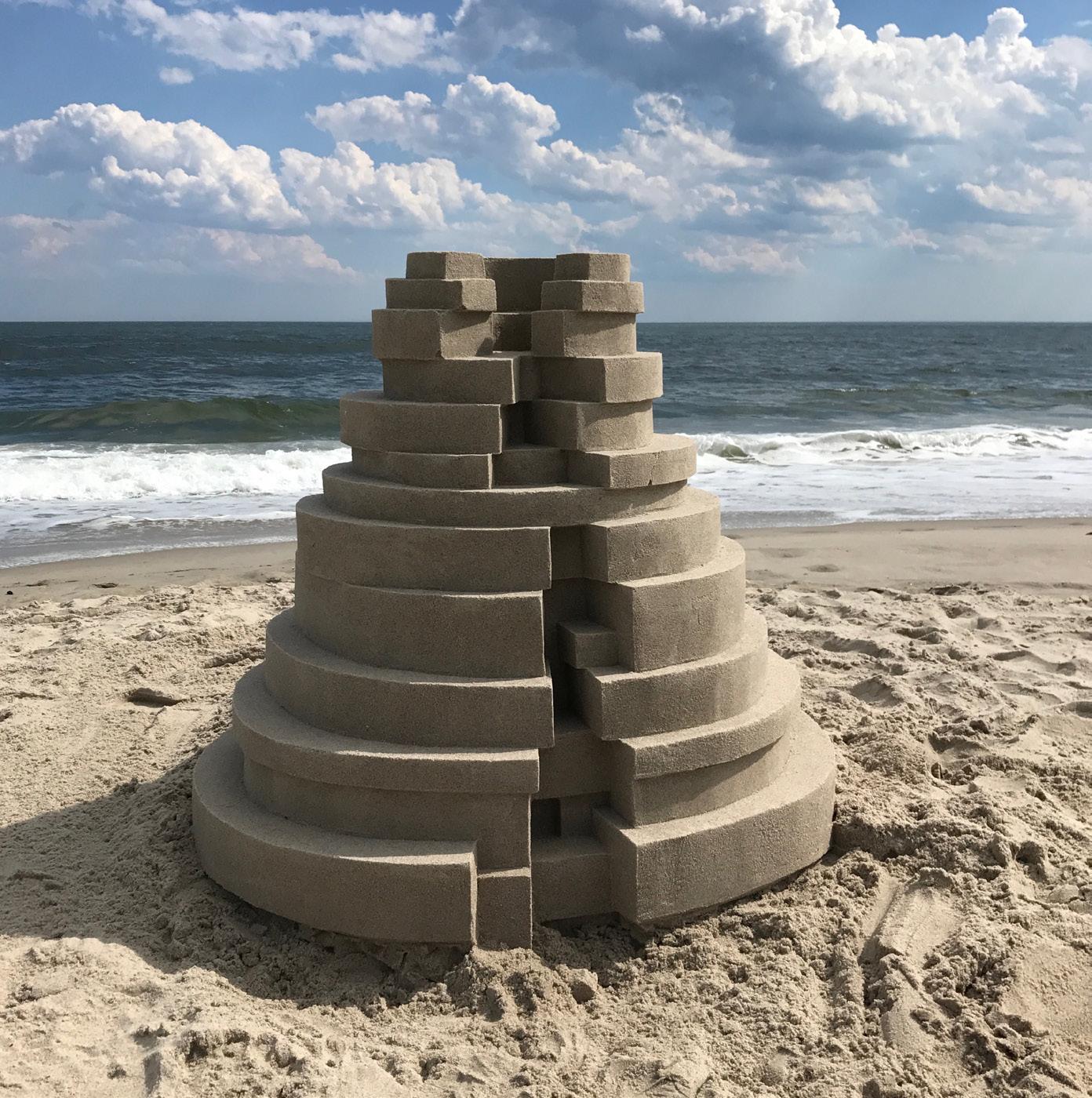
Time Out and Wired all have done stories on Seibert. The German newspaper Die Zeit interviewed him in 2015 and two summers later invited him to take over the Instagram account of their related publication, Zeitmagazin—a lofty, if obscure, honor: Other @zeitmagazin guest hosts include filmmaker Wim Wenders, photographer Brigitte Lacombe and British band the xx. (That same summer, Seibert started his own Instagram account, under the handle @calvinseibert.) He has been hired to build sandcastles in a Manhattan gallery (“we used construction sand, which has sharper edges and holds together very well”), at a conference for the Summit Series organization, in Tulum, Mexico (“very orangey sand”), and for an Hermès catalog shoot in Cap Ferret, France (“beautiful sand, very consistent color”). Last summer, he received an inquiry from an editor who was interested in his ideas for a children’s book. Seibert, flattered but “too busy with sandcastles right now,” hasn’t yet followed through. Later this year, a short documentary about him, tentatively titled A Train to Rockaway and directed by Carlos Rojas Felice and William Michals, will begin showing at various festivals.
Seibert grew up in Vail, Colorado, in the town’s formative years. His father, Pete, an elite skier and World War II
veteran, founded the resort in 1962 with the backing of a group of investors. When he died, in 2002, The New York Times memorialized him as the “soldier skier who built Vail.”
“But he never made any money from it,” Seibert said. “He didn’t know how to make money.”
Seibert’s first sandcastles were built in
and settled on art instead. In his high school library, in Denver, he remembers only two catalogs for art colleges, and one of them was for SVA.
At college, Seibert gravitated toward instructors and artists Alice Aycock and Will Insley, both of whom are known for their architecturally influenced work. Aycock’s restlessness left an especially deep impression. “She was making architectural things right when I first found out about her,” he said, “and she quickly moved on to making machine-like things. And I was almost scared by that, by the idea that she’s not sticking to this, she’s just moving on.”
Though he has no plans to focus on anything other than his castles, Seibert’s own art demonstrates a similar willingness to move on, even when he’s not working with sand.
“He just plows ahead,” says Michals, who with Rojas Felice approached Seibert about a documentary after reading his 2015 New York Times profile. Over the two successive summers in which the filmmakers shadowed Seibert, they watched a sculpture that he made in his o hours, using cardboard he scrounged from the street, grow steadily bigger, until it took up a comical amount of space in the artist’s tiny studio apartment.
“It was about eight or 10 feet tall,” Michals says. “It was like keeping a tree in your closet.”
By last fall, Seibert was readying to do with it what he always does whenever he’s done with a work: photograph it, discard it and start again. “I feel weird about giving [sculptures] away,” he
Seibert has been hired to build sandcastles in a Manhattan gallery, at a conference in Tulum, Mexico, and for an Hermès catalog shoot in Cap Ferret, France.
construction sites as the town went up around him. “Our doctor worked on the mines 15 miles away, our grocery store was in another town, we didn’t have TV until the seventh grade. . . . It was a really rural part of the world back then.” When he wasn’t making sandcastles, he was making “miniature towns and houses, but they were always opened up and left unfinished—they wouldn’t have roofs.” He briefly considered architecture as a career but decided it was too bound by rules and practical concerns,
said. “I don’t want people to take it just because I’m going to throw it out. . . . It’s easier to just get rid of it.”
In early March, Seibert reviewed his plans for the warm season ahead. The Summit Series had invited him back to Tulum; this time, he would also teach a sandcastle workshop. Most promising, however, were his 90,000 frequent flier miles, accrued over many years of visiting family in Colorado. “I’ve been looking at beaches in Japan,” he said. “I might go build castles there.” ✸
Q+A JOE SINNOTT
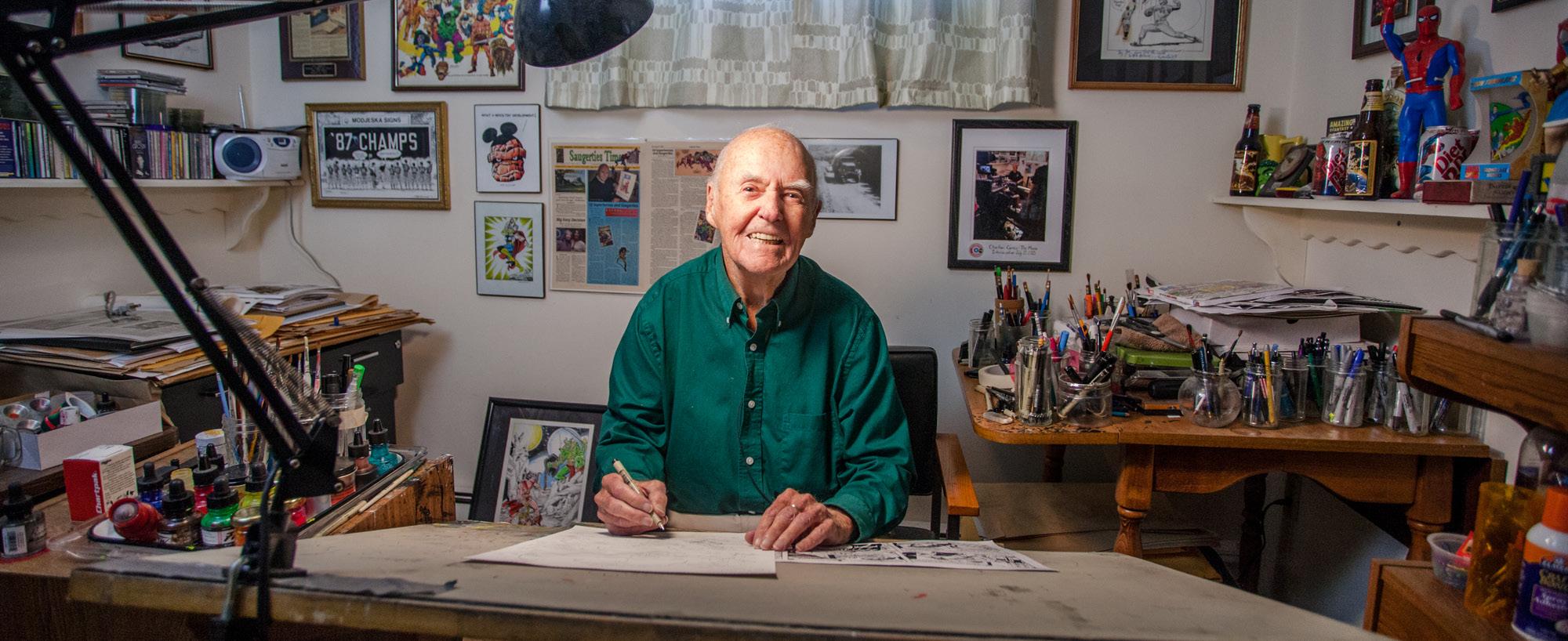
by greg herbowy
On a nondescript street in Saugerties, New York, two priceless stores of art sit side by side. The first, occupying a squat, anonymous-looking warehouse, is the East Coast facility of Archive Fine Art, which holds paintings, sculptures and other works for collectors, galleries and museums. The second, occupying a rear unit in the back of a small brick apartment building, is the home of Joe Sinnott (G 1952), a comics illustrator and inker well into the seventh decade of a staggeringly prolific career.
A conservative estimate puts the tally of comic books, strips, ads and related ephemera that Sinnott has worked on as either a penciller, inker or cover artist at well over 4,000. The overwhelming majority of that work was done for Marvel Comics, arguably the industry’s dominant creative force and unquestionably the one most responsible for our current superhero-saturated popular culture. Sinnott began freelancing for the company’s then editor-in-chief, comics icon Stan Lee, while he was still a student and the publisher—then known as Timely—was better known for its Westerns and war stories. Between 1950 and the early ’90s, Sinnott worked on just about every well-known title on Marvel’s roster, from Avengers to X-Men. He was the inker for the first appearance of Thor—now one of Marvel’s most pop-
ular characters, on the page and the screen—and for dozens of subsequent stories starring the hero. And beginning with issue number 5, in 1962, he inked over 200 issues of Fantastic Four—the title widely credited with establishing Marvel’s brand—including a five-year run with the series’ co-creator, famed artist and writer Jack Kirby.
Just as he was present for the origins of characters that went on to revolutionize the comics industry, Sinnott was also witness to the foundational years of the School of Visual Arts, back when it was a modest operation known as the Cartoonists and Illustrators School. Like many early students, he attended under the GI Bill, having served in the Pacific Theater with the Navy during World War II. After graduating, he moved back to his hometown of Saugerties to raise his family and work long-distance for Marvel.
Though Sinnott has lately stepped away from the demands of full-length books, he still works with Lee. For the last 27 years, he has inked Lee’s Amazing Spider-Man Sunday comic strip, which is syndicated in newspapers nationwide by King Features. And his past work continues to draw an audience: Sinnott regularly attends comics conventions in the Northeast, and this July, Hermes Press will publish Joe Sinnott: Embellishing Life, a 240-page hardcover collection of selected work.
You’ve been working on the Amazing Spider-Man Sunday strip for nearly 30 years. What’s the process of putting it together? Every 10 days I get two strips, always six panels to a strip. Stan writes the story, and he sends it to Alex Saviuk, who pencils it. Then Alex sends it to a great letterer, Janice Chiang. She lives in Woodstock, only eight miles away, and sometimes, if the deadline is tight, she’ll bring it down to me in person. After I ink it, I bring it to the FedEx drop box and send it to Stan, and he’s got a coloring department out there [in California] that colors it, and from there it’s sent to the printer. We work pretty far in advance. In November, we’re doing February’s strips. It’s a long process, actually.
How long have you worked with Stan Lee?
Would you believe 68 years? I met Stan by working for [early SVA faculty member] Tom Gill, as Tom’s assistant. Tom had an account at Timely, and I worked on Kent Blake and Red Warrior for him.
I worked for Tom for about nine months, then I got married and said, “Stan’s buying my work through Tom Gill, I’m going to see if he’ll buy it on my own.” So I went over and Stan gave me a three-page story, “The Man Who Wouldn’t Die.” I spent a whole week on it before I brought it back—I wanted to make sure I did it right. After that, Stan gave me all the work I could handle and he paid very well, $35 a page, which wasn’t bad at that time. I could do a page a day, so by the end of the week I was making a couple hundred dollars.
It was a great time to be in comics, it really was. The stories were so much fun, five or six pages, not like the superhero stories are now, and we did Westerns, science fiction, love stories, everything. And Stan was a great editor. He was only about 26 years old then. If he wanted to show you how to make a picture better, he’d jump on the top of his desk and go into a motion. He should’ve been an actor.
Comics artist Joe Sinnott in his home studio in Saugerties, New York.
RIGHT Original art for the cover of Giant-Size Fantastic Four #6 (Marvel, 1974); pencils by Ron Wilson, inks by Joe Sinnott. From Joe Sinnott: Embellishing Life , courtesy Hermes Press.
BELOW A character sketch by Joe Sinnott from his time at the Cartoonists and Illustrators School, as SVA was then known. Courtesy Joe Sinnott.
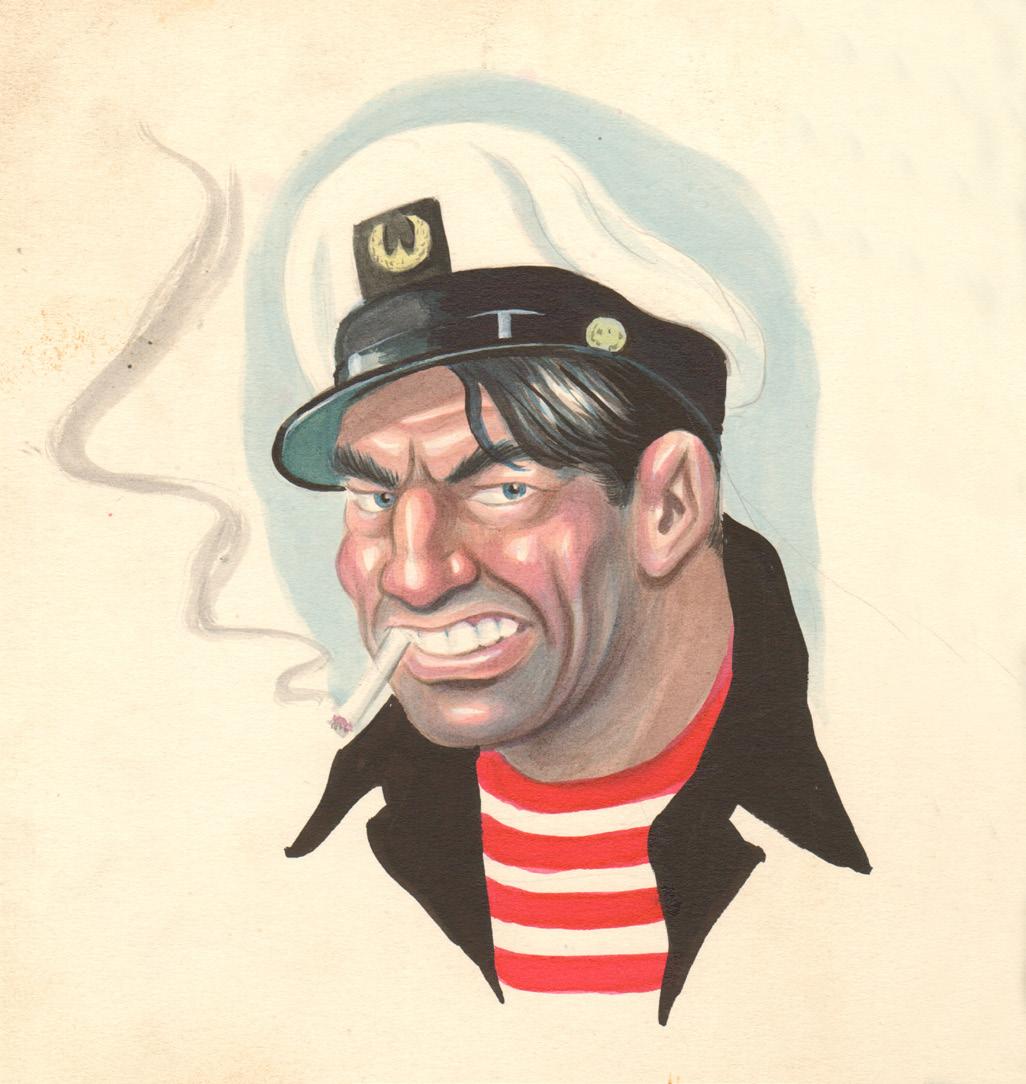
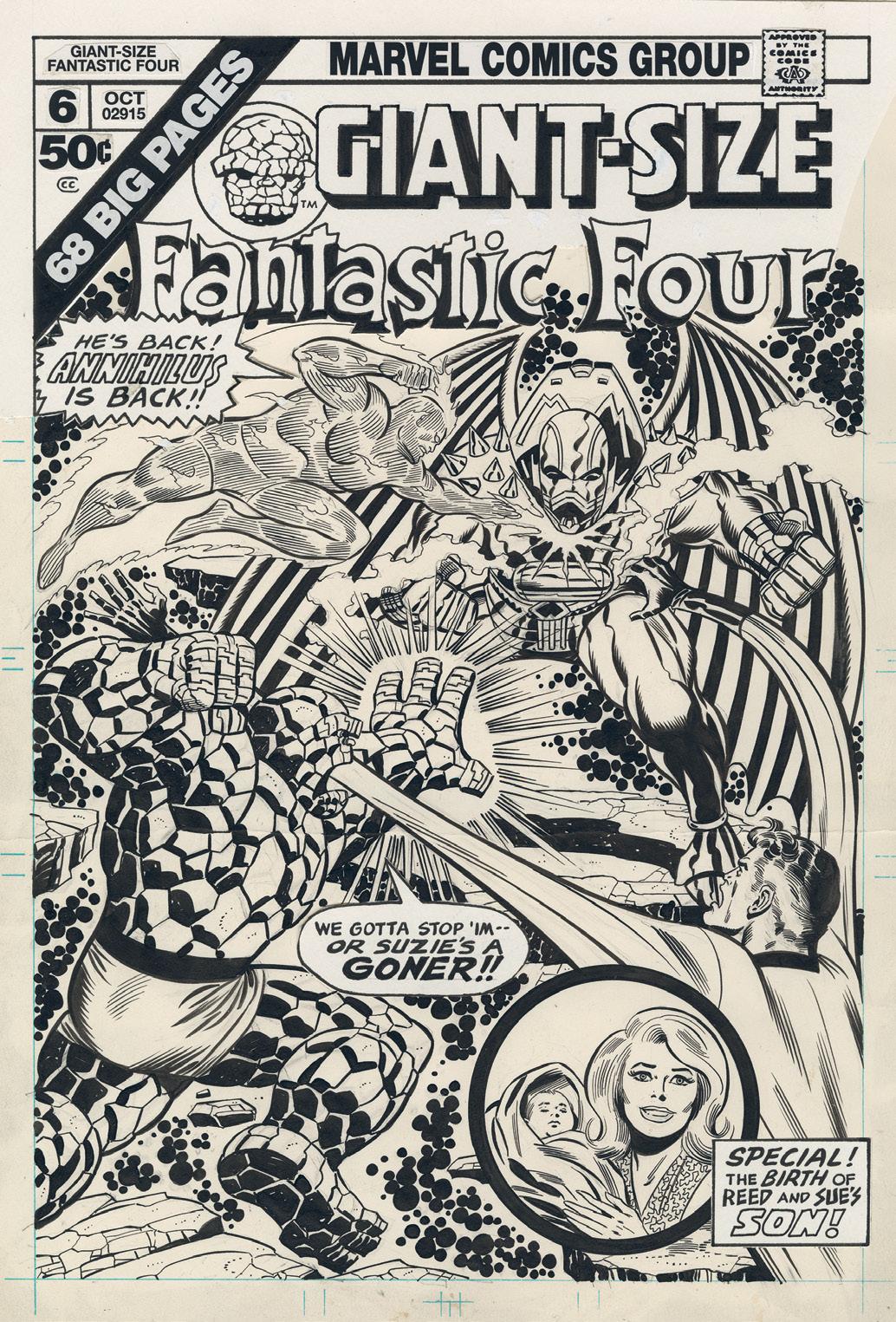
When did the business turn toward the superhero stories that we know today?
Not long after the Comics Code [a self-regulatory authority formed in 1954], we went belly up for about six months. Nobody could get any work. It was a great turning point. I remember when Stan called us back up, we worked for about three years doing monster books, horror stories like [rival publisher] EC’s. They were a lot of fun to do and sold fairly well, but it wasn’t the big trend that Stan was looking for.
And then in 1961, at the prodding of Martin Goodman, the publisher, who saw that other publishers’ superhero titles were selling well, Stan and Jack Kirby created Fantastic Four. And in three months’ time he got the report back that they sold like crazy, and that was the beginning of our superheroes.
Superhero stories are so culturally dominant right now, it’s hard to imagine an era of comics when they weren’t at the fore. But why do you think comics in general are so popular?
I think it started in the 1930s. Not only did we have [comic strip] Dick Tracy but in 1934—that was the big year—we got Terry and the Pirates. I was about eight years old, and every day to see Terry, another kid, go through all these adventures? You can’t imagine how exciting that was. Then came Flash Gordon, Barney Baxter, Tim Tyler’s Luck—all in the early, mid-1930s. Then of course what came because of those were the comic books: 1938, Action Comics [which introduced Superman]. It was just exciting stu that had never been seen before.
I go to some of the [Comic Con] conventions—I go to Albany every year, and for the last few years I’ve been going to Providence, Rhode Island. San Diego, I went there once, in 1995.
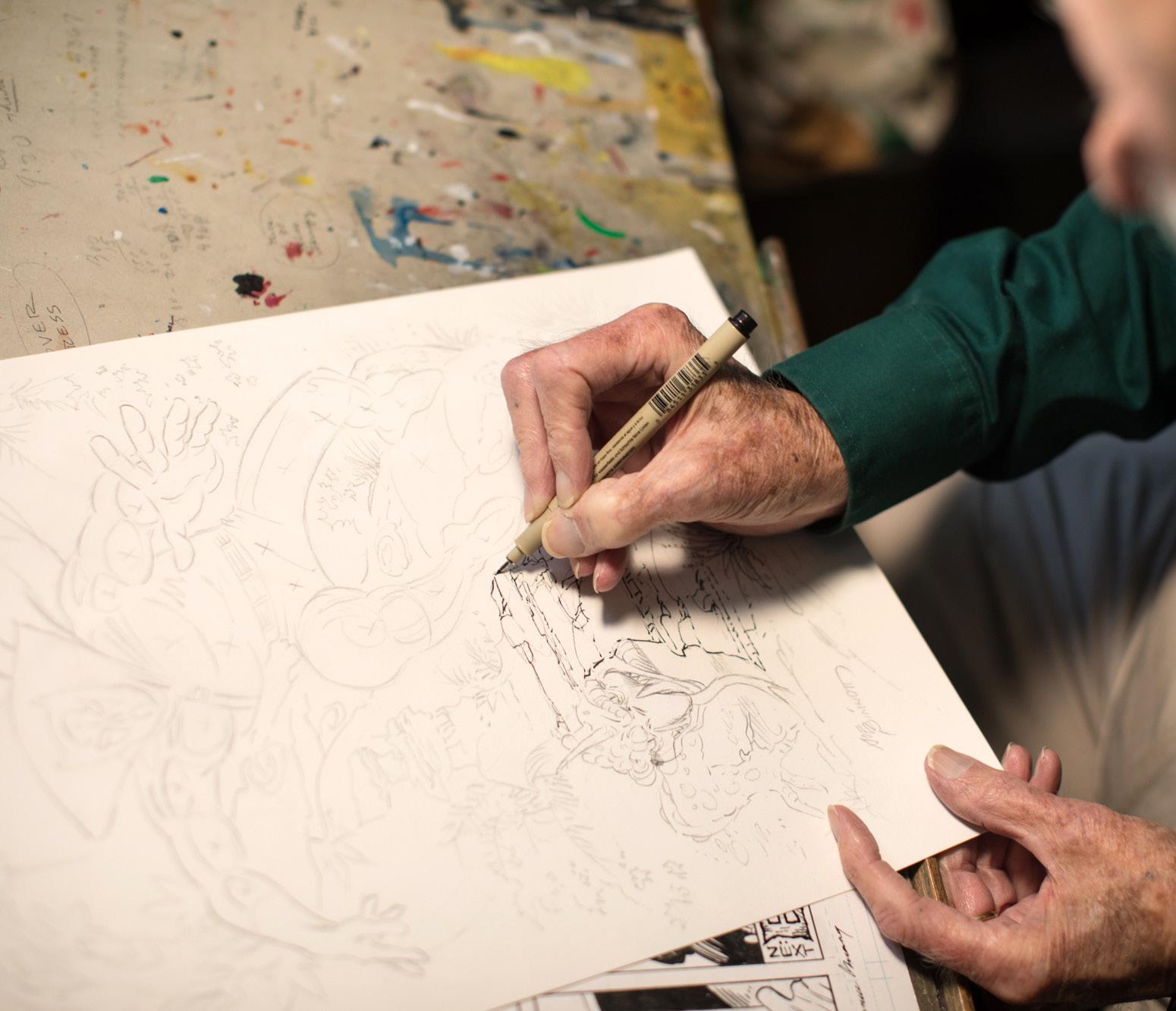
That was a madhouse. I had a kid come up to me, his name was Rufus and he was from Ireland. He says, “I want to show you something.” Takes o his shirt and pants. All on his chest, his back, his legs, was a complete copy of one of the comic books I did. It was perfect! It was like they took my book and laid it on there and printed it. I said, “Rufus! What in the world did your mother say when you walked in the door and showed her your chest?” Some of those guys are crazy [laughs].
What was Manhattan like for a student in the ’50s? I imagine cheaper? I lived on 74th Street, between Amsterdam and Columbus Avenues, in a beautiful building—everything marble and brass, elevator operators in uniform, and it was owned by [actress] Fanny Brice. Holy Moses, it was like a mansion!
Rent was only a dollar a day and I got by on another dollar a day. Every morning I would have breakfast right around the corner—10 cents, co ee and a donut. I’d take the subway, the IRT, 10 cents, go to the school. At school I’d go to the machine, get a peanut butter cracker and a Pepsi Cola, 12 ounces, a nickel each. Suppertime, most every night we’d go down to Times Square, to Romeo’s, you could see the guy in the window mixing the spaghetti and get a plate of it for 35 cents. And if we wanted to go to a movie, it was 10 cents for a double feature. So what have I spent, 75 cents? Then I’d go back up to 74th Street and buy a copy of the night paper, the Journal
American, for 2 cents. And sometimes I’d buy an ice cream cone for 10 cents.
What was SVA, or the Cartoonists and Illustrators School, like back then?
They had a couple rooms up on 89th Street. [Co-founder] Silas Rhodes, he was a good guy. He was a strong-looking guy, we used to call him Rocky. And [co-founder] Burne Hogarth, he was a character. He had the biggest ego, next to Stan Lee, that I can think of. There was nothing Hogarth liked better than to come into our classroom, go up to the easel and draw anything you asked him. He’d say, “What do you guys want?” And they’d say, “A saber-tooth tiger.” And he could do it, you know? Our first year was nothing but foundation. We had two great models, the one guy was a student, Johnny Belcastro (G 1952)—he went on to be a comics illustrator, too, under the name Jack Bell—and the girl was named Cecily Hicks. We’d have three-, two-, five- or 10-minute poses, and the model had tights on, and you had to put them in a costume, a cowboy outfit or whatever.
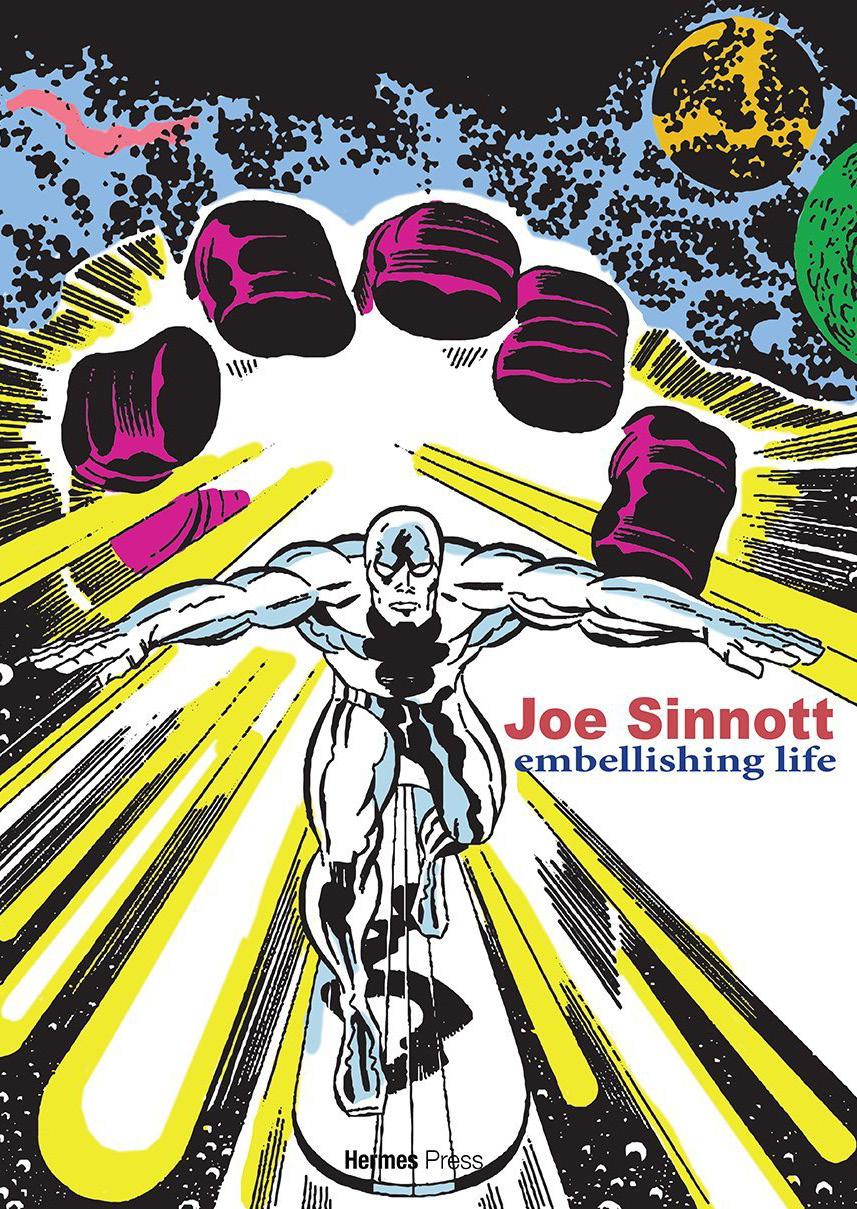
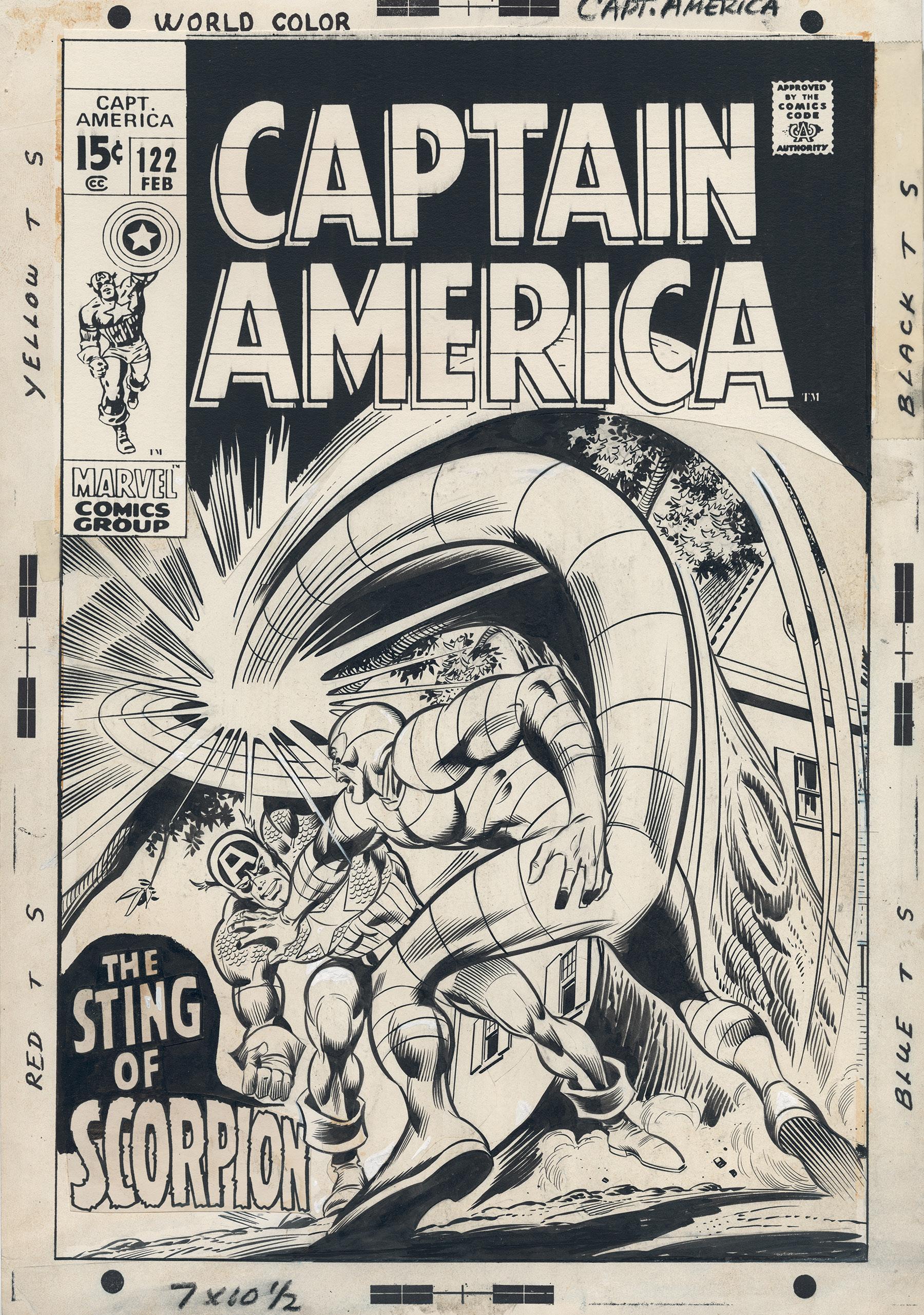
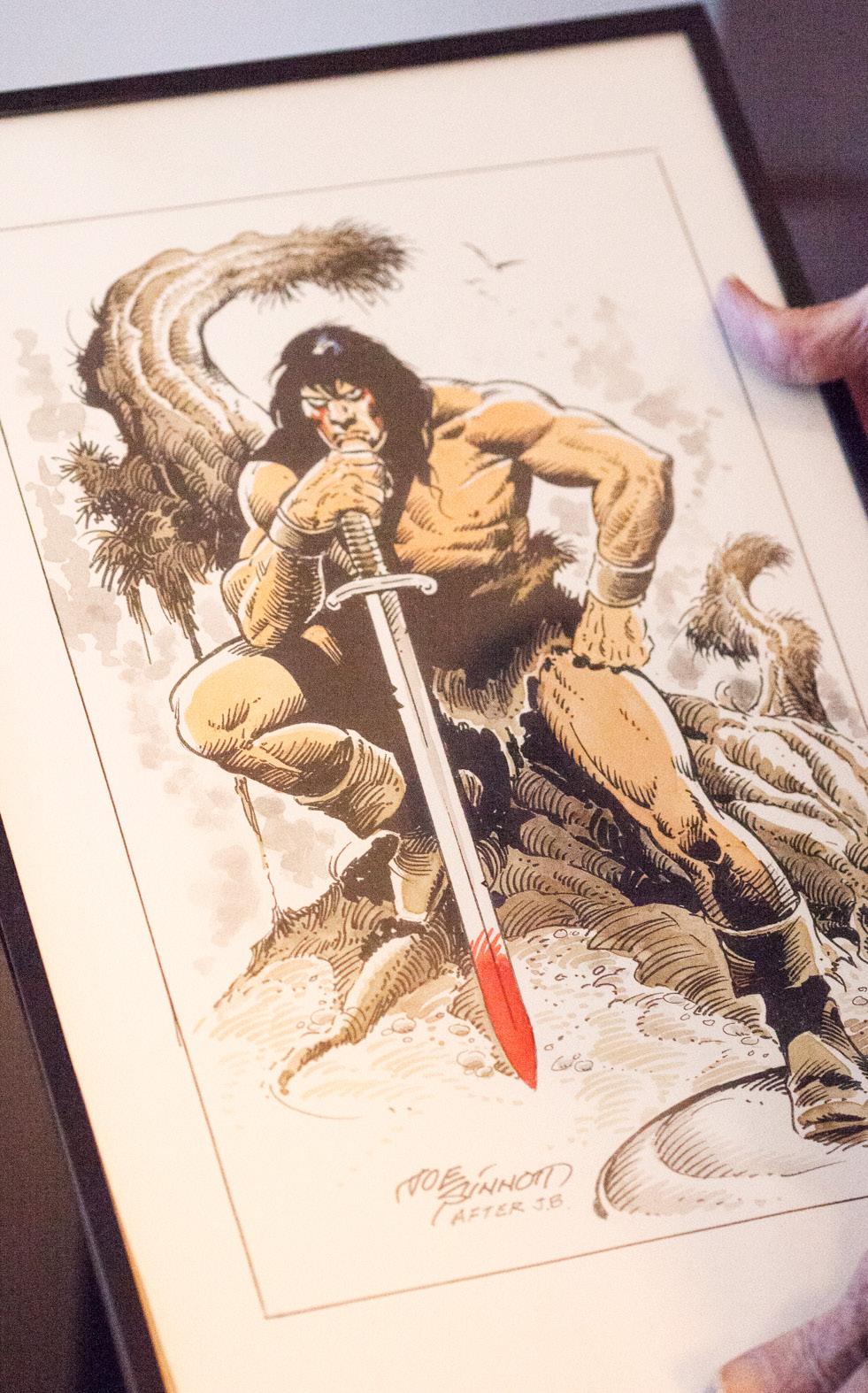
For instructors I had Maurice Del Bourgo and Tom Gill. Tom was doing the Lone Ranger, and pretty soon I started working for him. Comics were very big in the 1940s, ’50s. If you were halfway decent you could find work.
Was your own childhood love of comics what got you interested in becoming an illustrator?
I just love to draw. Even when I’m not drawing for someone, I’m sketching. If I’m sitting at the dining room table or breakfast table, I draw on envelopes, anything that’s handy. Even right on my drafting table. I’ll clean it every few years. I’ve had it since 1951, I think. A lot of art has come o of here. . . .
When I was growing up, my mother rented out two of the rooms in our house. We had seven kids in our family and with my father and mother that’s nine, and then with the two rooms booked, usually by schoolteachers, that’s 11 people, right? And we had one bathroom [laughs]. Can you imagine the line in the morning?
Anyway when I was three years old, one of the teachers gave me a box of crayons for my birthday, and I loved those crayons! I used them till they were down to nothing. I’d draw on paper bags, I’d draw on sidewalks, I’d draw on anything I could. I was always drawing. My father was very talented. I remember his black lunch box—he’d take a pen knife and scratch drawings all over it, beautiful scenes.
One time we had a roomer, he was a cook at one of the restaurants in town. He had been in the German submarine service in World War I. And where he worked he had to wear
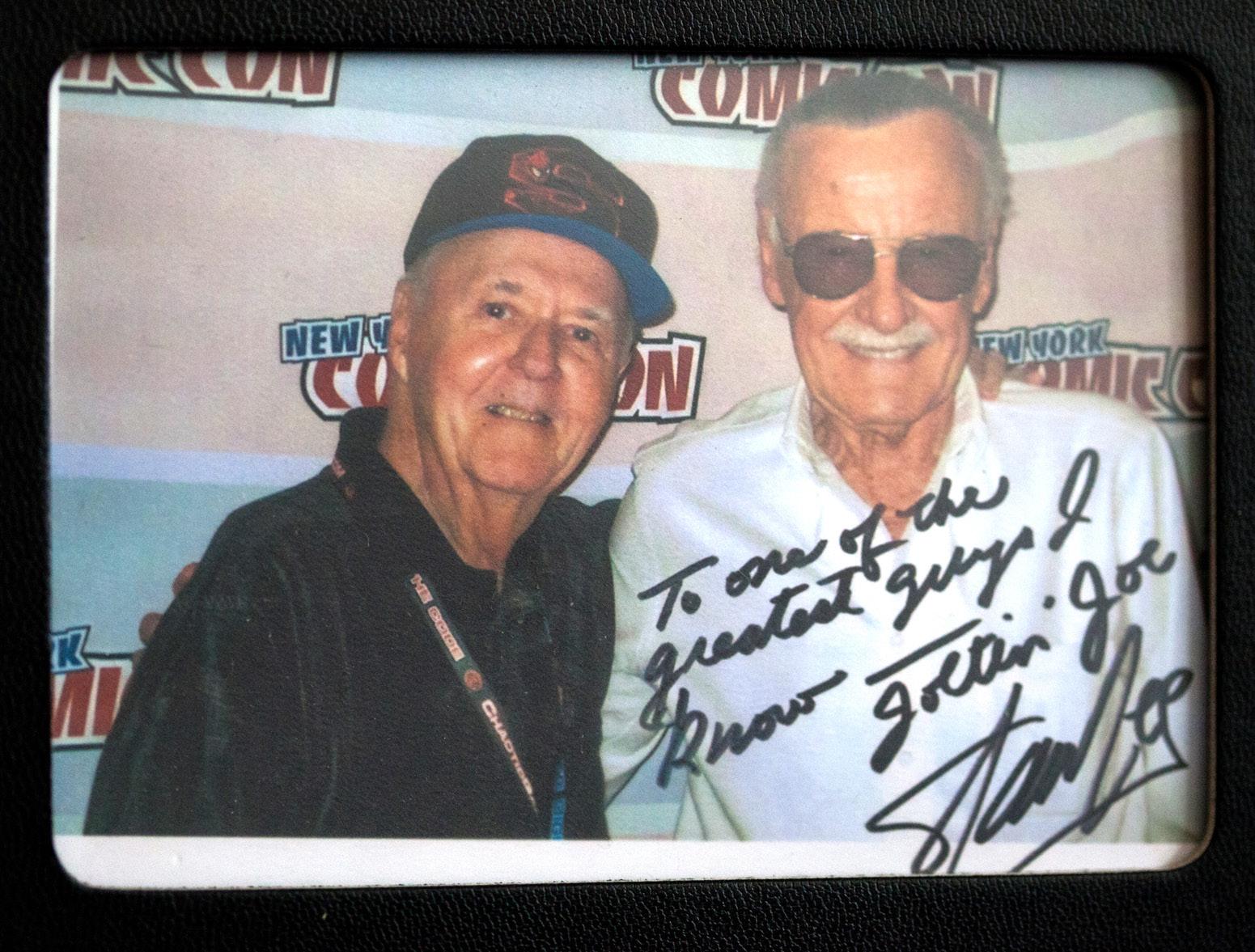
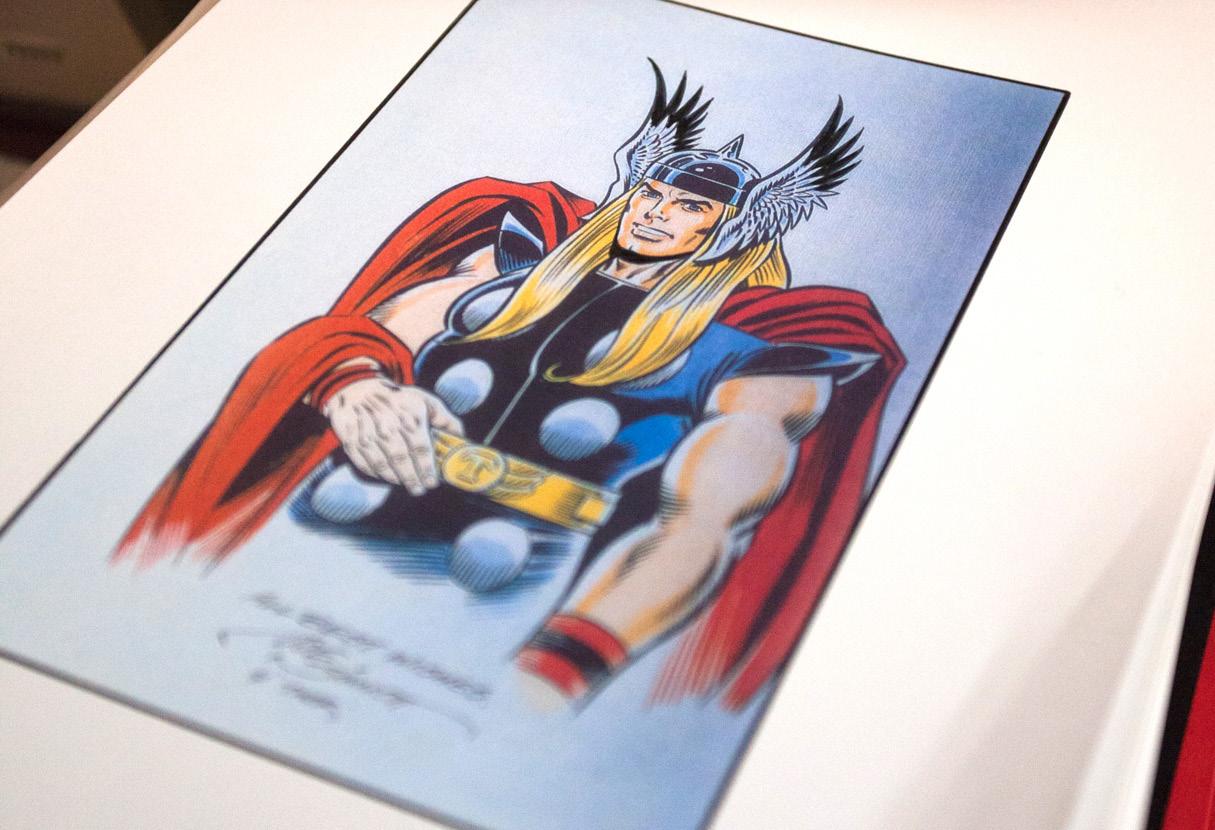
a white shirt, white pants and a white hat. He’d come home from work and sit on the chair in the parlor and I’d sit on the arm of his chair. I was only a little kid, five or six years old, and he’d say, “Joe, get me a pencil,” and he’d draw on his pants, cowboys and soldiers.
To me, at that time, I thought he was the greatest. He could draw, you know? I always felt like he was the one who inspired me. His name was Bill Thiessen, and after a couple years he moved away and it was like missing part of the family. I wish I could’ve met him years later and showed him what I did. I think if it wasn’t for Bill, and certainly Tom Gill, I wouldn’t be drawing.
After some 70 years in the business, is there anything that’s still hard to draw? Anything you don’t like to do?
Horses aren’t easy. Wheels—I hate motorcycles, I hate spokes, I hate stagecoach wheels. Even with Spider-Man , there are a lot of street scenes where you draw cars.
There are some things you don’t like to draw, they take too long. Fire escapes are a no-no, you don’t like drawing those. I tell Stan, “Get Spider-Man out in Monument Valley!” No perspective, just rocks! ✸
This interview has been condensed and edited. For a video interview with Joe Sinnott, visit sva.edu/videos.
The Benefits of Sharing
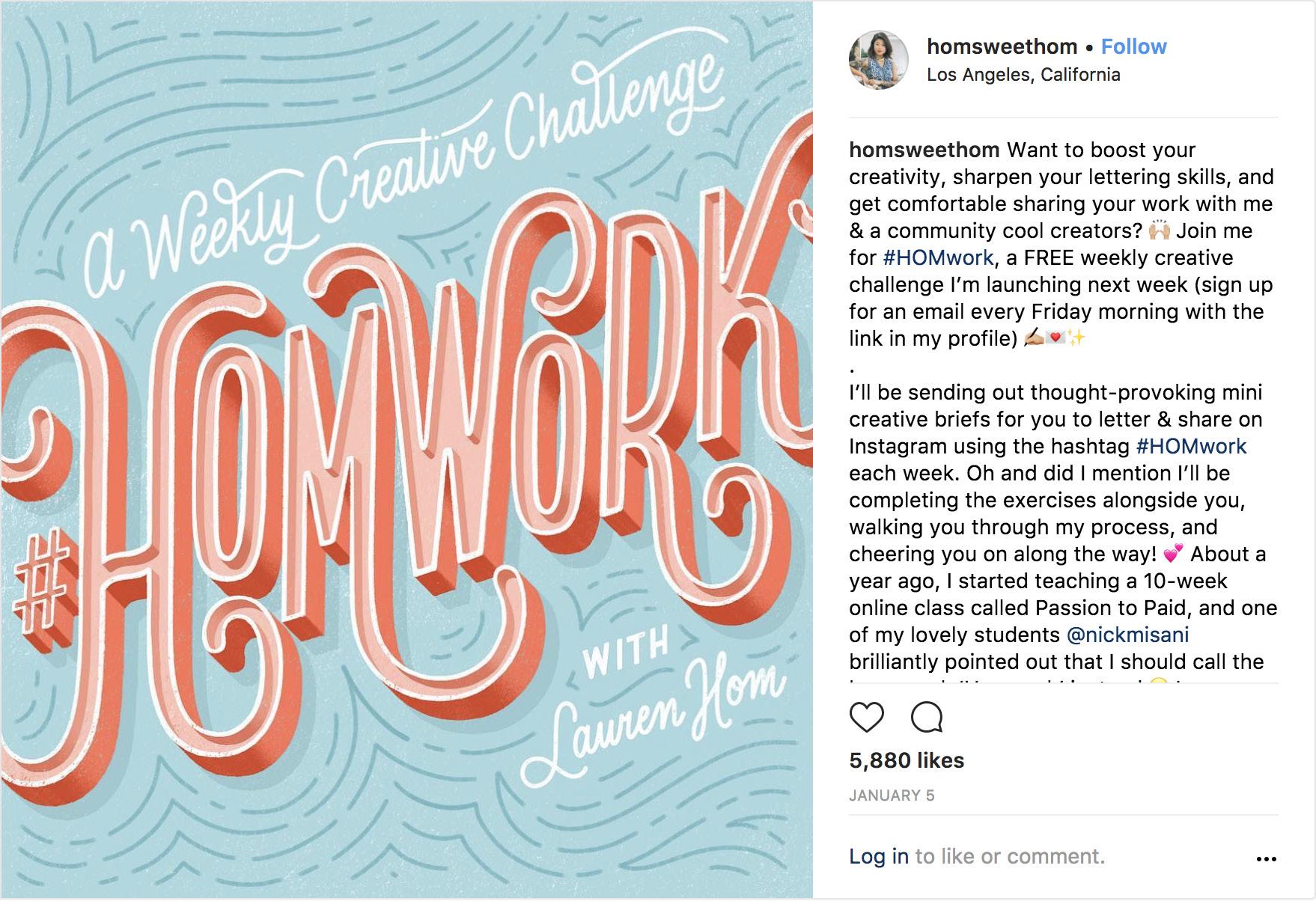
Talking Instagram with Some of SVA’s Most-Followed Alumni
BY MADISON MALONE KIRCHER
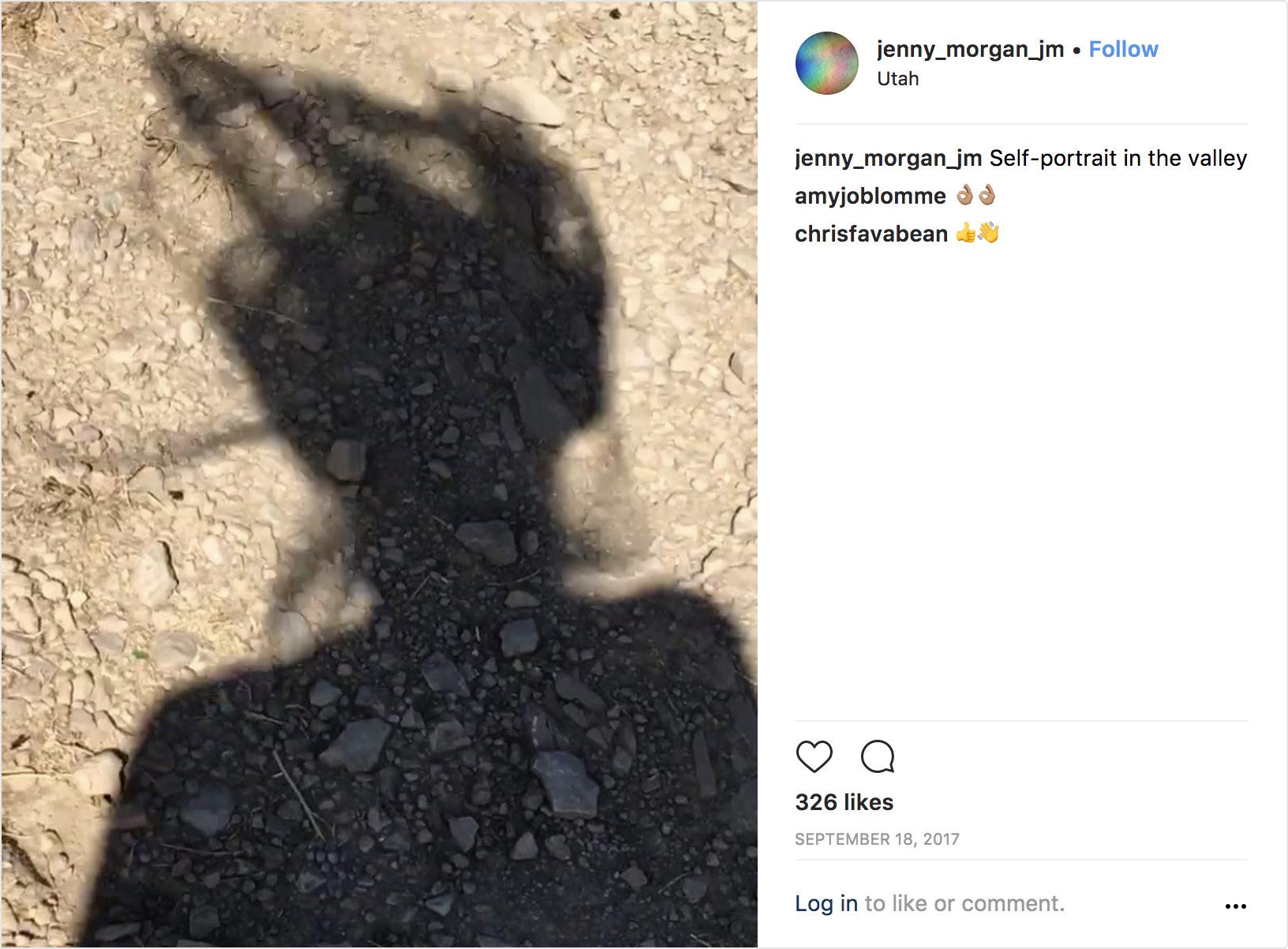
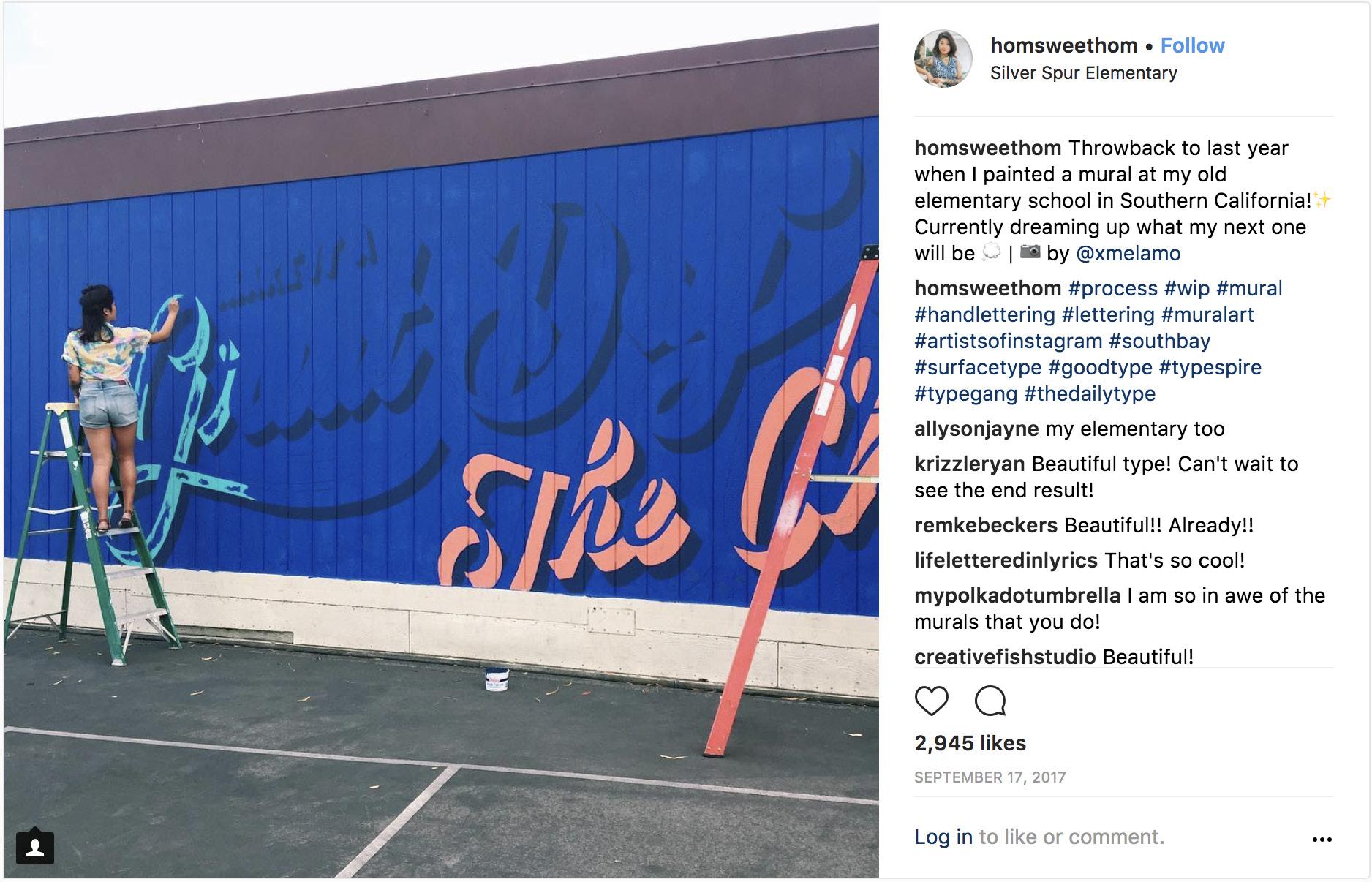
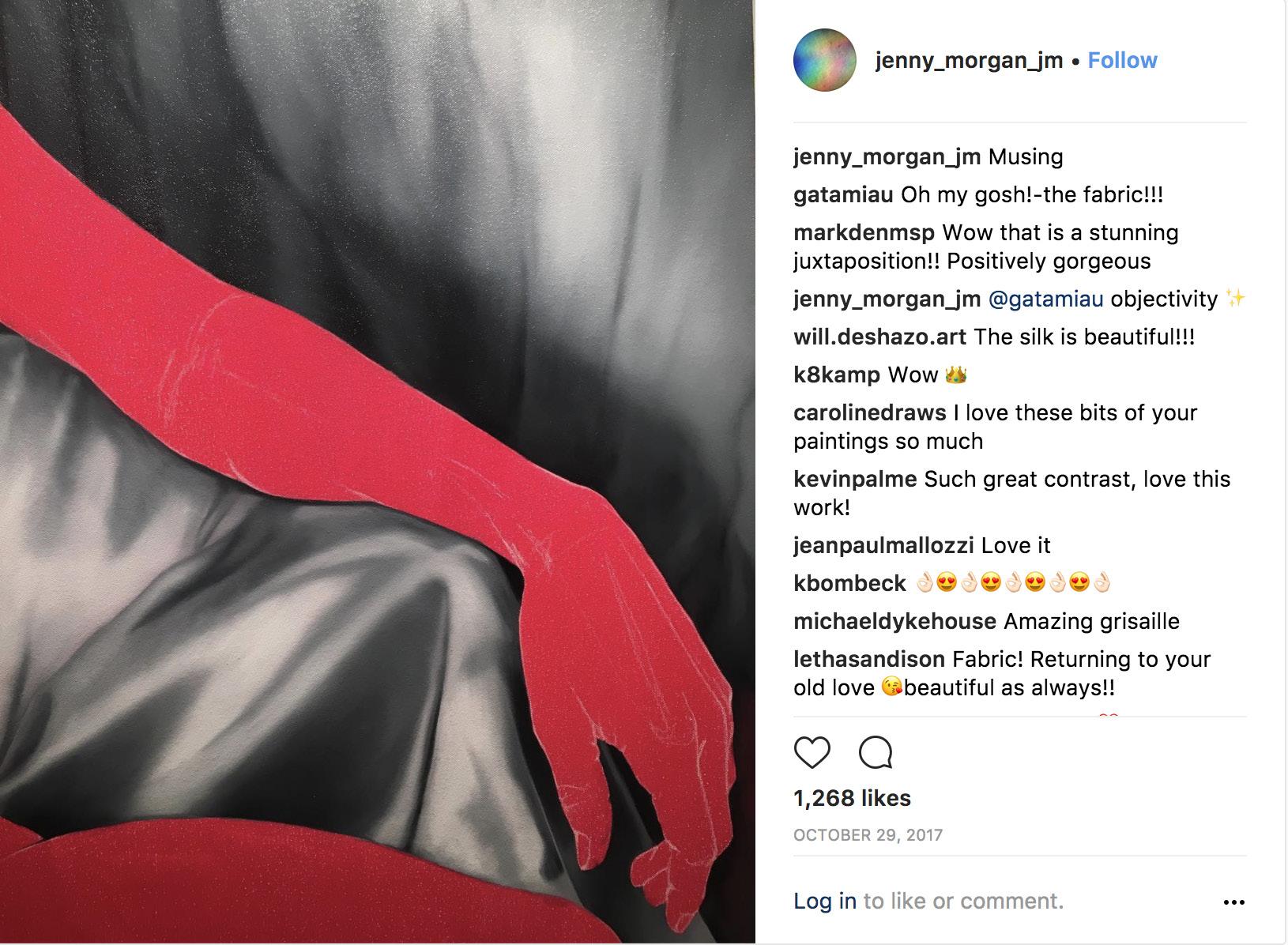

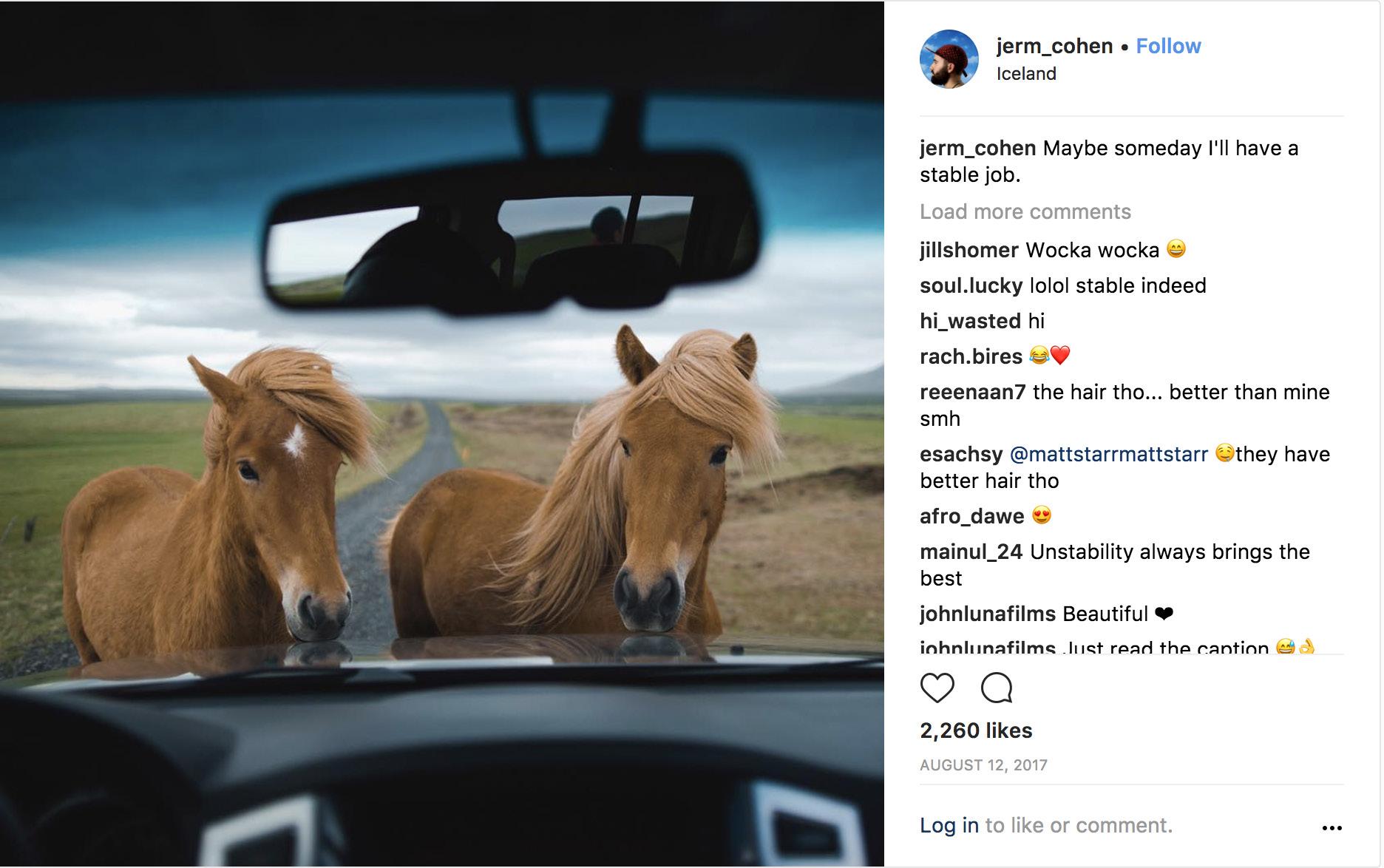
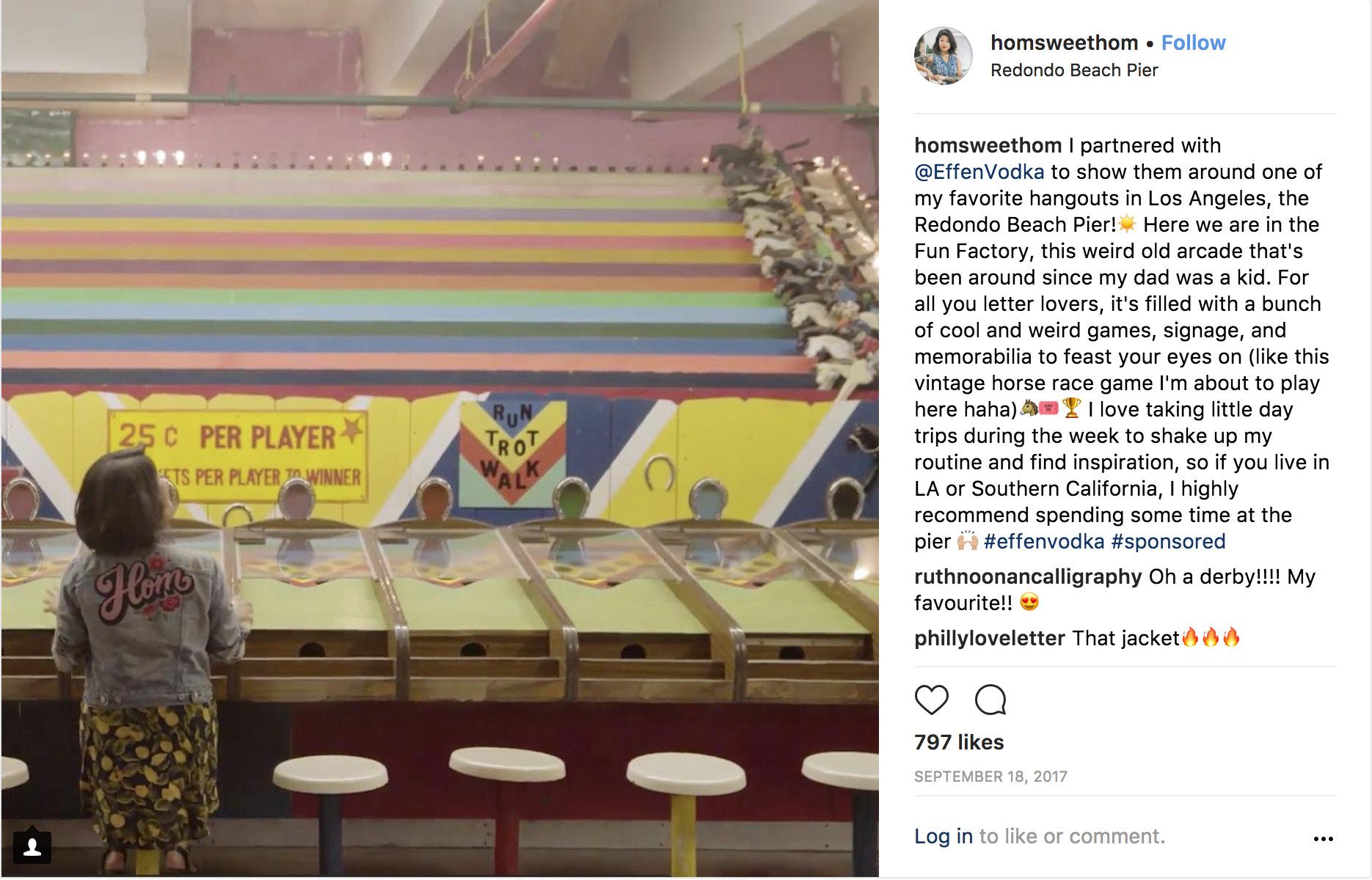
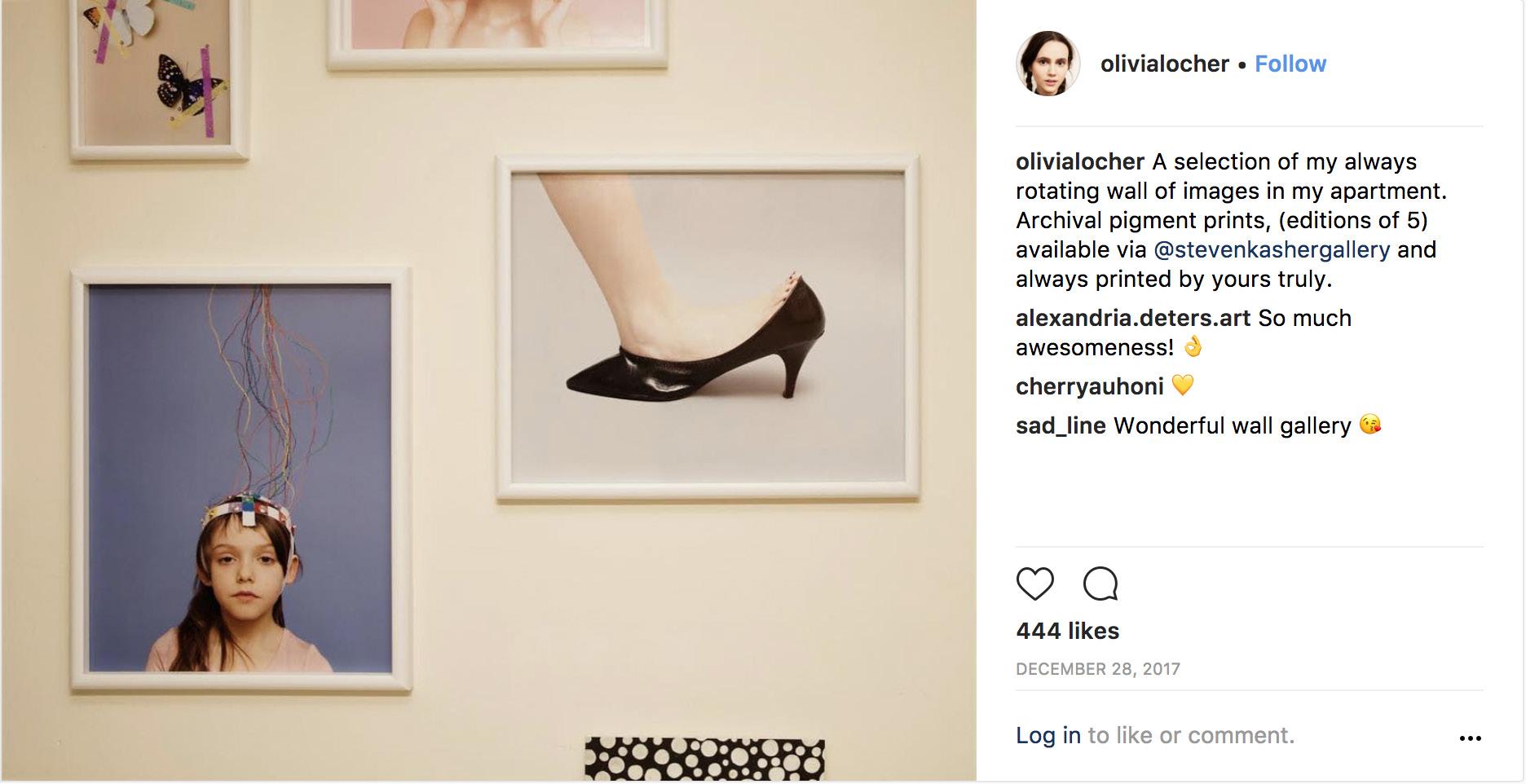

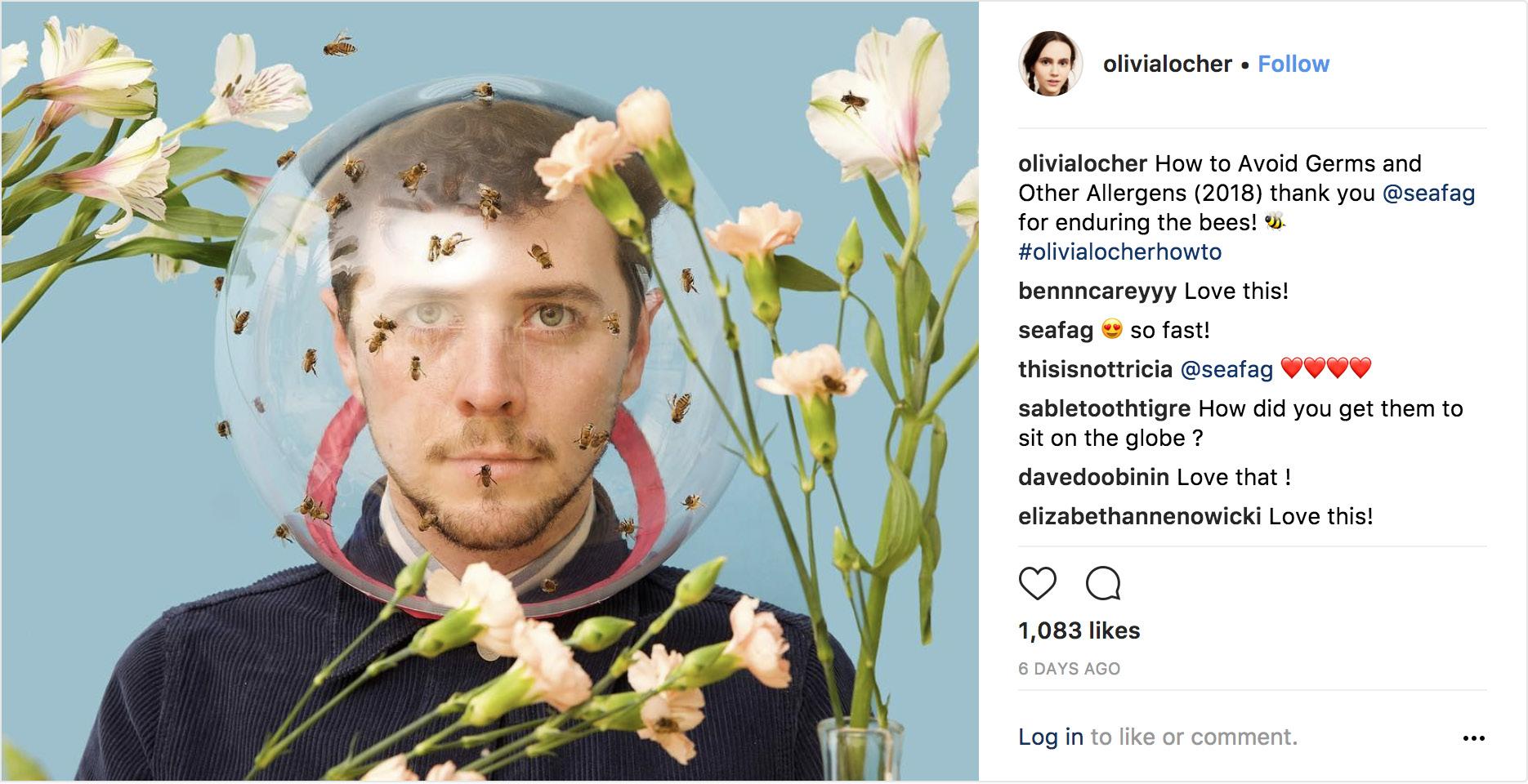
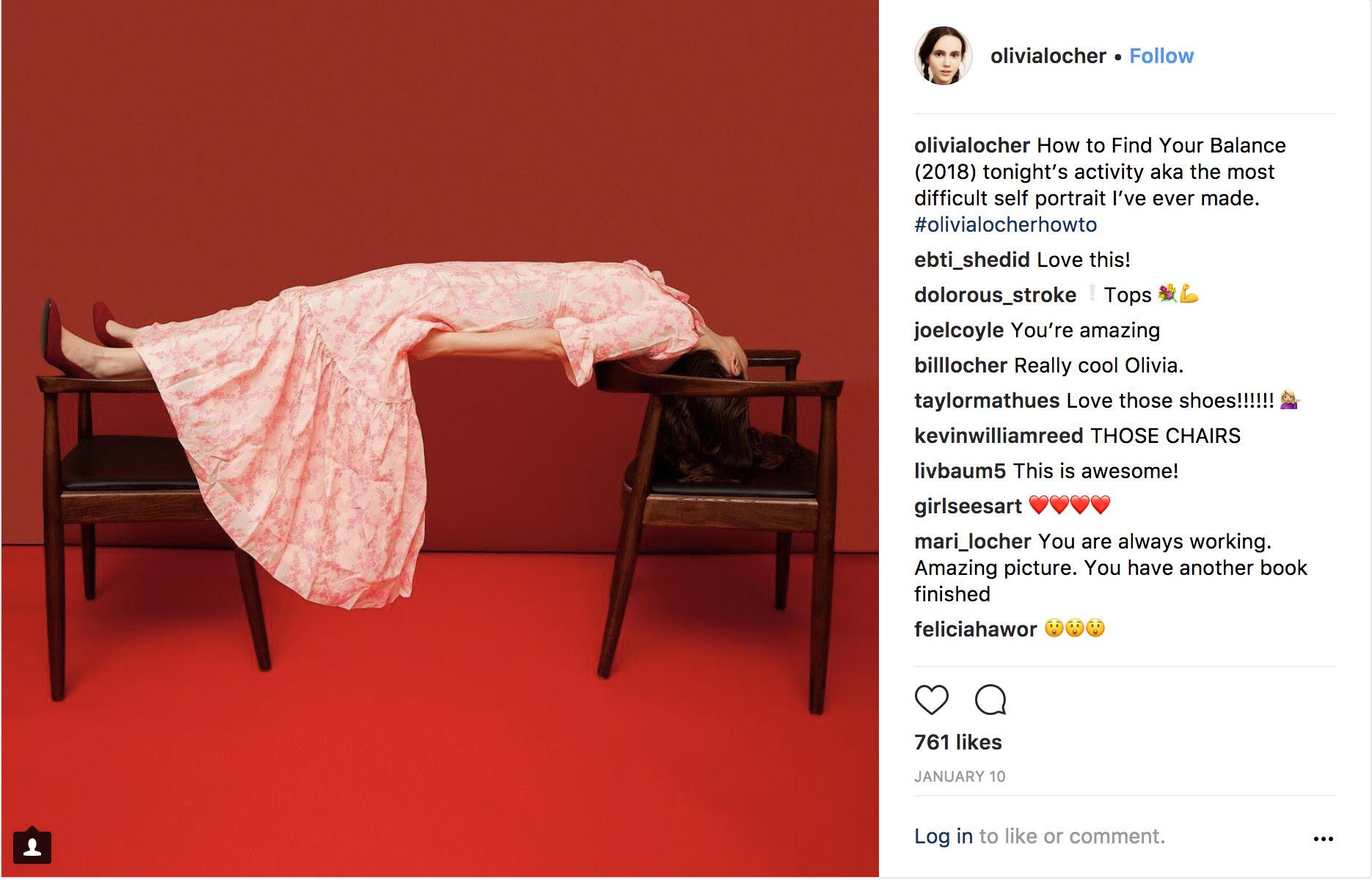

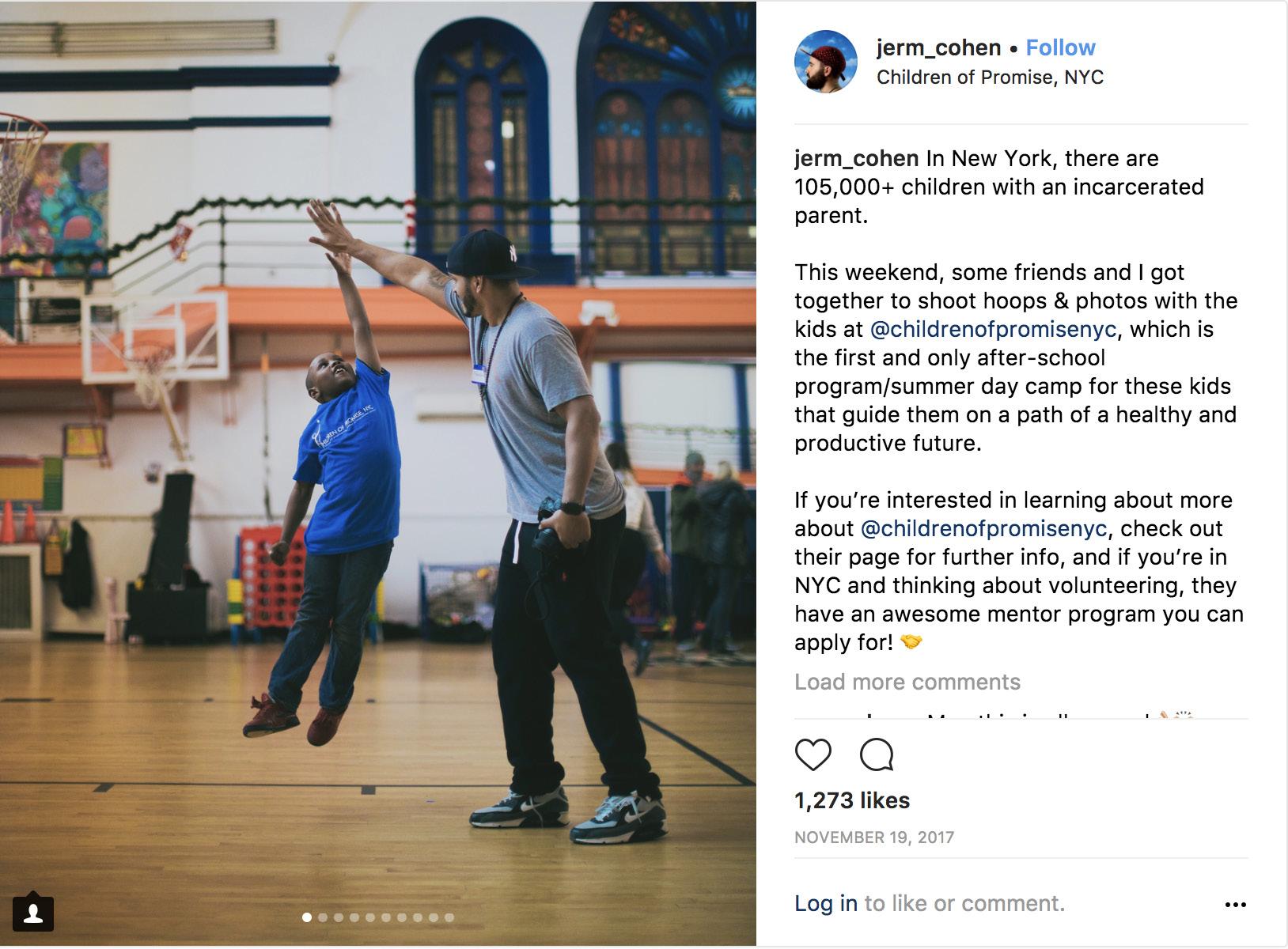
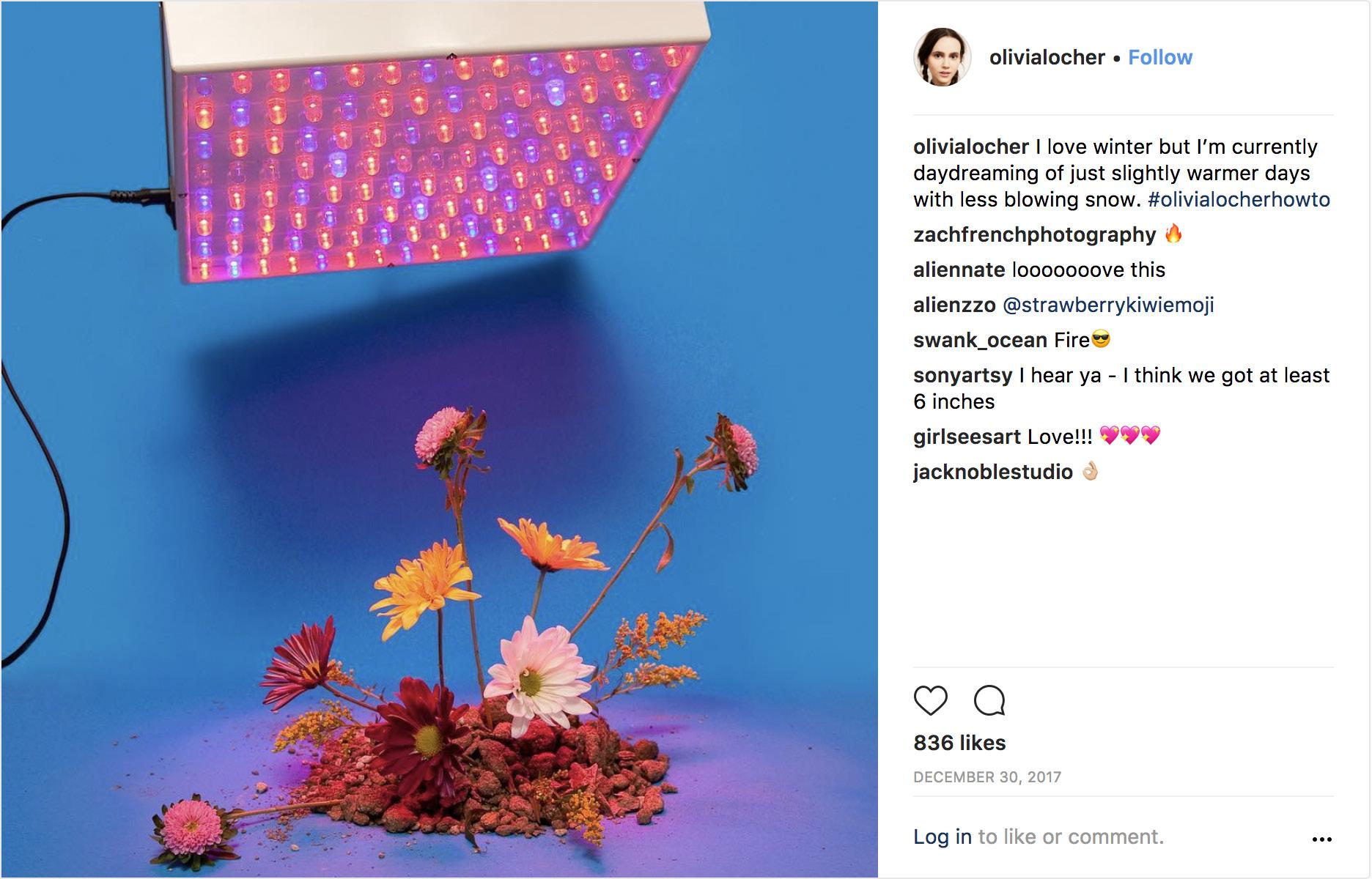
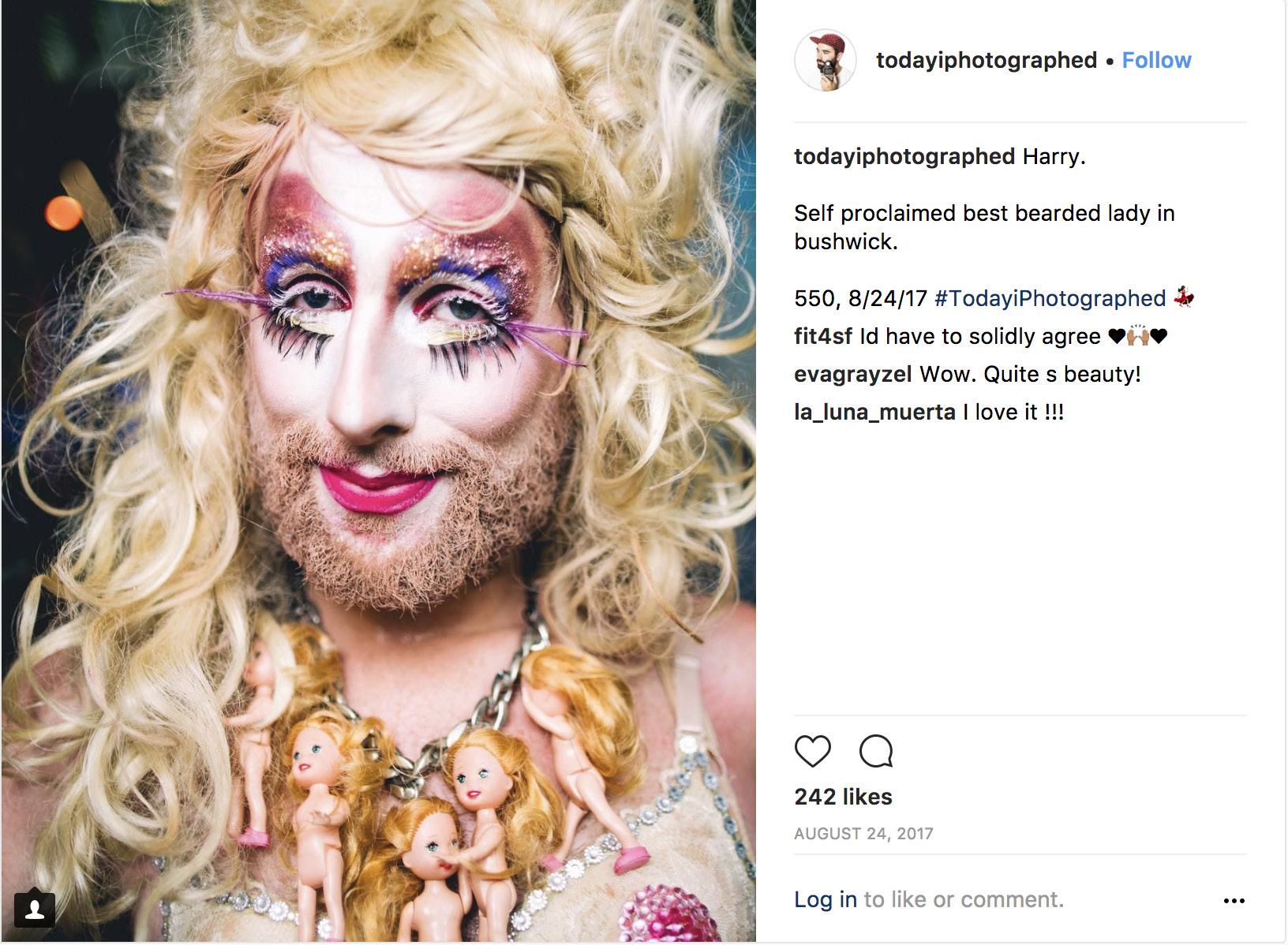
It’s
Instagram’s
world, and we’re all just living in it.
The Facebookowned, image-based social media platform reached 700 million monthly active users last year, which means 700 million monthly opportunities to scroll through fi ltered photos of sunsets, brunches and the Brooklyn Bridge. Fortunately, nestled among those millions of users is a community of artists using the platform to create and share discourse-worthy work.
We caught up with four SVA graduates with sizeable Instagram followings to find out how they have integrated the platform into their careers. Jeremy Cohen (BFA 2014 Photography) has over 140,000 followers across his two
Instagram accounts, @jerm_cohen and @todayiphotographed, and specializes in portraiture. He has worked with everyone from major brands like Dunkin Donuts and Mercedes Benz to stars like Miley Cyrus. Lauren Hom (BFA 2013 Advertising), @homsweethom, is a hand-letterer and illustrator with over 118,000 followers. Her clients include Google and Starbucks and in 2014 she published Daily Dishonesty
(Abrams), a collection of work posted to her account on another social media platform, Tumblr. Olivia Locher (BFA 2013 Photography) has 76,000 followers for her account, @olivialocher. She has photographed for The New York Times Magazine and Vanity Fair; last year she published her first book, I Fought the Law (Chronicle). And painter Jenny Morgan (MFA 2008 Fine Arts)— @jenny_morgan_jm; 32,000 followers—focuses on nude portraiture. Her work has been shown in galleries from New York to Colorado to London, and has been featured in such magazines as New York and Juxtapoz.
When did you join Instagram? Was it originally something you intended to use as a platform for your work or just as personal social media?
Olivia Locher I joined sometime in 2012 after hearing a lot of my friends working in creative fields boasting about how great it was. I was initially pretty clueless to how it all works. I was posting ugly, low-quality phone images. As time progressed, people started using it in a much smarter way, and my posts also matured.
Lauren Hom I joined in 2013, but I stumbled across Instagram [as a career tool] almost by accident. I was waiting for the train one night and I snapped a photo of my sketchbook in my hands on the subway platform. Before that moment I had never really thought to share my process on Instagram. I just happened to one night and I realized that the photo I posted of just my crappy sketchbook got almost triple the number of likes my photos usually got. I was like, “Hmmm, maybe people would like to see more of that.”
Jeremy Cohen I was a freshman at SVA when Instagram launched. I downloaded it, posted a photo of a dog I saw through a car window and then didn’t really use it too much for a few years. It wasn’t until 2013 that I saw the potential of the platform and started to take it more seriously.
Jenny Morgan I joined in 2011, soon after the app was started and before it had such a large community. At that time, I used it as a way to connect with close friends and occasionally post images of my work in process. Over the past six years, I’ve witnessed the magnitude of Instagram’s development and the impact it’s had on the way art is shared and viewed.
Was there a specific moment or post that seemed to be the tipping point for your developing a following on the platform?
JC: I went to an Instagram/bicycle meet-up in fall 2013, which in retrospect turned out to be one of the best decisions I’ve ever made. It was there that I got connected with the Instagram community of New York City. After that, I was motivated to start posting more. I started making projects through hashtags, like #pizzaportraitz and #emojiportraits. At the time, Instagram had this feature where it would suggest users [for people to follow] in a two-week rotation. Sometime later that year, I was picked as a suggested user and was flooded with new followers.
OL: At fi rst I started using Instagram as another way to see what my friends were up to. Instagram was—and still is—a great way to get recommendations for things like art shows, albums and co ee shops. After I started working with commercial clients in 2013, I saw the strong emphasis on sharing your work and tagging your team. It’s basically a requirement these days to get as many eyes on something as possible. Instagram also made me a suggested user.
LH: It never really occurred to me before that you could use Instagram to post images you had designed. I just thought, like everybody else, that Instagram was for photos taken from your phone in real time. Once I realized
“
I realized that the photo I posted of just my crappy sketchbook got almost triple the number of likes my photos usually got. I was like, ‘Hmmm, maybe people would like to see more of that.’”
I could upload a JPEG, and it didn’t matter if I had designed it two years ago or yesterday—it just snowballed from there.
Do you have a strategy when it comes to what you choose to post? How, if at all, do you curate your feed?
JC: I treat my feed as a portfolio. When someone views my profi le, I want it to look good at fi rst glance. I set up posts strategically so they’ll look cohesive and clean as a whole. I do this by varying colors, compositions and subject matter. I use an app called UNUM, which allows me to drag and drop photos easily to see what they’ll look like in my feed before I post.
JM: I try to maintain an intuitive relationship with the platform. I don’t
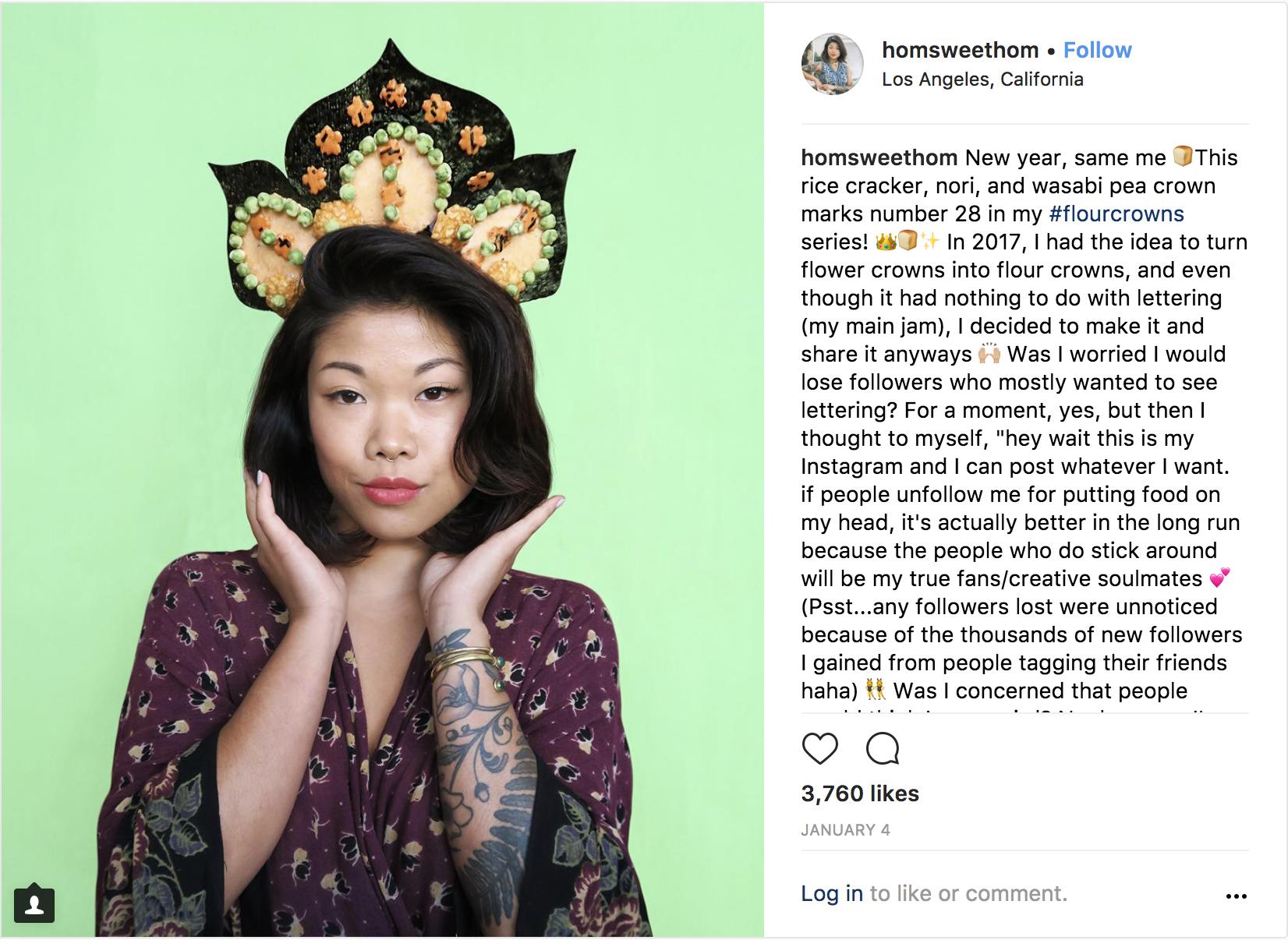
operate in terms of strategy; instead, I focus on what feels positive and relevant for me to share with a viewing audience. Instagram is an intensely complex matrix—the confluence of imagery and opinion. I think of my feed as a reflecting pool. I understand that what I post will shape the way the world views my work and me as an individual. When my following started to really grow, I chose to be less open with my personal life in order to protect myself a bit.
OL: I don’t have a strategy, per se. Sharing my work is obviously my favorite part of the app and the most rewarding. Sometimes it feels like a huge pressure to be prolific, so I end up sharing a lot of lifestyle stu and self-portraits. Instagram has made the demand on visual artists very tough. The reality is we don’t always have new pieces to share. My Instagram is a true extension and balance of my life and work. I share things that I’m experiencing: books, fi lms, concerts—and most importantly, my studio practice.
LH: I try to do everything organically. There’s this sense of urgency and anxiety that people tend to get about social media. I understand the strategy [of posting on a regular schedule], but now that I’m a little bit more established I tend to post when I feel like it and worry less about Instagram’s algorithm. I also write pretty hefty captions to go with my posts. They’re almost like miniature blog posts.
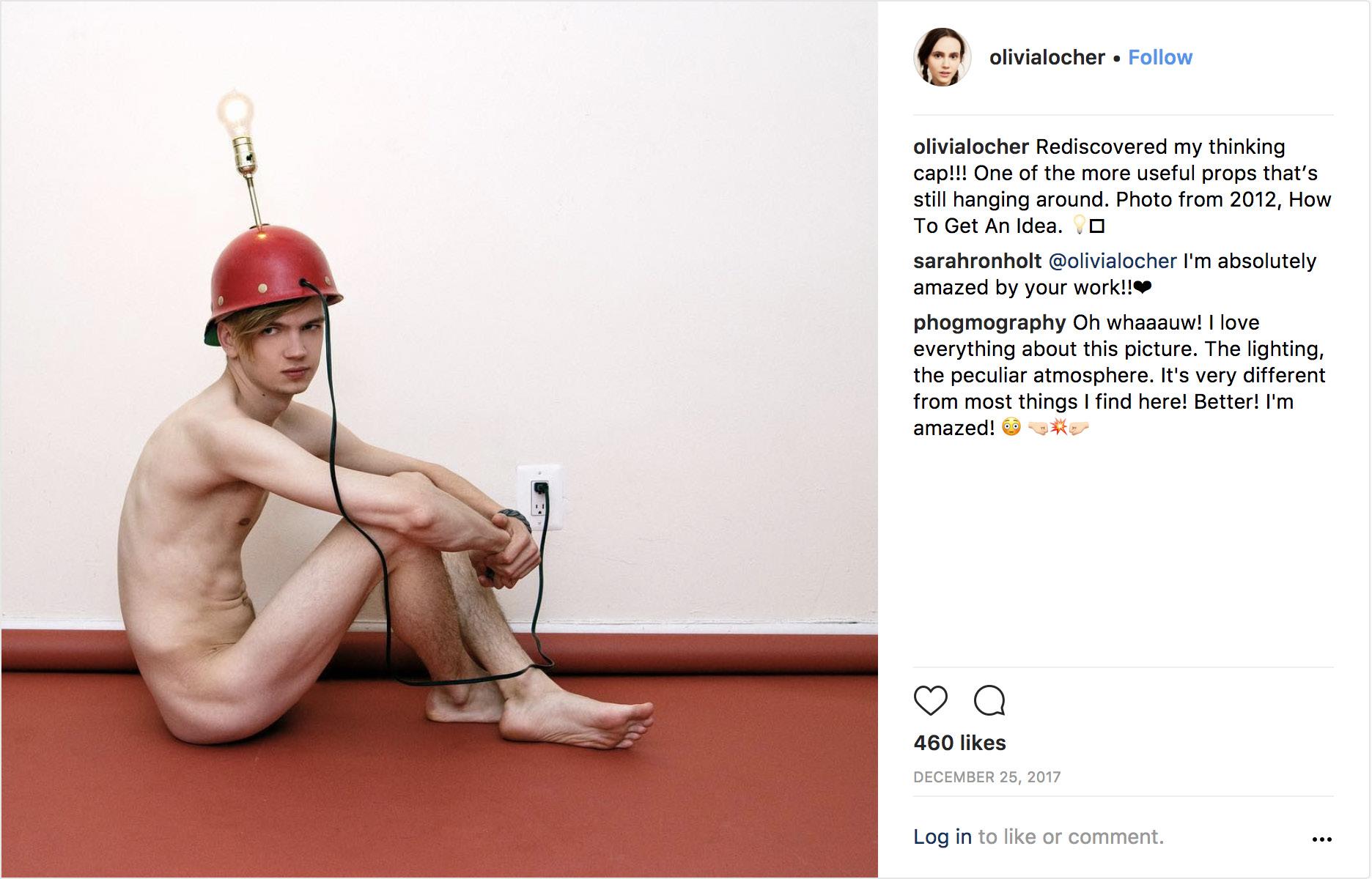
Instagram has faced a lot of flak for how it handles “graphic” or so-called NSFW (not safe for work) imagery. Has this been something that has affected you?
JM: I work with the nude and most often female [nudes], so I’m usually crossing a boundary with my work in general. There are many complex social boundaries around the female nude. I’m never surprised or angered when an image I post is flagged because it crossed a viewer’s personal comfort zone with exposure or vulnerability. I’m hyper-aware that my content is of a sensitive nature. Artists challenge social norms through their imagery, and I think the platform is still learning how best to monitor and police artistic expression.
Do you find your followers respond more strongly—either in positive or negative ways—to certain types of posts?
OL: I try not to pay attention. I’ve found the things that are the most personal always get the lowest amount of likes. Unfortunately, I’ve also found self-portraits always generate the most likes.
ABOVE An Instagram post by photographer Olivia Locher. “Instagram has made the demand on visual artists very tough,” she says. “The reality is we don’t always have new pieces to share.”
JM: I fi nd that followers are more attracted to images of artwork as opposed to personal posts, and when it comes to the work itself, strong bright colors are most “liked.” This observation feels extremely simplistic in terms of art making, which is why I try to not focus on the popularity of any given post.
Have you run into any trouble with your work being stolen or re-shared sans attribution?
JC: Absolutely, but that’s part of the whole game of anything being online. What’s the other option—not posting? That’s not a good idea if you want your work to be seen. Another option is watermarking, but the only watermarked images are usually ones that people don’t want to steal anyway. Similar to how parents can be overprotective, I think it’s important as a photographer to not live in fear of your images being stolen.
LH: I have always been of the mentality that the pros outweigh the cons when it comes to sharing your work on social. The reason I have my entire lettering career is because I started a Tumblr with my work. I think CEOs, people who run brands, art directors and creative directors at companies, they use Instagram the same way we all do—randomly scrolling through their “explore” feed. You never know who is going to see things.
Have you ever gotten an assignment or sold a piece via Instagram?
JC: Instagram actually furthered my career a lot. In 2014, the agency 247LS reached out to me to shoot a part of their campaign with Beats By Dre. From that gig, they started representing me as a photographer and influencer to shoot for a bunch of di erent brands and I’m still working
“
I think it’s important as a photographer to not live in fear of your images being stolen.”
with them and their sister agency, Cycle, three years later.
JM: The platform is helpful for showcasing new work and receiving inquiries. I’ve primarily worked within a gallery context, so I haven’t made direct sales through the platform, but it’s added in sharing work and exposure. One of the most beneficial aspects is the ability to connect with people directly and the opportunities that an open channel can bring.
Over all, has Instagram been a benefit to the art world? How has it changed the way art is shared?
JC: There’s no denying Instagram has changed art, and in my opinion, for the better. Although I enjoy sometimes slowing down and walking through galleries, they are no longer necessary for me to get inspired when there is so much good art on Instagram that is always fresh and up to date. As an artist trying to sell work via Instagram, it’s all in your control. Artists don’t need a gallery name for validation and definitely don’t need them to take that fee of all sales. I think because of this, these galleries will fade away, and the physical space of where to share printed photos will change sooner than later. Instagram gives artists the power to thrive more e ciently without jumping through hoops.
OL: Absolutely. It’s such a lovely way to connect with people. I get the greatest recommendations from the people I’m following.
JM: I think social media is like any other technological advancement—it doesn’t matter what I think or feel about it because it is a profound growth that will continue to morph and develop. I fi nd that, as an artist, the positives outweigh the negatives. The pitfalls in the system are there, but can be worked around and understood, like any other tool. The benefits are massive—it’s given people access to art and community to a profound degree. ✸
Interviews have been condensed and edited.
MADISON MALONE KIRCHER is an associate editor at New York magazine, where she covers digital culture. She lives in Brooklyn.
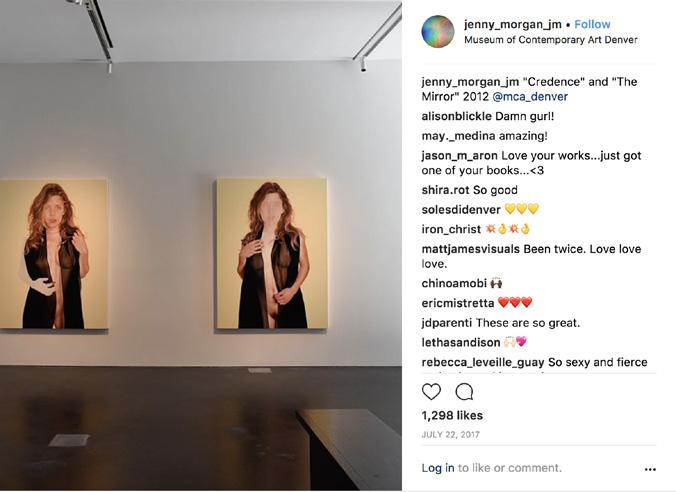
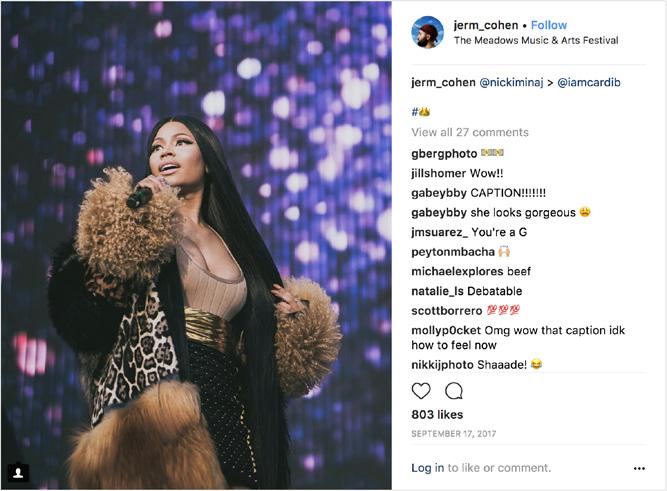
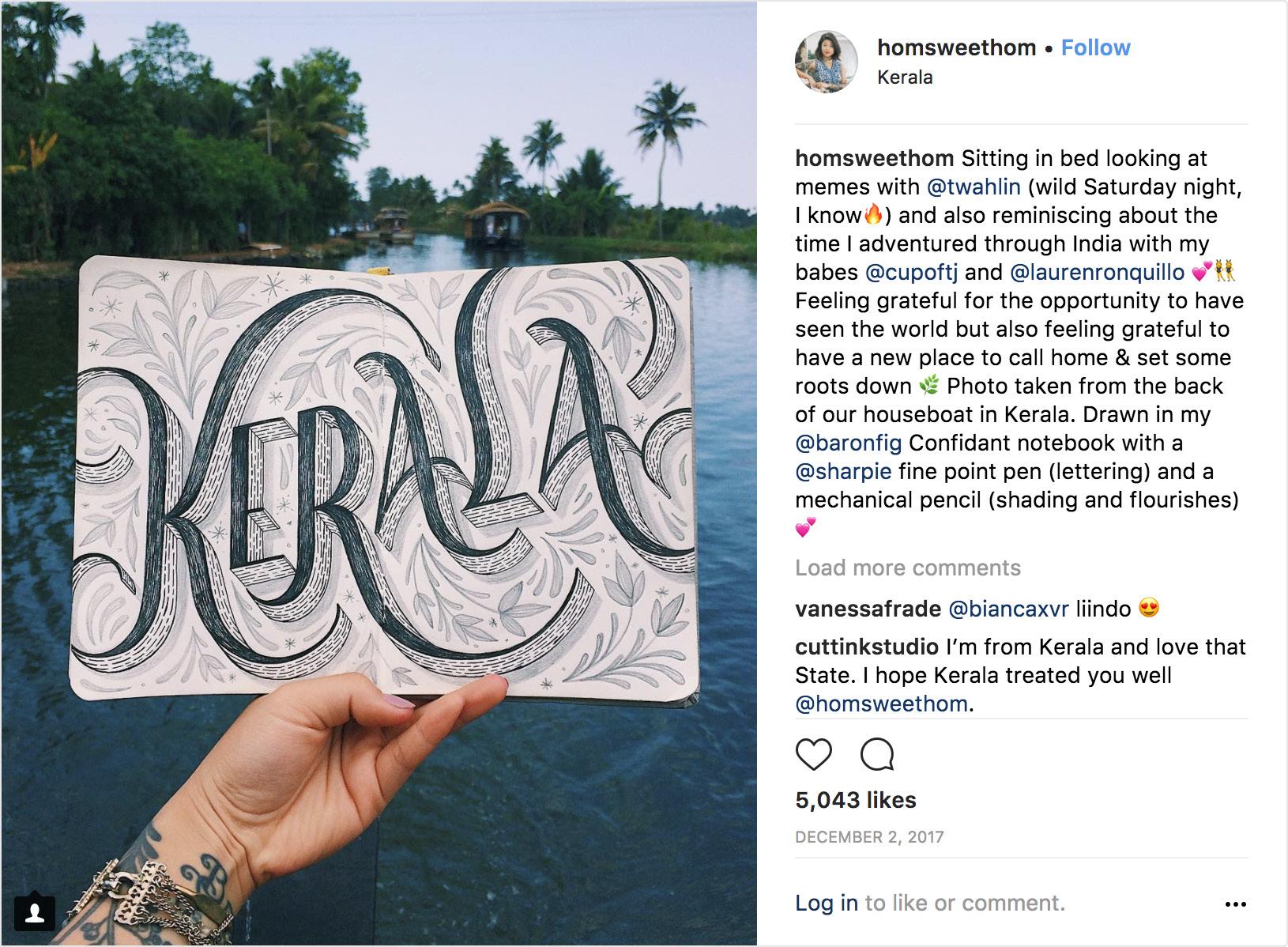
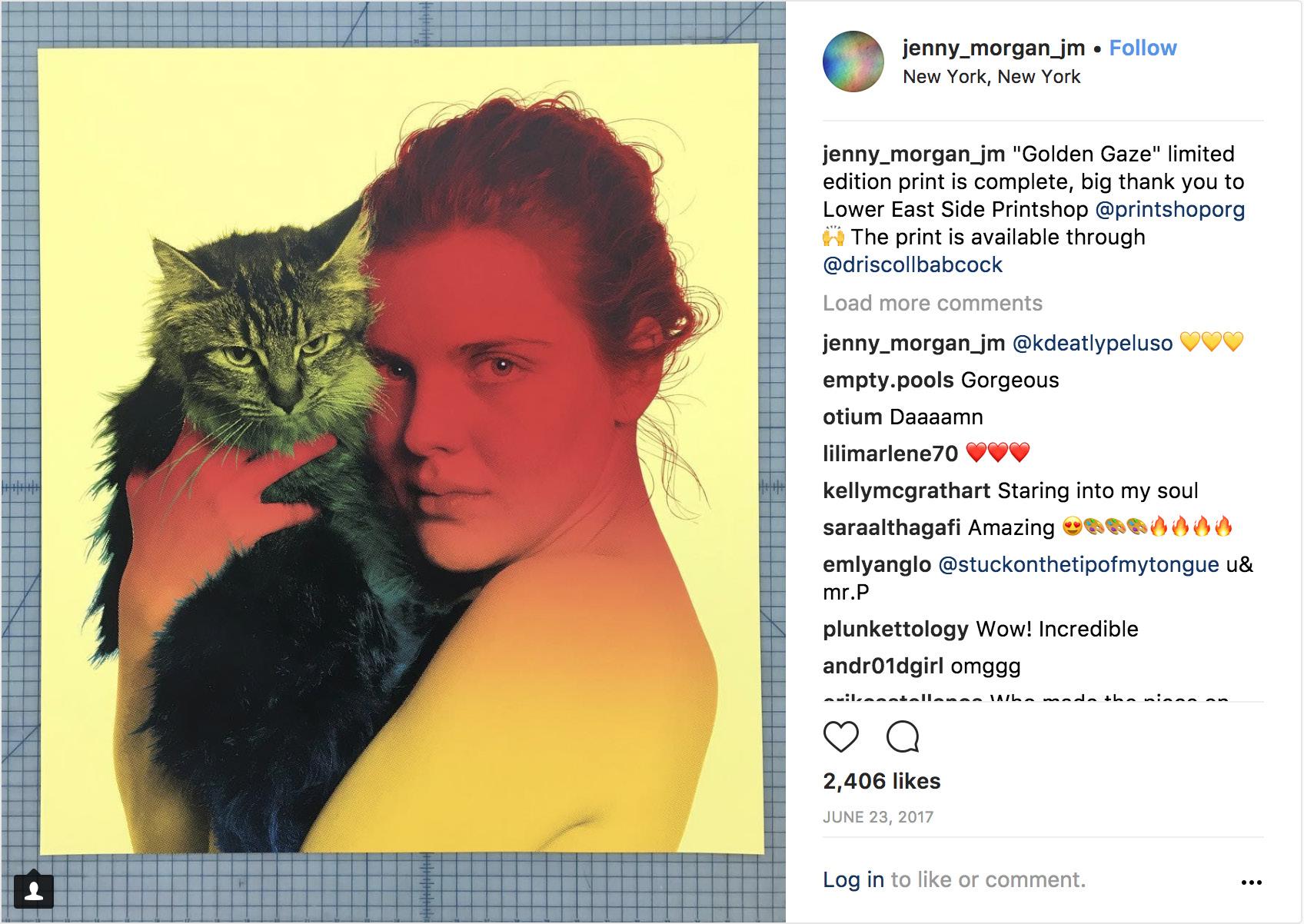
ON THIS PAGE Instagram posts by painter
and
photographer
(top right) and illustrator
mix finished work with behindthe-scenes glimpses of their working lives. “I try to maintain an intuitive relationship with the platform,” Morgan says. “When my following started to really grow, I chose to be less open with my personal life in order to protect myself a bit.”




ALUMNI AFFAIRS

✳ For more information about the SVA Library, visit sva.edu/library. For alumni instructions regarding library access, computer login credentials and printing at the library, and for a full list of alumni benefi ts, visit sva.edu/alumni. Questions? Call 212.592.2300 or email alumni@sva.edu.
Recharging Station: A Hangout at the Heart of the SVA Community
rich with resources. Tailored to fit the needs of all manner of creative professionals, the library is not just a benefit for students—it is an asset for alumni, particularly those based in New York City.
ABOVE As with the main branch at 380 Second Avenue, alumni are welcome at the new SVA Library annex, in the lower level of the College’s 133/141 West 21st Street building.
A message from Jane Nuzzo, director of SVA Alumni Affairs and Development
✺Sociologist Ray Oldenberg first pioneered the concept of the “third place”—a location free of the demands and associations of one’s home or workplace—in his 1989 book The Great Good Place. A third place could be any favorite hangout spot—a café or diner, a community center or park—as long as it is somewhere one can reliably find good company, good conversation and comforting surroundings. And as anyone who has spent any time browsing its shelves knows, the SVA Library delivers on all fronts: It is an accessible, inviting, informal place to spend time,
The library’s holdings go beyond the typical academic or scholarly texts to include underground comics, graphic novels, digital and analog image collections, DVDs, rare books, artists’ books, published alumni works, the SVA Archives, illustrated children’s books, countless periodicals and popular fiction. The library is also home to a sizable computer lab (including Macs, several Cintiqs, scanners and printers), charging stations and wired tables. And all of this is available to alumni, free of charge.
In addition to the main library, located at 380 Second Avenue, SVA recently opened its newly renovated library annex and lounge, in the lower level of the College’s 133/141 West 21st Street building (see page 6). Known as SVA Library West, this space and all its amenities—including meeting rooms, scanners and printers—are open to alumni, too.
Need a third place? Whether it’s to research an art or design project, catch up on your reading or even just to kick back and watch a movie, look no further than the SVA Library. And noshers, fear not: Beverages and snacks are welcome!
SVA ALUMNI SOCIETY AWARDS SPRING 2018
Thanks to generous contributions from alumni and supporters, the SVA Alumni Society was able to grant more than $64,000 in awards to these students in support of their thesis projects.
ALUMNI SCHOLARSHIP AWARDS
Smruti Adya, MFA Products of Design
Razan Alsarraf, BFA Fine Arts
Angela Arzumanyan, BFA Computer Art, Computer Animation and Visual E ects
Storm Ascher, BFA Visual & Critical Studies
Astrid Bai, MFA Art Practice
Ken Castaneda, BFA Photography and Video
Johnnie Chatman, MFA Photography, Video and Related Media
Andrea Cordoba, MFA Social Documentary Film
Kaitlyn Danielson, BFA Photography and Video
Louis Elwood-Leach with thesis partner
Jingting He, MFA Products of Design
Lydia Fama, BFA Animation
Amanda Finuccio, MFA Design for Social Innovation
Yuka Fukuoka, MFA Design for Social Innovation
Caroline Goessling, BFA Photography and Video
Jing Han, MFA Fine Arts
Saya Hanawa, MFA Fine Arts
Ran Huo, MFA Computer Arts
Yibo Jiang, MFA Computer Arts
Brendan Jo, BFA Photography and Video
Dongjun Kim, MFA Computer Arts
Noelia Lecue, MA Curatorial Practice
YenJuen Lee, MFA Computer Arts
Nour Malaeb, MFA Interaction Design
Forrest Muelrath, MFA Art Writing
Julianne Nash, MFA Photography, Video and Related Media
Hanna Nordenswan, MFA Social Documentary Film
Denian Ouyang, MFA Computer Arts
Deepa Paulus, BFA Computer Art, Computer Animation and Visual E ects
Bella Randle Racklin, MFA Social Documentary Film
Azucena Romá, MFA Interaction Design
Jackie Snyder, BFA Animation
Mahya Soltani, MFA Design
Andy Tai with thesis partner Eduardo Enriquez, BFA Computer Art, Computer Animation and Visual E ects
Erika Verhagen, BFA Visual & Critical Studies
Natalia Viera Salgado, MA Curatorial Practice
Regina Viqueira, MFA Fine Arts
Sonja von Marensdor , BFA Animation
Cindy Xin, MPS Directing
Flora Zhai, BFA Fine Arts
Gracie Yue Zhang, BFA Interior Design
Rui Zhu with thesis partner Yiyi Abby Shao, BFA Computer Art, Computer Animation and Visual E ects


NAMED FUND AWARDS
727 Award
Grace Milk , BFA Illustration
Chelsea Rust , BFA Illustration
Anyu Wu, BFA Illustration
Amelia Geocos Memorial Award
Melody Sakura , BFA Fine Arts
BFA Illustration and Cartooning Award
Seung Won Chun, BFA Illustration
Hai Fei Xie, BFA Illustration
Ora Xu, BFA Illustration
Bob Guglielmo Memorial Award
Lizzy Itzkowitz, BFA Cartooning
Edward Zutrau Award
Alicia Smith, MFA Fine Arts
Jack Endewelt Memorial Award
Bowen McCurdy, BFA Cartooning
James Richard Janowsky Award
Isabel Montes, BFA Film
MFA Illustration as Visual Essay Award
Anagh Sumanta Banerjee, MFA Illustration as Visual Essay
Annelise Capossela , MFA Illustration as Visual Essay
Joseph Gough, MFA Illustration as Visual Essay
Giselle Harrington, MFA Illustration as Visual Essay
Robert I. Blumenthal Memorial Award
Youn Jae Lee, BFA Design

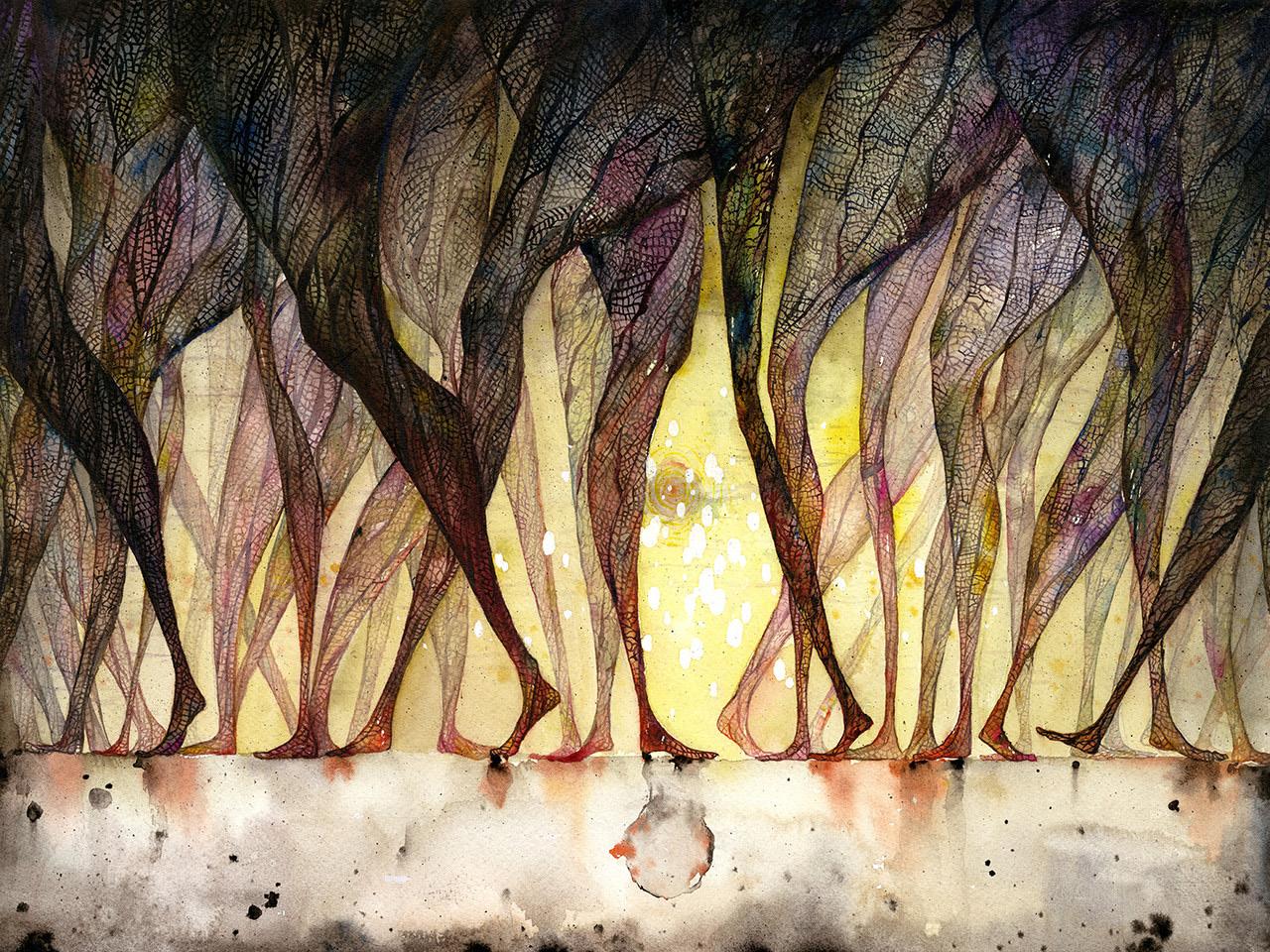
Sylvia Lipson Allen Memorial Award
Johmaris Ramos, BFA Fine Arts
Juliette Sardou, BFA Fine Arts
Thomas Reiss Memorial Award
Naixin Xu, MFA Photography, Video and Related Media
Will Eisner Sequential Art Award
Alex Barsky, MFA Visual Narrative
Alfonso de Anda, MFA Illustration as Visual Essay
Matthew Murphy, MFA Visual Narrative
Kenny Nam, MFA Visual Narrative
Yiqing Zhang, MFA Illustration as Visual Essay
William C. Arkell Memorial Award
Alex Alviar, BFA Film
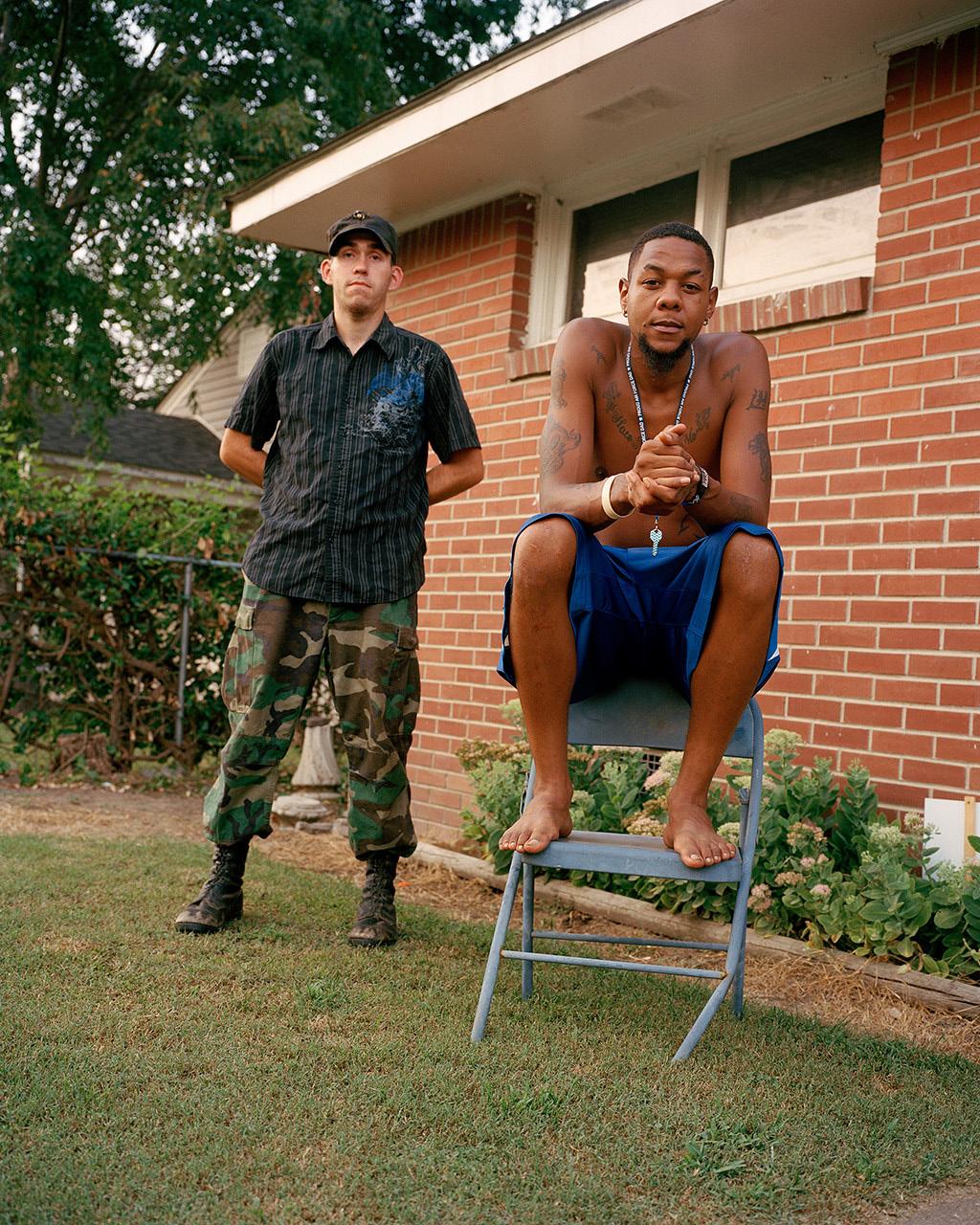

DONORS
The SVA Alumni Society gratefully acknowledges these alumni, who gave to the society from July 1, 2017 – December 31, 2017.
Kim Ablondi
BFA 1984 Photography
Arthur Ackermann
BFA 1982 Cartooning
Al Adasse E 1968
Manuel D. Aleman
BFA 2011 Advertising
Andrew P. Alexander
BFA 2016 Cartooning
Evelyn M. Alfaro
BFA 1985 Advertising
Juan Alfonso E 1982
Peter Allen
MFA 1985 Fine Arts
Adam P. Ames
MFA 1997 Photography and Related Media
Michael J. Angley
G 1971 Advertising
Anonymous (3)
Sara Bailin
MPS 2011 Live Action
Short Film
Ava L. Berman
BFA 2013 Cartooning
Maxwell L. Beucler
BFA 2015 Design
Kimberlie A. Birks
MFA 2011 Design
Criticism
Cynthia Bittenfield
MFA 2009 Photography, Video and Related Media
Eva Bokosky
BFA 1978 Illustration
Barbara A. Browne
G 1970
John Bruce
BFA 1987 Fine Arts
Julianna Bruce
BFA 1986 Fine Arts
Sharon Burris-Brown
BFA 1984 Illustration
Matthew D. Burrows
MFA 2013 Illustration as Visual Essay
Brian Callaghan
BFA 1977 Media Arts
Tricia Candemeres
E Illustration
Carol Caputo
G 1960 Graphic Design
Frank Caruso
BFA 1985 Cartooning
Kevin J. Casey
BFA 1976 Photography
Carlos R. Castro
BFA 1991 Advertising
Paul K. Caullett
BFA 2000 Graphic Design
Terese Cavanagh
1968 Media Arts
Je rey Chabot
MFA 1997 Photography and Related Media
Frederick Chandler
G 1969 Film and Video
Andrew Chang
MFA 1987 Illustration as Visual Essay
Anthony Chibbaro
E 1979
Alice E. Meyers
Corjescu
E 1974 Fine Arts
Julia and Phil Coyne
BFA 1988 Media Arts
BFA 1986 Media Arts
Cora Cronemeyer
E 1966 Fine Arts
Christine Cucuzza
BFA 1997 Graphic Design
Charles Curcio
BFA 1983 Illustration
Therese S. Curtin
BFA 1980 Illustration
Michael Daly
BFA 1985 Media Arts
Diane Dawson Hearn
BFA 1975 Illustration
Peter S. Deak
BFA 1990 Film and Video
Cat Del Buono
MFA 2008 Photography, Video and Related Media
Haydee Diaz
BFA 1986 Graphic Design
Rael Jean
DiDomenico-Schwab
BFA 1990 Advertising
Candace (alumnus) and Je rey Dobro
MPS 2010 Digital Photography
Jack Donnelly
E 1972
James Ewing
E 1973
Carol Fabricatore
MFA 1992 Illustration as Visual Essay
Dina M.
Ferrante-Smyth
BFA 1985 Photography
Diane Fienemann
BFA 1984 Photography
Jeanne FinneranMillett
BFA 1985 Media Arts
Brian K. Floca
MFA 2001 Illustration as Visual Essay
Lawrence Flood
BFA 1980 Fine Arts
David Fried
BFA 1987 Photography
Peter Ge ert
BFA 1990 Advertising
Catherine GilmoreBarnes
BFA 1986 Graphic Design
John and Lauren
Giu re (alumnus)
BFA 1986 Illustration
Dustin Grella
MFA 2009 Computer Art
Catherine K. Gura
BFA 1998 Illustration
Ruth Harris E 1974
Meghan Day Healey
BFA 1993 Graphic Design
Jean Held E 1969
Lyn Hughes
BFA 1981 Photography
Genevieve T. Irwin
MFA 2017 Illustration as Visual Essay
Nanette Mahlab Jiji
BFA 1981 Illustration
Bonnie Sue Kaplan Valentino
G 1971 Advertising
Melvyn Kay 1979
Eun Jung Kim
BFA 1999 Interior Design
John Klammer
E 1979 Illustration
Sardi Klein
G 1970 Photography
Alexander Knowlton
BFA 1987 Graphic Design
Robert Kohr
BFA 2003 Animation
Jean Kooi
BFA 1978 Media Arts
Abby Kreh
G 1962 Illustration
Steven Langerman
G 1972 Photography
J.P. Lee
MFA 1991 Computer Art
Michael Lee
E 1968
John Lefteratos
BFA 1988 Graphic Design
David B. Levy
BFA 1995 Animation
Suhyun Lim
BFA 2015 Illustration
Missy Longo-Lewis
BFA 1984 Illustration
Roxanne Lorch Lipman
E 1984
Sakura Maku
BFA 2004 Illustration
Laura Maley
BFA 1978 Fine Arts
Samuel C. Marcus
BFA 2008 Photography
Patrick McDonnell (alumnus) and Karen O’Connell
BFA 1978 Media Arts
David Moir
G 1975 Photography
Robert Moore
BFA 1976 Fine Arts
Bethanie Deeney
Murguia
MFA 1998 Illustration as Visual Essay
Lauren R. Nelson Drost
MAT 2005 Art Education
Renee Nyahay-Gonzalez
BFA 1985 Graphic Design
Susan Koliadko
O’Brien
BFA 1984 Graphic Design
Nancy Boecker Oates
E 1980 Media Arts
Morenike Olabunmi
BFA 1983 Film and Video
Romaine Orthwein
MFA 2003 Photography and Related Media
Edith Ostrowsky
E 1972
Mr. and Mrs. Kevin
Petrilak (alumnus)
BFA 1976 Animation
Gary Petrini
E 1979 Media Arts
Todd L. Radom
BFA 1986 Graphic Design
Robert F. Ratynski
BFA 1984 Photography
Nicole S. Ray
BFA 2003 Illustration
Elaine Rene-Weissman
BFA 1976 Fine Arts
Lisa Rettig-Falcone
BFA 1983 Advertising
Vernon C. Riddick G 1973
Barbara Rietschel BFA 1976 Media Arts
Eileen Robert E 1973
Jorge Luis Rodriguez
BFA 1976 Fine Arts
Jaime Cody Rosman
MPS 2014 Digital Photography
Marc Rubin
BFA 1982 Advertising
Joseph M. Rutt
BFA 1985 Illustration
Linda Saccoccio
MFA 1991 Fine Arts
Gabriella A. Santorelli
BFA 2011 Animation
Gini Santos
MFA 1996 Computer Art
Herb Savran
BFA 1977 Film and Video
Joel Scharf
BFA 1983 Graphic Design
Joe Schwartz
BFA 1988 Graphic Design
Heewon Seo
MFA 2012 Fine Arts
Charles Sforza and Mary Moran
BFA 1982 Advertising
BFA 1976 Graphic Design
Jerold M. Siegel
BFA 1975 Fine Arts
Cindy Simon
BFA 1979 Graphic Design
Stewart B. Siskind
BFA 1977 Advertising
Ellen Small
MFA 1997 Photography and Related Media
Rena Sokolow / one2tree
BFA 1986 Graphic Design
Skip Sorvino
BFA 1994 Graphic Design
Vesper I. Stamper
MFA 2016 Illustration as Visual Essay
Tony Tallarico G 1954 Illustration
Eugene J. Thompson G 1957 Illustration
Thomas Trengove E 1968
Lorraine Trovato
BFA 1987 Fine Arts
Rosemarie Turk
BFA 1980 Graphic Design
Joanne S. Ungar
BFA 1984 Fine Arts
Barbara C. Vasquez
BFA 1998 Graphic Design
Wynter WagnerCarnevale
BFA 2001 Illustration
Tom Wai-Shek
G 1970 Advertising
Kevin “Gig” Wailgum
MFA 1991 Illustration as Visual Essay
Dennis W. Wierl
BFA 1996 Photography
Judith Wilde
BFA 1979 Fine Arts
MFA 1994 Illustration as Visual Essay
Mark Willis
BFA 1998 Illustration
Karen S. Wolf
E 1972
Gary N. Zaccaria
BFA 1981 Graphic Design
Albert T. Zayat
E 1969
Alan H. Zwiebel
G 1963 Advertising
We also thank these parents and friends of SVA who supported the SVA Alumni Society.
Alexion Pharmaceuticals
Anonymous (4)
Backhaul Industries, Inc.
Iris Battaglia
Benefit Management Solutions, Inc.
Neil Berman
Jane Beucler
Tara Borrelli
BRD Foundation
James Bromeisl
Richard Buntzen
Michael Burrows
Sandi Butchkiss
James P. Camali
Wei Cheng
Harry and Joan Clune
Colony Pest Management, Inc.
Ralph Colucci
Community Foundation of West Georgia
Gary Condon
Michelle and Nichole Conero
John and Amy Crane
Michael and Lina
Crawford
The Di Lillo Family
Mr. and Mrs. Samy Dwek and Family
Barbara Errico
Gabriel Falsetta and Tina Nannarone
Ms. Elizabeth Fama and Mr. John Cochrane
James Farek
Yoseph Feit
Neil Friedland
Marie Pestana-Garcia and George Garcia
Susan Ginsburg
Michael Goldberg, CPA, and Terry Ganer, CPA
The Growney Family
John and Helen
Guglielmo
Mary Hendricks
Ms. Maryhelen Hendricks and Mr. Robert Lewis
The Lauren Irene Family
Dr. J. Isenberg
Raja Jaber
Glenn Jacobson
Michael Kahn / Benefits
Unlimited Inc.
Lakeland Bank
Brooke Larsen
LDI Color Toolbox
Edward Le erman
Karen and Michael
Le owitz
Julia C. Lester
Priscilla Lindenauer
Niki Madias
Magnum Real Estate Group
Ronnie and Al Martella
William McAllister
Lynn and Jim McNulty
Meridian Building Services, Inc.
S.A. Modenstein
Tam Bang Nguyen
Elizabeth and Coleman O’Donoghue
June Paul
Miranda Pierce
Proskauer
Regina Raicovi
Andrew Ras
William Rednour
RSM US LLP
Barbara Salander
SCS Agency Inc.
Young-Jin Seo
Siren Lab Productions
P.E. Smith
Julie and David Stone
Robert Sylvor
Christine Tripoli
Edward Van Hise
Irra Verbitsky
Charles R. Vermilyea Jr.
Patricia Ann Vigh
Alice Wang and Peter Spiegelman
WB Mason
Webster Bank
Wells Fargo, N.A.
Hilda Werschkul, Ph.D.
Ms. Peggy Whitlock
ALUMNI NOTES & EXHIBITIONS
To submit items for consideration for Alumni Notes & Exhibitions, email alumni@sva.edu
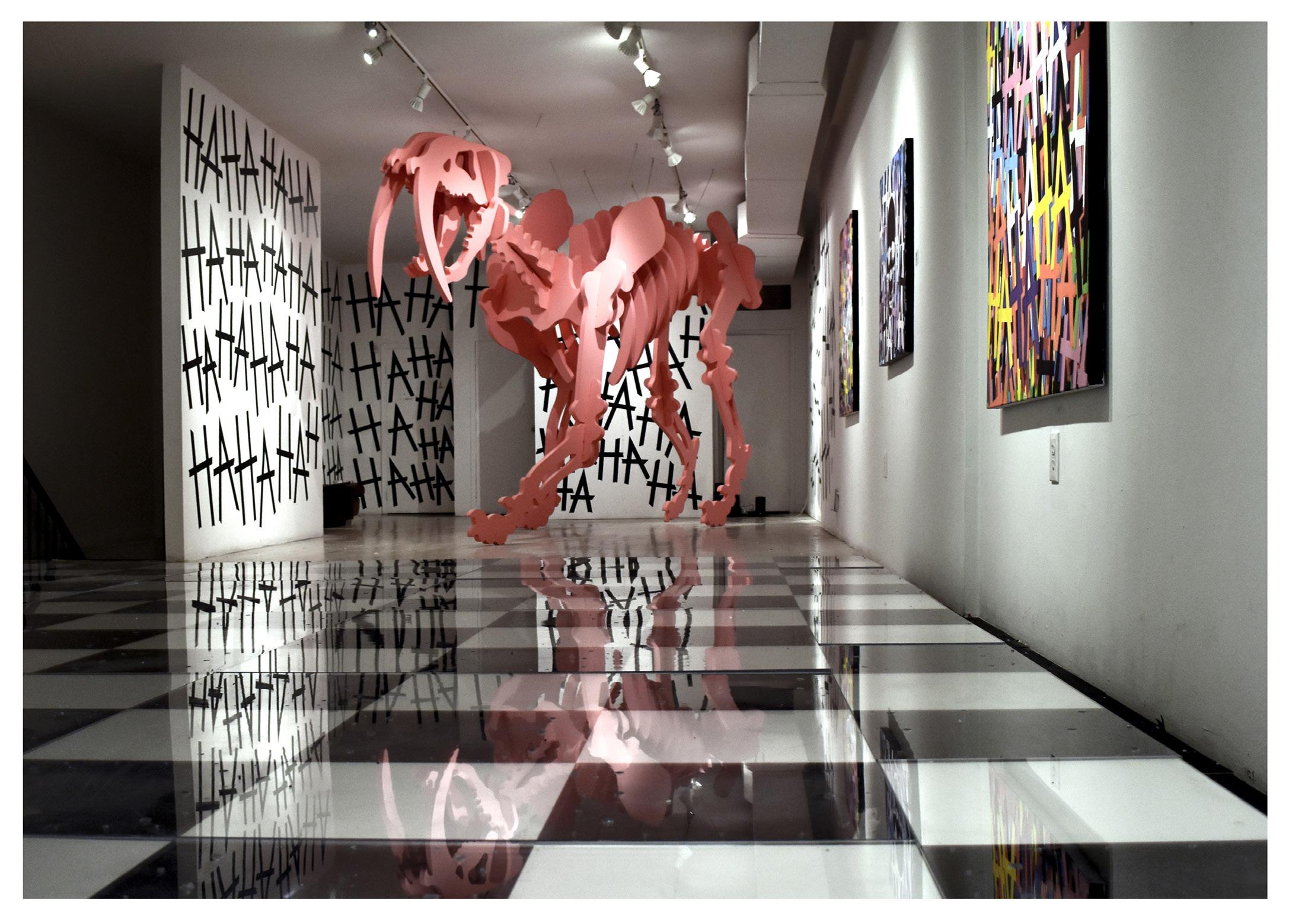
GROUP EFFORTS
Theresa Himmer (MFA 2011 Fine Arts), Ragnheiður Káradóttir (MFA 2016 Fine Arts) and Emily Weiner (MFA 2011 Fine Arts) had work on view in the group exhibition “The In, With and Between Us,” Kópavogur Art Museum, Kópavogur, Iceland, 6/3-8/20/17.
Rebecca Goyette (MFA 2009 Fine Arts), Natalie Krick (BFA 2008 Photography) and Lissa Rivera (MFA 2009 Photography, Video and Related Media) had work on view in the group exhibition “NSFW: Female Gaze,” Museum of Sex, NYC, 6/21-9/24/17.
Crystelle Colucci (BFA 2017 Photography and Video) curated the group exhibition “Pulverize the Patriarchy,” Chinatown Soup Gallery, NYC, 7/7/17, which included work by fellow BFA Photography and Video graduates Erin Carr (2017), Vanessa Teran Collantes (2017), Caroline Tompkins (2014) and Ana Zinn (2017).
Sebastiano Arpaia (BFA 2016 Photography and Video), Elliott Chambers (BFA 2017 Illustration) and Andrew Straub (BFA 2017 Photography and Video) had work on view in the group exhibition “Roadside Turbulence,” SoMMwhere Gallery, NYC, 8/17/17.
Amelia Miller and Augustus Nazzaro (both MFA 2012 Fine Arts) had work on view in the group exhibition “Isseki Nichou,” Koki Arts, Tokyo, Japan, 8/26-9/30/17.
Jungmi Cho (BFA 2009 Graphic Design), Ji Youn Hong (BFA 2010 Fine Arts) and Jina Lee (BFA 2010 Fine Arts) have started a Seoul, South Korea–based design collective, House of Collections.
Graciela Cassel (MFA 2014 Fine Arts), Donna Cleary (MFA 2014 Fine Arts), Leah Dixon (MFA 2014 Fine Arts), Nadia Haji Omar (MFA 2014 Fine Arts), Alison Kuo (MFA 2014 Fine Arts), Jung Mun (MFA 2015 Fine Arts) and Miryana Todorova (MFA 2012 Fine Arts) had work on view in the group exhibition “Mis,” 184 Project Space, NYC, 9/14-10/12/17.
Kate Greenberg (MFA 2010 Photography, Video and Related Media) curated “The Blue of Distance,” Transmitter Gallery, NYC, 9/15-10/15/17, which included work by fellow MFA Photography, Video and Related Media graduates Maureen Drennan (2009), Martha Fleming-Ives (2010) and Melvin Harper (2017).
Karen Leo (BFA 1997 Fine Arts) and Aya Rodriguez-Izumi (MFA 2017 Fine Arts) were participants in the A.I.R. Fellowship Program, A.I.R. Gallery, NYC, 9/28/17.
MPS Digital Photography graduates Ana Paula Tizzi (2017) and Nichole Washington (2016) were featured in “How A Small Group of Rising Fashion Photography Stars Captured NYFW,” Alpha Universe, 10/1/17.
Anney Bonney (MFA 2008 Computer Art), Daniel Durning (MFA 1994 Computer Art), Frank Holliday (BFA 1980 Fine Arts), Peter Hristoff (BFA 1981 Fine Arts), M. Henry Jones (BFA 1979 Film and Video), Margaret Lanzetta (MFA 1989 Fine Arts), Eric Marciano (BFA 1984 Film and Video), April Palmieri (BFA 1978 Fine Arts), Esther Regelson (BFA 1982 Film and Video), Kenny Scharf (BFA 1981 Fine Arts), Bruno Schmidt (BFA 1979 Media Arts), Joseph Szkodzinski (BFA 1981 Photography) and Richard Toonkel (BFA 1978 Fine Arts) had work on view in the group exhibition “Club 57: Film, Performance and Art in the East Village, 1978-1983,” MoMA, NYC, 10/31/17-4/1/18.
Neo Afan (BFA 2004 Computer Art), Christopher Di Fiore (BFA 2004 Computer Art), James Gulino (BFA 2017 Computer Art, Computer Animation and Visual Effects), Tucker Prisco (BFA 2014 Computer Art, Computer Animation and Visual Effects), Makoto Sato (BFA 2007 Computer Art) and Amanda Tolentino (BFA 2016 Computer Art, Computer Animation and Visual Effects) created holiday window displays for Macy’s, NYC, 11/1/17.
Inka Essenhigh and Stephen Mumford (both MFA 1994 Fine Arts) were featured in “Beer with a Painter: Steve Mumford and Inka Essenhigh,” Hyperallergic , 11/25/17.
1950
Jim Whiting was featured in “Local Creator Spotlight: Jim Whiting,” Times Union, 7/20/17.
1967
Anna Walter (Fine Arts) had work on view in the solo exhibition “On the Wall,” Carter Burden Gallery, NYC, 7/27-8/17/17.
1968
Richard Rutner (Media Arts) had work on view in the solo exhibition “Richard Rutner,” Art.Work Austin, Austin, TX, 8/25-9/4/17.
1971
Jeffrey Fahey (Media Arts) was featured in “Century 21 Displays Coastal North Carolina Artist’s Work at Offi ce,” The Post and Courier, 11/11/17.
1972
Kathleen McSherry (BFA Graphic Design) was featured in “Life Is Too Short to Put Your Dreams on Hold,” Awaken Center for Human Evolution, 10/13/17.
1974
Louise Sloane (BFA Fine Arts) had work on view in the group exhibition “Selected Paintings: 1977-2017,” Sideshow Gallery, NYC, 11/18-12/17/17.
1975
Margaret McCarthy (BFA Fine Arts) had work on view in the group exhibition “Garden of Earthly Delights,” Plaxall Gallery, NYC, 7/20-8/27/17.
1976
Lucky Checkley (BFA Photography) had work on view in the solo exhibition “Exposure 2017,” Ceres Gallery, NYC, 11/28-12/9/17.
Theresa DeSalvio (BFA Fine Arts) had work on view in the solo exhibition “Inside China,” Essex County College, Newark, NJ, 9/1-9/30/17.
William Kefauver (Graphic Design) curated “The Rock ‘n’ Wave Art Show,” Kefauver Studio and Gallery, Damariscotta, ME, 8/4-8/28/17.
1977
Dawoud Bey (Photography) was awarded a MacArthur Foundation Fellowship, MacArthur Foundation, 11/12/17.
Denise Halpin (BFA Graphic Design) had work on view in a solo exhibition, Almondine Patisserie, NYC, 8/23/17.
Tom Sito (BFA Animation) published On Animation: The Director’s Perspective Vol 1 (CRC Press, 2017).
1978
Charles Kreloff (BFA Graphic Design) had work on view in the group exhibition “Silence=Death Collective,” LeslieLohman Museum, NYC, 9/1/17-6/1/18.
1979
James Allocca (BFA Graphic Design) self-published Black Saucer: A Story of Determination (CreateSpace Independent Publishing Platform, 2017).
John Michael Pelech (BFA Media Arts) had work on view in the group exhibition “Vistas,” A Smith Gallery, Johnson City, TX, 11/3-12/17/17.
Daniel Rosenbaum (BFA Fine Arts) curated “Making Time,” Mark Borghi Fine Art, NYC, 10/19-11/22/17.
Karen Starrett Belfer (Media Arts) had work on view in the group exhibition “The Reveal: Five Artists Put It on the Wall,” Gallery 33, Red Bank, NJ, 6/30-7/16/17.
1980
Steve Barry (BFA Fine Arts) was featured in “Serpentine Symbolism,” Albuquerque Journal, 8/27/17.
Michael Halsband (BFA Photography) had work on view in the solo exhibition “Halsband Portraits,” Southampton Arts Center, Southampton, NY, 11/17-12/31/17.
Joseph Piscopia (BFA Media Arts) had work on view in the group exhibition “Et Tu, Art Brute?” Andrew Edlin Gallery, NYC, 11/17/17-1/28/18.
JOHN FERRY (MFA 1994 Illustration as Visual Essay), New York X2 #7, 2017, oil on board. Ferry’s solo exhibition “Exaggerated View of a Common Occurrence” was on view at Blue Gallery, Kansas City, MO, 8/31-10/2/17.
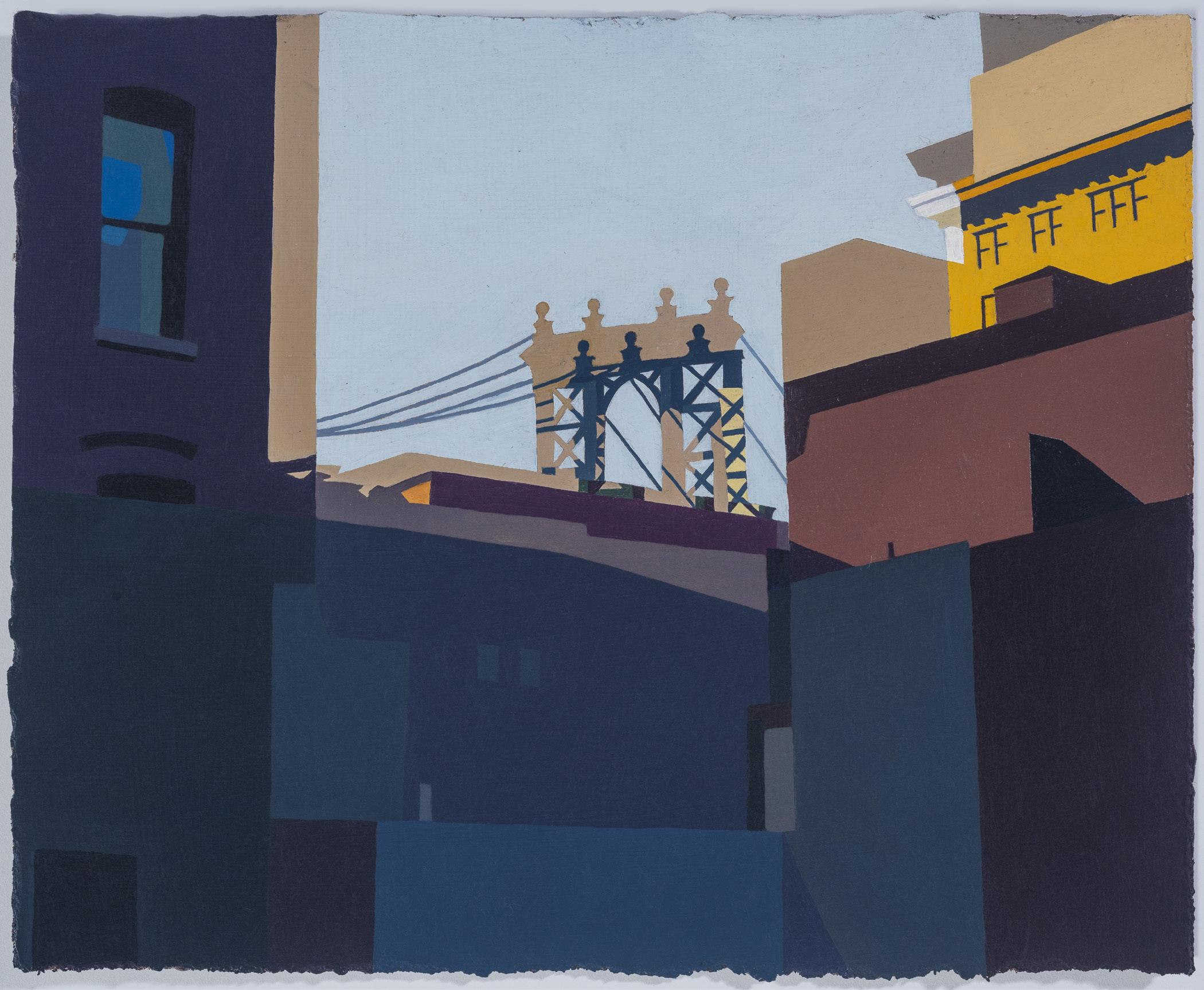
Rachel Reichman (BFA Film and Video) screened her fi lm Work (1996), Quad Cinema, NYC, 6/12/17.
Judy Schiller (BFA Photography) screened her fi lm It Happened in Havana: A Yiddish Love Story (2013), PBS, 6/111/30/17.
Wendel White (BFA Photography) had work on view in the solo exhibition “Haunted Places: The Veil of Race in the American Landscape,” Heuser Art Gallery, Bradley University, Peoria, IL, 8/28-10/16/17.
1981
Barbara Kolo (BFA Media Arts) had work on view in the group exhibition “Black & White,” Slate Art, Oakland, CA, 8/3110/28/17.
Rita Maas (BFA Photography) had work on view in the group exhibition “KMAA Featured Artists,” Spot Lounge Gallery, Katonah Museum of Art, Katonah, New York, 11/15/17-1/7/18.
Robert Minkin (BFA Graphic Design) self-published The Music Never Stopped – Marin County’s Music Scene (2017).
1982
Ilan Averbuch (BFA Fine Arts) had work on view in the solo exhibition “The Lily Pond,” Nancy Hoffman Gallery, NYC, 9/7-10/21/17.
Ernesto Bazan (BFA Photography) self-published Before You Grow Up (2017).
Susan Leopold (BFA Fine Arts) had work on view in the group exhibition “Connection II,” Atlantic Gallery, NYC, 7/11-7/29/17.
Joey Skaggs (BFA Advertising) was featured in “The Story of the ‘Portofess,’ the Prank Confessional Booth at the 1992 Democratic Convention,” Atlas Obscura, 7/14/17.
1983
Dane LaChiusa (BFA Advertising) was featured in “Native Grosse Pointer Exhibits Art at Garrido’s,” Grosse Pointe News , 7/13/17.
Paul Leibow (BFA Media Arts) had work on view in the PaperWest National Works on Paper Juried Exhibition, Gittins Gallery, University of Utah, 11/6-11/30/17.
Joyce Raimondo (BFA Illustration) gave a talk at Creative Networking Nights, The Barn at Golden Eagle/Studio 144, East Hampton, NY, 7/20/17.
1984
Gail Anderson (BFA Graphic Design) was featured in “When Typefaces Want to Get In on the Storytelling Action,” The Daily Beast , 7/1/17.
Lisa Argentieri (BFA Photography) was featured in “This Week’s Cover Artist: Lisa Argentieri,” Dan’s Papers , 11/3/17.
wool. Kronschlager’s solo exhibition “Alois Kronschlager: Night Works” was on view at Cristin Tierney Gallery, NYC, 9/14-10/28/17.
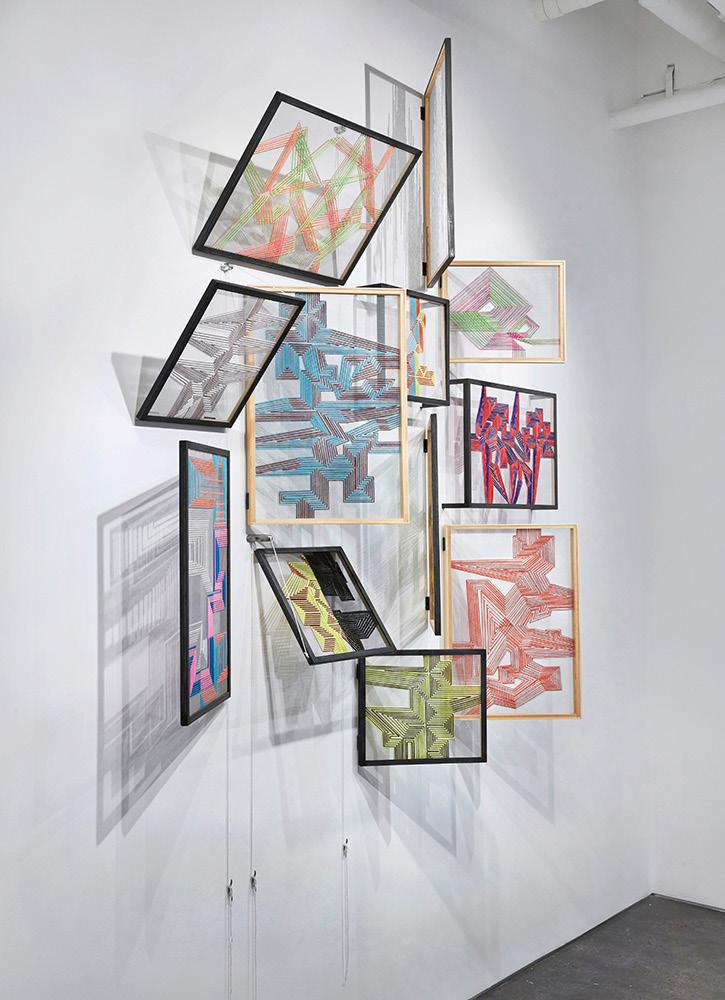
Robin Graubard work on view in the solo exhibition “Robin Graubard: Take a Picture It Lasts Longer,” Offi ce Baroque, Brussels, Belgium, 11/18/17-1/28/18.
1985
Karleen Kubat (MFA Fine Arts) had work on view in the New Haven Paint and Clay Club’s 116th Annual Juried Art Exhibition, Creative Arts Workshop, New Haven, CT, 7/10-8/30/17.
Luciana Pampalone (BFA Photography) had work on view in the solo exhibition “Luciana Pampalone,” Robin Rice Gallery, NYC, 11/15-12/31/17.
Collier Schorr (BFA Communication Arts) was featured in “The Female Gaze: 7 Fashion Photographers Tipping the Gender Scales,” Lifestyle Asia, 7/24/17.
had work on view in the solo exhibition “Janet Simmons,” Plainsboro Library Gallery, Plainsboro Township, NJ, 10/2811/29/2017.
Emily Thompson (BFA Media Arts) had work on view in the solo exhibition “Urban Archaeology,” Union Gallery, Wagner College, NYC, 10/14-11/12/17.
Cindy Vojnovic (BFA Fine Arts) had work on view in the solo exhibition “The Sinking of the General Slocum,” Madelon Powers Gallery, East Stroudsburg University, East Stroudsburg, PA, 9/5-9/29/17.
1986
Gerald Obregon (BFA Illustration) had work on view in the group exhibition “Twelve Summers,” The Deering Estate, Miami, FL, 7/15-9/27/17.
Aleathia Brown (BFA Media Arts) presented their installation “I Am Harlem,” Infi nity Church, NYC, 10/13/17.
Gary Petersen (MFA Fine Arts) had work on view in the group exhibition “Squared x 2,” Geoffrey Young Gallery, Great Barrington, MA, 11/4-11/26/17.
Elizabeth Peyton (BFA Fine Arts) was featured in “The Best of Art Basel 2017,” Surface, 6/16/17.
Eric Weeks (BFA Photography) had work on view in the solo exhibition “A Rose by Any Other Name,” Pingyao International Photography Festival, Pingyao, China, 9/19-9/25/17.








1988
Catya Plate (Fine Arts) was awarded the Grand Prize for Best Animated Short for her fi lm Meeting MacGuffin: An Animated Ecological Thriller (2017), Rhode Island International Film Festival’s Vortex Sci-Fi, Fantasy and Horror Film Festival 2017, 10/22/17.
Gary Simmons (BFA Fine Arts) was featured in “His Art Centers on African American Actors Whose Film Titles ‘Fade to Black’,” Los Angeles Times , 7/12/17.
1989
Suzanne McClelland (MFA Fine Arts) was featured in “Suzanne McClelland at the Aldrich Contemporary Art Museum, Ridgefi eld, Connecticut,” Blouin ArtInfo, 7/21/17.
Penelope Umbrico (MFA Fine Arts) was featured in “Penelope Umbrico’s Art Takes on Consumer Culture,” Flaunt , 8/16/17.
1990
Brian Palmer (MFA Photography and Related Media) was a panelist for “Monument, Myth and Meaning,” Cooper Union, NYC, 10/23/17.
Patricia Spergel (MFA Fine Arts) had work on view in the solo exhibition “Peeking Through,” Main Hall Art Gallery, Kent State University at Stark, North Canton, OH, 9/5-9/29/17.
1991
Emily Fitterman (BFA Advertising) was featured in “Freelance Graphic Designer Uses Low Overhead to Give Clients What Agencies Can’t,” Nation 1099 , 8/18/17.
Remington Scott (BFA Fine Arts)’s company MacInnes Scott presented an interactive exhibit at “The Art of VR,” Sotheby’s, NYC, 6/22-6/23/17.
1992
Lili Almog (BFA Photography) had work on view in the group exhibition “The Space Within,” Tower of David Museum, Jerusalem, Israel, 10/1-11/16/17.
Kate Brown (MFA Fine Arts) had work on view in the solo exhibition “Under One Skin,” Huntsville Public Library, Huntsville, Ontario, 7/1-8/29/17.
Johan Grimonprez (MFA Fine Arts) had work on view in the group exhibition “Picture Industry,” Center for Curatorial Studies, Bard College, Hessel Museum of Art, 6/24-12/15/17.
1993
Shawn Martinbrough (BFA Illustration) was awarded the Romics Golden Career Achievement Award, 10/16/17.
1994
Riad Miah (BFA Fine Arts) had work included in Between the Lines: An RxArt Coloring Book by Contemporary Artists, Vol. 6 (RxArt, 2017).
Chris Prynoski (BFA Animation) was featured in “Interview: Rob Hoegee and Chris Prynoski on the New Amazon Original Series Niko and the Sword of Light ,” Cartoon Brew, 7/26/17.
1995
Selina Alko (BFA Illustration) co-illustrated Why Am I Me? (Scholastic Press, 2017).
Michael De Feo (BFA Graphic Design) had work on view in the group exhibition “Urban Infl uence,” Urban Art Fair, NYC, 6/29-7/3/17.
Vera Lutter (MFA Photography and Related Media) was commissioned by LACMA to document several of its buildings slated for demolition in her signature camera obscura style, 8/8/17.
1996
Hrafnhildur Arnardottir (MFA Fine Arts) was featured in “Hypernature: Shoplifter Showers the World With Colour,” The Reykjavik Grapevine, 6/1/17.
Brian Belott (BFA Fine Arts) was featured in “The Power and Complexity of Children’s Art: An Interview with Brian Belott,” Hyperallergic , 7/1/17.
KAWS (a.k.a. Brian Donnelly) (BFA Illustration) was featured in “The 10 Best Designed Basketball Courts in the World,” Architectural Digest , 9/7/17.
Virginia Santos (MFA Computer Art) was featured in “Pixar’s First Female Supervising Animator is Pinoy,” Rappler, 11/8/17.
Stephen Savage (MFA Illustration as Visual Essay) published Little Plane Learns to Write (Roaring Brook Press, 2017).
1997
Andrew Davis (BFA Fine Arts) self-published Trump Noir (2017).
Ra ú l Manzano (BFA Illustration) curated “Caribbean Heritage,” Livingston Gallery, SUNY Empire State College, NYC, 6/18/30/17.
Nefertite Nguvu (BFA Film and Video) was selected for the AT&T Hello Lab Mentorship Program to develop her project The Last Two Lovers at the End of the World, with mentorship by actor/ musician Common, to premiere on DirectTV in 2017.
1998
Janice Caswell (BFA Fine Arts) curated “Double Vision: Artists Who Instagram,” LABSpace, Hillsdale, NY, 9/16-10/7/17.
Brian Finke (BFA Photography) was featured in “Brian Finke Captures the Contrasts in Pasta Production in Five Different Cities in Italy,” It’s Nice That , 10/16/17.
Jessica Neal (BFA Fine Arts) was featured in “Netfl ix Promotes Jessica Neal to Chief Talent Offi cer Role,” Variety, 10/27/17.
Dice Tsutsumi (BFA Illustration) was featured in “Under Siege from a Mysterious Fog,” The New York Times , 11/9/17.
1999
John Arsenault (BFA Photography) had work on view in the group exhibition “America (From the Outside),” Mott NYC, NYC, 7/12-9/6/17.
Nils Karsten (BFA Fine Arts) had work on view in the solo exhibition “Here Are the Keys II,” Miyako Yoshinaga, NYC, 7/13-8/11/17.
Janelle Lynch (MFA Photography and Related Media) had work on view in the group exhibition “Incomplete Landscapes: Janelle Lynch and Pedro David,” Art Museum of the Americas, Washington, DC, 11/8/17-1/12/18.
Gerard Way (BFA Cartooning) was featured in “Netfl ix’s Next Superhero Series Comes from Former My Chemical Romance Frontman Gerard Way,” The Verge, 7/13/17.
2000
Katherine Bernhardt (MFA Fine Arts) was featured in “Why We’re Not Getting Another Andy Warhol Any Time Soon,” Bloomberg , 11/6/17.
Kevin Cooley (MFA Photography and Related Media) had work on view in the group exhibition “Inside Out,” Sidewalk Cinema, Houston, TX, 10/25/17-1/15/18.
Gonzalo Fuenmayor (BFA Fine Arts) had work on view in the solo exhibition “Tropicalypse,” Dot Fiftyone Gallery, Miami, 11/30/17-1/15/18.
Eric Rhein (MFA Fine Arts) had work on view in the solo exhibition “360 Moons,” BCB Art, Hudson, NY, 10/14-11/19/17.
2001
Noah Landfi eld (BFA Fine Arts) had work on view in the group exhibition “ChaShaMa,” Brooklyn Army Terminal, NYC, 10/14-10/15/17.
Mika Rottenberg (BFA Fine Arts) had work on view in the group exhibition “The Body Politic: Video from the Met Collection,” Met Breuer, NYC, 6/20-9/3/17.
Danwen Xing (MFA Photography and Related Media) had work on view in the solo exhibition “Captive of Love,” Red Brick Art Museum, Beijing, China, 9/10-10/29/17.
2002
Michael Alan (BFA Fine Arts) had work on view in the solo exhibition “Alien Symphony,” 4 Wheels Studio, Milwaukee, WI, 10/5-10/7/17.
Marlena Buczek Smith (BFA Graphic Design) had work on view in the group exhibition “Freedom Manifesto—Humanity On the Move,” Centrale Montemartini, Rome, Italy, 9/28-12/31/17.
Mariam Ghani (MFA Photography and Related Media) had work on view in the group exhibition “Lucid Dreams and Distant Visions: South Asian Art in the Diaspora,” Asia Society, NYC, 6/27-8/6/17.
Aya Kakeda (MFA Illustration as Visual Essay) was featured in “Aya Kakeda’s Vibrant Fictional Worlds,” Hi-Fructose, 8/9/17.
Young Sam Kim (BFA Photography) had work on view in the group exhibition “Concrete Jungle,” Emmanuel Fremin Gallery, NYC, 11/16-12/31/17.
Olivier Kugler (MFA Illustration as Visual Essay) was featured in “Illustrator Profi le - Olivier Kugler,” American Illustration-American Photography, 6/8/17.
Reka Nyari (BFA Fine Arts) had work on view in Art Market Hamptons, Bridgehampton, NY, 7/6-7/9/17.
Sam Tufnell (BFA Fine Arts) had work on view in the solo exhibition “Inappropriation,” Castle Fitzjohns Gallery, NYC, 6/8-9/8/17.
2003
Jade Kuei (BFA Animation) had work on view in the group exhibition “Bewitching VII,” Stranger Factory, Albuquerque, NM, 10/6-10/29/17.
Andr é s Libreros (BFA Film and Video) co-executive produced the TV series Pambelé (2017).
2004
Lindsay Ballant (BFA Graphic Design) was a panelist for “Politics. Media. Design.” Society of Publication Designers, NYC, 7/13/17.
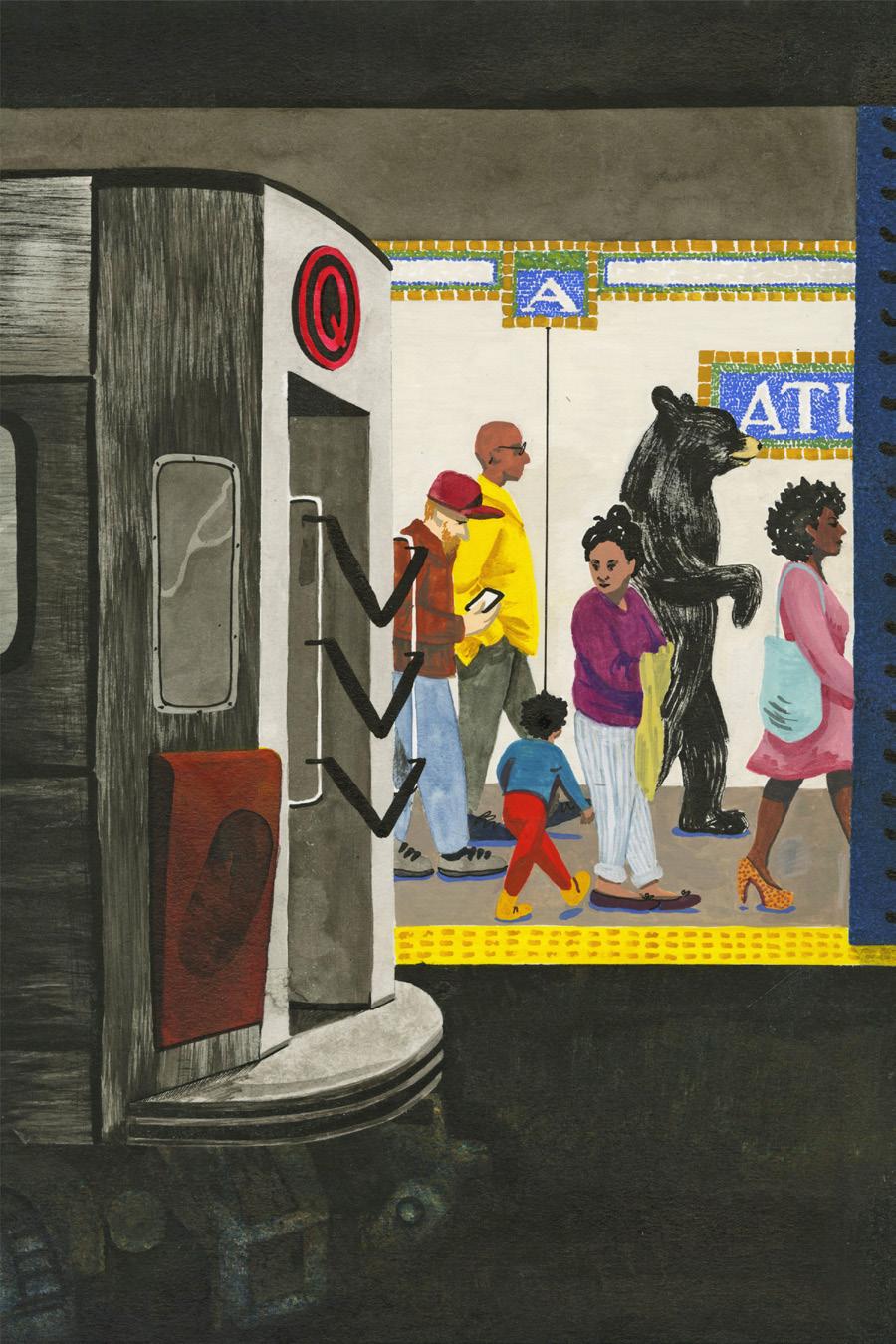
Kathrin Burmester (BFA Film and Video) had work on view in the solo exhibition “Since I’m Being Honest With You,” Topaz Arts, NYC, 11/11-12/17/17.
Zachary Cregger (BFA Computer Art) was featured in “Five Things You Didn’t Know About Zach Cregger,” TV Over Mind, 6/22/17.
Saskia Jordá (MFA Fine Arts) had work on view in the solo exhibition “Lineage,” Eric Fischl Gallery, Phoenix College, Phoenix, AZ, 8/31-9/28/17.
Kyung Sook Min (MFA Fine Arts) had work on view in the solo exhibition “From Here to There,” McCoy Gallery, Merrimack College, North Andover, MA, 10/26-12/22/17.
Morley (BFA Film and Video) had work on view in the solo exhibition “A Beginner’s Guide to Mending: An Art Exhibit by Morley,” Gabba Gallery, Los Angeles, CA, 9/9-9/30/17.
Matthew Pillsbury (MFA Photography, Video and Related Media) had work on view in the solo exhibition “Sanctuary,” Benrubi Gallery, NYC, 9/14-11/22/17.
Ryan Kelly (BFA Photography) had work on view in the solo exhibition “Five Years of Nudes,” Bushwick Open Studios, NYC, 9/22-9/24/17.
Santiago Sigüenza (BFA Fine Arts) created poster art for the fi lm Larger Than Life: The Kevyn Aucoin Story (2017), NYC, 11/16/17.
2005
Lauren Castillo (MFA Illustration as Visual Essay) illustrated A Boy, a Mouse, and a Spider: The Story of E.B. White (Henry Holt and Co., 2017).
Zackary Drucker (BFA Photography) was honored at the Aperture Foundation’s 65th Anniversary Gala, NYC, 10/30/17.
Jeff Liao (MFA Photography, Video and Related Media) was featured in “Jeff Chien-Hsing Liao’s Central Park” American Illustration-American Photography, 8/24/17.
Rachel Papo (MFA Photography, Video and Related Media) had work on view in the group exhibition “re:collection,” Museum of Contemporary Photography, Columbia College Chicago, IL, 7/1310/1/17.
Daniel Perrone (BFA Photography) had work on view in the solo exhibition “Warm Static,” Picturehouse + Thesmalldarkroom, NYC, 10/12-11/9/17.
NEW YORK CITY-BASED and LOCALLY-OWNED, DaVinci Artist Supply has served students and creative professionals for more than a decade.
With our diverse inventory, comprehensive paper department, and knowledgeable, helpful staff, we are
Ivy Johnson, SVA Class of 2018 “Rush Hour,” gouache and acrylic ink @ivyjohnson_art
2006
Ryan Brown (BFA Fine Arts) had work on view in the solo exhibition “Lots on View,” Bryce Wolkowitz Gallery, NYC, 6/29-8/25/17.
Ian Jones-Quartey (BFA Animation) was a panelist for “Art of the Hero,” The Paley Center, NYC, 11/7/17.
Samantha Sethi (BFA Illustration) was selected as an artist in residency, Creative Alliance, Baltimore, MD, 6/1-8/31/17.
2007
Elizabeth Castaldo (BFA Fine Arts) had work on view in the group exhibition “In Defense of Life,” Blackburn 20/20, NYC, 10/4-10/8/17.
Siobhan Duggan (MAT Art Education) was featured in “Lewes After-Hours Artist Reception Aug. 31,” The Sussex Countian, 8/15/17.
Amy Elkins (BFA Photography) had work on view in the solo exhibition “Black Is the Day, Black Is the Night,” High Museum of Art, Atlanta, GA, 9/9/17-3/4/2018.
Mu Pan (MFA Illustration as Visual Essay) was featured in “The Grotesquely Chaotic Paintings of Mu Pan,” Dangerous Minds , 6/27/17.
Mention this ad for 20% OFF * your entire purchase. *msrp on non-sale items; some restrictions apply.
2008
Michael Dalton (BFA Photography) published The Great Falls (Peperoni Books, 2017).
Cat Del Buono (MFA Photography, Video and Related Media) curated “We Rise,” Art Connects, NYC, 10/13/18.
Jade Doskow (MFA Photography, Video and Related Media) gave a talk, “World’s Fairs,” Cornell University, Ithaca, NY, 9/13/17.
Lynn Herring (BFA Fine Arts) had work on view in the solo exhibition “XOX: Lynn Herring’s Newest Work,” Wired Gallery, High Falls, NY, 8/19-8/20/17.
Jenny Morgan (MFA Fine Arts) was featured in “Paintings that Expose the Spirit Within the Body,” Hyperallergic , 6/21/17.
David Mramor (MFA Fine Arts) was featured in “How Dressing in Drag Helps This Artist Feel Closer to Their Dead Mother,” Teen Vogue, 7/13/17.
2009
Amber Boardman (MFA Fine Arts) had work on view in the solo exhibition “Regrowth,” Sandler Hudson Gallery, Atlanta, GA, 9/8-10/21/17.
Mariana Castellanos (BFA Advertising) was featured in “Type Directors Club Debuts World’s Best Typography in New York,” The Type Directors Club, 8/7/17.
Robert Herman (MPS Digital Photography) was featured in “Robert Herman Documents the Streets and People of a New York in the Early ’80s,” C41 Magazine, 7/7/17.
Habby Osk (MFA Fine Arts) had work on view in “Sequences VIII: Elastic Hours,” Ekkisens Gallery, Reykjavik, Iceland, 10/6-10/16/17.
Hye-Ryoung Min (MPS Digital Photography) named one of Photolucida’s 2017 Critical Mass Top 50, 10/1/17.
Marilyn Montufar (BFA Photography) had work on view in the group exhibition “Women in Photography,” Bainbridge Island Museum of Art, Bainbridge Island, WA, 6/24-10/1/17.
Jaime Permuth (MPS Digital Photography) was a winner of the American Illustration-American Photography’s Latin American Fotografi a 6, 8/24/17.
Lissa Rivera (MFA Photography, Video and Related Media) had work on view in the solo exhibition “Beautiful Boy,” ClampArt, NYC, 6/1-7/15/17.
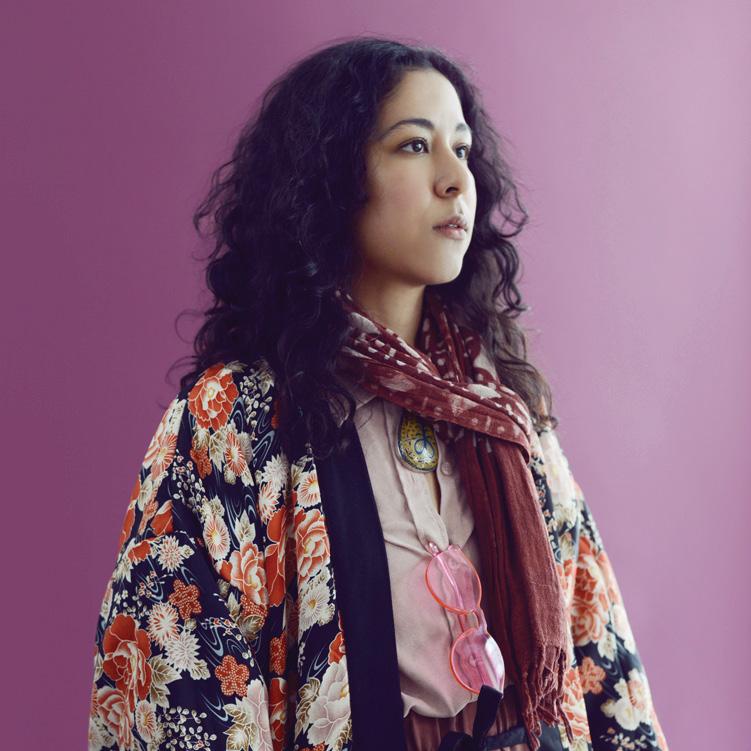
Rebecca Sugar (BFA Animation) was featured in “ Steven Universe : How Rebecca Sugar Turned TV’s Most Empathetic Cartoon into an Empire,” Rolling Stone 6/7/17.
Trish Tillman (MFA Fine Arts) had work on view in the group exhibition “One Year Later,” Pyramid Atlantic Art Center, Hyattsville, MD, 6/23-8/5/17.
2010
Joshua Citarella (BFA Photography) was featured in “18 Artists Share the Books That Inspire Them,” Artsy, 6/23/17.
Matthew Craven (MFA Fine Arts) had work on view in the solo exhibition “Prospectus,” 101/Exhibit, Los Angeles, 9/16-10/13/17.
Christopher Darling (MFA Illustration as Visual Essay) was featured in “Christopher Darling’s Sketchbooks,” American Illustration-American Photography, 8/9/17.
Natan Dvir (MFA Photography, Video and Related Media) had work included in Bystander: A History of Street Photography (Laurence King Publishing, 2017).
Bennett Elliott (BFA Film and Video) was awarded a Sundance Producing Fellowship, 8/1/17.
Florencia Escudero (BFA Fine Arts) screened Waterfalls and Lace (2017), Best Latino Short Film – USA category, Latino Film Market, 7/26/17.
2011
Betty Hart (MFA Fine Arts) had work on view in the Affordable Art Fair, NYC, 9/14-9/17/17.
Cynthia Hinant (MFA Fine Arts) had work on view in the solo exhibition “Celebrity Sex Tapes / Aquarium Videos,” LIT: The Pop-Up Gallery, NYC, 7/7-7/16/17.
Adelha Lee (MFA Fine Arts) was featured in “Adehla Lee: Post-Medium with Grandmother’s Dark Chi,” Art511 Magazine, 11/21/17.
David Osit (MFA Social Documentary) received the Outstanding Arts and Culture Documentary Trophy at the 38th Annual News & Documentary Emmy Awards for his fi lm Thank You for Playing (2015), 10/5/17.
Deva Pardue (BFA Graphic Design) was featured in “Deva Pardue,” Commarts , 10/11/17.
Stephanie Rodriguez (BFA Illustration) was featured in “Stephanie Rodriguez Takes on Slut Shaming, Anxiety & Heartbreak in Her Super Relatable Comics,” Remezcla, 8/4/17.
Julie Schenkelberg (MFA Fine Arts) had work on view in the solo exhibition “Honoring History + Place,” Faultless Event Space, Kansas City, MO, 9/14-10/28/17.
2012
Andrew Brischler (MFA Fine Arts) had work on view in the solo exhibition “Lonely Planet,” Gavlak, Los Angeles, CA, and Palm Beach, FL, 11/11/17-1/6/18.
Anna Fine (BFA Advertising) was featured in “Designers Create the Next Binge-Worthy TV Show at 2017 Pixels of Fury in NYC,” Shutterstock, 10/27/17.
M. Benjamin Herndon (BFA Fine Arts) had work on view in the group exhibition “Everlasting,” Tang Contemporary Art, Beijing, China, 8/5-9/16/17.
Laura Murray (BFA Fine Arts) had work accepted by the Creative Climate Awards, Human Impacts Institute, NYC, 10/16-11/16/17.
Raul Paz Pastrana (MFA Social Documentary)’s fi lm Border South (2017) was selected to be workshopped in the Tribeca Film Institute Retreat, 6/19/17.
Lorelei Ramirez (BFA Fine Arts) curated “Not Dead Yet,” C’mon Everybody, NYC, 8/13/17.
Rebecca Ward (MFA Fine Arts) had work on view in the solo exhibition “Rebecca Ward,” FLAG Art Foundation, NYC, 6/1-8/11/17.
Jonathan Weiskopf (BFA Photography) founded VSOP Projects, Greenport, NY, 5/1/2017.
2013
Natalya Balnova (MFA Illustration as Visual Essay) was featured in “The Q&A: Natalya Balnova,” American Illustration-American Photography, 9/6/17.
Shubhashish Bhutiani (BFA Film and Video) was featured in “Film Movement Checks into Hotel Salvation,” Variety, 7/20/17.
Angela Conant (MFA Art Practice) curated “Published by the Artist 2017,” International Print Center New York, NYC, 9/22-10/5/17.
Katherine Fajardo (BFA Cartooning) was awarded the 2017 Emerging Talent Award, Cartoon Crossroads Columbus, OH, 9/30/17.
Che Min Hsiao (MFA Illustration as Visual Essay) had work on view in the solo exhibition “Sitting with the Garden,” Queens Botanical Garden, NYC, 6/309/24/17.
Mathias Kessler (MFA Art Practice) had work on view in the group exhibition “Visions of Nature,” Kunst Haus Wien, Museum Hundertwasser, Vienna, Austria, 9/13/17-2/18/18.
Sara Kriendler (MFA Fine Arts) had work on view in the group exhibition “Uptown: Nasty Women/Bad Hombres,” El Museo Del Barrio, NYC, 6/13-7/5/17.
Min Liu (MFA Computer Art) had work on view in the group exhibition “(home),” 440 Gallery, NYC, 6/29-7/30/17.
Olivia Locher (BFA Photography) had work on view in the solo exhibition “I Fought the Law,” Steven Kasher Gallery, NYC, 9/14-10/21/17.
Star Montana (BFA Photography) was featured in “This Boyle Heights Photographer Documents Her Community in Intimate Portraits,” LAist , 6/19/17.
Ryan Shorosky (BFA Photography) was featured in “Classic Americana in Las Vegas,” The New York Times , 6/30/17.
Jamie Sneider (MFA Fine Arts) had work on view in the solo exhibition “SÜD,” Gianni Manhattan, Vienna, Austria, 9/15-10/28/17.
Ilona Szwarc (BFA Photography) had work on view in the group exhibition “You Are Now Entering the Human Heart,” Instytut Fotografi i Fort, Warsaw, Poland, 9/22-11/26/17.
Briana Thornton (BFA Photography) was featured in “Look at the Space,” Lake Oswego Review, 6/15/17.
Denise Treizman (MFA Fine Arts) was featured in “Denise Treizman Answers 5 Questions,” ArtSlant , 6/19/17.
Andrea Tsurumi (MFA Illustration as Visual Essay) published Accident! (Houghton Miffl in, 2017).
Brian Andrew Whiteley (MFA Fine Arts) was featured in “Artist Provocateur Brian Andrew Whiteley in Conversation with MC Stevens,” Arcade Project , 11/15/17.
2014
Rachel Ake (BFA Design) designed the cover of Sour Heart (Lenny Books, 2017) by Jenny Zhang.
Richard Clarkson (MFA Products of Design) was featured in “Floating Cloud: An Electromagnetic Cloud That Hovers on Your Desktop by Richard Clarkson,” Colossal, 8/7/17.
Andrea Garcia (BFA Visual and Critical Studies) was awarded fi fth place and the Chu Teh-I Jury Award in the student category at Art Olympia 2017 International Open Art Competition, Tokyo, Japan, 6/17-6/25/17.
Ja’Tovia Gary (MFA Social Documentary) had work on view in the group exhibition “An Incomplete History of Protest: Selections from the Whitney’s Collection, 1940–2017,” Whitney Museum of American Art, NYC, 8/18/17.
Julia Harding (MFA Art Practice) was selected as an artist in residency, SOHO20 Gallery, 9/29/17.
2015
Yasaman Alipour Fetrati (BFA Photography) curated “Art of ‘Whose’ People,” LeRoy Neiman Gallery, Columbia University, NYC, 9/5-9/29/17.
Christina Arza (MFA Photography, Video and Related Media) had work on view in the group exhibition “Women & Flowers,” Foley Gallery, NYC, 11/8-11/19/17.
Peter Buotte (MPS Art Therapy) had work on view in the group exhibition “The National Exhibition of Veteran Art,” Gallery8K, Aspen, Colorado, 8/5-8/31/17.
Claire Christerson (BFA Photography) had work on view in the solo exhibition “Daisy Chains Heart Ecology,” Entrance Gallery, NYC, 9/9/-10/7/17.
Nicasio Fernandez (BFA Fine Arts) had work on view in the solo exhibition “Off to a Rocky Start,” Kustera Projects, NYC, 6/17-7/23/17.
Salih Berk Ilhan (MFA Products of Design) was featured in “High-Tech Mirror for Cancer Patients Only Works If You Smile,” CNN Money, 10/24/17.
Logan Jackson (BFA Photography) was featured in “Roe Ethridge and Logan Jackson’s Photos Take On Surprising New Meaning When Shown as Collage,” Vice, 8/4/17.
Lisha Jiang (MFA Illustration as Visual Essay) had work on view in the solo exhibition “Lady’s Fight Club,” SNAP, Shanghai, China, 6/10/17.
Natalya Margolin (BFA Fine Arts) had work on view in the group exhibition “Bent, But Unbroken,” Charles H. Wright Museum of African American History, Detroit, MI, 7/28-10/29/17.
Ima Mfon (MPS Digital Photography) had work on view in the solo exhibition “Nigerian Identity,” Blue Sky Gallery, Portland, OR, 6/1-7/2/17.
Jung Mun (MFA Fine Arts) screened excerpts of their work as part of “State of Emergency,” The Illuminator, NYC, 11/16/17.
Tatiane Schilaro (MFA Art Criticism and Writing) curated “Fragmento, In-Process,” b[x] 203, NYC, 11/3-12/8/17.
Tiffany Smith (MFA Photography, Video and Related Media) curated “Up-Root,” Periphery Space, Pawtucket, RI, 10/21/1711/21/17.
Elizabeth Zito (MFA Photography, Video and Related Media) had work on view in the group exhibition “Here for the Right Reasons,” Sleepcenter, NYC, 8/2/17.
Anthony Zukofsky (BFA Design) was featured in “Young Designer Anthony Zukofsky Shares Tips for Landing Jobs at Google, Apple, Pentagram + More,” Eye on Design, 6/15/17.
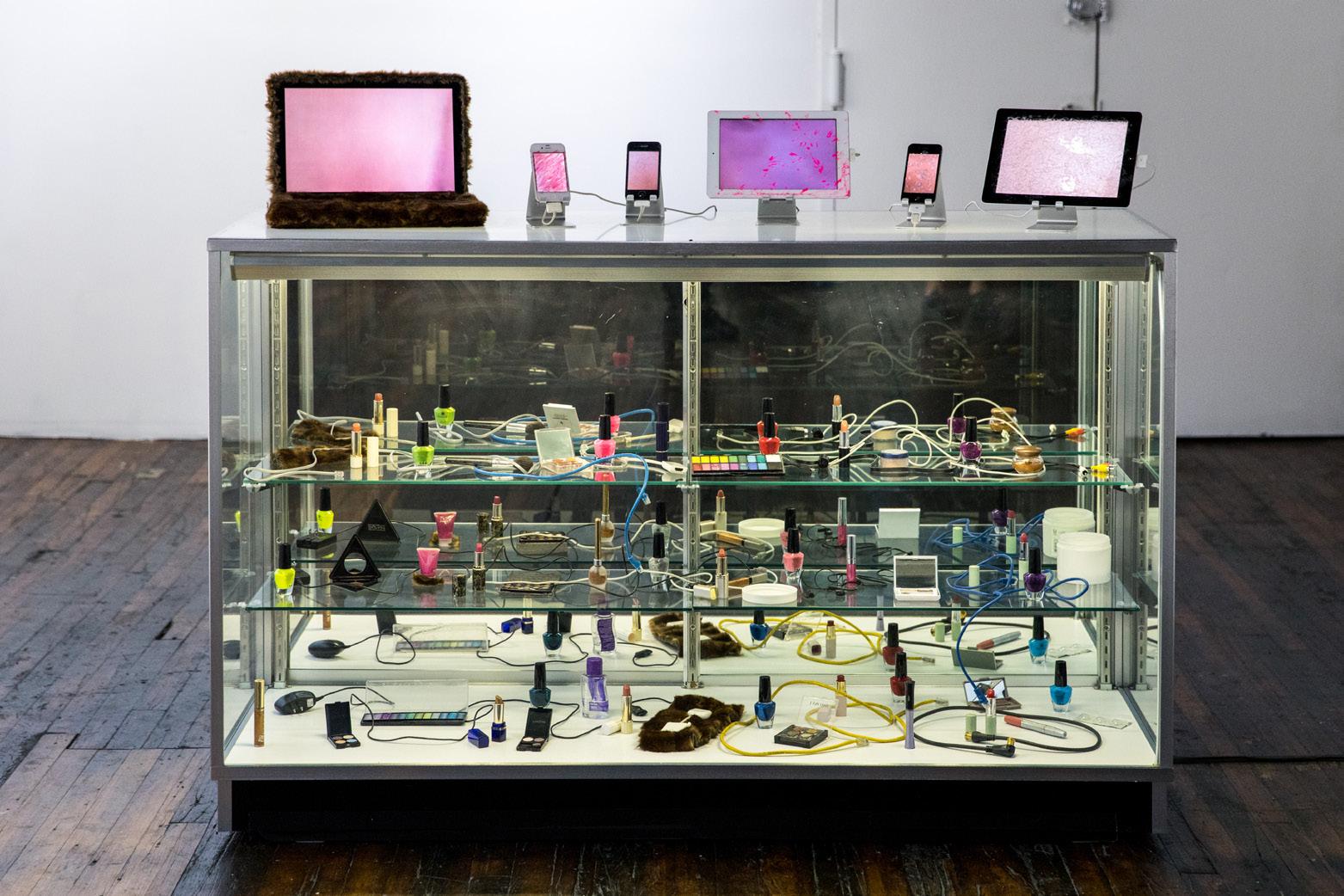
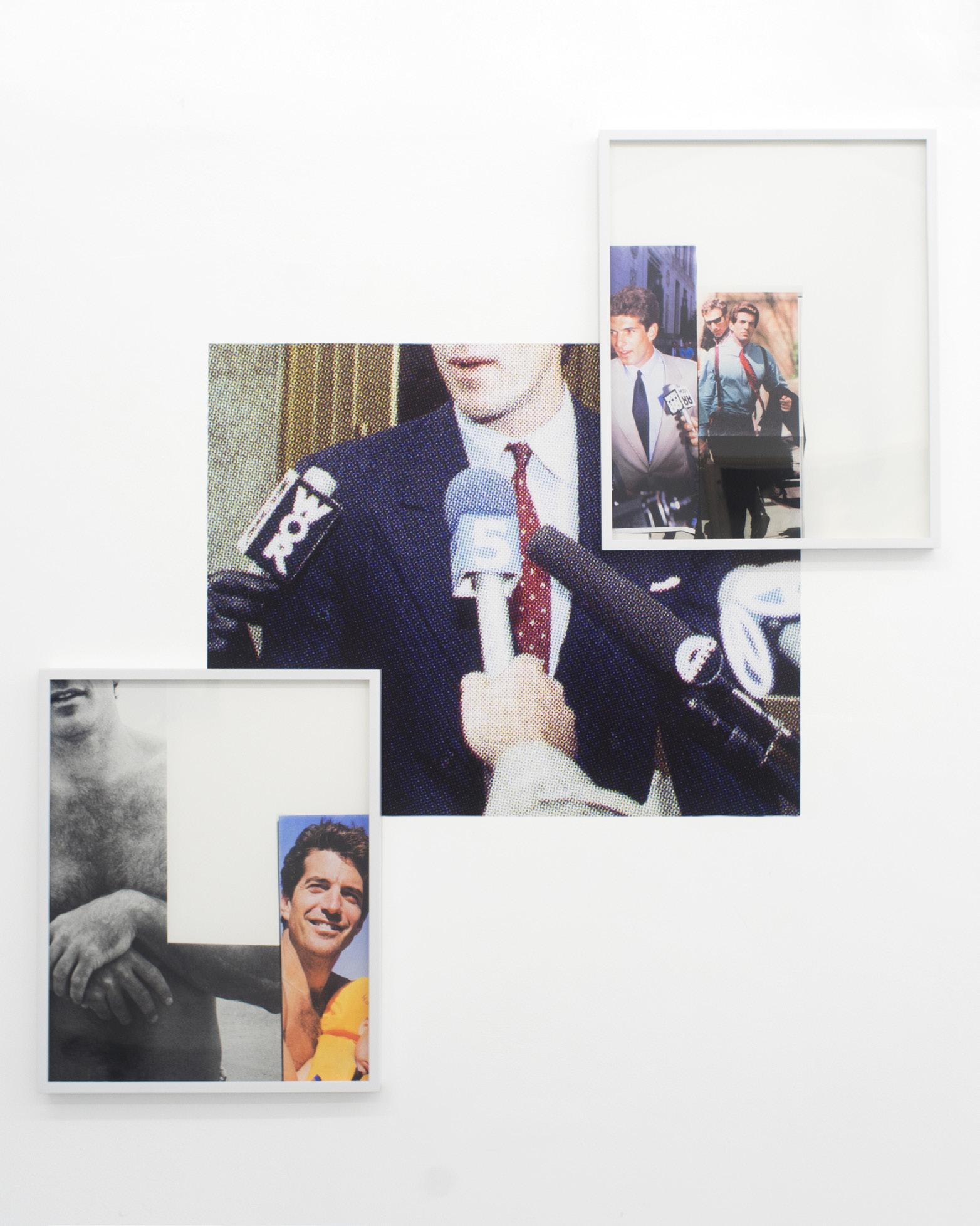
2016
AnnaLiisa Ariosa-Benston (MFA Fine Arts) had work on view in the group exhibition “Lady Art: TALKS,” New Women’s Space, NYC, 6/15-6/29/17.
Elyanna Blaser (BFA Design) was nominated for a 2018 Grammy in the Package category for her contributions to the album cover design for The National’s Sleep Well Beast , 11/29/17.
Mikayla Butchart (MFA Illustration as Visual Essay) was featured in “Santa Rosa Native Raises $20,000 for Sonoma County Fire Victims Through ROSE-ilience Pin,” Press Democrat , 10/16/17.
Haoran Fan (MPS Digital Photography) was featured in “Haoran Fan,” Phroom 7/9/17.
Georgia Lale (MFA Fine Arts) had work on view in the group exhibition “On Paper,” Gallery d’Arte/Paris Koh Fine Arts, NYC, 6/1-6/15/17.
Jonathan Lung (MFA Products of Design) was featured in “New Host Dishes on the ‘Crazy’ World of MythBusters ,” New York Post , 11/13/17.
Mohammid Walbrook (BFA Photography and Video) was featured in “Surviving Irma,” Surfer, 9/16/17.
Nichole Washington (MPS Digital Photography) was featured in “The World According to Black Women Photographers,” The New York Times , 6/15/17.
2017
Adam Cable (MFA Photography, Video and Related Media) had work on view in the solo exhibition “Real Realities,” Owen Hall Second Floor Gallery, University of North Carolina Asheville, NC, 8/259/22/17.
Erin Carr (BFA Photography and Video) was featured in “These Deeply Personal Photos Explore the Two Artists’ Experiences of a Polarized World,” Vice, 8/7/17.
Young Gul Cho (MFA Computer Art, Computer Animation and Visual Effects) was selected as a fi nalist for the 2017 Student Academy Awards in the Domestic Animation category for her thesis fi lm E-delivery (2017), 9/13/17.
Grina Choi (BFA Design) was awarded an Adobe Design Achievement Award in the Commercial Print/Graphic/Illustration category, 8/30/17.
Amaurys Grullon (BFA Design) was featured in “The Rebranding of the Bronx,” The New York Times , 8/16/17.
Alex Hovet (MFA Photography, Video and Related Media) had work on view in the group exhibition “Game Face,” Sweet Art Gallery, London, UK, 7/1-7/2/17.
Eui-Jip Hwang (BFA Photography and Video) was featured in “These Surreal Plastic Surgery Ads Subvert Korean Beauty Standards,” Vice, 6/20/17.
Nicolas Lopez (BFA Film) was featured in “9/11 Sculpture Made from WTC Steel Debuts at Ground Zero Museum Workshop in Chelsea,” AM New York , 9/7/17.
Kent Meister (MPS Digital Photography) was featured in “Inside New York’s Indie Theater Scene,” Photo District News Online, 10/2/17.
Meytar Moran (MFA Photography, Video and Related Media) had work on view in the group exhibition “Best of the Northeast Master of Fine Arts,” Helen Day Art Center, Stowe, VT, 6/16-8/26/17.
Mika Orr (MPS Directing) screened her fi lm Professional Cuddler (2017), Big Apple Film Festival, NYC, 11/3/17.
Miguel Soliman (MPS Directing) screened his fi lm Desde el Principio (2017), NALIP Latino Media Festival, Los Angeles, CA, 9/26-9/27/17.
Jaanelle Yee (MPS Directing) screened her fi lm Sell Your Body (2017), NOLA Horror Film Fest, New Orleans, LA, 9/21-9/24/17.
Shaoyi Zhang (MPS Digital Photography) was featured in “Rising Light: Shaoyi Zhang’s Journey from Landscapes to Architecture to People,” Profoto, 9/19/17.
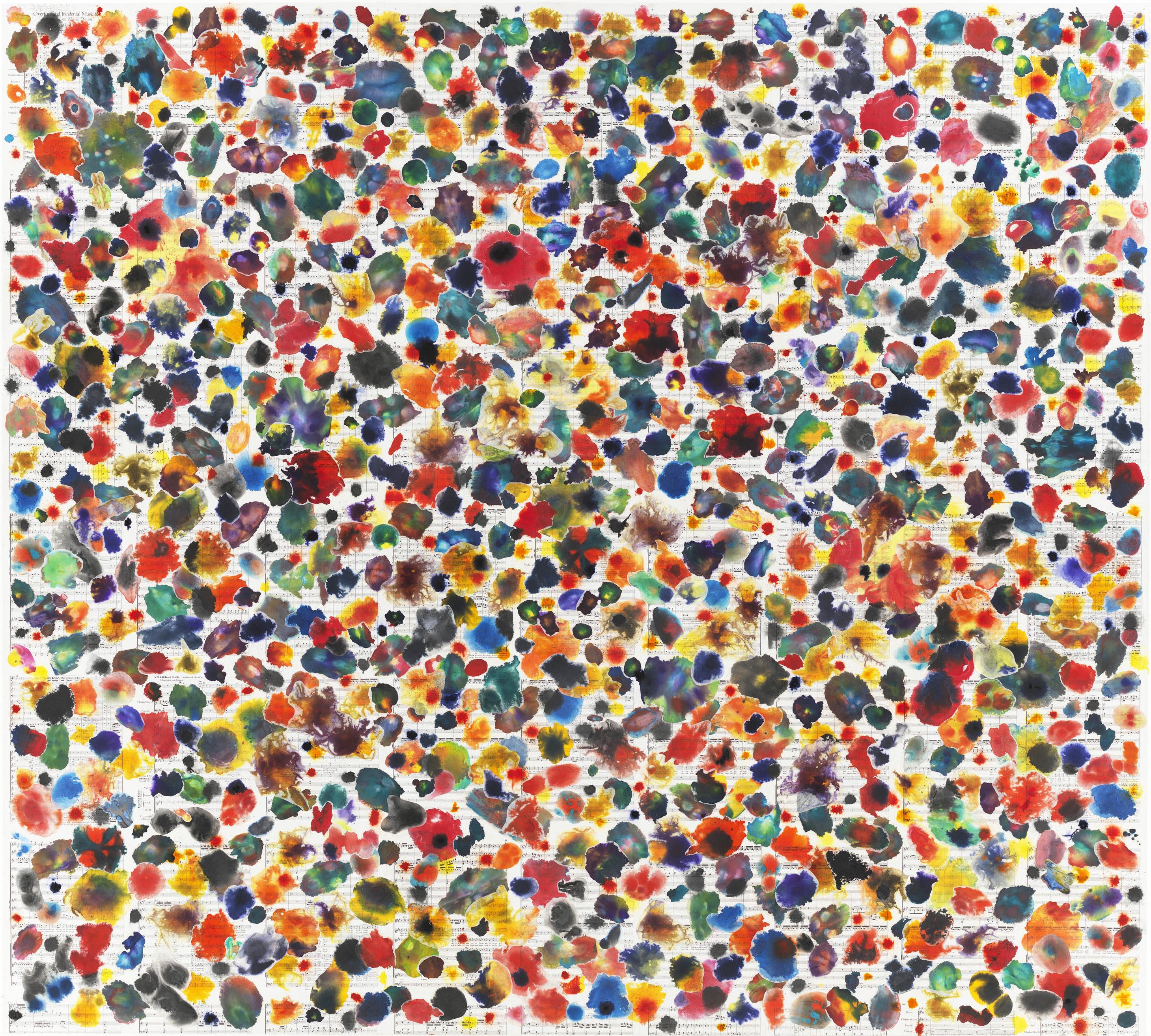
TIM ROLLINS (BFA 1977 FINE ARTS) AND KOS, A Midsummer’s Night
inks, collage, mustard seed, offset lithography on paper and
IN MEMORIAM
Bianca Buttafuoco (BFA 2003 Photography) died on August 5, 2017. Buttafuoco was a freelance photographer for books and fi tness publications. A Long Island native, Buttafuoco returned to Jamesport, New York, after graduating from SVA. She was a member of the East End Arts Council, and is survived by her parents and brother.
Fay Ping Chiang (BFA 1984 Media Arts) died on October 20, 2017. An artist, activist, poet and writer, Chiang worked across disciplines to share observations and stories from her own life and surrounding communities. While studying at Hunter College in the 1970s, she became involved in the movement against the Vietnam War. She also helped establish Asian American courses at Hunter College and across the City University of New York system. She worked as the ex-
ecutive director of Basement Workshop, an organization that helped the Asian American arts community in Chinatown, kicking off a lifetime of serving the community in various nonprofi t jobs and outreach programs. In 2015 the Elizabeth Foundation for the Arts in NYC exhibited some of her illustrations of those killed by police brutality, a culmination of 10 years of work as an artist and a member of the Stolen Lives Project. Chiang is survived by her daughter, Xian Chiang-Warren, and sisters Jean and Janice Chiang.
James S. Harrison died on January 8, 2018. Harrison served as a freelance copy editor for SVA and the Visual Arts Journal for nearly 20 years. Raised in Davenport, Iowa, he served in the U.S. Army during the Korean War and attended Northwestern University and the California College of the Arts before moving to New York
City in the early 1960s. After various jobs in the art world, he established a thriving copy editing career, eventually writing a book inspired by his work, Confusion Reigns: A Quick & Easy Guide to the Most Easily Mixed-Up Words (St. Martins, 1987). Harrison was an accomplished artist and avid birder, and traveled widely.
Rasheed D. Hines (BFA 2005 Cartooning) died on October 6, 2017. Hines was a comic book writer and illustrator with a passion for drawing, having started at the age of 4. He frequently collaborated with GhostWerks Comics and also self-published several titles, including Monster Hunter Maya Zulu and Meteor Max . Hines is survived by his mother, brother and several nieces and nephews.
Timothy Rollins (BFA 1977 Fine Arts) died on December 22, 2017. Rollins was
a lifelong artist, educator and activist. Born in Pittsfi eld, Maine, he attended the University of Maine before continuing his studies at SVA, where he served on the faculty and as a member of the SVA Alumni Society Board of Directors until his death. He is best known for his work with the collective KOS (Kids of Survival), which runs workshops for underprivileged youth. Throughout the 1980s and ’90s, Rollins and KOS’s work gained prominence in the art world, and was included in the Whitney Biennial (1985), as well as exhibitions at the Dia Art Foundation (1989) and the Museum of Contemporary Art Los Angeles (1990). In 2016 their work was featured in “Unbound: Tim Rollins and KOS,” a survey exhibition of the group’s work at the Portland Museum of Art, in Maine.
FROM THE ARCHIVES

Conveying the fervor and fire of political activism, nearly 250 items from Syria, Slovenia, the United States and beyond make up the Design of Dissent Collection, part of the Milton Glaser Design Study Center and Archives, which are housed alongside the SVA Archives at the SVA Library. An ever-growing assortment of posters, postcards, books and pamphlets, the Design of Dissent Collection began as a book of the same name, put together in 2005 by designers and SVA faculty Mirko Ilić and Milton Glaser (Glaser is also SVA’s acting chairman of the board). The book’s content cut across countries, generations and issues, examining graphic responses to the constraints of government and pressing social concerns, and included images that addressed topics as varied as the Iraq War, environmental degradation, fallout from communist regimes and corporate media control. Ilić had collected hard copies of the works, most of them posters, from contributors; these were mounted as an exhibition at the College that year, then donated to the Glaser Archives.
Fast forward to 2017 and many things had changed, not the least of which being the occupant of the White House, and Ilić and Glaser decided that the protests of the intervening years merited preservation, too. Last September, The Design of Dissent was reissued by Rockport Publishers, with more than 160 additional submissions documenting everything from the Arab
To learn more, visit glaserarchives.org.
Spring to the 2017 women’s marches. Ilić and Glaser curated a new exhibition of selected work, this time in the Netherlands, and nearly 100 new pieces joined the archives’ collection.
“From a design perspective, they’re fascinating—a global view of what’s going on,” says Beth Kleber, head archivist for both SVA and the Glaser Archives. With the breadth of topical matters covered and number of designers included, the Design of Dissent Collection offers a chance to see something that is not ordinarily available: a bigger picture.
“It’s a record of time,” Ilić says. “One day someone who wants to study political activism in design will come here to do so.” Kleber has already noticed an uptick in faculty bringing their classes to study the work. “It’s filling a real renewed interest,” she says. “It’s energizing for students in their own practice, seeing the events they’ve lived through.” [Emma Drew]

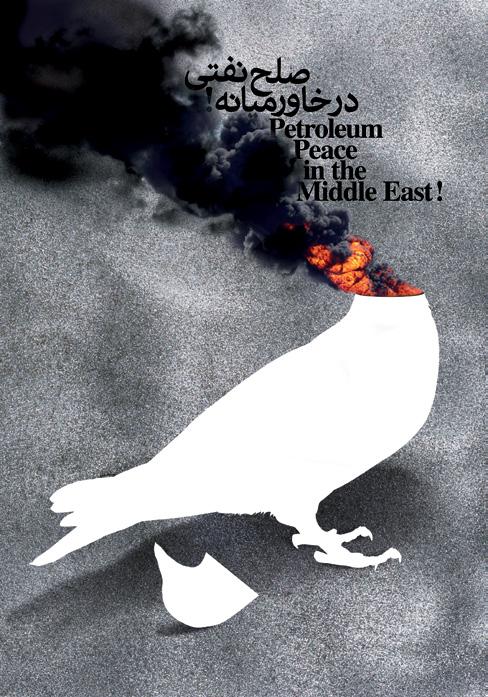


These posters and others from the Design of Dissent Collection are available for viewing, by appointment, at the Milton Glaser Study Center and Archives, in the SVA Library.

